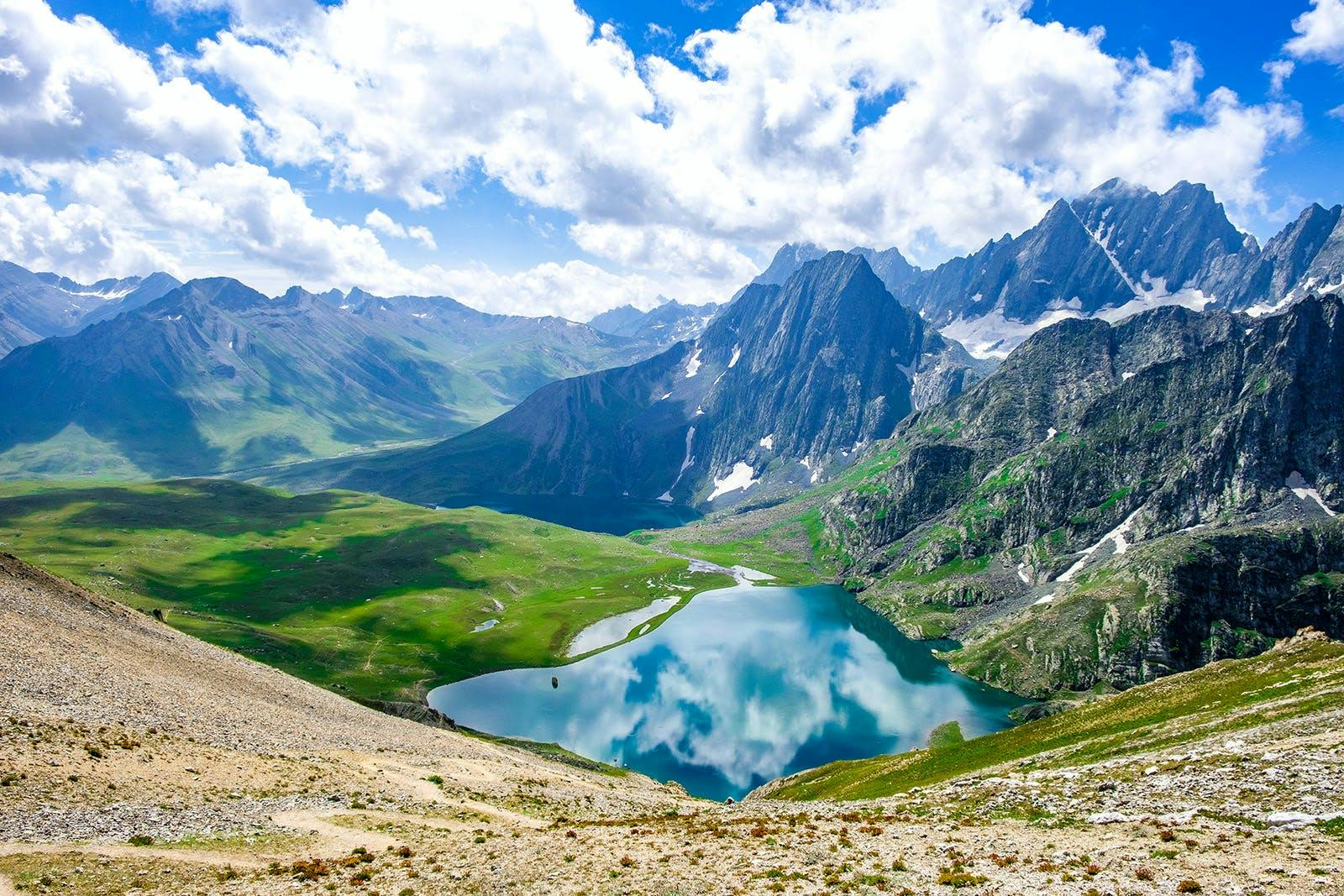

Kashmir Great Lakes Trek
The Most Beautiful Trek In India

Dates fully booked? We have 7 other fantastic treks in J&K, which are at par with KGL. Click here
TREK DIFFICULTY
Moderate-Difficult
TREK DURATION
HIGHEST ALTITUDE
SUITABLE FOR
12-62 years
Kashmir Great Lakes is one of the most beautiful treks in India. No question. It validates Kashmir’s mythical status as heaven on earth.
This is because the trek is set on a canvas that’s larger than life. It is situated 75 km northeast of Srinagar. Every day is a 360° panorama of wild, rugged mountains, rolling meadows, and turquoise alpine lakes. And you get more than six of these lakes and five very different valleys to explore!
The range of landscape makes it a moderate-difficult trek spanning over six days. This means it has long trekking days with steep ascents and descents with no easy exit points. So, it’s not meant for a beginner who hasn’t been exposed to high-altitude treks.
Having said that, the challenges are worth it. Each day is postcard-perfect, with a new alpine lake to look forward to. What makes these lakes even prettier are the snow patches that feed these lakes. You see them sliding off the serrated mountains into the lakes. Sometimes you’ll see milky white icebergs floating on the lake’s inky blue surface.
And then there are meadows of Kashmir. These meadows come in every shape and size, sometimes many in a day.
After this trek, every other trek feels as though it is a movie on a small screen. Kashmir Great Lakes, however, is an IMAX 3D experience – such is the grandeur of the trek. If you have not done this trek, put it on your bucket list!
Kashmir Great Lakes: Complete Trek Information
We have always wanted trekkers to be well-informed before they go on a Himalayan trek . Knowledge is the difference between a safe trek and a dangerous one. It’s also the difference between a wholesome experience and a superficial experience.
Use this section to learn about the Kashmir Great Lakes trek. It has in-depth information about each day of the trek, what to expect, and how you need to prepare for it. Many years of expertise have gone into this content. Trekkers find that extremely useful.

Quick itinerary
Get your trek plan

How Does Each Day Look
Complete day-wise guide with photos

How Difficult is the Kashmir Great Lakes Trek?
This will tell you just how fit you must be

Best Time to do the Kashmir Great Lakes Trek
Time your trek well

How to Reach the Base Camp
Plan your travel

What to Pack for Your Trek
Things you must take on the trek

Why get fit for Kashmir Great Lakes Trek
Fitness matters for the trek

Frequently Asked Questions
Get your questions answered here
Kashmir Great Lakes Videos
Watch these videos to prepare well for your trek.
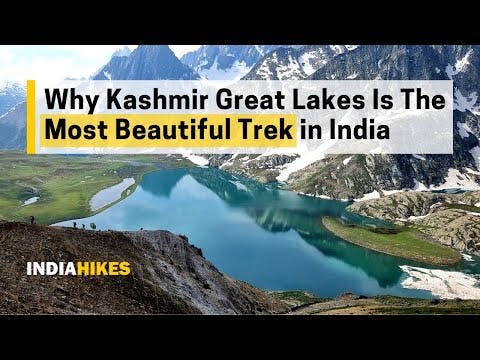
Lakes at a Glance
The Kashmir Great Lakes trek is synonymous for its 6 famous alpine lakes. Each day has a new alpine lake to look forward to. What makes these lakes even prettier are the snow patches that feed these lakes. You see them sliding off the serrated mountains into the lakes.
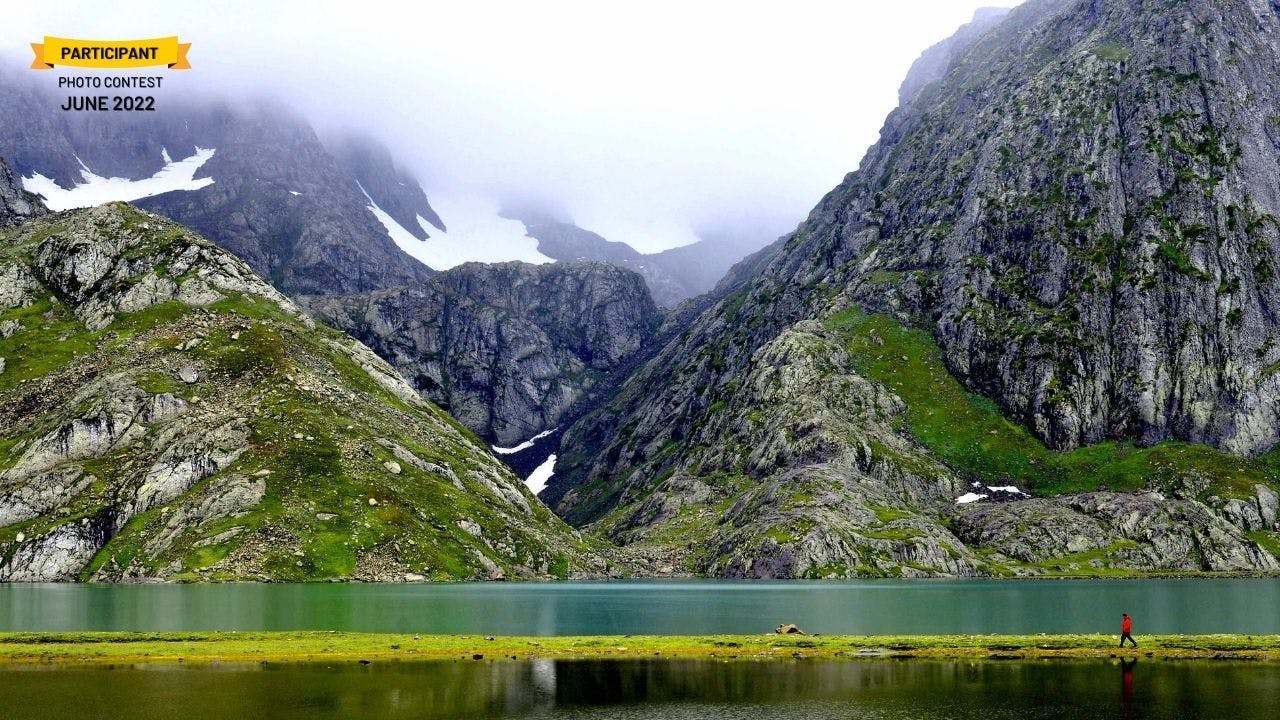
A trekker enjoying the view of Vishnusar lake. Image by Padmanabha K G
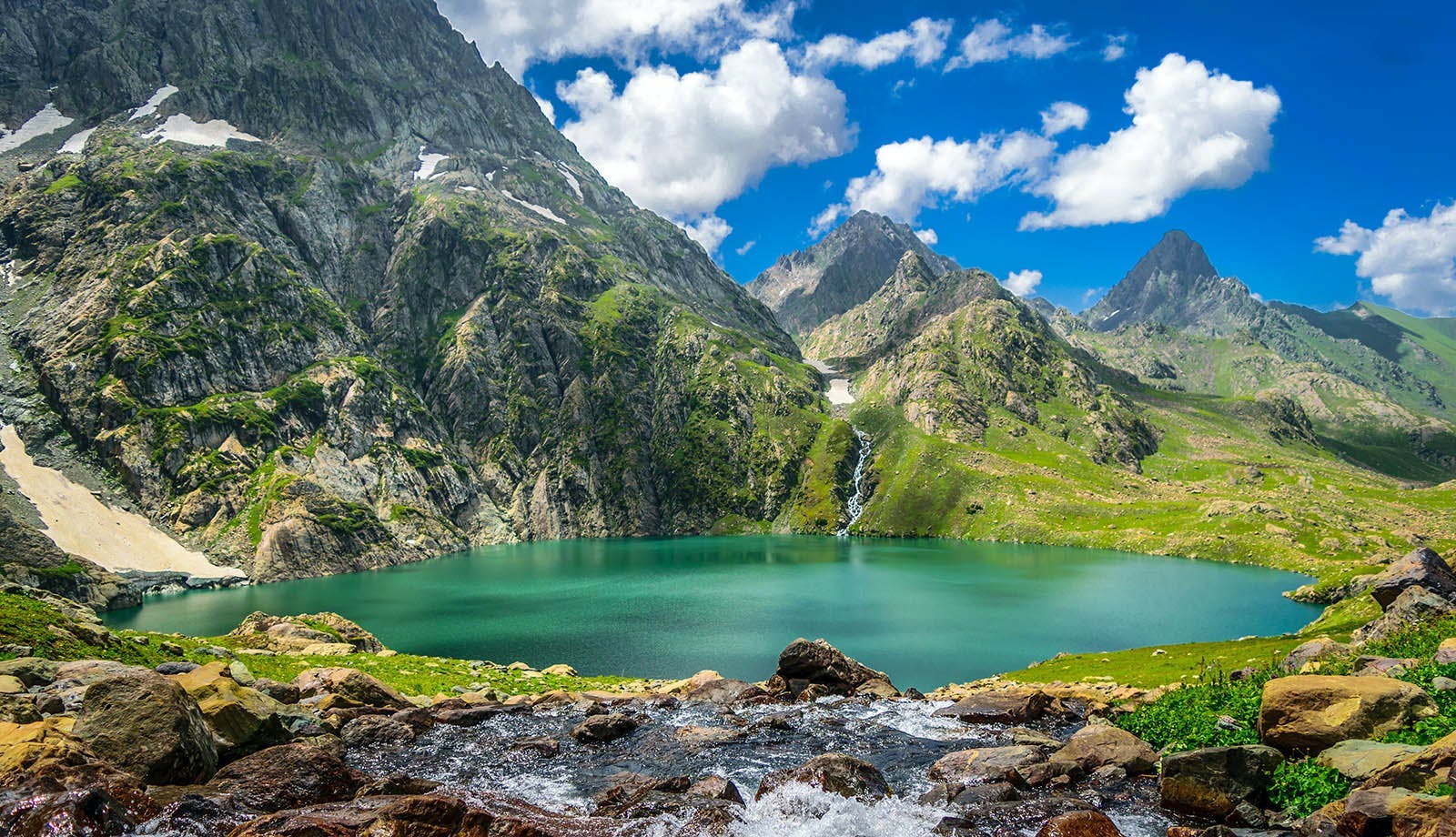
Gadsar Lake. Image by Ankit Patidar
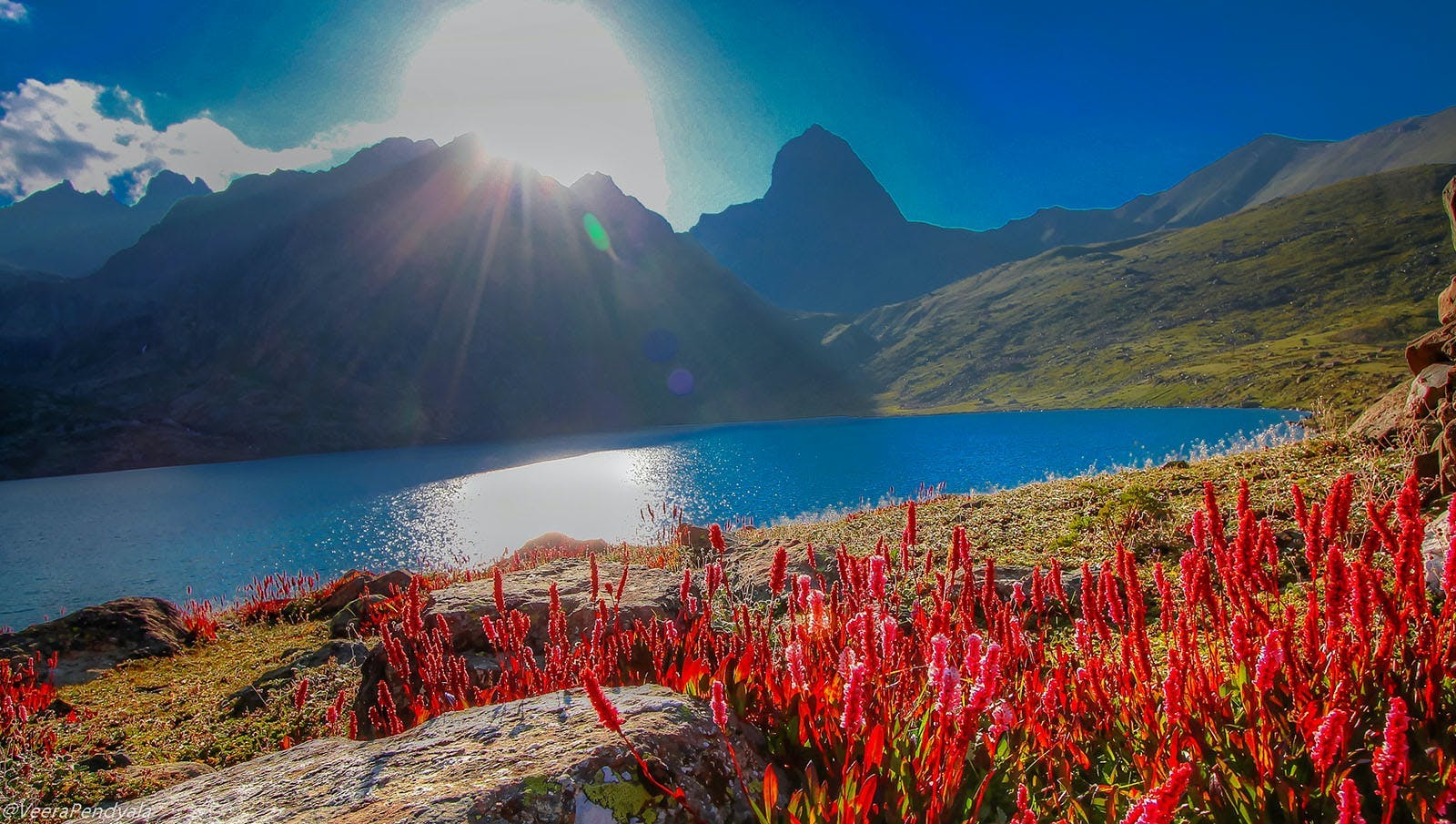
Vishnusar Lake. Image by Veera Pendyala

Kishansar Lake. Image by Animesh Hazra
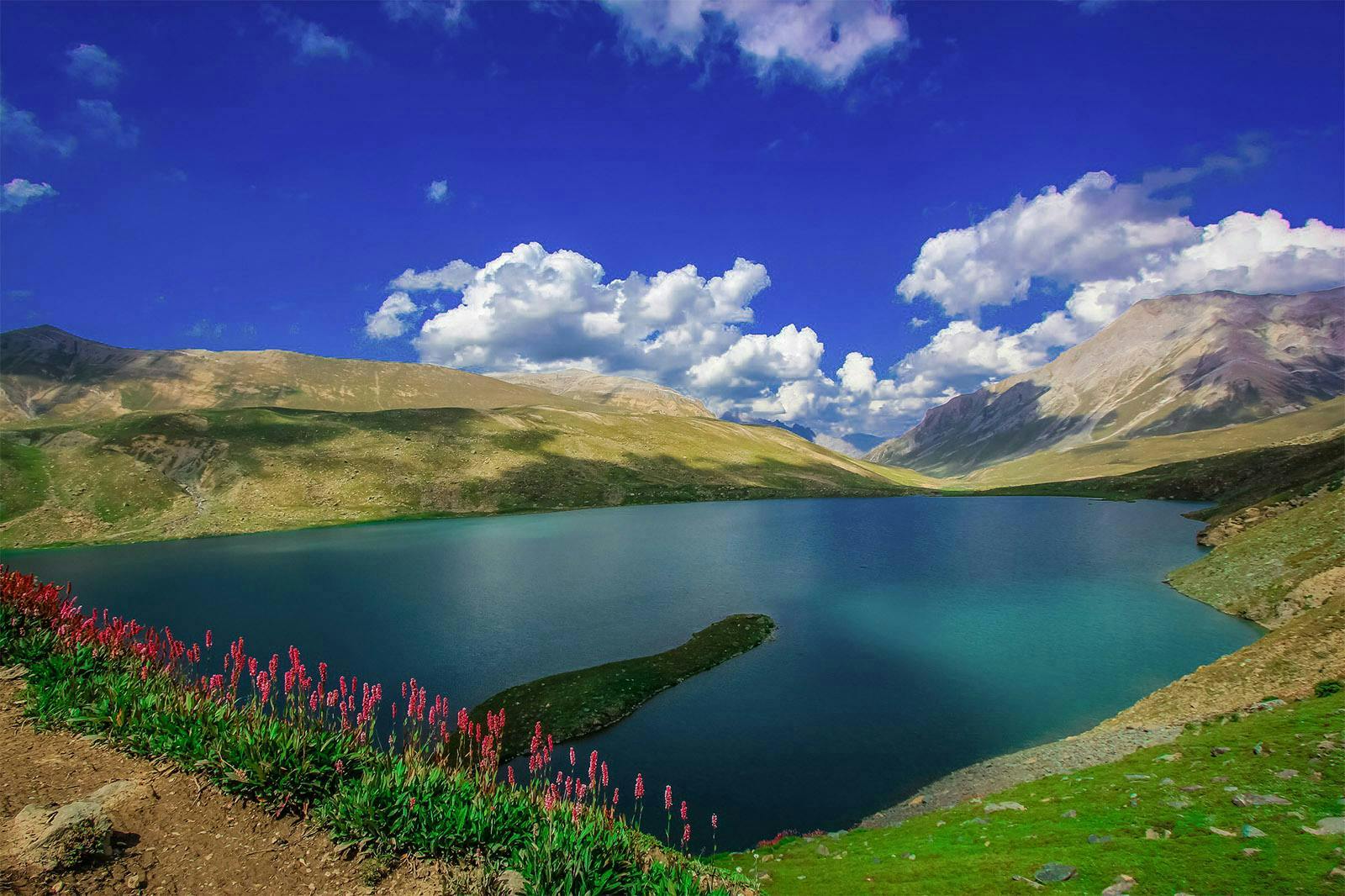
Vishnusar Lake. Image by Brijesh Tiwari
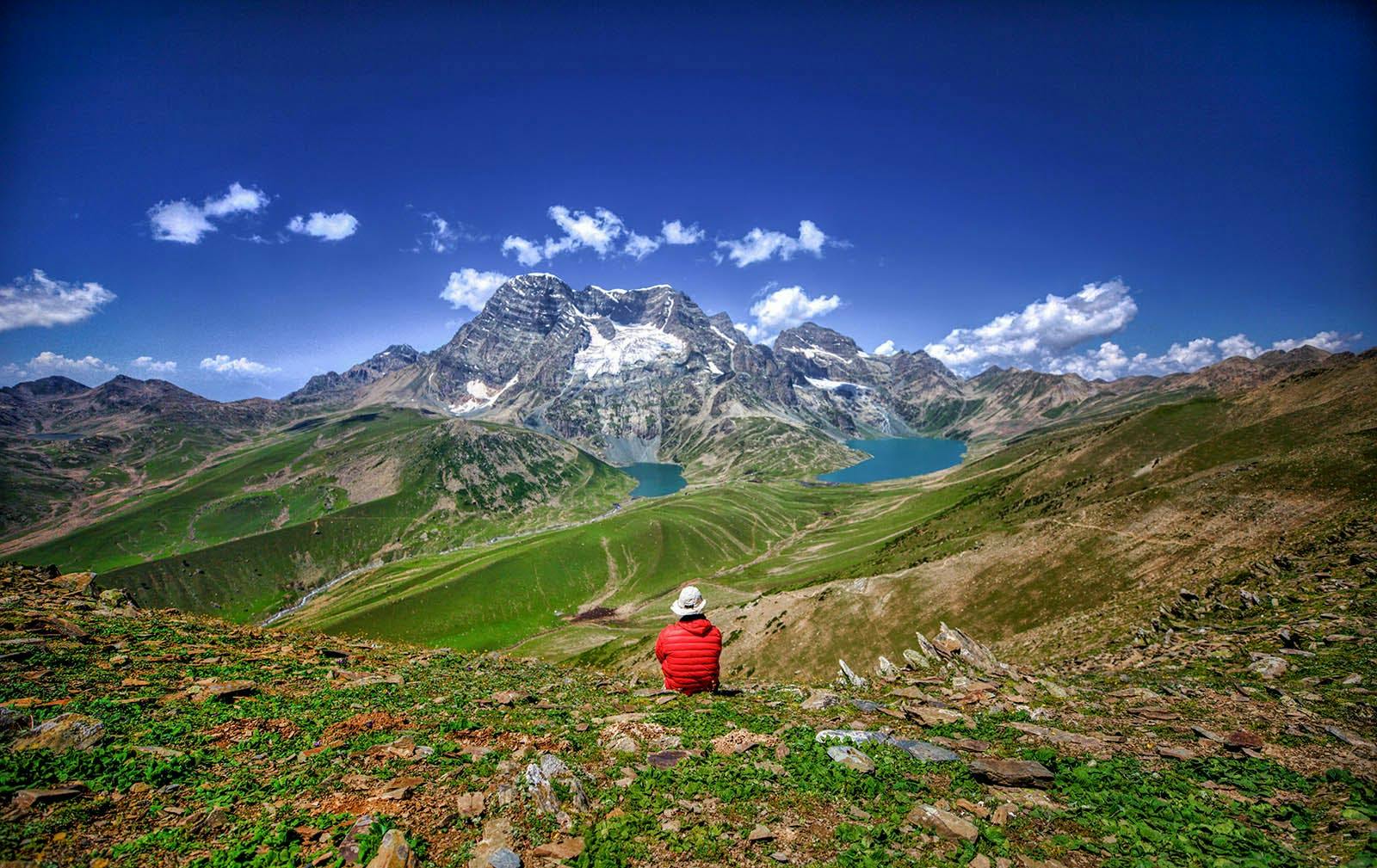
Nandkol and Gangabal Lake. Image by Prasanth Premchandra

Gadsar Lake. Image by Satyen Dasgupta
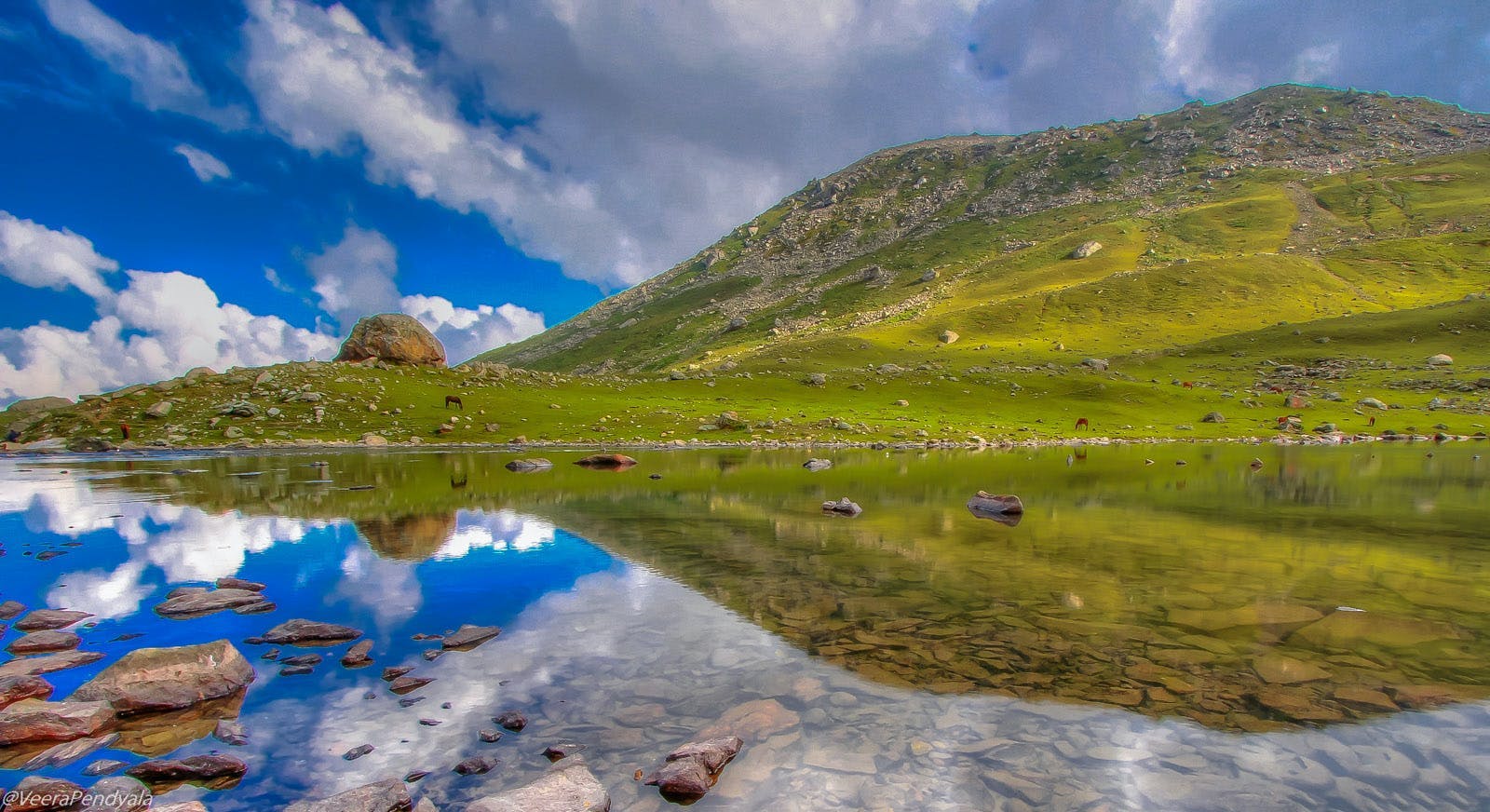
Nandkol Lake. Image by Veera Pendyala
Campsites at a Glance
At Indiahikes, we are very particular about choosing terrific campsites. For the Kashmir Great Lakes trek too, after a lot of back and forth, we have settled on these terrific campsites, which trekkers have come to love.

Smooth green grass, almost manicured, a few lone maple trees and a few horses enjoying the graze are what Satsar meadows look like where your campsite is. Picture by Sachin
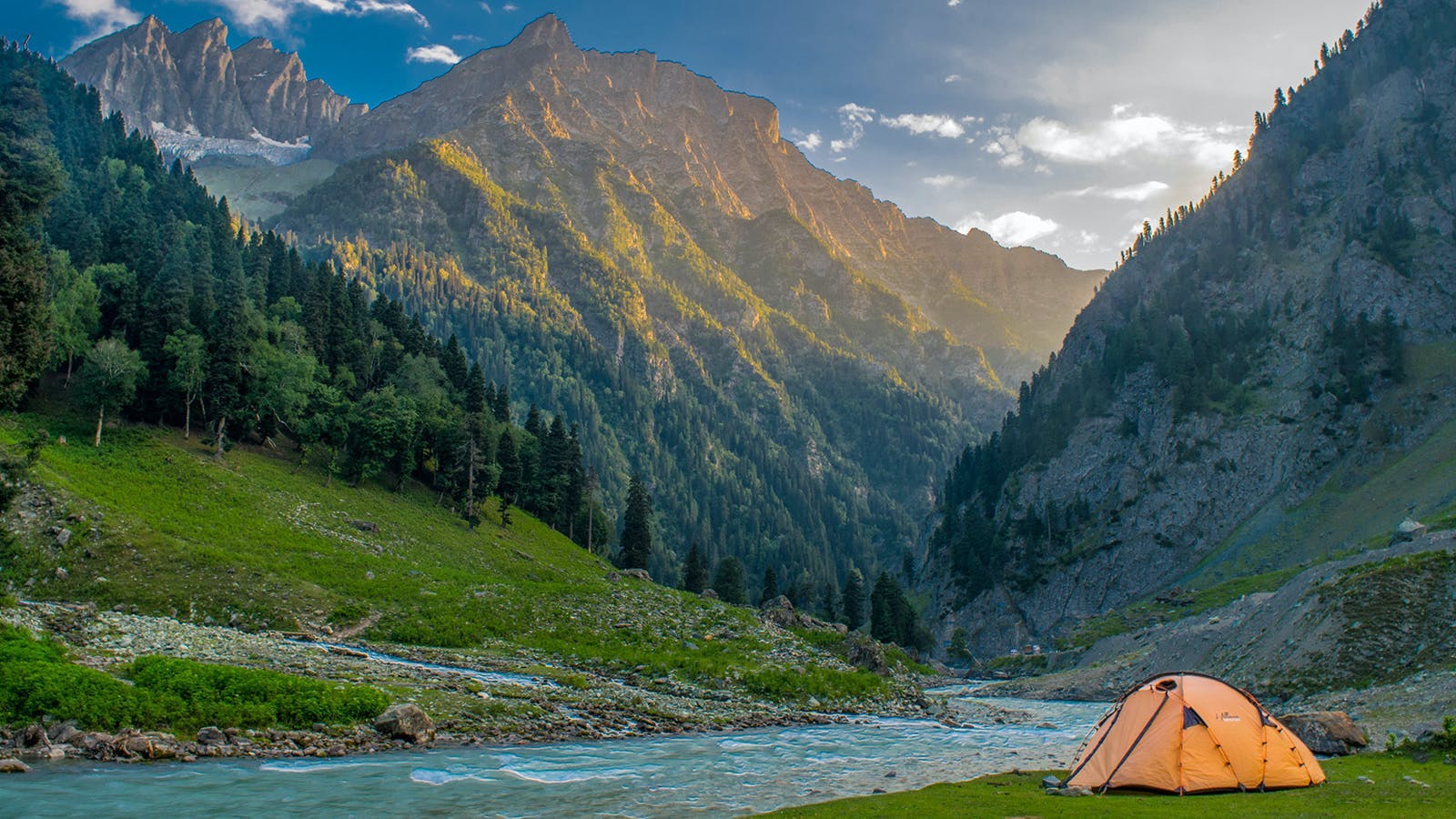
Sonarmarg is right next to the NH1 highway. You get to see the Kolohoi glacier in the backdrop with the Sindh river flowing right next to you. Picture by Nimesh Mittal

Your first campsite would be the Nichanai campsite. Nichnai grasslands show you how massive and rugged meadows can be. Picture by Sachin
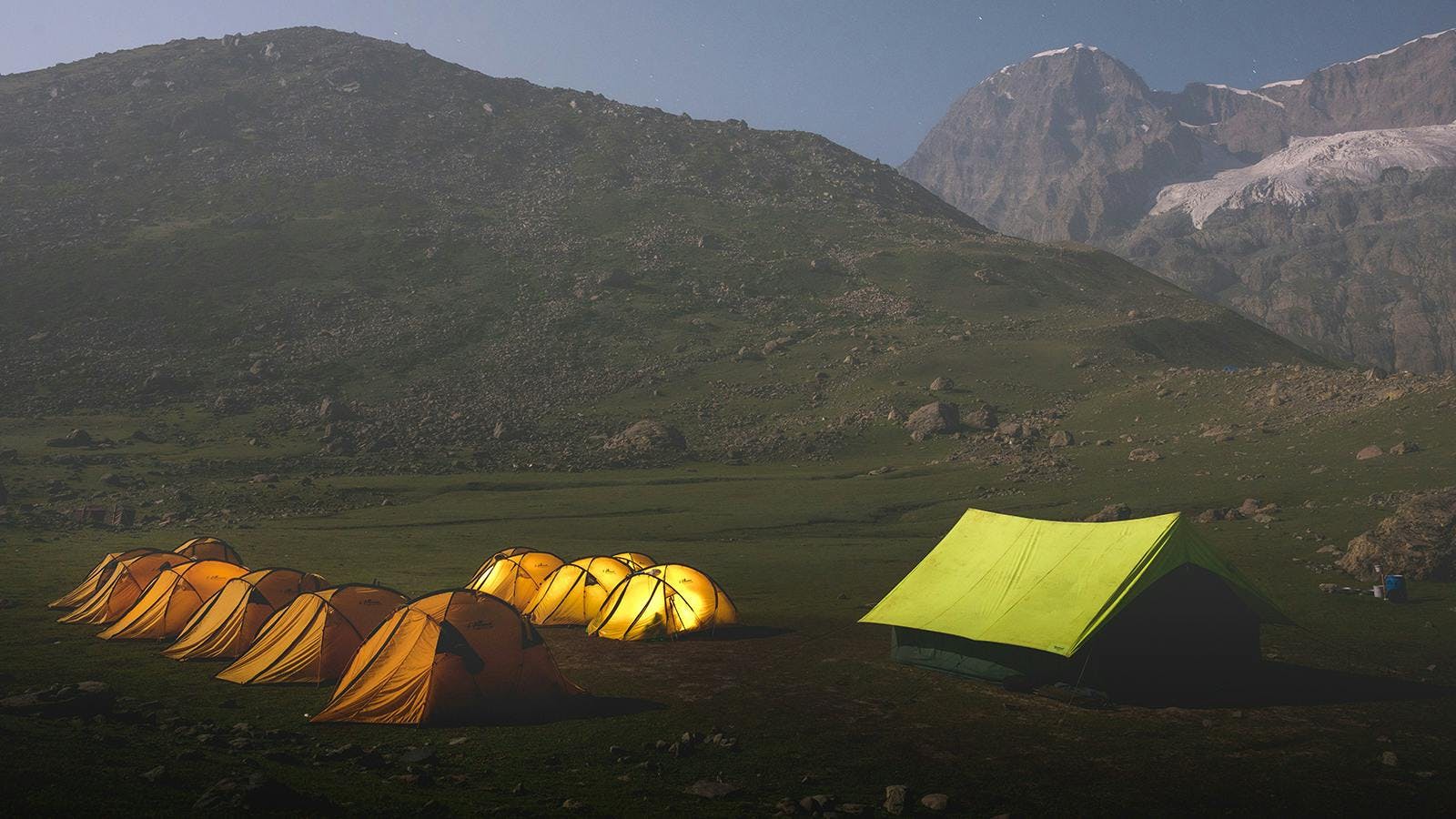
This campsite is known for the theatrics with clouds and Harmukh peak standing tall next to Nandkol and Gangabal lakes. A Night shot of the campsite. Picture by Sachin
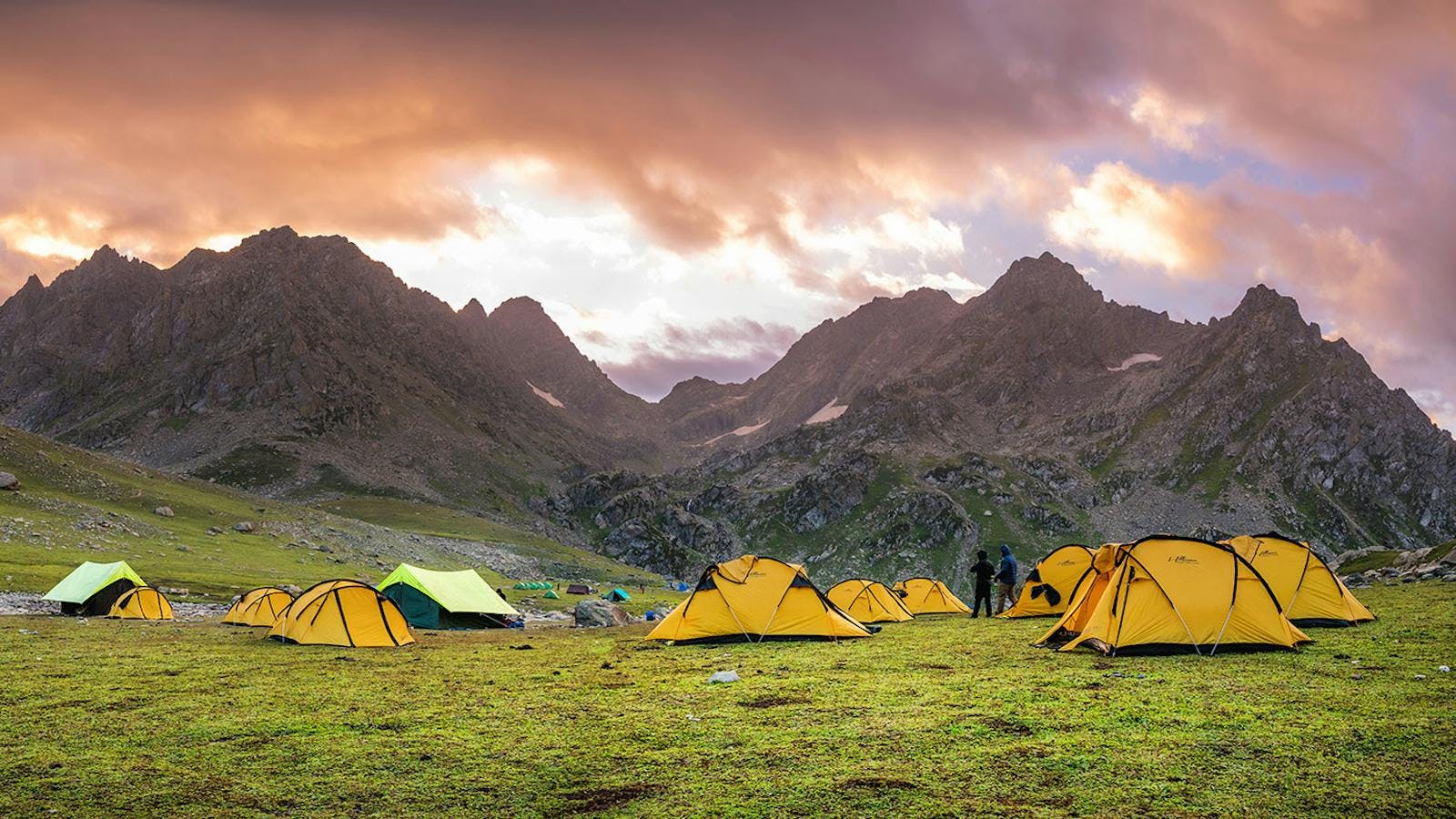
The evening setting at the Satsar campsite is a dream. Do not miss out on the night skies when you are trekking on the Kashmir Great Lakes trek. Picture by Sachin
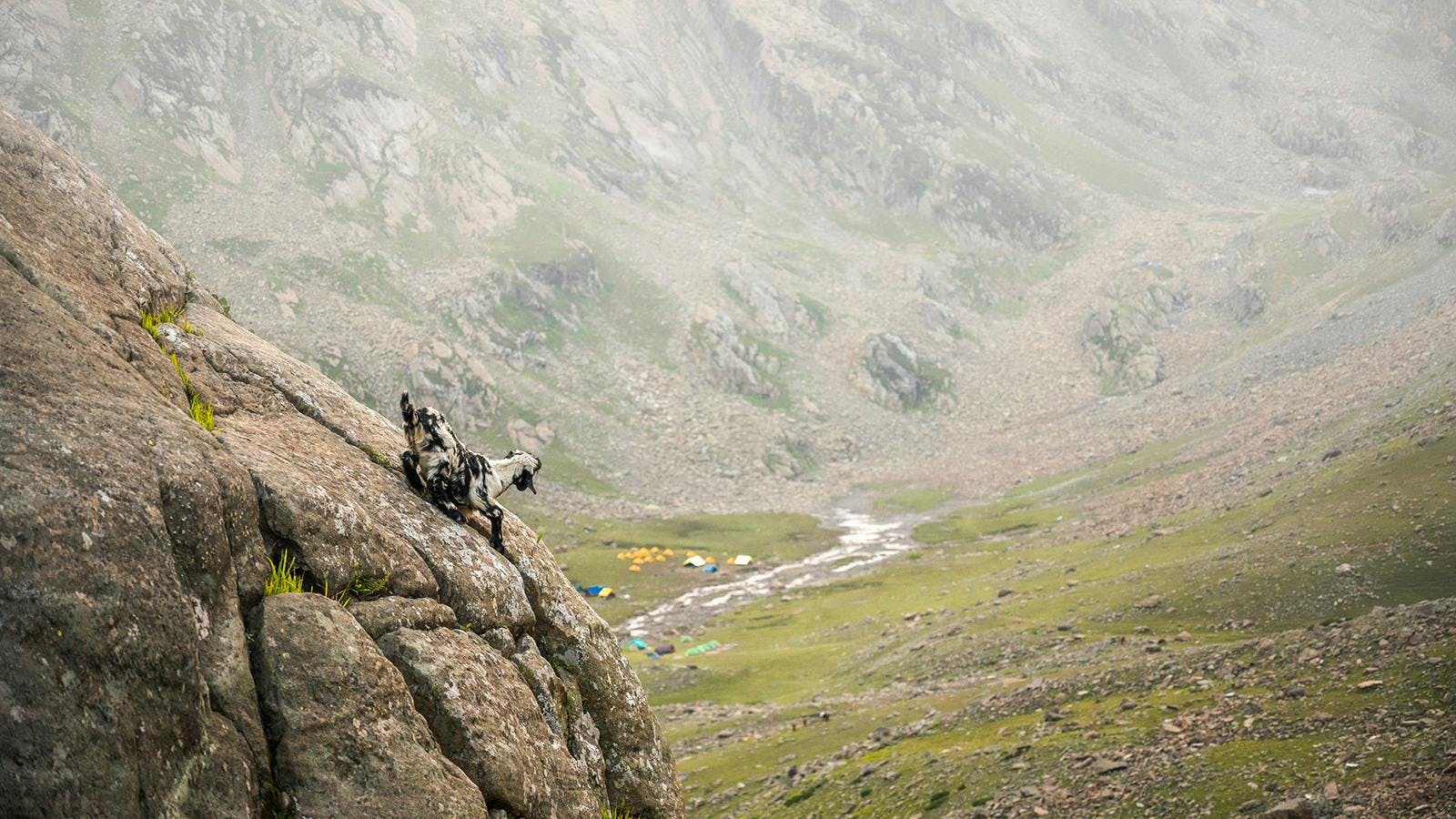
A goat's eye view of the Satsar campsite. Picture by Sachin
Why I Believe Everyone Must Trek: A Note from the Founder

Trekking transforms lives. It has completely changed my life. When I see my colleagues at Indiahikes, all of them have been impacted greatly. The transformations have been profound and irreversible.
I see it in our trekkers too. I have seen them change professions, careers or start a new life. I have seen them get in and out of relationships, and start new projects. These are life-changing experiences.
I have seen children building resilience. I have seen families come together. When I see those above 55, I see them rediscover passion and a sense of purpose. These are not small gains.
In the mountains new professions, new economies and new businesses have opened up. Our staff no longer go to cities to earn their living. Their income has increased. Above all, they are happiest working in this world. Trekking has been truly transformative.
Everyone must trek. It transforms lives far more than you imagine.
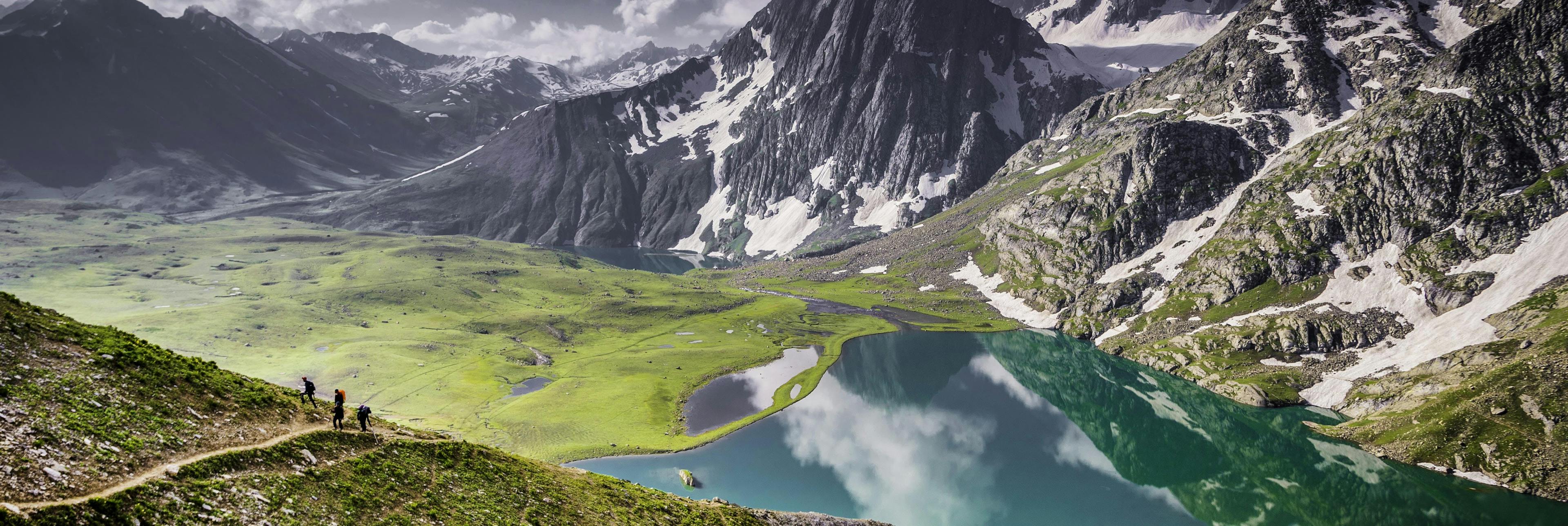
Expert Speak
Sandhya UC, Co-Founder, COO

Sandhya is a founding partner at Indiahikes. Over the past ten years, she has explored and put on the map a few of the greatest Himalayan treks in India, including Kashmir Great Lakes and Kedarkantha. She is a TedX Speaker and has been awarded the Women of Worth Award by Outlook Business in 2017.
Here’s Sandhya talking about the most beautiful trek in our country .
What I Like and Don’t Like About the Kashmir Great Lakes Trek
What I Like About the Kashmir Great Lakes Trek
Sandhya is a founding partner at Indiahikes. Over the past ten years, she has explored and put on the map a few of the greatest Himalayan treks in India, including Kashmir Great Lakes and Kedarkantha. She is a TedX Speaker and has been awarded the Women of Worth Award by Outlook Business in 2017. Here’s Sandhya talking about the most beautiful trek in our country.
1 . The magnificent mountain scenery on the trek
Most treks in the Himalayas are very scenic. But Kashmir Great Lakes is on a scale of its own. In fact, the mountains of Kashmir are like that. They have a larger-than-life presence around you. I would not be exaggerating too much if I say that a trek in Kashmir is like watching on an IMAX screen while everywhere else is on a normal TV screen. Kashmir — you feel it everywhere.
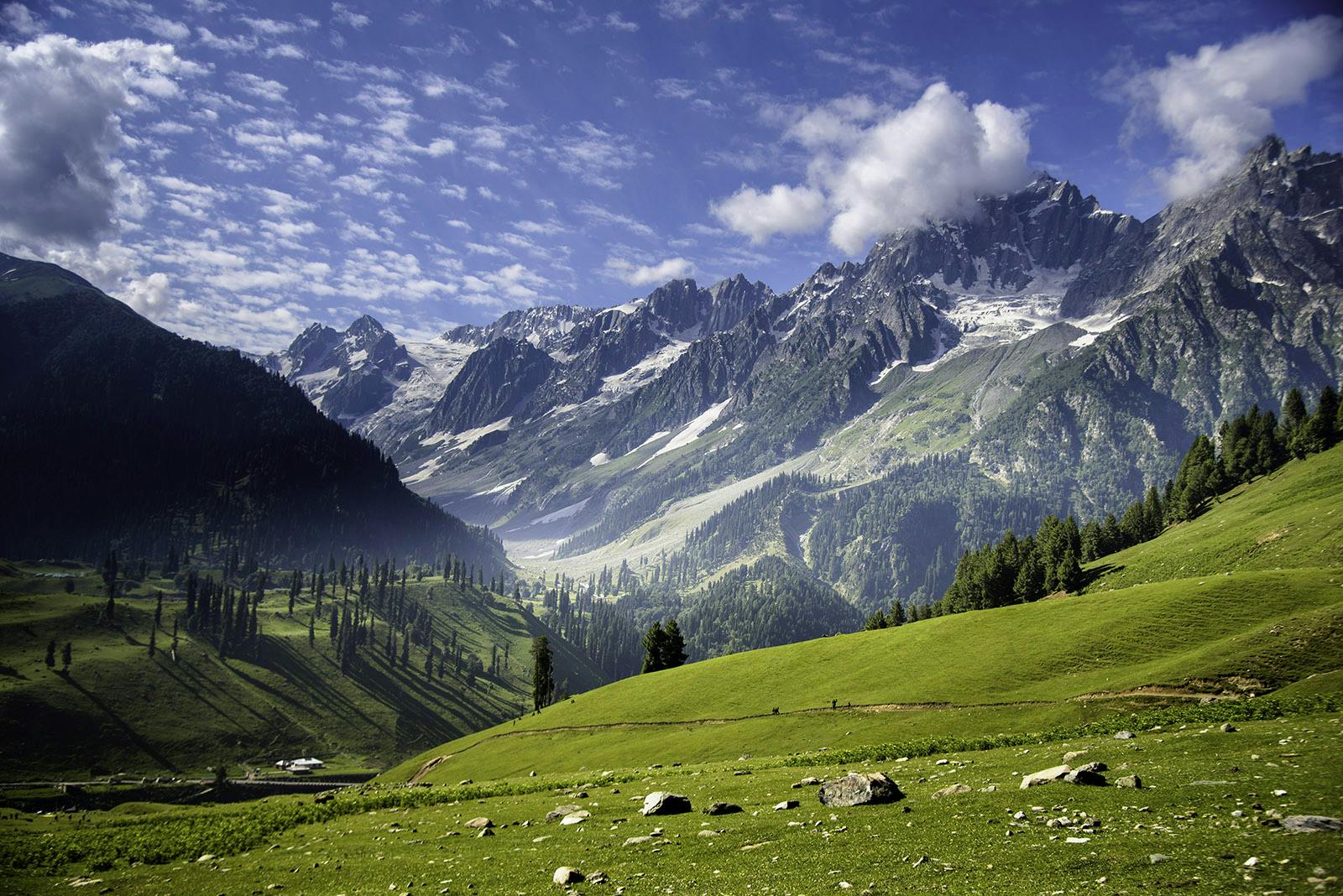
The larger-than-life scale of the mountains, meadows, and lakes on the trek of KGL. Picture by Rajshree Sarada
2 . The variety of the valleys and meadows
The Kashmir Great Lakes trek has 7 trekking days. And coincidentally you are also trekking in 7 different valleys. What’s more, each of these valleys, spread themselves out each day of the trek. Every valley gives hard competition to the valley before and the valley after.
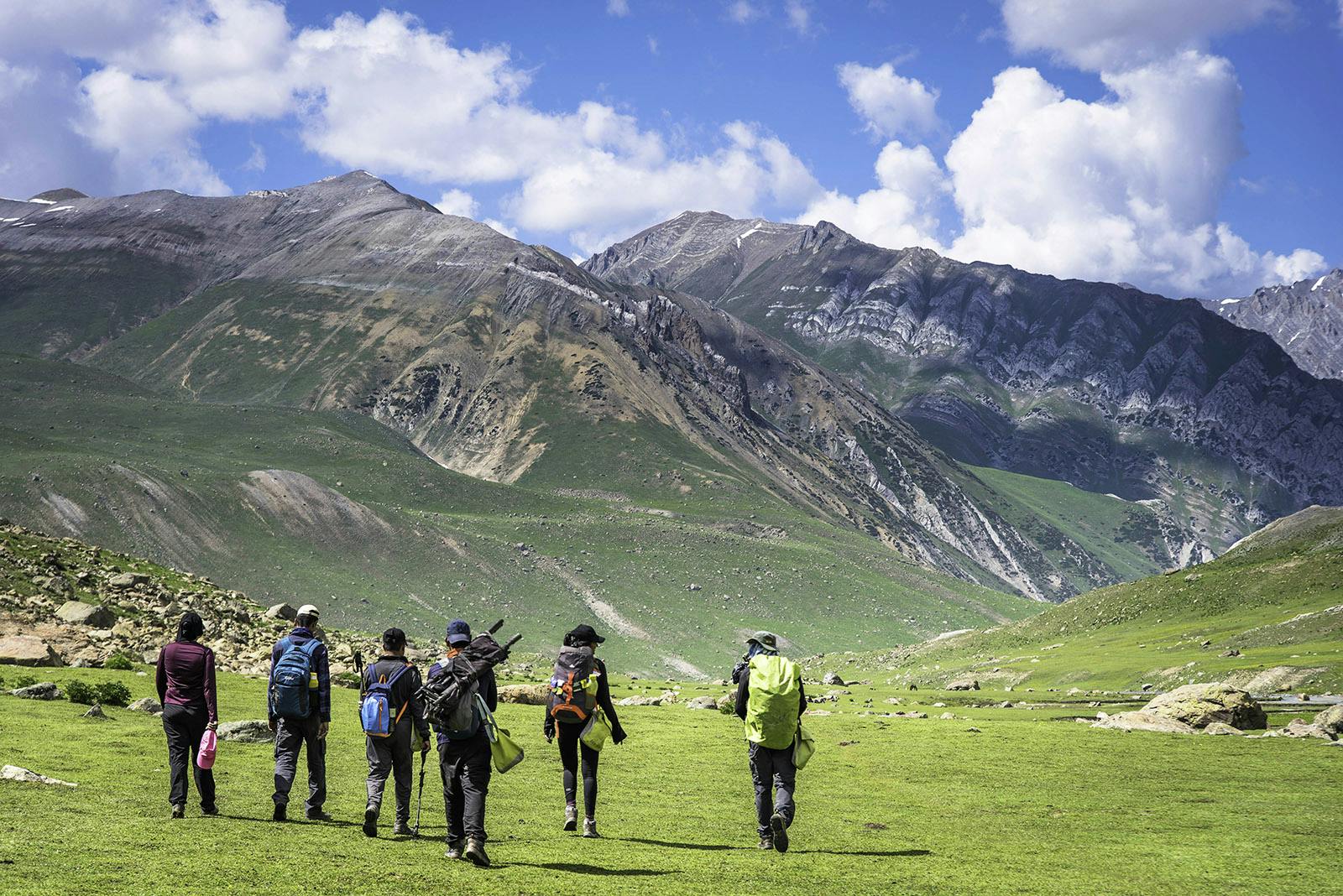
Trekkers rejoice trekking through the meadows after crossing Nichnai Pass and going through the wide valley. Photo by Rajshree
3 . The unforgettable walks in the meadows
Among the 7 different valleys you trek, 6 happen to be distinct grasslands or meadows. These high altitude meadows and grasslands are connected to one another via high passes. One would expect the meadows on either side of a pass to be similar. But they aren’t. Each one of them is a world of its own and has a charm of its own.
The Shekdur meadows also known as table top set amidst Maples and Birch trees is where you start. Nichnai grasslands show you how massive and rugged meadows can be. Just cross the Nichnai pass and you enter a meadow that you don’t want to end.
A wide grassland, descending gently laden with wildflowers, a gentle river flowing in the middle is what the Vishnusar grassland is all about.
The Gadsar meadow is more dramatic. It is narrower with more jagged mountains lining on either side. A big Gadsar occupies the central landscape but leading to it are many smaller lakes. Flowers bloom in the entire valley in wild abandon.
Climb up from Gadsar valley and you get transported to the “windows wall paper” valley of Satsar. Smooth green grass, almost manicured, a few lone maple trees and a few horses enjoying the graze is what Satsar meadows looks like. I have never seen greener grass anywhere else.
The final grassland is the Gangabal expanse. When you see the valley below from Zaj pass, you are almost looking at the world map in green. Gangabal in blue looks like Africa! Nandkol lies by its side. 4 other lakes also dot the green landscape.
Personally for me, it is the meadows on the trek that take the cake and are my top reason to love KGL.
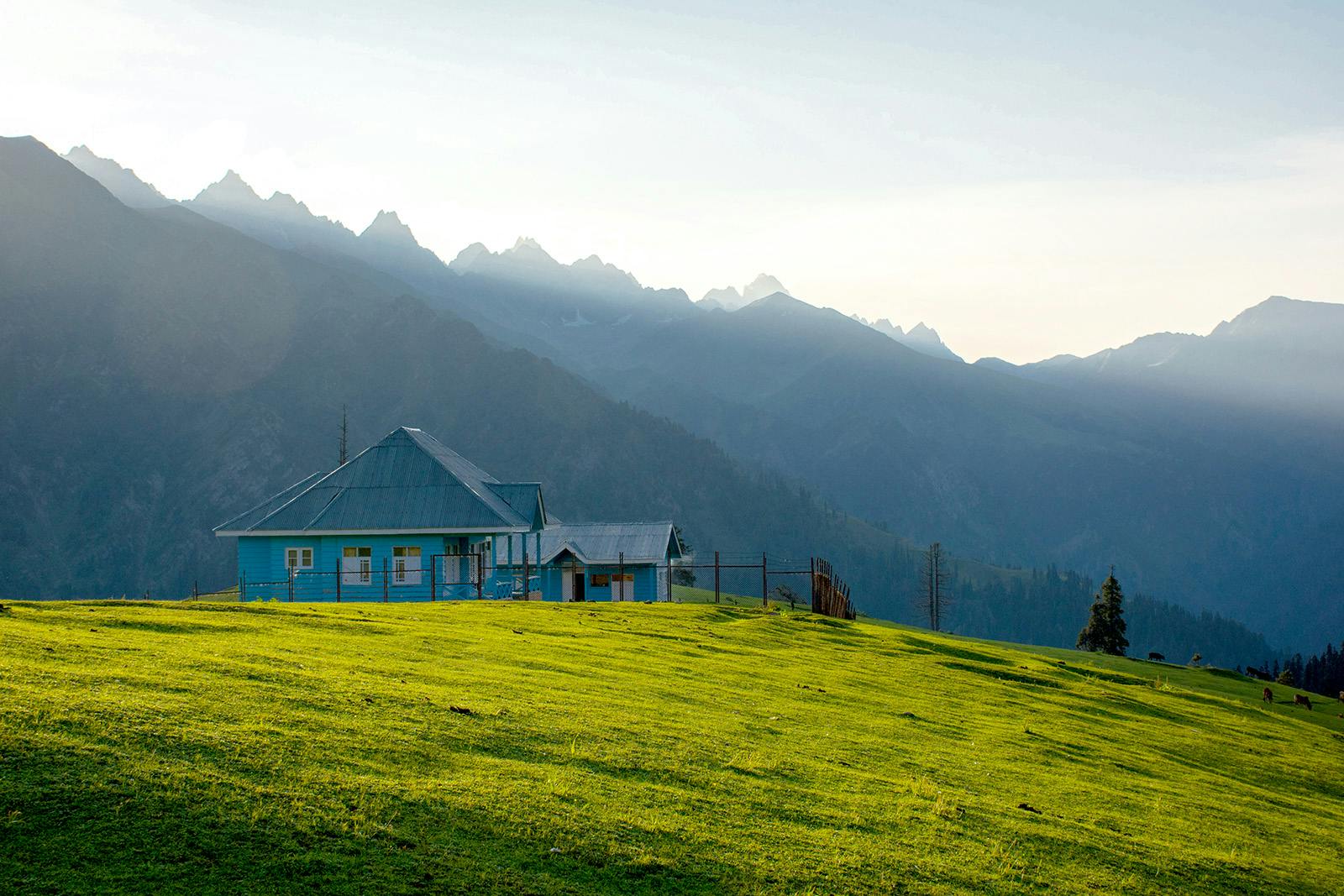
The Meadows on the last day of the trek after the Gangabal campsite. Photo by Vishwajeet Chavan
4 . The lakes
You cannot talk about Kashmir Great Lakes Trek without mentioning the lakes. When I saw one or two pictures of the lakes before my exploration, I thought they were photoshopped pictures from some Scandinavian country. I did not believe such lakes existed in the mountains of our country. These crystal clear high altitude lakes change colours all through the day.
Starting from clear at dawn to sea green to light blue to inky blue by evening. The twin lakes Vishnusar and Kishansar, the sea-green Gadsar with ice floes, the sight of gigantic Gangabal along with its twin Nandkol are some of the best lake scenery you will see in the world.
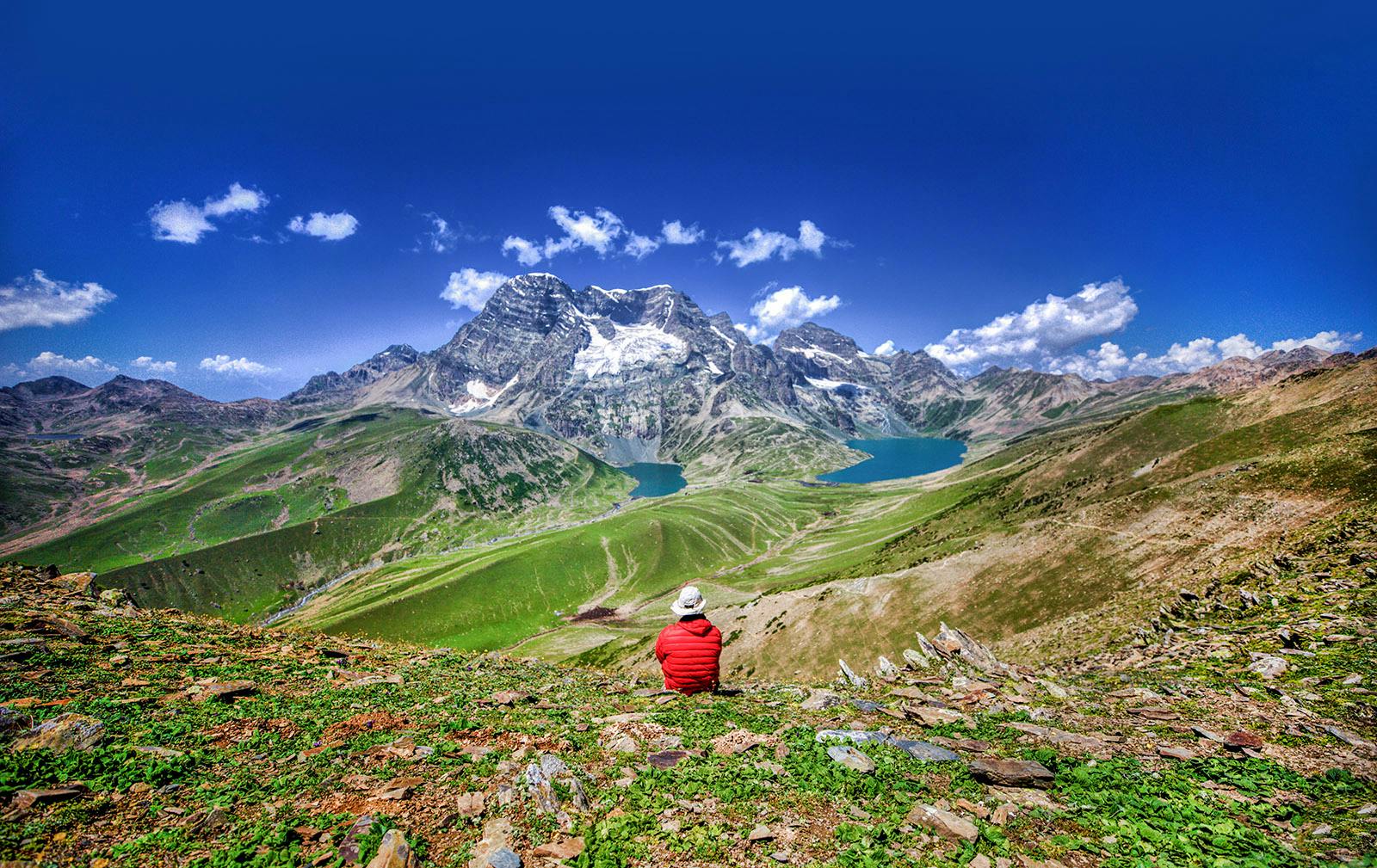
The twin lakes of Gangabal and Nandkol taken from Zaj Pass on a clear day. Photo by Prasanth Premchandran
What I Don't Like About the Kashmir Great Lakes Trek
1 . The dhabas on the trek
In the last 4-5 years a lot of dhabas have sprung up on the trek. Especially in the beginning and towards the end. My ideal trek is away from civilization. I go out to getaway. Even a hot cup of tea on a tiring trail will not make me root for a dhaba on a trail. Thankfully they are only on the periphery of the trail.
2 . The garbage on the trail
This is a total bummer on the KGL trail. For a very long time, the campsites around the first and the last lakes on the trek are littered with camping leftovers. No matter how many sacks of litter our trekkers pick from Gangabal and Nandkol or Vishansar, these camps get littered by the short campers who come to the lakes.
The trail to Vishnusar around Nichnai and the trail down to Naranag in the pine forest are also littered. I sincerely hope better sense prevails in those who come to these lakes.
3 . Unexpected challenges on the trek
Thanks to the lovely green meadows, trails lined by mountain flowers and the aquamarine lakes, everyone assumes the Kashmir Great Lakes trek is a walk on the grass. The reality is far from it. It is a moderate-difficult trek.
Long trek days and high passes to cross are a reality every day. There are quite a few rocky sections to negotiate too. You get them 3 or 4 times on the trail when you least expect them. I would say these unexpected challenges make the trek even more spectacular.
Kashmir Great Lakes Is Best Discovered Through Pictures
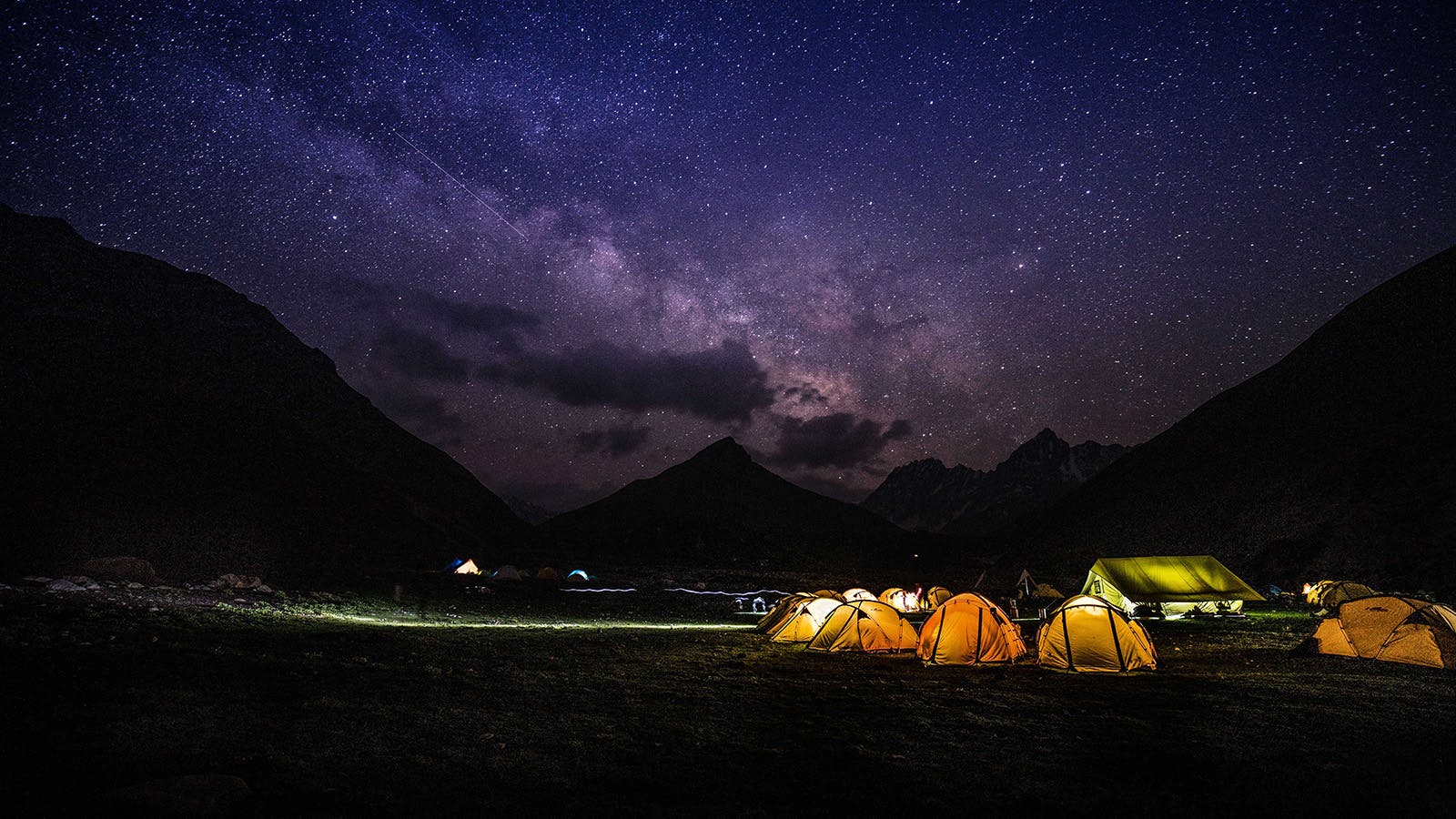
Photo taken from Gadsar Campsite with the Milky way and billion of stars.
Picture by: Rajarshi Manna
Night Sky on Kashmir Great Lakes trek
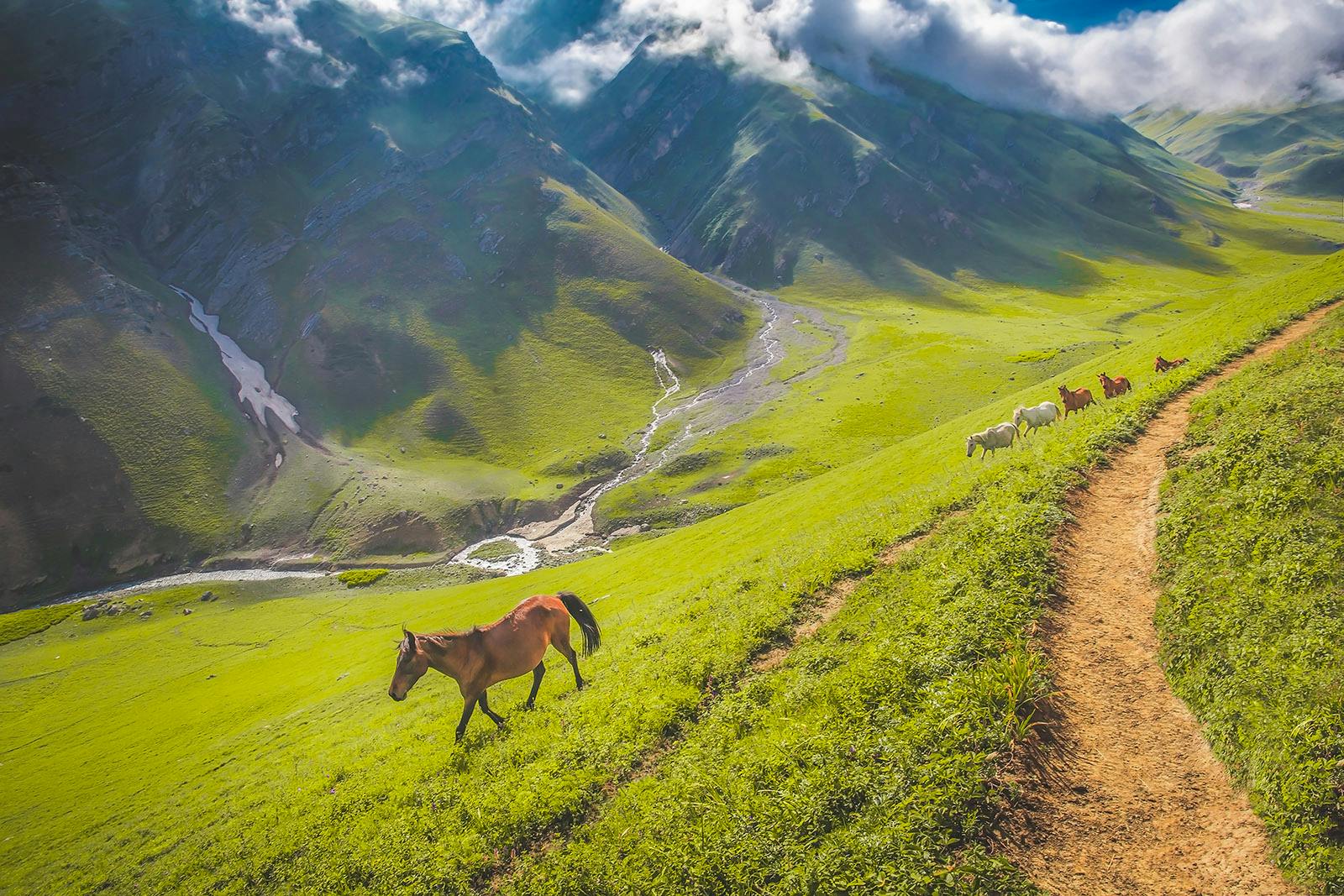
The setting of meadows, horses grazing beside you and the glacier waters flowing is a set taken for endless wallpaper moments.
Picture by: Suresh Kerkatta
Picture Perfect
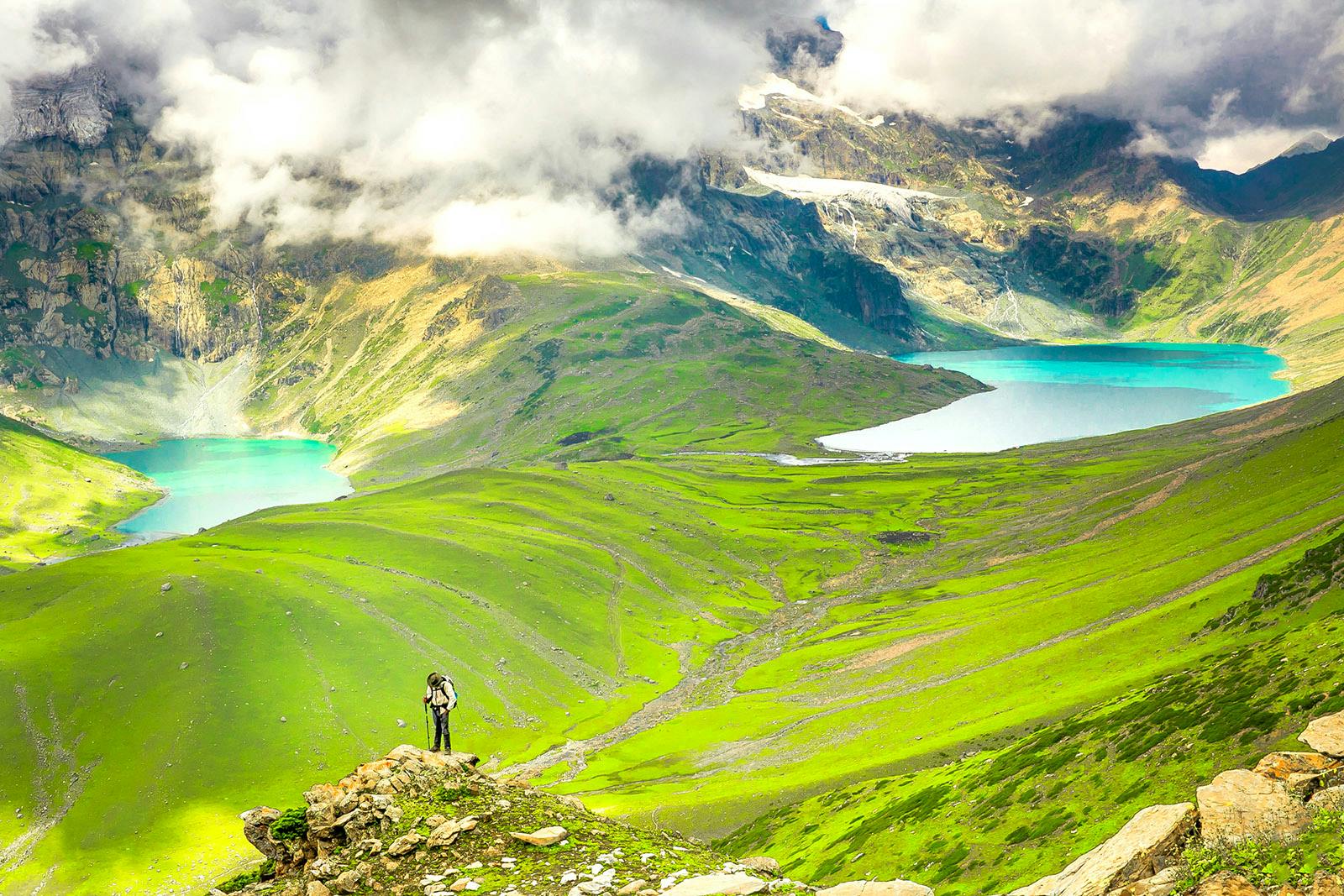
Zaj Pass is your last pass crossing on the trek. If you get clear weather, then this view of twin lakes is sure to blow your minds off.
Picture by: Suresh Kerketta
The Twin Lakes
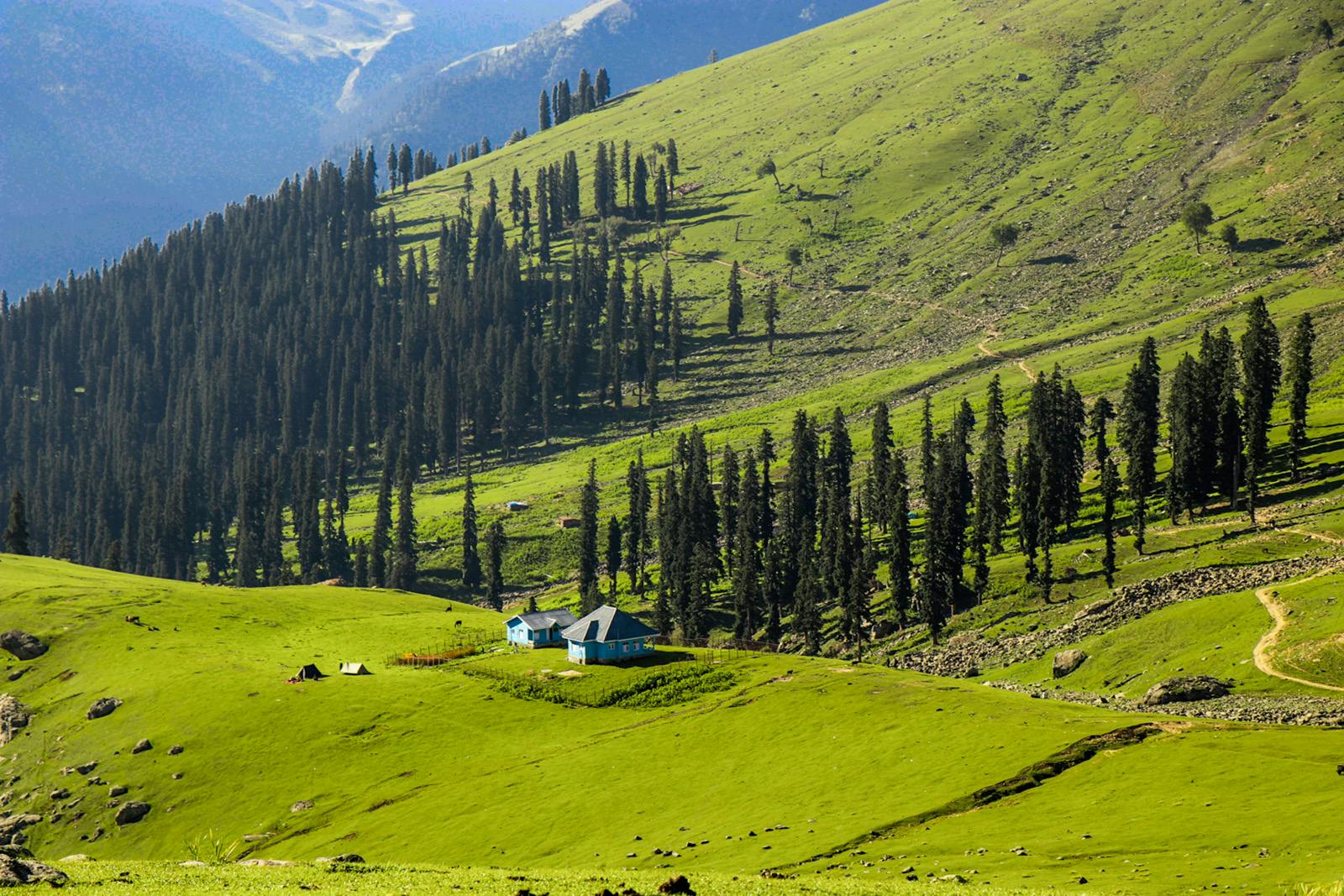
An hour away from the Gangabal campsite, you will hit the fringes of the tree line. Pine trees line the meadows and you also see the first traces of civilization with the presence of a log hut - Marking the end of this magnificent trek
Picture by: Divakar
Sight of Forest section
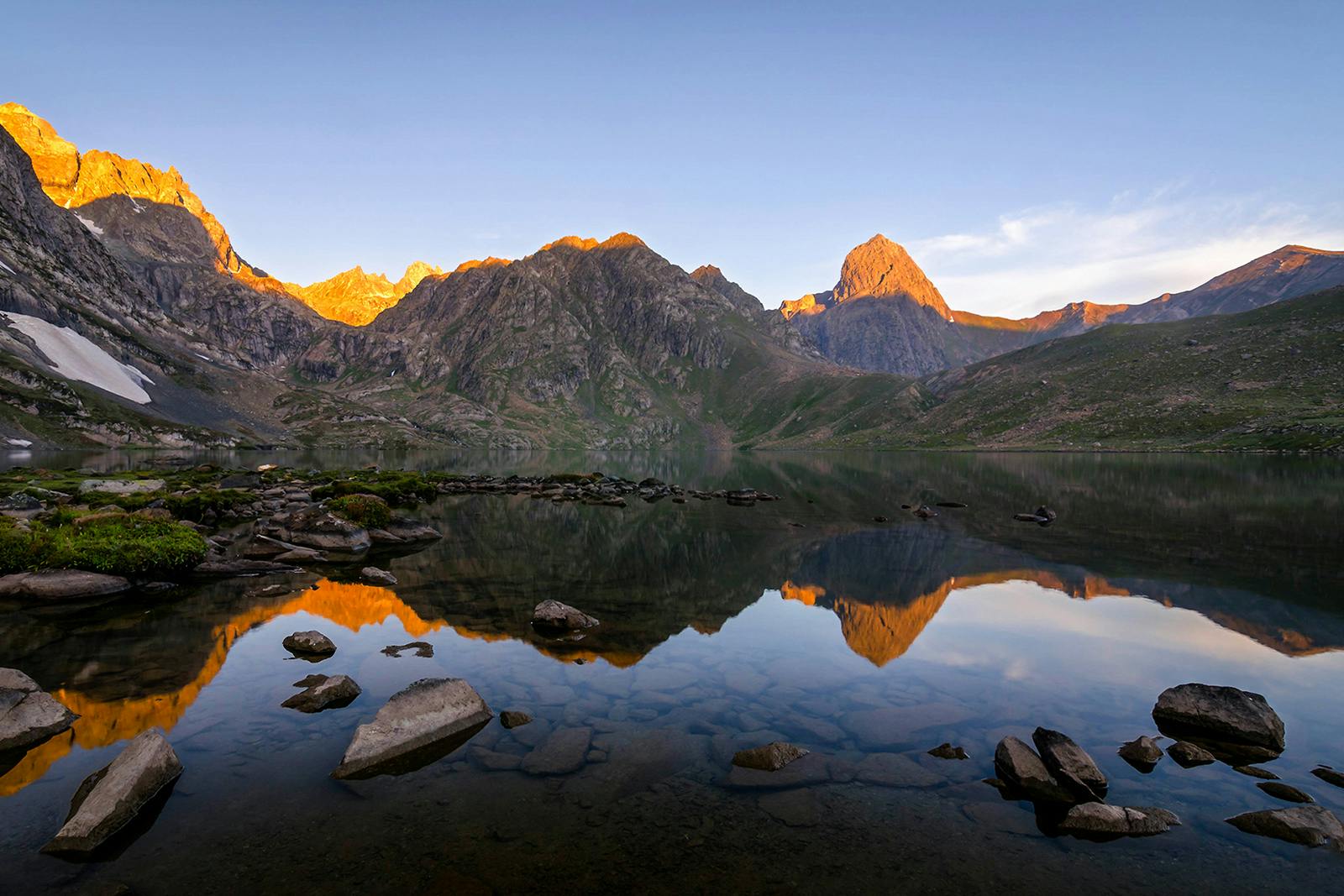
The colours on the Vishnusar Lake transition according to the climate and time of the day. It is a mysterious feeling when you hop through the small rocks.
Picture by: Sangram Biswas
Vishnusar Lake
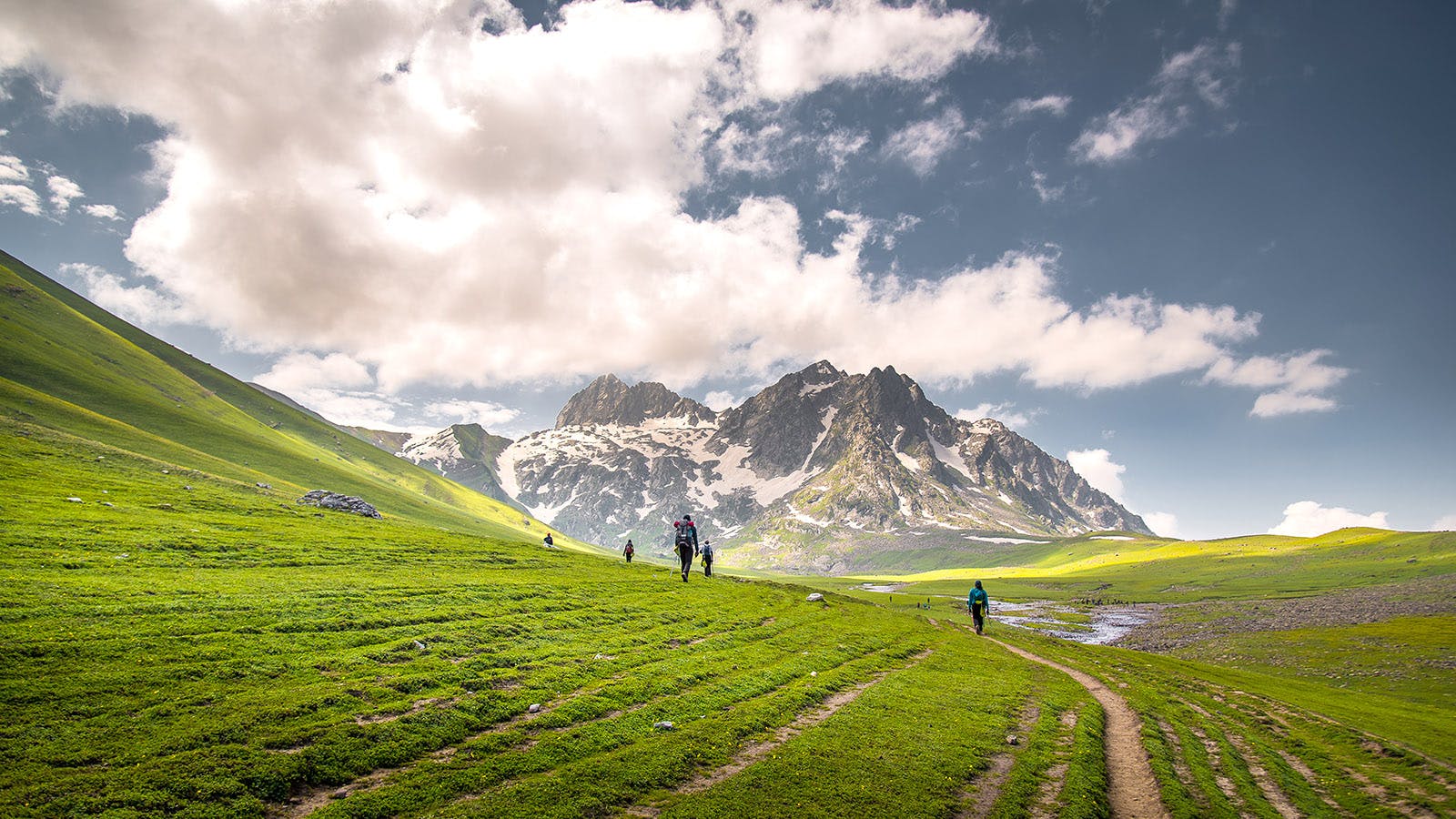
The Satsar Valley landscape ahead is captivating. Isolated mountains stand in front. To your left are a few deep craters.
Picture by: Rajshree
The Vast Satsar Meadows

From the Gadsar Pass which is your highest point, when you look back, you get to see the picturesque lakes of Kishansar and Vishnusar.
Picture by: Swaminathan Jayaraman
The Iconic Gadsar Pass

Most of the campsites on the Kashmir Great Lakes trek are in open meadows where streams are flowing close by.
Picture by: Jones
Open Camping Grounds
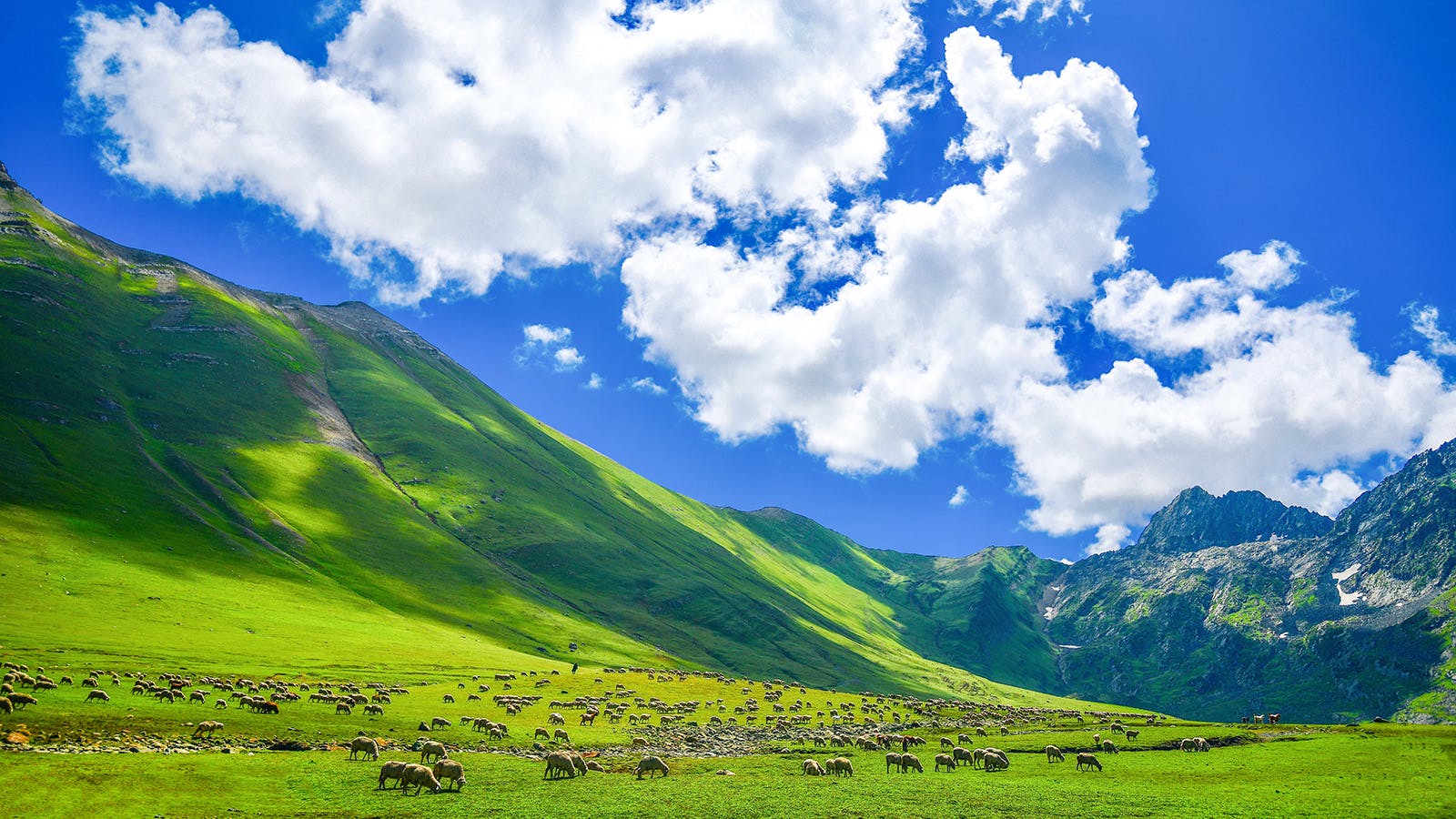
Do not go by just the photos of these endless meadows. You walk through some lovely stretch of the meadows. However, there are multiple ascents and descents to climb on the trek.
Picture by: Gaurav shah
Endless Meadows
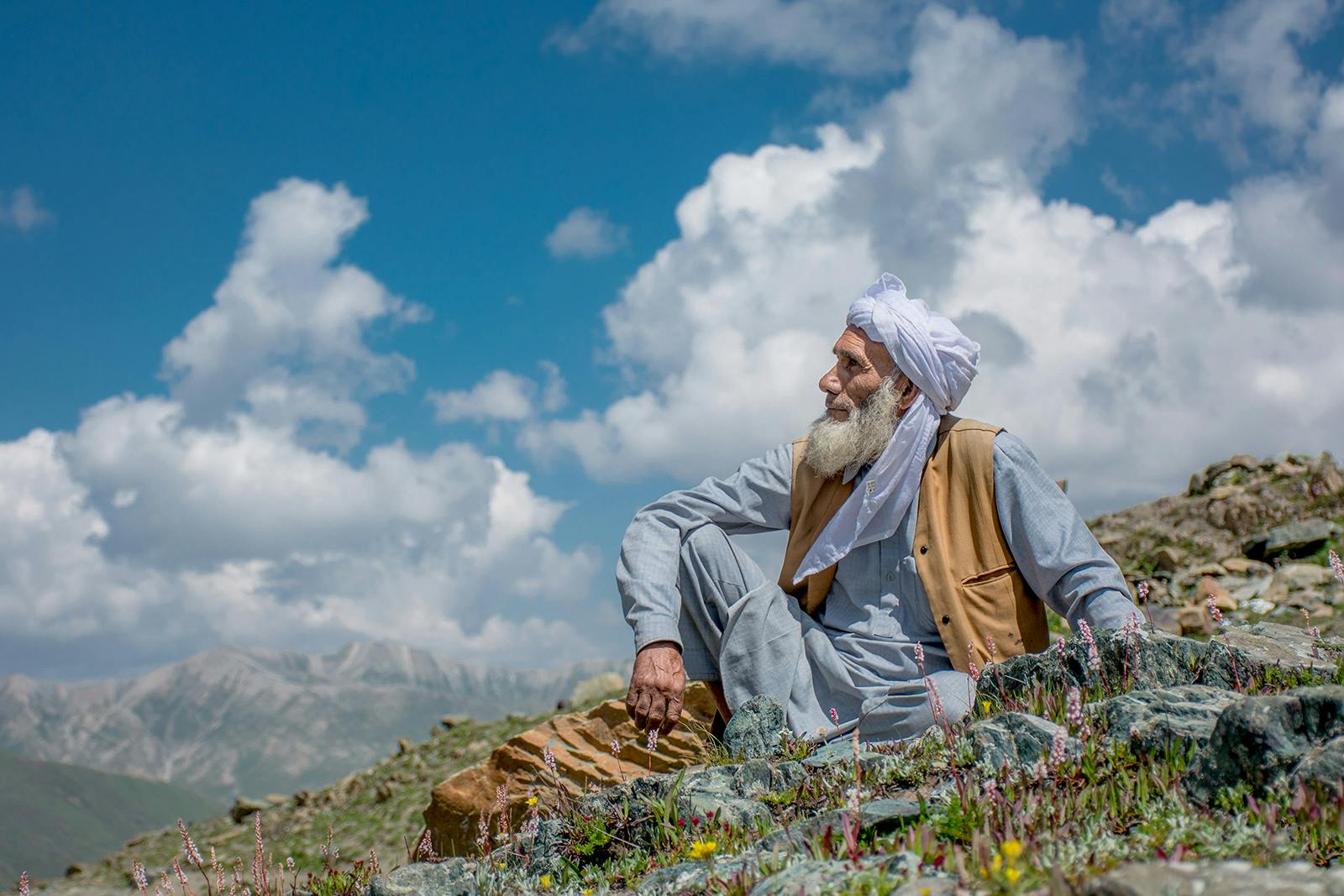
You will see Gujjars on the trail taking their cattle for grazing.
Picture by: Vishwajeet Chavan
A Local Shepherd
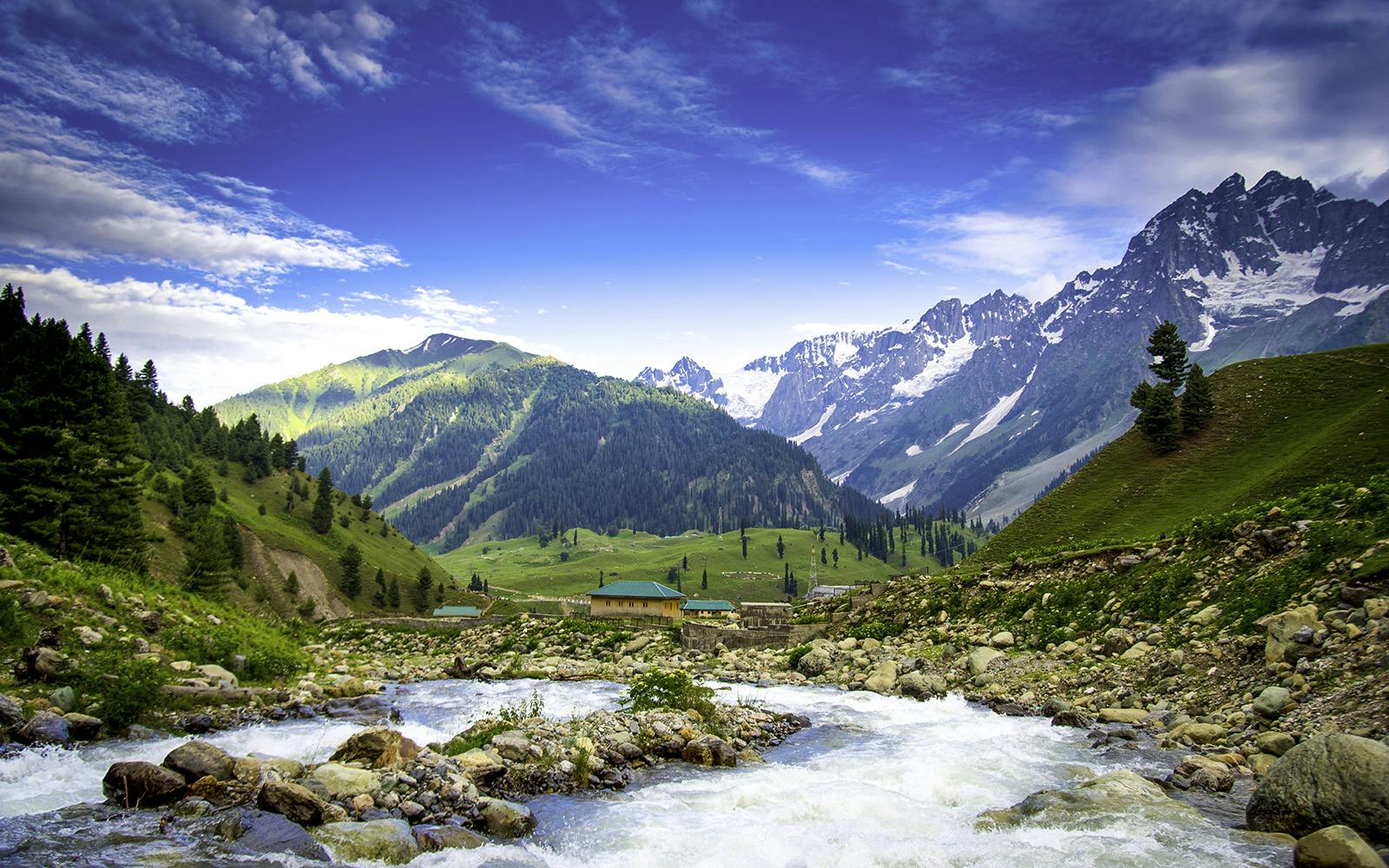
When you start your trek at Sonarmarg, the Thajiwas Glacier becomes more visible.
White Glaciers
Trek Trivia
Things Nobody Tells You About Kashmir Great Lakes Trek
- Wonder of Wangath Ruins
- Surprise Elements on KGL
- Mythological Significance
Naranag Temple
The Naranag temple was built by Lalitaditya Muktapida of the ancient Kayastha Naga Karkota Dynasty. It is believed to be built in the honour of Shiva. Multiple carvings which can be linked to Shiva are found here, and so is the Shivaling.
Another field of study also believes it to be dedicated to the Nagas (divine snakes in Hindu mythology). These Nagas were widely worshipped in ancient times in the region which is now Kashmir. These were also said to be the primary religion during that time. The Karkota dynasty members were religious devotees of the Nagas.
One of the most famous archaeological sites in India, it is built with the characteristic Aryan style of the 8th century. Now lying mostly in ruins, it is still a beautiful archaeological and religious place.
Trouts, the only Life in Kishansar and Vishansar Lakes
Vishansar translates to ‘The home of Vishnu’ and Kishansar means ‘the lake of Krishna’.
Something a lot of people don't know is that the Kishansar and Vishansar lakes are connected. The same water flows in both.
Interestingly, no algae formation can be found in these two lakes. As we know, algae play a significant role in supporting plants and other life in lakes. However, the lack of this algae means that nothing can grow in this lake. Only one life-form has made the exception! Even without algae, trout fish can live perfectly well here.
Gadsar lake, on the other hand, due to the algae growth, always appears green.
In recent years, fishing for these trout grew into a famous activity. However, because of this, the population in the lakes is depleting.
Harmukh, the Home of Lord Shiva
As per some local mythology, it is said that Shiva resides at the top of the Harmukh mountain, at a height of more than 16,000 feet.
The myth goes that once, a saintly man tried to climb this mountain to meet Lord Shiva. He met with harsh conditions on this powerful mountain, and yet tried to reach the peak. His efforts continued for a long period of 12 years. However, he was unable to achieve this, but during his efforts, achieved nirvana and disappeared from there.
A Yatra (pilgrimage) takes place up this mountain in honour of the god. The pilgrims climb up to 14,000 ft to worship Shiva.
The first known expedition led to Harmukh was in 1856 by Thomas Montgomerie for the Great Trigonometric Survey. What is interesting about this, however, is that the world-famous K2 was first discovered on that expedition.
A mountain is as massive as K2 is hidden from many of the local villages, which is why no one around knew of its existence. It turned out, unlike the other mountains in the region, this one, therefore, didn’t have a name. The survey team named it K2 to later change it to the local name. However, the lack of such a name is why the mountain has ever since been K2.
Leaving Mountains Better
Green Trails is our promise to leave the mountains better. We have removed over 1 lakh kilos of the waste left behind by others on trekking trails. Yet this is a small percentage of what we do. Green Trails dives into reducing the use of resources, reducing our carbon footprint and bringing about a change in the daily practices of our trekkers too.

5 Reasons Why Indiahikes
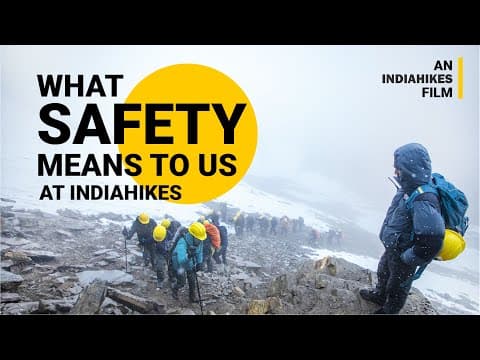
When we brought out new trails in Indian trekking, safety came with us. Back in 2012, we were the first to introduce microspikes, and two years later, pulse oximeters became standard thanks to us. Nobody does safe treks like Indiahikes. In the mountains, emergencies don't care who you're with – everyone knows that when trouble hits, you look for the yellow tents of Indiahikes.
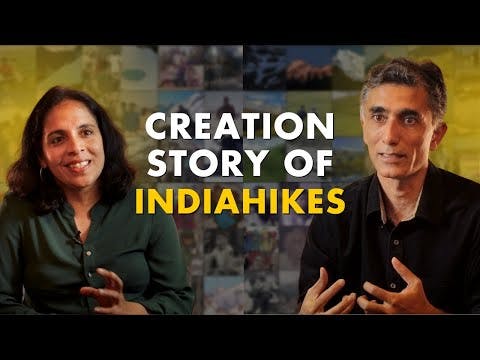
We are pioneers in trekking. Since 2007, we have brought out treks that have become India's most famous treks: Roopkund, Rupin Pass, Buran Ghati, Kedarkantha, Kashmir Great Lakes, Tarsar Marsar, Brahmatal, Phulara Ridge—the list goes on. In 2023 alone, we brought out five new treks in Indian trekking. We know treks better than anyone . This comes directly from the reason why Indiahikes was born: to bring out trek information and enable trekkers to trek on their own.
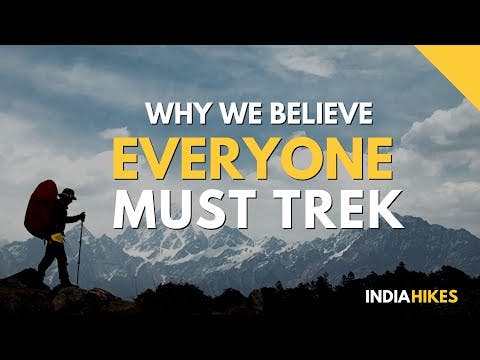
More than 25,000 people trek with us every year. We are the largest trekking organisation in India. 24% of our trekkers come back to trek with us every year. Over 4,000 students from the top educational institutions trek with us every year. Aside from this, families with children choose to trek with Indiahikes knowing that our treks are the safest. We have taken over 8000 children trekking so far, and the number continues to grow.
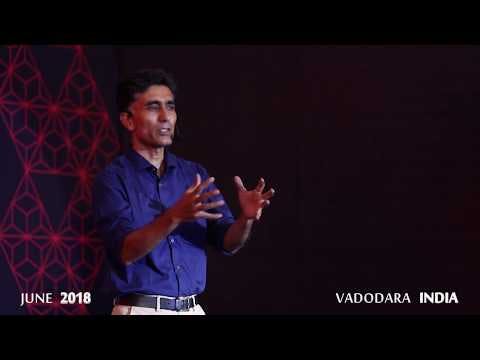
We focus on designing transformative experiences. Our trek leaders conduct thought-provoking exercises that help you reflect and contemplate. This impact stays with you for a long time. Trekkers return feeling energised, more confident, or developing abilities to deal with difficulties. Many have changed careers, rethought their core values, become more humble, shown gratitude to others, or started a new fitness journey.
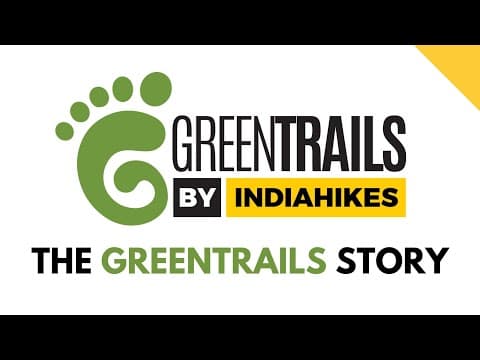
Since 2012, we have pioneered sustainable practices that have become standard in trekking. Using eco-bags, our trekkers have cleared over 120 tonnes of litter from the mountains. We do not carry packaged foods; instead, we serve freshly made food. We do not light campfires; we carry coal to light angethis to keep you warm. Our bio-toilets not only keep our toilets odour-free but also enrich the soil. When you trek with us, you leave mountains better.
Indiahikes Features
You’re guarded with our trek again philosophy
If you are unable to complete a trek, or if you love a trek, you can repeat it with us anytime. You don’t have to pay us for it. See our thoughts behind this here .
Daily 3-time health checks keep you safe at any altitude
Our thrice-a-day oxi-metre checks keep altitude sickness at bay, never allowing you to reach a point where you need evacuation.
Join any group, they are all women-friendly groups
With around 30% of our trekkers being women, all women, including those travelling solo are comfortable to join any of our groups.
Request Jain/Vegan-friendly food
Our kitchen teams understand your needs as a vegan (or a Jain). We will take special care of your food, even in the remote Himalayas.
Be comfortable and sustainable with bio toilets
We have specially designed bio toilets to ensure you have no sight or smell in toilets, at the same time making sure the toilets cause no harm to the fragile ecosystem we trek in.
Fresh, nutritious food at every camp
We’ll admit it. Our love for food surpasses our love for minimalism. Expect freshly cooked, multi-cuisine food at all camps, designed to meet your nutritional requirements and keep your taste buds happy!
Alternative Treks To Do
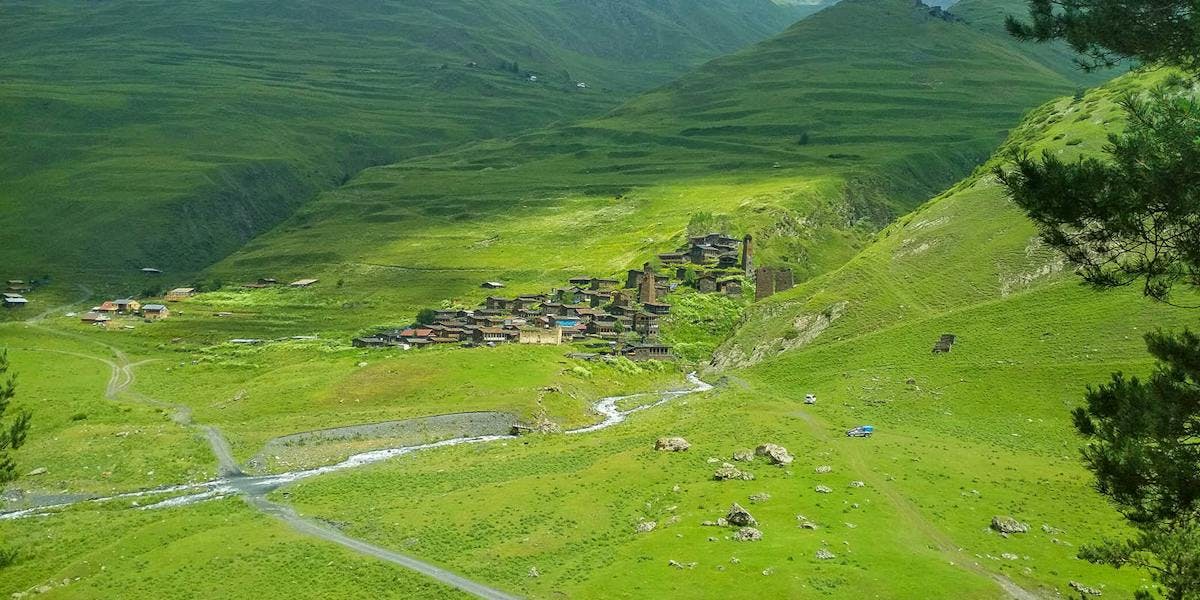
Georgia Atsunta Pass Trek
Get Trek Info
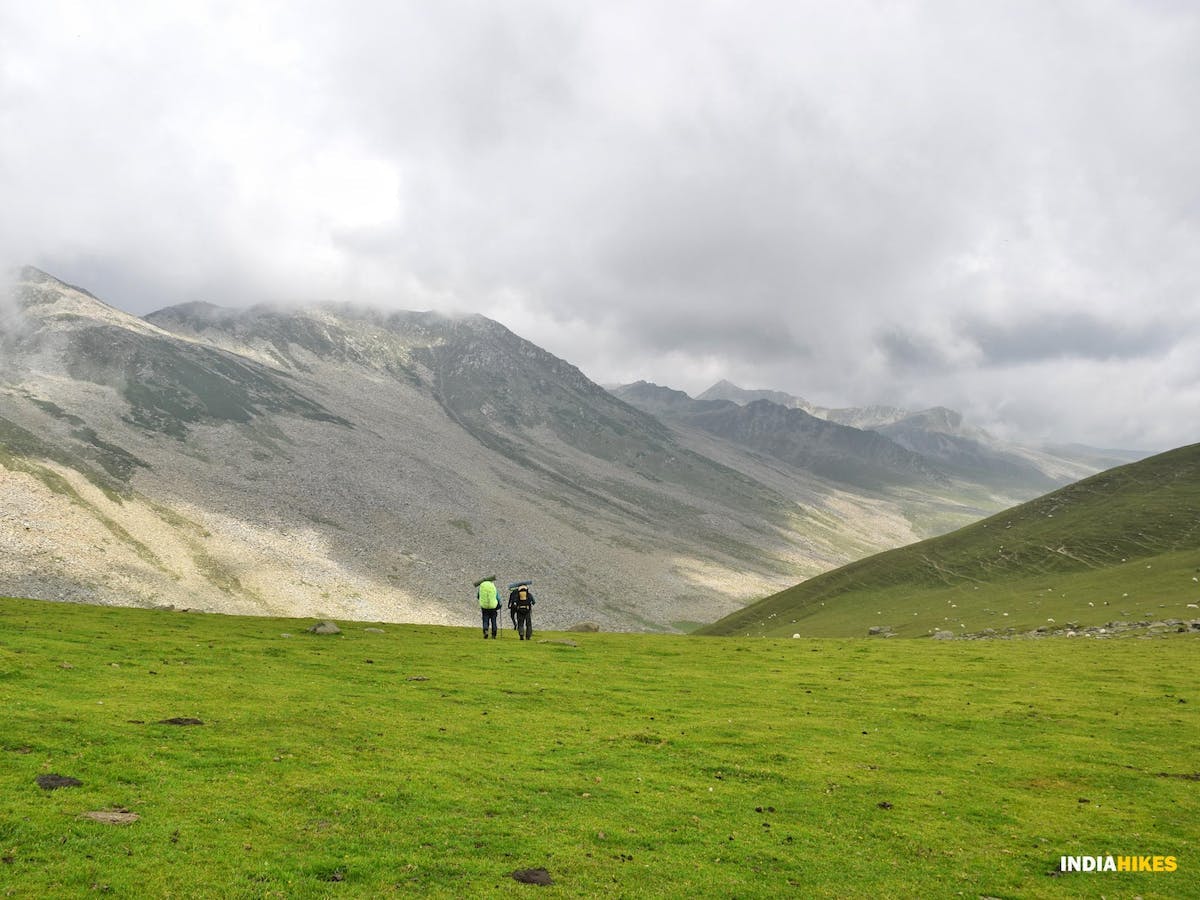
Pir Panjal Lakes Trek
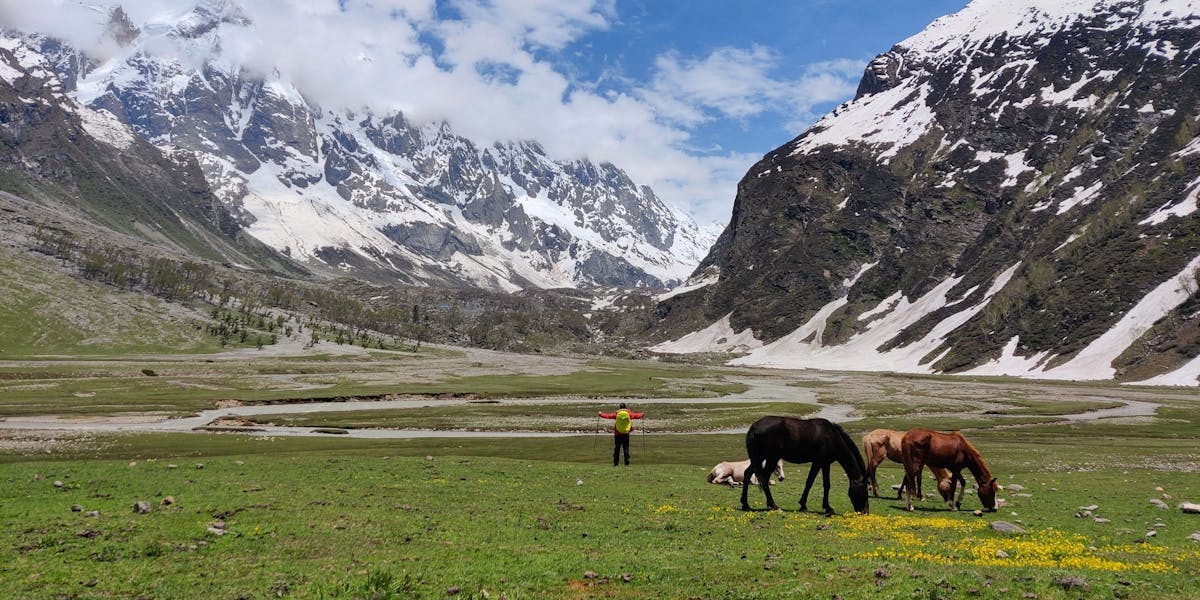
Brammah Valley trek
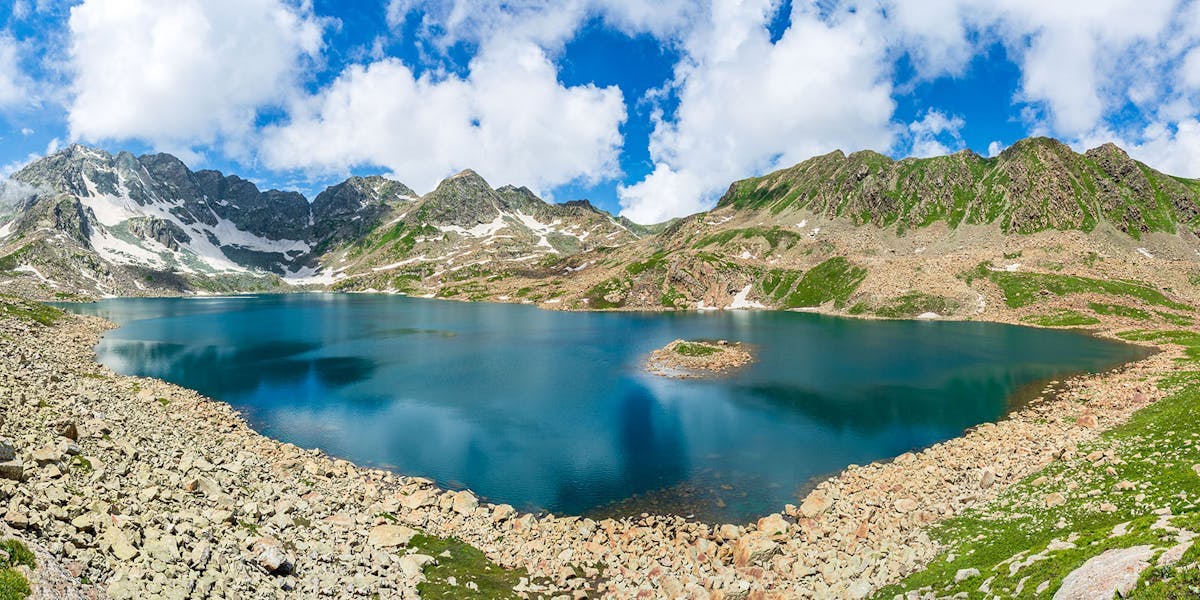
Bodpathri Meadows Trek

Georgia Atsunta Pass...
The flower bouquet trek of Georgia

Pir Panjal Lakes Tre...
The Grandest Trek in J&K with 10 lakes, 4 meadows and endless jaw-dropping moments
Jammu and Kashmir's new trek discovery
Sign up for our much loved Weekly Mailer
We have terrific trekking tips, trek updates and trek talks to look forward to
Treks by Categories
Treks by season, treks by month, treks by duration, treks by difficulty.
- Easy - Moderate
- Moderate - Difficult
Treks by Region
- Uttarakhand
- Himachal Pradesh
- Lahaul and Spiti
- Jammu & Kashmir
- West Bengal
- Chhattisgarh
Treks by Experience
- Family Treks
- Stargazing Treks
- Senior Treks
- Adventure Therapy
- Summer Camps
- Youth Camps
- Cancellation policy
- Work with us
- Our sustainability practices
- Privacy Policy
- Terms & Conditions
080 468 01269 Mon to Sat - 9.30 AM to 7.30 PM Sun - 9.30 AM to 6.30 PM
Bengaluru Office
139, Defence Colony Road, Defence Layout, Sahakar Nagar, Bengaluru, Karnataka 560092
Dehradun Office
No.85/10, Neshvilla Road, Dehradun - 248001
© 2024 Indiahikes Private Limited
All images are copyrighted by their respective authors.
.webp)
Kashmir Great Lakes Trek
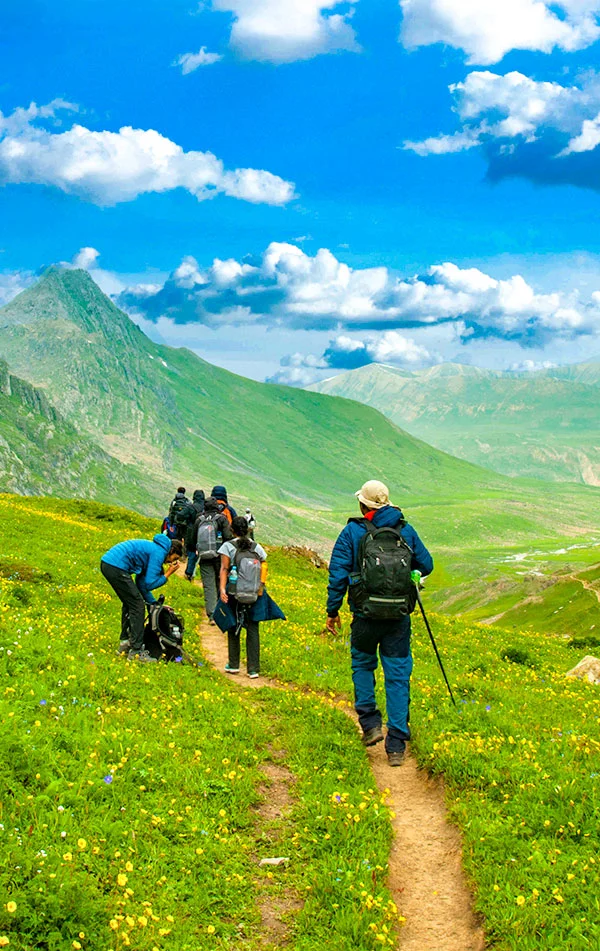
Kashmir | India
Max Altitude
Trekking Km
Moderate to Difficult
Help & Support
17300 /person $ /person.
- August-2024
- September-2024
- +5% GST (goods and services tax)
- Services Sonamarg to Naranag
Insurance 280
Insurance is Mandatory.
Non-Indian rates are slightly higher. Trek coordinator will provide balance payment link post-booking.
- Get insurance through us or elsewhere. If not through us, email for a refund after booking.
Cancellation 4 or more days before the start of the trip results in a 100% cash refund.
Cancellation less than 4 days from the start of the trip results in no refund.
Transport 1700
Transportation Srinagar to Sonamarg & retun is optional
Choose add-ons during booking. If missed, log in and add them later
Book transportation at least 10 days before the trek.
Cancellation less than 4 days from the start of the trip results in a 50% cash refund.
Cancellation after the trip date does not qualify for a refund.
Offload 2100
Backpack offload is optional
Choose add-ons during booking. If missed, log in and add them later.
Book off-load at least 10 days before the trek.
For offline bookings at the base camp, a convenience fee of Rs. 2400 applies.
Cancellations made before the trip date will receive a full refund.
For more information. Please complete this form.
Help & Support
Trek Name: Kashmir Great Lakes Trek
Adventure Type: Trekking
Base Camp: Sonamarg
Season: Monsoon | Autumn |
Month: July | August | September | October | November |
Country: India
Altitude: 13750 Ft.
Grade: Moderate to Difficult
Rail Head: Jammu
Stay: Camping (Twin sharing) & Hotel/Guesthouse
Food: Meals while on trek & at Hotel/Guesthouse (Veg & Eggs)
Location: Kashmir
Distance: 72 Km.
Trail Type: Cross over trail | Start in one valley, traverse the pass, and ends in another valley.
AirPort: Srinagar (sheikh ul-alam international)
The Kashmir Great Lakes Trek is in no need of an introductory treatise. It presents the proem in itself. You can draw a preface of it by just hearing its name. Kashmir is a wonderful place and if you are on a Himalayan trek you are bound to taste the natural beauty and adventure. The trek to the Kashmir Great Lakes offers a lifetime of experience of memories that are so wonderfully reminiscent. The tranquil silence of the Kashmir lakes and their virgin beauty is spellbound. Apart from the lakes, even the barren milky snow-clad mountains stand out in might and pride.
The location of this trek is Kashmir, also known as the paradise of the earth. The trek duration is around 7-9 days and this trek is often graded as moderate in regards to the trekking challenges. The elevation circles around 13000 feet and the distance paths are approximately 63 km. On such a fulfilling trek you will learn so much learn about yourself- in a trifecta – physically, mentally, and emotionally. For a trekker, nothing can replace and prepare him for those paramount and conflicting emotions that whether his body will take so much strain and whether he will make it or not. But the joy of reaching the destination is obvious. This trek will always be happy and a cherishing trek for the trekkers that comes in handy with a few preparations.
As the trek to the Kashmir Great Lakes Trek demands physical fitness, you must take good care of your health, shape yourself well and be fit and fine. Trekkers can train themselves by working out regularly in the gym along with running, walking on an incline, cycling, cross-training, and stretching on a daily basis. Along with physical health mental fitness is important equally.
Coming to the details of the trek, it generally starts from almost 3 km out of Sonamarg, on the Srinagar road. You can find a few dhabas on your way. Its better for the trekkers to pick up short eats here for the next trace of a dwelling place will be at Naranag which would probably mark the end of the track.
A few of the trail and the trek enters a green meadow, overlooking the Sonamarg town. At the top of the meadows, trekkers reach the starting line of Maple and Pine trees. What follows is a lovey-dovey deep dense forest of Maple trees. Such an experience has always been unique to this trek in India.
You will always be amongst the meadows throughout this trek. The best time to enjoy the Kashmir Great Lakes trek is between June and September as the greenery and the blooming flowers are at their best during this calendar period. Its so that a beginner in trekking can also join this trek.
Trailing through the Maple trees uphill, trekkers can enjoy the crystal clear view of the nearby villages downhill and especially the Sonamarg village. Every bit of nature nestles to make a wonderful picture. From here the trail slopes down into yet another meadow lined by the Silver Birch trees and a few shepherd huts. Massively tiny brooks struggling through the meadows and snowy peaks of small mountains mark the land of Shekdur. Shekdur is the only campsite with trees on this trek. It is therefore an add-on to your clicks. The suns rays piercing through the forest, make it a nice show of dark and light. Further, the trail climbs back into a river valley which is the beginning of Nichanai. You have entered into a wide valley encompassed by the peaks.
After crossing a tunnel-like Nichinai pass followed up by miles of spreading meadow and the cascading waterfall comes the Vishansar Lake. The first impression that the lake imposes upon the trekker is its larger-than-life size and snow-clad mountain peaks surround the azure lake waters. It is been followed up by the Kishansar Lake which is only at a distance of 1.2 km. It has a big meadow stretching by its side. The trail follows up through a ridge. You can see the loveliest view of the two lakes that you have just crossed together from the Gadsar pass which is the highest point of this trek.
Then the time comes to descend. On the way back, the eye captures the view of Yamsir Lake, the nameless lake, and the Gadsar Lake which are all connected by streams. Further, you will come to a place called Maengandob where a few deep craters are found. The landscape ahead is magnificent as you get to visit Satsar Lakes-collection of seven Lakes and further the twin lakes among which the bigger is the Gangabal and the smaller one is Nundkol. At you arrive at your last destination, Naranag and you are greeted with awe-inspiring glaciers, meadows as well as mountain peaks.
The trek to the Kashmir Great Lakes Trek will provide the trekkers with a perfect flavour of all hues of the Kashmiri terrain- innumerable meadows, snow-clad glaciers, pinnacles, passes, rocky barren lands, and gurgling streams. The trail to the Great Lakes is worth trekking. It does justice to all the expectations of a trekker.
While trekking, trekkers must be equipped with the necessary equipment. Apart from the professional trekking gear including a pair of trekking shoes, and a trekking pole is important specifically. Trekkers must never compromise with their body requirements. Its better to understand your bodys needs and not proceed under peer pressure if you don’t feel well. Keep your luggage as light as possible. It will be in your comfort.
- Who can Participate
- Important Links
- How to Reach
- Trek Essential
Who Can Participate
Age; 15 years.
Experience of any high altitude trek, at least 1 treks of 4,000m/13,100ft.
The climber must be fit and have sufficient stamina to cover 5 km of distance in 30 minutes without stress.
The climber should be able to carry a 12-16 kg backpack.
Pulse rate at rest must be in between (60 to 90 beats per minute)
Blood Pressure Reading must be in between (DIASTOLIC 70 – 90, SYSTOLIC 100 - 140 mm Hg)
Respiratory rate at rest must be in between (12 to 20 breaths per minute)
Should not have Liver and kidney issues
Should not have Diabetes Mellitus, Bronchial Asthma, Heart problems, Hypertension etc
No pacemaker implant
People with the Sinus issues, Epilepsy please contact to trek coordinator before booking the trek
If your BMI is not normal, Please contact our Trek coordinator before Trek booking.
Medical & Disclaimer Form (Mandatory Documents) Click here to download Medical & Disclaimer Form
- Government Employees can avail the benefit of Special Casual Leave (SCL) when you join us for a trekking expedition. As per the rules of the Pay Commission, Special Casual Leave can be availed for up to 30 days in a calendar year for trekking/mountaineering expeditions through a registered organization. Trek The Himalayas is a registered adventure tour operator by Indian Mountaineering Foundation (IMF) and Ministry Of Tourism (MOT)
- Trekkers have to apply for leave at least 20 days before trek departure date,
- This service is exclusive to Indian government employees and is applicable only for treks within India.
- Do mail at info@trekthehimalayas to apply and mention your booked trek date and trek name.
Junior trekkers (below 15 years) should have a company of parents/guardians.
Trekkers between 15 to 18 years can come solo with the disclaimer form signed by parent/guardian.
- Medical & Disclaimer Form (Mandatory Documents) Click here to download Medical & Disclaimer Form
Exercise For Moderate to Difficult
Fitness Regime For:
Calculate Your Bmi
Your BMI value is
Congratulations, your body is in good conditions!
Arrive At Sonamarg
- Altitude: 2,400 m/ 7,800 ft
- 90 km drive from Srinagar, approx 3 hrs
- If booked in advance, TTH can arrange pickup from Nishant Garden, at 12 pm
- Our campsite is near the Sindh River (Shitkadi Village)
- Since there are no shops around ensure that you have all that you need already
- Remember to carry your ID proof in original and 2 photocopies as we have to submit them at the army check post.
The journey to Kashmir Great Lakes begins from Shitkadi Village, which is a little ahead of Sonamarg and about a 3 hr drive from Srinagar. TTH representatives will pick you up from Sonamarg and drive all the way to Shiitkadi, where you will rest for the night before beginning your trekking adventure the next day. Before you begin your trekking adventure, you will spend the day in the beautiful surroundings of Shitkadi Village. You can spot some of the great mountain peaks like Kolahoi, Tribal, Machoi, Amarnath Peak, and Machoi Glacier. The view en route to the campsite is very scenic and all along the route, you will see the vast expanse of grasslands and meadows on either side of the road. The stay is arranged at Shitkudi Campsite. There will be a briefing session in the evening before dinner. Dine early and give your body enough rest to begin your trek tomorrow.
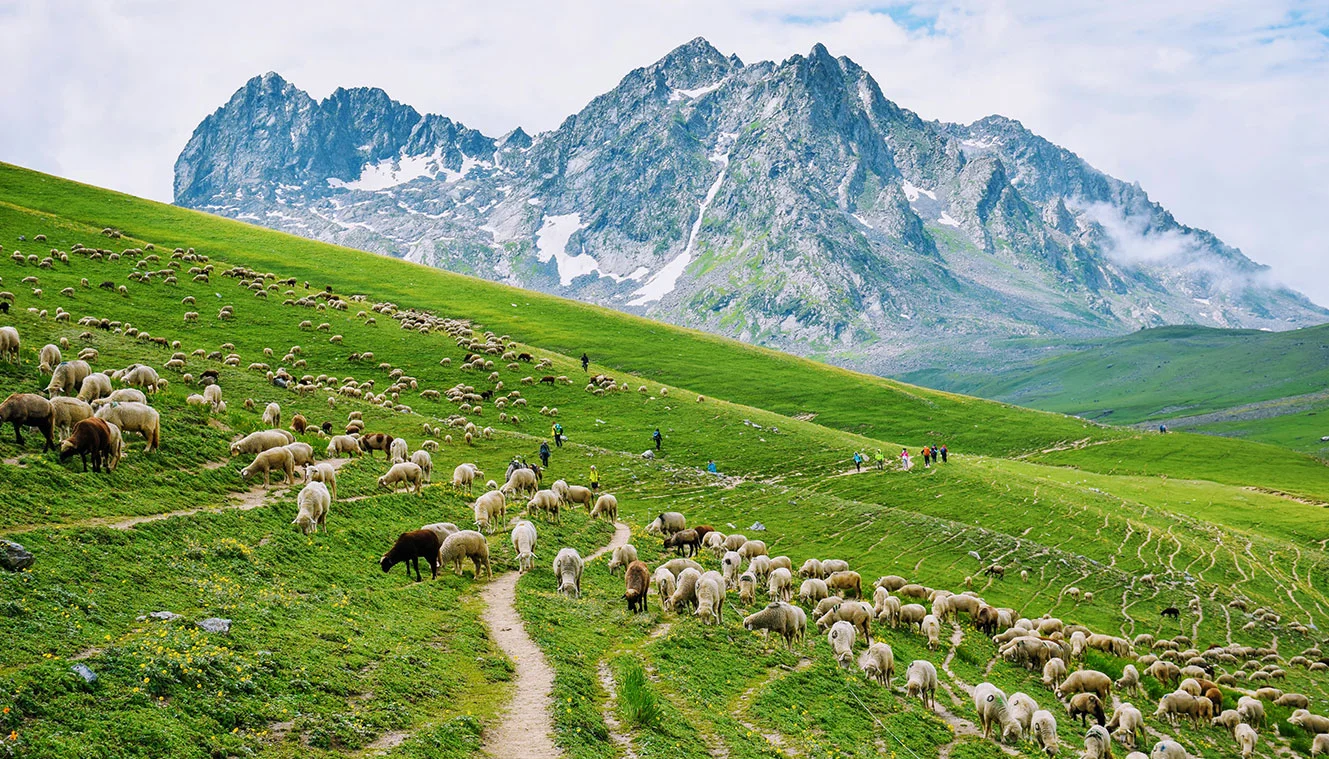
Sonamarg To Nichinai Via Shekdur
- Altitude: 3,500 m/ 11,500 ft
- 11 km trek, approx. 8 hrs
- Altitude Gain: 1,100 m/ 3,700 ft
- After breakfast, we trek to Nichinai via Shekdur
- The trail takes you through meadows, and dense forests with Maple, Pine, and Bhoj trees.
- After approx. half an hour, we get to an army check post where we have to submit our ID proofs
- While you are at it, you can enjoy an awesome view of the Sonmarg Valley or the Thajiwas Glacier
- The trek from Shitkadi to Shekdur goes through thick forests of pine trees and will take approx. 2 and half hours
- At Shekdur, you can indulge in instant noodles and an omelette if you wish to
- We follow the Nichinai stream as we trek from Shekdur to Nichinai
- We have lunch at the Nichinai stream.
3 hours ascent followed by 1 hr descent and finally a gentle ascent to Nichinai (6 hrs, 9 km).
The trek starts 3 km out of Sonamarg, on Srinagar Road. Exactly at the 3 km mark, spot a lone Dhaba on the right. The place also sells packaged water, biscuits, etc., and is your last place to pick up any snacks or little bites. The next trace of civilization can be spotted at Naranang after the trek.
A jeep track diverts to the right off the main road at the shop. The track goes down to the level of the Sindh River that flows in between the mud track and the main road. The trekking trail starts along the track but quickly diverts higher up. 10 minutes into the trek, the trail bends and enters a green meadow. The meadow directly overlooks Sonamarg town. In half an hour, you reach the top of the meadow from where tree lines of Maple and Pine start. Once you reach the tree line, the trail descends until a tiny brook and then climbs up again and what follows next is a lovely dense forest of Maple trees. Walking on green beds of grass amidst the Maple cover is an experience unique to Kashmir in India.
For the next hour and a half, the trail winds up through Maple trees. Stick to the trail that goes in an uphill direction as the one heading down diverts into the nearby villages. Occasionally, the trees give way to clearings. Turn around and delight in the spectacular view of the Sonamarg Valley that gets bigger and fuller as you keep gaining altitude. The Maple cover accompanies you to the top of the ridge and on one side a meadow gently slopes down. Spend a few moments on the ridge, enjoying the view of Sonamarg and the neighbouring Valley. The streams, the meadows, the pines, and the towns nestled together make a wonderful picture. The climb now gradually goes downhill as the trail slopes down towards the meadow that is lined with Silver Birch trees and a few shepherd huts. The carpet of green rolls down from the treeline all the way to the end of the 40 ft wide meadow. There are a couple of small brooks that cross the meadow, which can be your source of water. On your right, you can see a small group of peaks covered in snow. You are now in Shekdur. If you wish to keep your trek short for the day, you can also opt for pitching your tent here. From the road head, it takes 2 1/2 hours to reach Shekdur meadows, it will take about half an hour more if you decide to end your trek at the edge of the meadow.
The Shekdur Campsite is surrounded by Bhoj trees on all sides and this is the single such campsite that has tree covers thus this is a good spot to take some Instagram-worthy photographs. If you have started from Srinagar in the morning, make Shekdur your first camp. The next campsite Nichinai is at least 2 more hours away.
If you started from Sonamarg then Shekdur is just three hours away which makes it too early to camp. Having lunch at Shekdur campsite head to Nichinai campsite. The meadows of Shekdur stretch for half an hour. The gentle descent of the meadow now ends in forests of Bhoj or Silver Birch. Take the trail that goes in the middle of the forest and continue to descend gently. Watch out for sun rays making their way in between the thick foliage making it a nice show of light and dark.
In 45 minutes, you reach the end of the Birch trees and the trail goes down and climbs back into a river valley. The River Valley is the beginning of Nichinai. The trail is now along the right bank of the river going upstream. Look behind to see the snow-clad peaks of the Sonmarg Valley. You are now in a wide valley enclosed by mountains on either side. The river, which joins the Sindh eventually flows with speed through the valley. The first 30 minutes is over rocks and if you are taking mules, they will walk very slowly over here.
An hour more into the river valley, green patches devoid of rocks open up. The river valley widens and you can see the green meadow widening in between the two mountain ranges. Far ahead lie triangular twin snow-clad peaks. At Nichinai campsite, find a clear spot to pitch your tents, ending the first day of the trek.
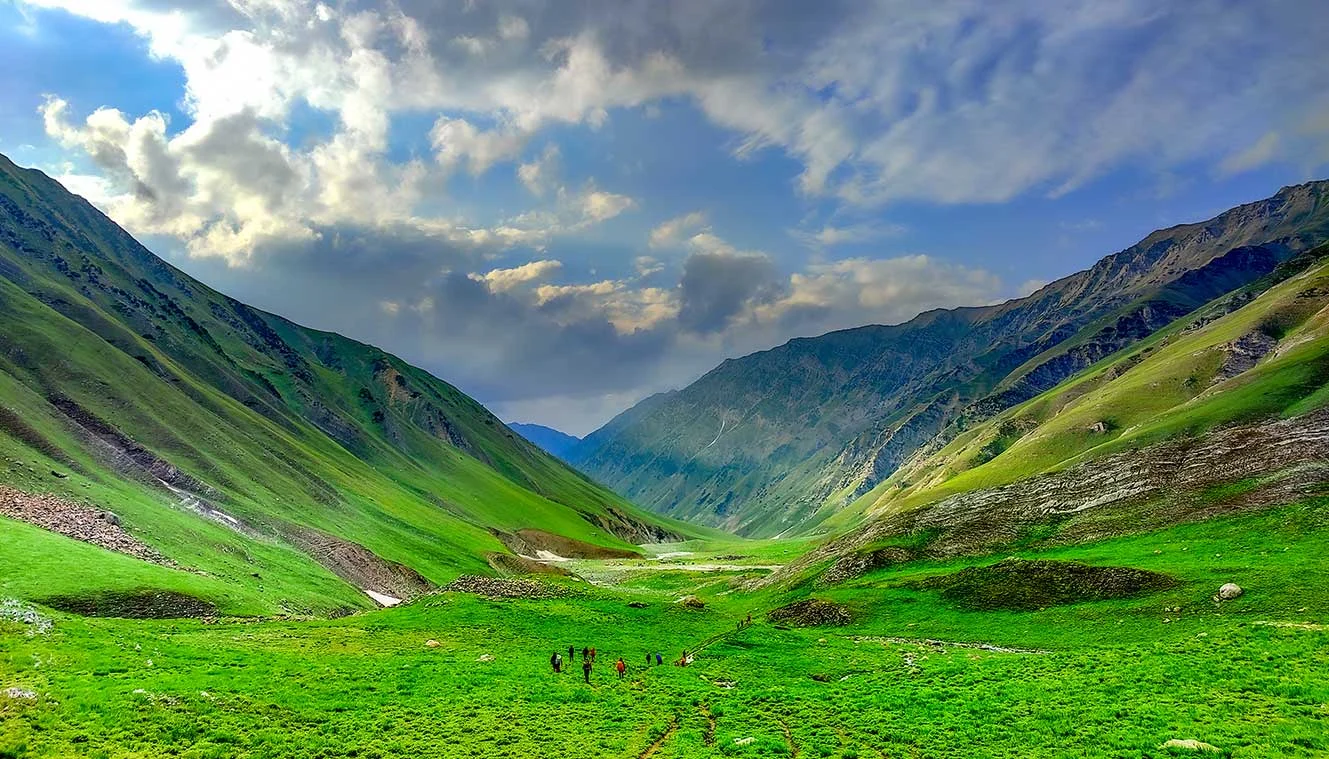
Nichinai To Vishansar Lake
- Altitude: 3,650 m/ 12,000 ft via 4,000 m/ 13,100 ft
- Distance: 12 km | Duration: 7 hr
- Trek from Nichinai to Nichinai Pass is approximate 1 and half hours accent. At the top of Nichinai Pass, you can get the BSNL network, which is the last point under the mobile coverage area.
- From Nichinai Pass to Vishansar there is a descent
- At Vishansar campsite lunch will be offered.
- We can visit the Vishansar Lake, which is just 15 minutes walk from the campsite
- The first lake of the trek and one of the most beautiful ones
- If the trek is in July, the lake will be frozen. Otherwise, we can go fishing at the lake, with the permission from Srinagar fishing department.
- Vishansar is visited by hoards of sheep and their shepherds who always have some interesting stories to tell.
- A campsite is a unique place with open ground and you can play volleyball, cricket, etc.
- Beware of dogs at the campsite.
Moderate climb to Nichinai Pass (13,000 ft). Small descent followed by a long flat meadow walk ending near Vishansar Lake (12 km, 6 hrs).
We start the day early around 7 or 8 in the morning to begin our trek towards the first of the Great Lakes, the Vishansar Lake. The day's trek is more or less a long walk on the alpine grasslands of Kashmir. Start your trek from Nichinai to Nichinai Pass, which is visible from the campsite. Half an hour into the walk and you have to cross the gurgling stream to reach its left bank. The trail starts ascending here and for the next one hour, you will climb up gradually to the Nichinai Pass. The Nichinai Pass is the highest point in today’s trek and is located at an altitude of 13,500 ft. From the pass, it’s a small descent and then a flat walk on the meadow all the way to the Vishansar Lake.
As you continue climbing the Pass, you will see the lake down below at the foot of the mountains, it appears to be a small deep-blue enclosure. The trail that you are walking on now is not the original ridge and it will turn inwards two times before you arrive at the Nichinai Pass. The Nichinai Pass is like a big tunnel and from the top, you can observe the Sonamarg Valley down below. BSNL network is erratic here and this is the last point where you will get any network. The next traces of the network are available when you have moved past Gangabal. On the left of the pass lies the mighty peaks of the Himalayan region, whereas on the right side, there are no mountains but the ground rises up. While some may find the climb to the Nichnai Pass a little strenuous as it is a straight climb, however, there is good news as the trek post the pass is a downward climb. The trail from the pass descends rapidly and in about an hour, you will reach grassy lands from the rocky area. The meadow is a vast expanse of land spreading far and wide with snow-clad mountains surrounding the entire meadow. There’s another river flowing from the pass into the meadow ahead. To your left, you will also see a big waterfall cascading down and mingling with the river. As you walk on the meadows, you will notice two streams crossing the meadows, stick to the banks of the one on the left, and in about half an hour, you will have to make a stream crossing but be prepared as the water is going to be icy cold.
At the end of the valley, a river flows perpendicularly from left to right and this river actually originates at the Vishansar Lake. The lake is not visible yet as it is a little higher on the top. This is a good place to pitch your tents by the river. After the trek, if you have ample time, you can explore the twin lakes or wait for it until the 6th day. From your campsite, the Vishansar Lake may be about 0.5 km away and about 100 ft high. The Vshnusar Lake is nestled beautifully between 4 mountains and the Kishansar Lake beautifully reflects in the lake waters. The colour of the lake changes according to the time of the day and the cloud cover. Before sunrise, the lake is usually colourless and on a clear day, as the sun rises, the water of the lake starts getting blue on a sunny day, the water of the lake is a deep aquamarine blue. As the sun gets closer to setting, towards the end of the day and it becomes a greenish-blue towards the end of the day. This is the first lake you will see on the trek and eventually, you will check other lakes as well. Today we will camp close to Vishansar Lake.
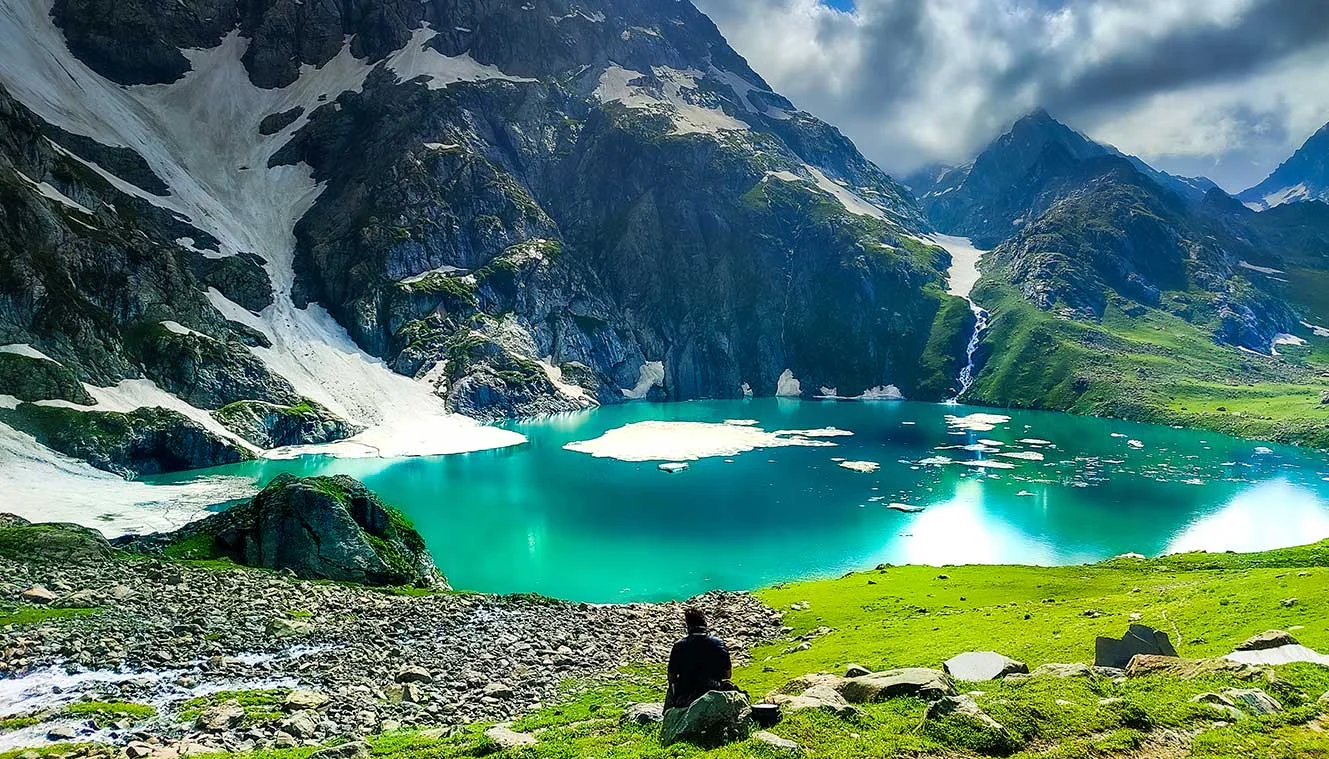
Acclimatization + Rest Day (Conditions Apply)
Day 4 is reserved for acclimatization as you need to give your body enough time to adjust to the conditions of higher altitude. The next lake following the Vishansar lake is the Kishansar Lake. Kishansar is 0.5 km away from Vishansar and is situated at the base of the Kishansar Peak. It will take about 45 minutes to trek to Kishansar from Vishansar. You can take a short acclimatization walk to Krishansar Lake for acclimatization purposes. The trail to the Kishansar Lake climbs from the right side of the Vishansar Lake. On the right-hand side of the Kishansar Lake lies a big meadow which is a perfect spot for capturing photographs.
Note: The use of acclimatization day is subject to change to weather conditions. If the weather is really good then we won't stop for acclimatization but rather move forward to the next campsite. Acclimatization day can be used layer at Gangabal campsite.
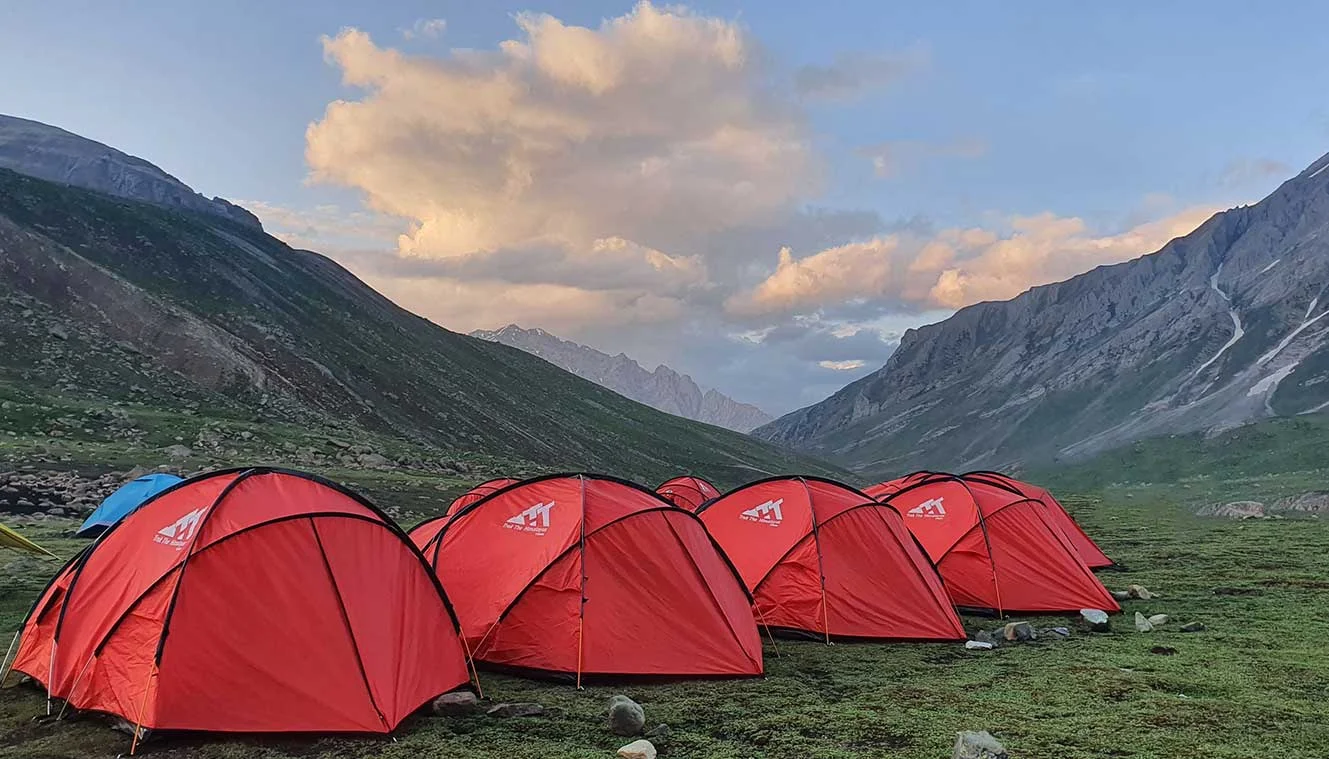
Vishansar Lake To Gadsar Lake Via Gadsar Pass
- Altitude: 3,650 m/ 12,000 ft via 4,200 m/ 13,750 ft
- 14 km trek, approx. 10 hrs
- We start the trek earlier than usual
- The trail passes from Vishansar To Gadsar via Gadsar Pass, the highest point of the trek.
- From Vishansar, the trail takes a steep ascent till Gadsar Pass
- We can spot the Kishansar Lake on the way
- From the Gadasr Pas till the campsite, we descend gradually
- We can spot the Gadsar Lake en route
- You might also spot the glacier of the Gadsar Lake
- After the Gadsar Lake, we will reach the campsite in two hours
- Just a few minutes before our campsite, we will have another army checkpoint and we will have to share our IDs
- Packed lunch will be provided during the trek
Steep 2 hours ascent followed by a steep descent following a gentle walk in the meadows (5 hrs, 10 km)
Today we will trek to Kishansar Lake via Gadsar Pass. From your campsite, you can spot a very thin line travelling through the side of the mountain, this is the trail that you need to follow today. A climb of about an hour and a half will take you to the top of a ridge, another 45 minutes in the climb and you will arrive at a spot that will totally captivate you with an amazing view. There comes a point from which you can see the Kishansar and Vishansar Lakes together in full view. This enchanting view accompanies you all the way to the top of the Gadsar Pass. The Gadsar Pass lies at an altitude of 13,750 ft and is the highest point on today’s trek. Relish the view from the top of the Gadsar Pass for a while before moving ahead. On the horizon line on one side are the snow-clad majesties of the Himalayas and on the other side, a gorgeous valley stretches with 2-3 small lakes visible from the top. The peaks that you can see from the top of Gadsar Pass lie out of the Line Of Control (LOC).
Once you reach the Gadsar Pass, it is a steep descent below and en route, you will first spot the Yamsar Lake, a quaint little lake not very popular among the people. Yamsar Lake can serve as the first landmark that takes you to Kishansar Lake. Continue from Yamsar and about an hour of descent will bring you again to flat grasslands or meadows of the beautiful Kashmir Valley. This time the valley is a bit narrower, the mountains surrounding the meadow on either side. Multi-colored flowers line the green grass of the valley and give it an ethereal look. Once you have arrived at the area near the blue Irises, Gadsar is not far away. Soon you will reach Gadsar, one of the prettiest alpine lakes you have ever seen. Gadsar Lake lies at an altitude of 12,000 ft and the sheer beauty of it will leave you speechless. Gadsar is located at the base of mighty snow-covered peaks. On the one side, you will see snow blocks cascading down to the lake from the mountains, and on the other side, you can see colorful flowers and greenery making for a mesmerizing sight.
Gadsar Lake area will be our campsite for the day, although not many people camp here. If you are camping near Gadsar, make sure that you leave the campsite as clean as you found it. If you do not opt for camping by the lake then continue your climb further downhill to the Gadsar army camp. About half an hour into the trek, the narrow valley opens up and becomes wider, you can see another blue lake on the left-hand side of the valley. As you move on, you are losing a considerable amount of altitude. Continue for another half an hour and you will start noticing the Shepherd huts lining the edge of the valley, keep walking and after about half an hour you will arrive at the army camp. The army camp is a small hut that houses 5-8 army men and to move further beyond the camp, you will have to obtain permits from the army headquarters. The headquarter is located three miles from the checkpoint, follow the tree line into the village to find the HQ. The Gadsar army camp communicates with walkie talkie and the HQ is equipped with a satellite phone. A pro tip: When you are near the army camp, report as quickly as possible as it takes about 2 to 3 hours for the green signal to come through from the headquarters. Your ID proofs will be checked, collected, and recorded before you can proceed further.
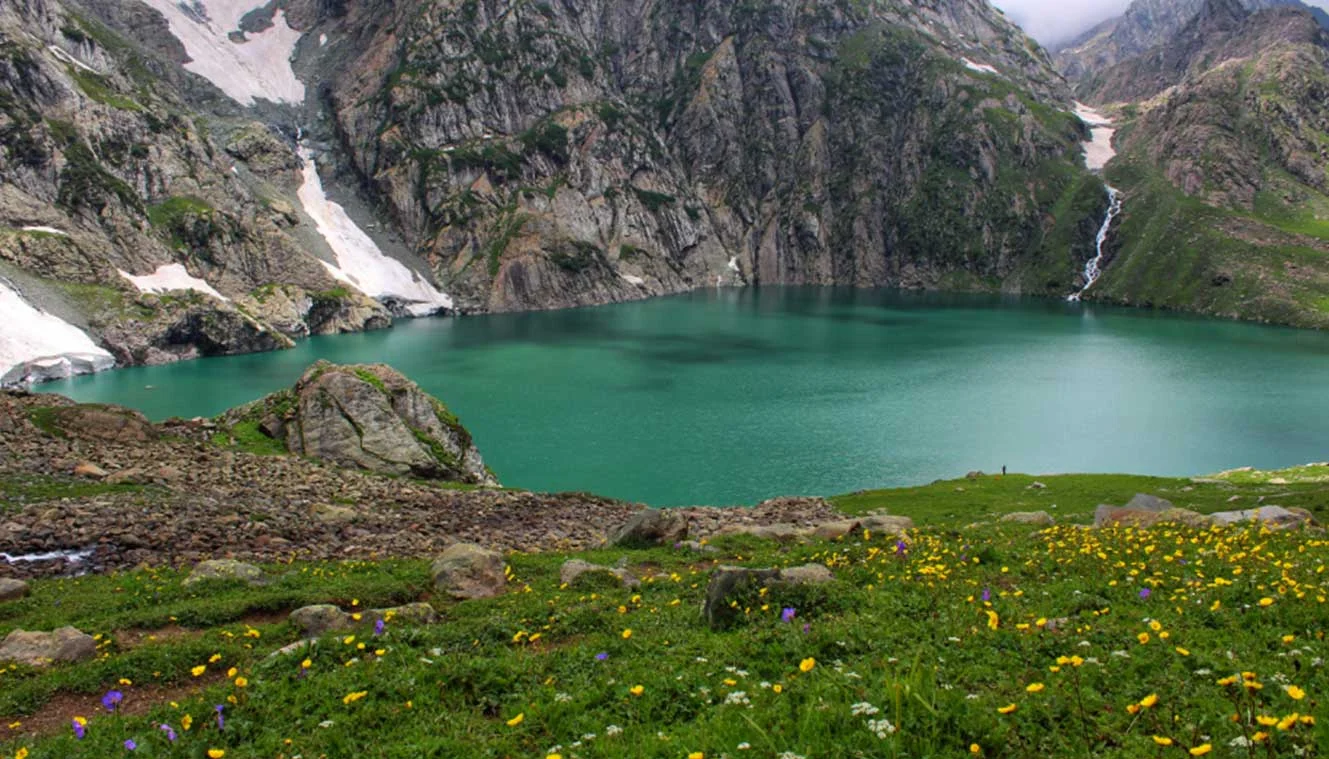
Gadsar To Satsar
- Altitude: 3,650 m/ 12000 ft
- Distance: 9 km | Duration: 6 hrs
- Mid-July to mid-August, the trail is laden with vibrant flowers
- We need to share our IDs at another army check post en route
- Moving on, we see two small lakes which are often mistaken for Satsar Lakes
- We will visit Satsar twin lakes in the afternoon, which are approx. 1.3 hr apart
- Satsar Twin Lake is also known as Mengen Top
- The twin lakes are situated in the middle of two mountains.
Gentle descent or 1 hr followed by a steep ascent for 3 hrs followed by a flat meadow walk (6 hrs, 12 km)
From the army camp, move left towards the stream, to head up into the mountain. You are now above the tree line and you can see the tree cover and the rivers below you. The climb continues for an hour and a half and you gain an altitude of 1,100 ft. Once you cross past the 11,500 ft mark, the climb transforms into a traverse and bends towards the left leaving the river valley. Once you are out of the river valley, you will be walking on a flat meadow surrounded by mountains on all sides. This section of the trail is called Maegandob and you may also spot a few craters to your right. Soon you will spot first of the Satsar Lakes. The name Satsar translates to ‘Sat’ meaning seven and ‘Sar’ meaning lake. Satsar is a collection of seven lakes which justifies the significance of the name.
If Gadsar Lake was your last camping spot, you can choose to camp here. However, if you camped in the army camp then it is justifiable that you trek a little further and camp near one of the Satsar Lakes. Out of all the lakes, you may find 4 to 5 lakes with water, depending on the season you are visiting Kashmir in. Once you cross the bridge, you will come across another army check post, this will be the third check post on your route, and the same process of checking, collecting, and recording your ID and information will continue. After the procedures are done, you can continue on your trail and after 10 minutes of walking, you will arrive at the first of the Sat Sar lakes. The lake is set in a picturesque setting with lush greenery and mountain views, and the emerald-blue color of the lake changes hues with time.
Satsar Lake is our camping ground for the day. Find an ideal spot for camping near the lake and pitch your tents. Retire early in your tents and give your body the rest it deserves after a long day of hiking.
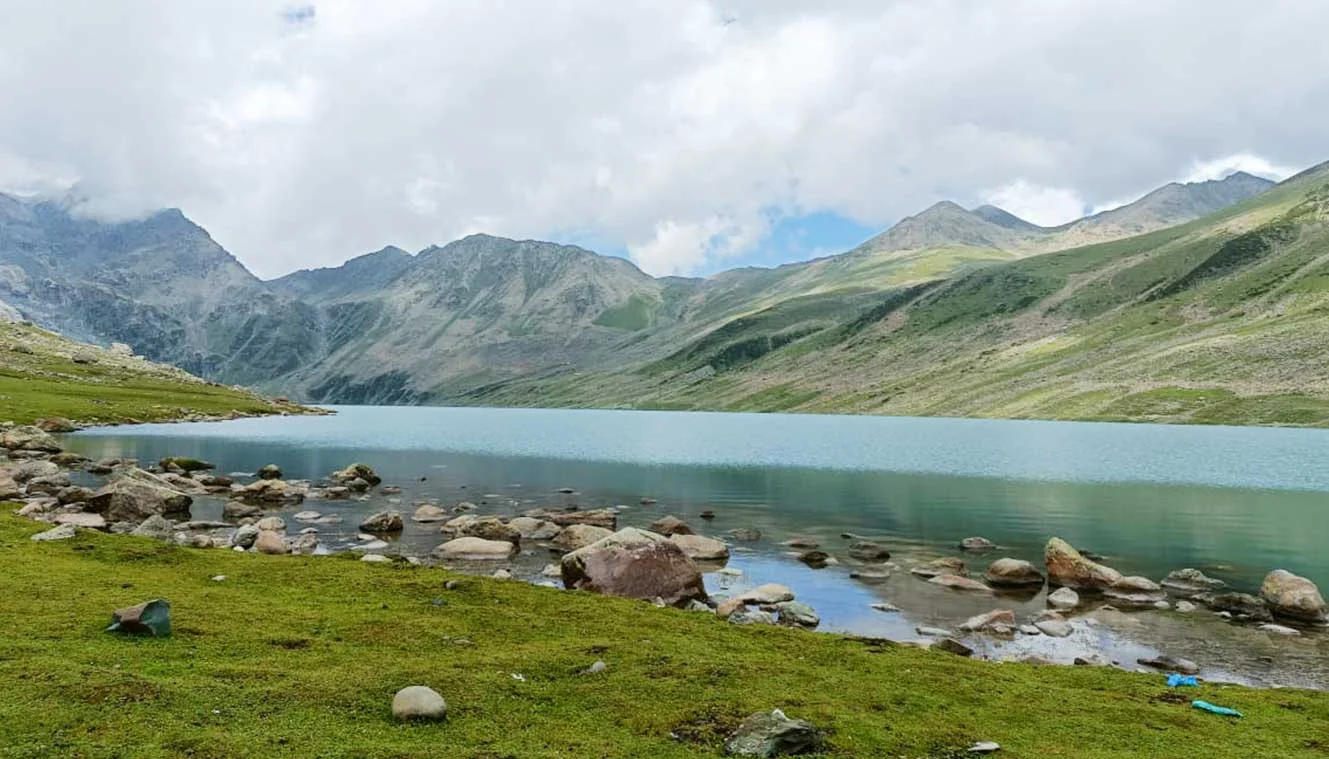
Satsar To Gangabal Twin Lakes Via Zaj Pass
- Altitude: 3,500 m/ 11,500 ft via 3,950 m/ 13,000 ft
- Distance: 11 km | Duration: 6 hours approx.
- We walk on rocky paths for approximately an hour and ascend to Jazz Pass
- At the Pass, you can enjoy views of the 4 lakes as well as Mt. Harmukh and its glacier.
- From the pass, we descend till Gangabal Lake and camp at Nandkol Lake
- We visit the Gangabl Lake, which is one of the largest lakes on the trek.
Mild ascent followed by a gradual descent followed by long steep ascent long steep descent followed by gradual up and down walk. (6 hours, 9 km)
The trail follows the same pattern of going up and down. From our campsite, we will begin our trek and after half an hour of climbing, you will arrive at the biggest of the Satsar Lakes and also the last one in the sequence. The terrain is mostly rocky and filled with boulders. From the lake, the trail keeps descending and continues for about half an hour on this trail and you will arrive at the first forest line. On your right is a ridge and on your left is the forest line. From here, you will again gain altitude through a zig-zag trail to the top of the first ridge you have to climb two more ridges to reach the top and the terrain from the base to the ridge top is barren and rocky. On the opposite side, you can spot some Gujjar huts and some greenery that is in stark contrast to the barrenness of the trail you are on.
An ascent of about two hours will bring you to the top of the third ridge, which is approximately 13,000 ft. From the top of the ridge, you get an amazing view of two lakes with the stream taking water from the higher lake to the lower, which is one of the most wonderful sights to behold. Look more closely and you will see two more lakes on either side, the name of the smaller lake is not known while the biggest lake amidst all of them is Gangabal with its companion Nandkol. The route descends and ascends as you climb down about 1,400 ft to the lake.
There are no water sources on the ascent, during the descent, you will come across a stream, and crossing the wooden bridge, you will arrive at Nandkol your camping site for the night. Nandkol campsite is a popular camping ground and as such a Green Trails Hotspot. You can spot remnants of camping here and there. A lot of people come from Naranang to Gangbal for a weekend outing and that leaves the places with a good deal of waste. Nandkol and Gangbal are also famous fishing destinations, especially trout fish. The Gangbal Lake is at a distance of 20 minutes from Nandkol and a stream connects both of them. We have to cross the stream to reach one lake from the other. Avoid crossing the stream from the lower level, instead, go all the way to Gangbal and you will find a bridge laid out. Gangbal Lake is a big one and circling it will take at least an hour.
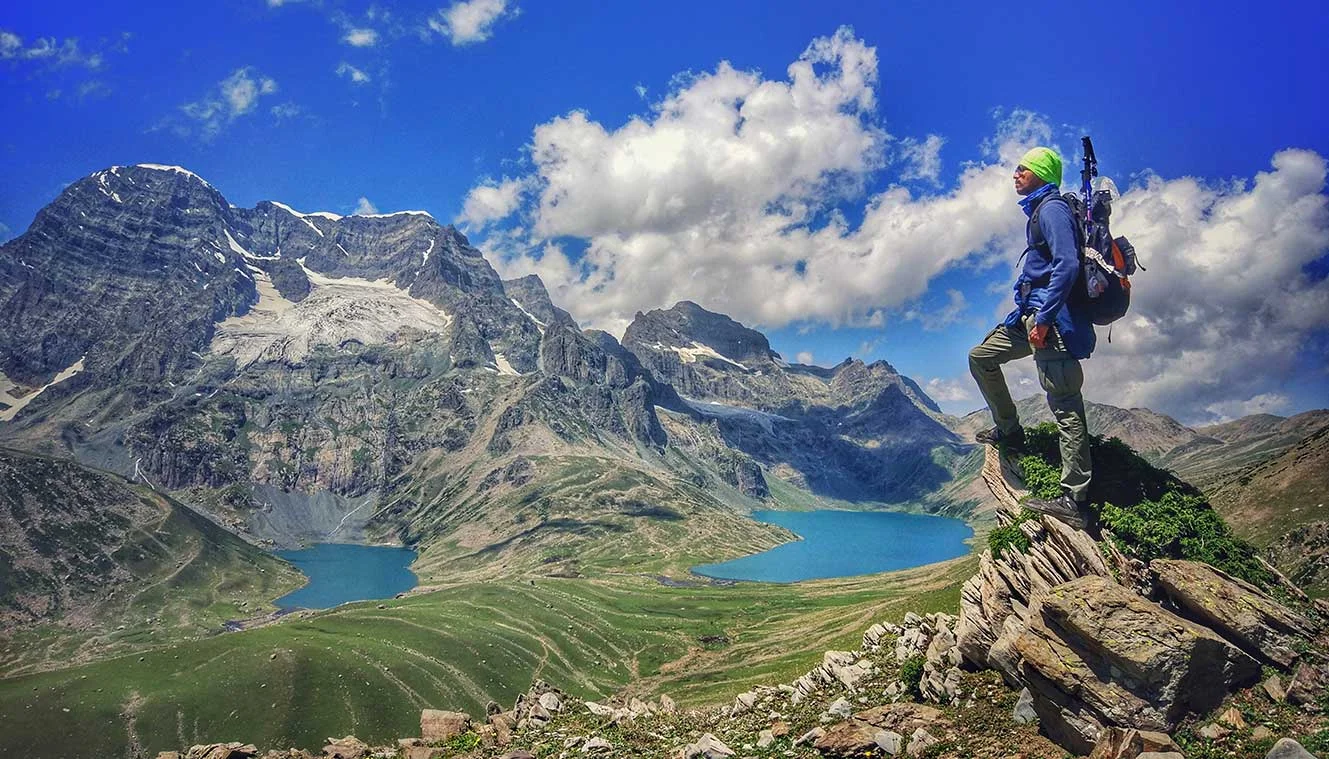
Gangabal To Naranag, Drive To Srinagar
- Altitude: 2,250 m/ 7,450 ft
- Distance: 15 km | Duration: 7 hrs approx.
- The trail is a descent till the last point of the trek - Naranang, so take care of your knees and ankles.
- The trail will pass through pine tree forests
- On advance booking, TTH can arrange transport to Srinagar at a charge
Gradual descent followed by steep descent (6 hrs, 11 km)
Although today is a complete downhill climb the steep descent is going to be hard on your knees so be prepared. From your Gangabal campsite, climb down through the ridge following the stream towards the tree covers. 30 minutes into the trek and the airtel network begins to catch network, you can inform your home that you have made it down safely! As the ridge ends, you arrive at a flat meadow. From here you can look back and see an impressive image of Harmukh Peak, standing tall and mighty.
An hour into the trek and you will begin to enter the treeline, which mostly consists of Pine trees and you will also begin to see signs of civilization as a log hut comes into view. For about 6 km you will keep making your way in and out of the forest not really losing much altitude. After two-thirds of the distance is covered, the trail begins to descend and it is a really steep descent. The trail here is muddy and well-trodden and through thick pine covers. The last 4 km of the trek is a huge drop where you lose an altitude of more than 3000 ft. You may even spot a lot of trekkers on your way down, they are trekking from Naranang to Gangabal. Naranang slowly comes into sight, a little bit more to go. The last part can be a test of your endurance as it is quite steep. A little further and stone-paved path comes along and in a few minutes, you enter the village of Naranang. From here, you will drive to Srinagar. Expect to reach Srinagar by 6:30 pm. From here on you can book your further travel ahead.
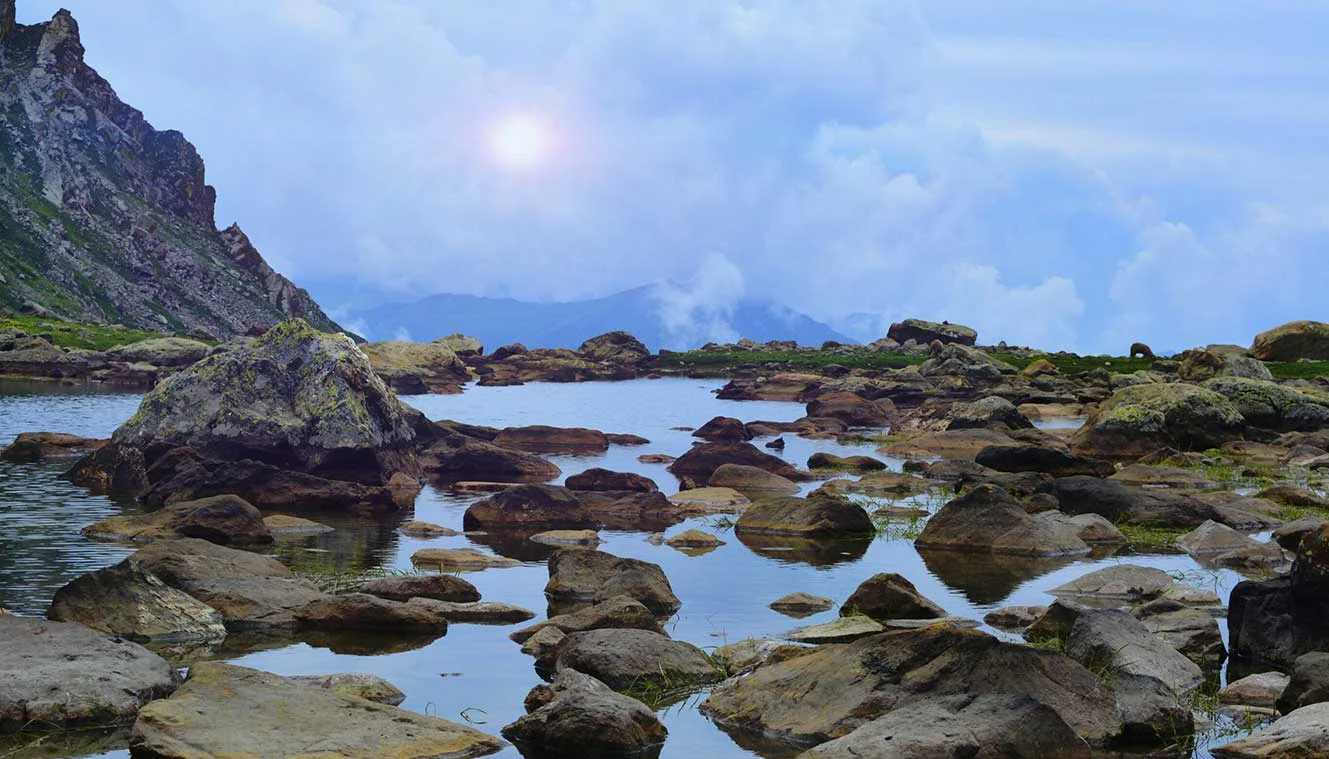
Day-1: Arrive At Sonamarg
- Altitude: 2,400 m/ 7,800 ft.
- 90 km drive from Srinagar, approx 3 hrs.
Day-2: Sonamarg To Nichinai Via Shekdur
- Altitude: 3,500 m/ 11,500 ft.
- 11 km trek, approx. 8 hrs.
- Altitude Gain: 1,100 m/ 3,700 ft.
Day-3: Nichinai To Vishansar Lake
- Altitude: 3,650 m/ 12,000 ft via 4,000 m/ 13,100 ft.
- Distance: 12 km | Duration: 7 hr.
Day-4: Acclimatization + Rest Day (Conditions Apply)
- You may visit Kishansar Lake, which is approximately 1 and half km from our camp site.
- If weather is not good we will use acclimatization day at Vishansar or else move towards our next camp site, rest day can be used at Gangbal camp site.
Day-5: Vishansar Lake To Gadsar Lake Via Gadsar Pass
- Altitude: 3,650 m/ 12,000 ft via 4,200 m/ 13,750 ft.
- 14 km trek, approx. 10 hrs.
Day-6: Gadsar To Satsar
- Altitude: 3,650 m/ 12000 ft.
- Distance: 9 km | Duration: 6 hrs.
Day-7: Satsar To Gangabal Twin Lakes Via Zaj Pass
- Altitude: 3,500 m/ 11,500 ft via 3,950 m/ 13,000 ft.
Day-8: Gangabal To Naranag, Drive To Srinagar
- Altitude: 2,250 m/ 7,450 ft.
* Please Note that prepaid sim cards do not work in Kashmir
Don’t forget your ID proof in original and 2 photocopies
On Day 8, you’ll reach Srinagar between 6:30 pm and 7:30 pm. You can book your travel any time after 8 pm
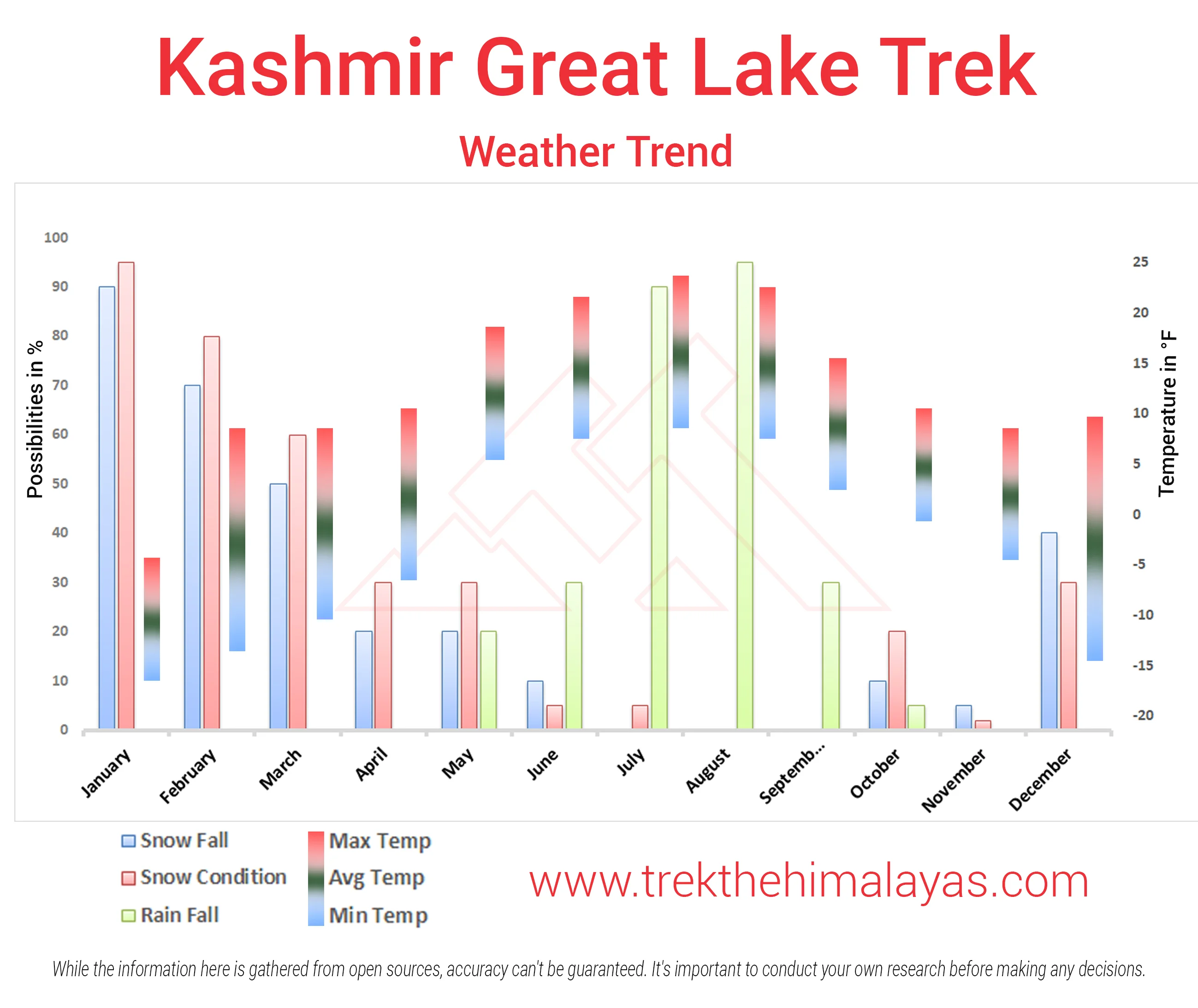
Medical & Disclaimer Form (Mandatory Documents) Click Here.
How To Reach
It is essential for everyone to arrive at Srinagar (11:00 am) Pick-up location: Tourist reception center, rajbagh, srinagar.
Once you have reached Srinagar, TTH will manage the rest of your travel arrangements, if you have opted for TTH's pick-up service, you can select this option during the booking process by adding it as an add-on.
Do reach Srinagar one day before your trek date for a safer side. Pick-up Place & Time : Tourist reception center, rajbagh, srinagar.and pick up time is between 12:00 noon to 12:30pm
Options to Reach Srinagar: 1. If you are planning to take a bus, you can reach the bus stand in Srinagar from any major city. It will take approx. 30 minutes to reach Tourist reception center, rajbagh from the bus stand (approx 8km). 2. If you are planning to fly to Srinagar which is well connected to all major airports in India, you can reach Tourist reception center, rajbagh in 15 to 20 minutes via taxi from the airport (approx 13 Km). 3. If you’re coming by train, there are two railway stations. - Jammu railway station is about 260 km away and takes around 8 hours by bus. - Udhampur is 200 km away and from there it is a 6 hours bus journey to Srinagar.
If you prefer to travel independently, you can either take a government bus or book a private cab. Your trek coordinator will provide guidance on how to arrange for the bus or cab booking.
Arrive in Srinagar by 6:00 pm.
The designated drop-off point is TOURIST RECEPTION CENTER, Rajbagh, Srinagar.
If you have to make any arrangements for further travel from Srinagar, do it the next day.
TTH offers comfortable transportation through Tempo Traveler, Bolero, or equivalent vehicles. If you wish to upgrade your mode of transportation, please contact your trek coordinator for further assistance.
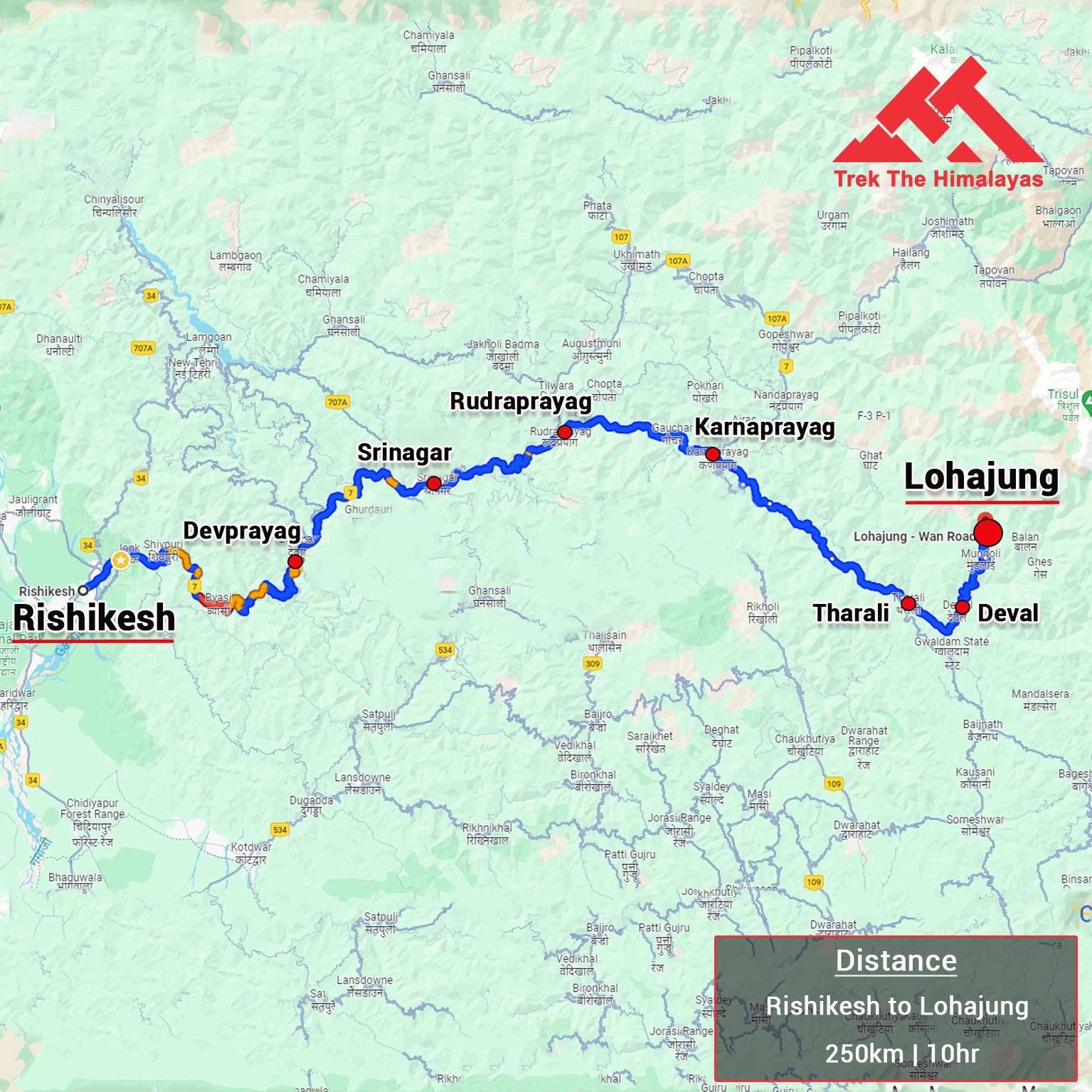
1. Insurance is Mandatory.
2. Accommodation (as per the itinerary):
- Camping while the trek (Twin sharing basis).
3. Meals (Veg + Egg):
- Meals while on trek (Veg & Egg).
4. Support:
- 1 Versatile base camp manager: handles communication and deploys extra manpower in emergencies.
- 1 Mountaineering & First aid qualified professional trek Leader.
- 1 Experienced high altitude chef.
- Local experienced guides (Number of guides depending on the group size).
- Enough support staff.
5. Trek equipment:
- Sleeping bag, Sleeping liners (if required), Mattress, Utensils.
- 3 men all season trekker tent (twin sharing), Kitchen & Dining tent, Toilet tent.
- Camping stool, Walkie talkie.
- Ropes, Helmet, Ice axe, Harness, Gaiters & Crampon (if required).
6. First aid:
- Medical kit, Stretcher, Oxygen cylinder, Blood pressure monitor, Oximeter, Stethoscope.
7. Transportation (as per the itinerary):
- Transport from Srinagar to Sonmarg and Narnag to Srinagar (Rs1,700).
8. Mules/porters to carry the central luggage.
9. Clock room facility available at the base camp for additional luggage.
10. All necessary permits and entry fees, Upto the amount charged for Indian.
11. Services from Sonamarg to Naranga.
1. Food during the transit.
2. Any kind of personal expenses.
3. Mule or porter to carry personal luggage.
4. Emergency evacuation, hospitalization charge or etc.
5. Anything not specifically mentioned under the head Inclusion.
Things can be provided on demand and availability (participant has to pay extra for these things).
1- Satellite phone/set phone - is a type of mobile phone that connects via radio links via satellites orbiting the Earth instead of terrestrial cell sites like cellphones. Therefore, they can operate in most geographic locations on the Earth's surface.
2- Gamow/PAC HAPO Bag (Portable Hyperbaric Bag) - is a unique, portable hyperbaric chamber for the treatment of acute mountain sickness (AMS), also known as altitude sickness.
3- AEDs (Automated External Defibrillators) - are portable life-saving devices designed to treat people experiencing sudden cardiac arrest, a medical condition in which the heart stops beating suddenly and unexpectedly.
Special Offer
Make a single payment and trek the number of times you want.
If you book a trek with Trek The Himalayas and cannot complete it, or if you've successfully completed the trek and wish to do it again, you can repeat it multiple times at no additional cost.
Terms and conditions
- This offer is non-transferable.
- This offer is valid for Trek The Himalayas limited fixed departures.
- This offer is valid for 5 years from the date of booking.
- This offer is not valid if the participant has received a cash refund or voucher at the time of cancellation.
- Participants don’t have to pay for the trek cost but have to pay for transportation and trek permit costs.
To reserve a spot for a trek or adventure program, you can either utilize our online booking form or call us at the provided number. For your confirmation, a deposit must be wired, including the initial payment.
Cancellation terms:
Cancellations prior to 25 days from the start of the Trip
Refund options
- 5% deduction of trek fee
- 100% cash voucher for any trip till one year
- Transfer your trek (any trek, any date) to your friend
Cancellation between 24 days and 15 days to the start of the Trip
- 30% deduction of trek fee
- 100% cash voucher for same trip till one year
- 85% cash voucher for any trip till one year
- Transfer your trek (same trek, any date) to your friend
Cancellation between 14 days and 10 days to the start of the Trip
- 50% deduction of trek fee
- 80% cash voucher for same trip till one year
- 70% cash voucher for any trip till one year
- Book the same trek, in the same season, with any other batch
Cancellation less than 9 days to the start of the trek
- No cash refund
- 20% cash voucher for the same trip till one year
- 10% cash voucher for any trip till one year
- Transfer your trek (same trek, same date) to your friend
Note- If a booking is made using a voucher or discount code, the policies related to vouchers and discounts cannot be modified.
In the unlikely event that TTH cancels a trek prior to the scheduled departure date:
While it is extremely rare for TTH to cancel a trek, we understand that unforeseen circumstances or natural disasters may occasionally require us to do so before the scheduled departure. These circumstances could include continuous rain or snow, thunderstorms, snowstorms, landslides, floods, earthquakes, or any other natural calamity that poses a risk to the safety of our trekkers. Additionally, unforeseeable events such as local riots, curfews, pandemics, lockdowns, government orders, or any similar situations that compromise the safety of the trekking experience may also necessitate a cancellation.
In the event of such a cancellation, TTH will provide you with a voucher equivalent to the amount you paid for the trek. This voucher can be redeemed for any of our treks within the next year, allowing you to still enjoy an adventure with us at a later date.
The issuance of a voucher is not applicable in situations where you are required to descend from the trek for any reason. The trek leader may make the decision to send you down from the trek due to factors such as insufficient fitness level, symptoms of Acute Mountain Sickness (AMS), high blood pressure, exceeding the designated turn-around-time, health concerns, or if you are found smoking, drinking, or violating the rules set for the trek. In such cases, the provision of a voucher does not apply.
In the rare event that TTH shifts a trek:
We would like to emphasize that weather conditions in high-altitude areas are highly unpredictable and can undergo sudden changes at any time, irrespective of the day. Additionally, circumstances beyond our control, such as natural disasters, political unrest, pandemics, and lockdowns, may impact the feasibility of conducting a trek. In cases where we are unable to proceed with an event due to such circumstances that are beyond our direct control, we will make every effort to provide you with an alternative trek that is safer and more suitable.
In such situations, we will issue a voucher to offset the cost difference between the originally scheduled trek and the alternative trek. This voucher can be redeemed at any time within one year from the date of issue. Please note that a refund fee or reimbursement of the cost difference is not applicable in these cases.
- Change of trek batch is dependent on the availability of seats in the batch
- In case of transferring a trek to a friend, he/she should satisfy all the mandatory requirements put forward by TTH
- TTH holds the right to change/cancel the policies, without prior notice
- Cash refund is applicable only in case of bookings made without using any promotional offer code or vouchers
Cash Voucher Terms:
- This is a non-transferable voucher
- The voucher cannot be merged with any other offer of Trek The Himalayas
- The voucher is valid for Trek booked directly with Trek The Himalayas in India
- To avail the voucher please use your register phone number or e-mail id
- All the other Terms of booking a trek with Trek The Himalayas are applicable to the voucher
- Trek The Himalayas holds rights to add/remove any of the Terms and Conditions without prior notice
Itineraries are based on information available at the time of planning and are subject to change. "Trek The Himalayas" reserves the right to change expedition dates, people or itineraries as conditions warrant. If a trip must be delayed or the itinerary changed due to bad weather, road conditions, transportation delays, government intervention, airline schedules, sickness, or other contingency for which TTH or its agents cannot make provision, the cost of delays and/or other changes are the responsibility of the participant. TTH reserves the right to decline, or accept, any individual as a trip member for any reason whatsoever.
Trek Essentials
PDF Of Trek Essential Download
Frequently Asked Questions(FAQ)
How to register/create an account with tth.
To register with TTH, visit our website - www.trekthehimalayas.com and create your account. To create your account you will need to use your email address and fill in all the details, set your unique password and your account is ready to use.
How to book a trek?
- To book a trek with TTH, you first need to register with us and create an account.
- Choose the trek that you want to do and click on available dates.
- You will land at the login page, fill in the required details.
- Add Participants, choose add-on services click on the Pay now button, choose your preferred payment method, and make the payment. TTH accepts multiple payment options, including credit/debit cards, net banking, and UPI.
- You will receive a confirmation email from TTH with all the necessary details about the trek, including the meeting point, transportation, accommodation, and other important instructions.
Made a payment but did not receive any confirmation.
please send an email to us at [email protected] or reach out to the numbers provided in the Help and Support section of your Trek Page. We will ensure that your issue is promptly resolved.
How to book off-load luggage and transportation?
To book services such as off-load luggage and transportation, you can find them listed as add-ons. These additional services can be booked at the time of your initial booking. If you miss booking add-ons during the initial reservation, you can log in anytime and easily book 4 days before the departure date add-ons through the platform.
If I have booked the wrong trek or date, how can I make changes?
In such a situation, please log in to your account and transfer your trek or date to the desired one within 12 hours or drop us an email at [email protected] 10 days before the departure date of the trek. After the initial 12-hour period, any changes will be processed according to the cancellation policy.
I am a beginner and confused which trek to book.
We recommend visiting our "Suggest Me a Trek" page. By filling out the form, our experts will contact you with the best possible trek options based on your preferences and experience level. Alternatively, you can reach out to us via email at [email protected] or give us a call using the numbers provided on our website for personalized assistance and recommendations.
How is family trek different from regular trek?
Family treks differ from regular treks by focusing on ease of difficulty, offering shorter durations for younger participants, Kid-friendly and easily digestible foods, child-friendly activities, maintaining a higher guide ratio for diverse age groups, and implementing additional safety measures for families.
Ideal treks for children.
Family Trek with Kids recommendation Only Dayara Bugyal and Chopta Chandrashila Trek.
Minimum age for children to trek with TTH.
Minimum age for TTH treks is typically 7 years, though this may vary depending on the specific trek.
Can we take children to high altitudes with their guardian?
Yes, you can take a kids to a high-altitude trek with a parent. Discuss with a trek expert before booking a trek.
Can we send kids without Parents/guardian?
Medical & Disclaimer Form (Mandatory Documents) Click here to download medical and disclaimer form
How to prepare a child for a high altitude trek?
Physical Fitness: Ensure your child is physically fit. Engage them in regular exercise, outdoor activities, and hikes to build stamina and endurance. Hydration: Emphasize the importance of staying hydrated at high altitudes. Encourage your child to drink water regularly, even if they don't feel thirsty. Proper Nutrition: Provide a well-balanced diet with sufficient carbohydrates for energy and foods rich in iron to prevent altitude sickness. Adequate Sleep: Ensure your child gets enough sleep in the days leading up to the trek. Quality rest is crucial for altitude adaptation. Educate on Altitude Sickness: Teach your child about the symptoms of altitude sickness, such as headache, nausea, and dizziness. Encourage them to communicate any discomfort immediately. Appropriate Clothing and Gear: Dress your child in layers to adjust to changing temperatures. Ensure they have appropriate trekking gear, including sturdy footwear. Positive Mindset: Foster a positive mindset. Encourage your child, and let them know it's okay to take breaks when needed. Medical Check-Up: Schedule a medical check-up before the trek to ensure your child is fit for high-altitude activities. Consult with a healthcare professional about any potential health concerns.
Kind of food will be served during the trek for children.
TTH takes special care to provide wholesome and nutritious food for children on treks. Here are some of the foods that are typically served for children: Breakfast: For breakfast, TTH serves a variety of options like porridge, cornflakes, bread, butter, jam, honey, boiled eggs, omelettes, and pancakes. Children can choose from these options to fuel themselves for the day's trek. Lunch: For lunch, TTH serves lunch which includes rotis, vegetables, rice, dal, and salad. The rotis are usually made fresh on the trek and are a good source of carbohydrates. The dal and vegetables provide protein and other essential nutrients. Snacks: TTH provides healthy snacks like fresh fruits, dry fruits, energy bars, cookies, and biscuits to keep the children energized throughout the day. Dinner: For dinner, TTH serves a hot and wholesome meal which includes soup, rice, dal, vegetables, and a non-vegetarian dish (if requested in advance). Children can also choose from a variety of desserts like custard, jelly, and fruit salad. Dietary requirements: If a child has any special dietary requirements, TTH can cater to those needs as well. For example, if a child is lactose intolerant or allergic to nuts, the kitchen staff can make arrangements to accommodate those requirements.
How to choose the right trek?
Choosing the right trek for a beginner can be a bit overwhelming as there are many factors to consider such as distance, elevation gain, terrain difficulty, weather, and time of year. Here are some tips that can help you choose the right trek for a beginner:
1. Determine fitness level: Assess the fitness level of the beginner to understand their physical capabilities. This will help you select a trek that is challenging but not too difficult.
2. Choose a well-traveled trail: A well-traveled trail will have more amenities such as signposts, water stations, and shelter. It is also safer as there will be other hikers on the trail.
3. Consider the length of the trek: For beginners, it is recommended to start with a shorter trek that can be completed in a day or two. This will help them get acclimatized to trekking and build their confidence.
4. Look for gradual elevation gain: Choose a trek with a gradual elevation gain rather than steep ascents. This will make the trek easier and more enjoyable.
5. Check the weather: Check the weather forecast before selecting a trek. Avoid treks during the monsoon season or winter when the trails can be slippery or dangerous.
6. Research the trail: Read about the trail to get an idea of the terrain, altitude, and difficulty level. This will help you select a trek that is suitable for the beginner.
7. Consult with an expert: If you are unsure about which trek to choose, consult our trek expert Mr. Nitin (+91 70600 59773) between 10 AM to 6 PM (Tuesday - Friday). Mr. Nitin will provide you valuable advice and guidance.
Overall, it is important to choose a trek that is enjoyable, challenging but not too difficult, and suitable for the beginner's fitness level and experience.
Can a beginner choose a tough trek?
It is not recommended for a beginner to choose a difficult Himalayan trek. Trekking in the Himalayas can be physically and mentally challenging, especially if you are not used to the high altitude, steep slopes, and rugged terrain. Choosing a difficult trek without the proper experience, fitness level, and preparation can be dangerous and put you at risk of altitude sickness, injury, and other hazards.
If you are a beginner, it is recommended to start with an easier trek and gradually build up your skills and experience. This will help you understand the challenges of trekking in the Himalayas, and also prepare you physically and mentally for a more difficult trek in the future. It is also important to choose a trek that matches your fitness level, experience, and interest.
What is the age limit for a beginner trekker?
There is no specific age limit for a beginner trekker. However, it is important to consider your physical fitness, health condition, and personal interests before embarking on a trek. Trekking in the Himalayas can be physically and mentally demanding, and requires a certain level of physical fitness and endurance.
If you have any pre-existing medical conditions or are above a certain age, it is recommended to consult with a doctor before embarking on a trek. It is also important to listen to your body and take breaks as needed during the trek to prevent exhaustion or injury.
If I am solo, can I join the trek in a group?
Yes, you can join the trek. We have fixed departure groups where you can simply book your trek and we will take care of curating a group.
How does my family get updated about my Trek?
Before you start the trek, it is recommended that you make all the necessary phone calls as during the trek you may or may not receive network coverage, once you come back to the Base Camp, you can reconnect with your family via phone once again. You can share your trek coordinator contact detail with your family members to get the latest updates about your trek batch.
What food can I expect?
At TTH, we provide wholesome and nutritious meals during the trek. The food is vegetarian and includes a variety of dishes such as rice, dal, vegetables, chapati, paratha, pasta, noodles, and soup. We also offer snacks such as biscuits, and salty, and dry fruits during the trek. Special dietary requirements such as vegan, gluten-free, or Jain food can also be arranged if informed in advance.
I am allergic to some foods.
If you are allergic to some foods, you need to let us know in advance so that we can make arrangements accordingly.
How safe is trekking with TTH?
TTH is a trekking company that prioritizes the safety of all its participants, including women trekkers. They have a comprehensive safety system in place, which includes a dedicated team of experienced and trained trek leaders and support staff who are equipped to handle emergency situations and provide first aid.
TTH also takes specific measures to ensure the safety and comfort of women trekkers. They have a separate tent accommodation for women trekkers, female trek leaders, and support staff. They also provide separate toilet facilities for women and encourage a safe and respectful environment for all trekkers.
Moreover, TTH has a strict policy against any kind of harassment and has a zero-tolerance policy towards such incidents. They have a designated Internal Complaints Committee (ICC) to investigate and address any complaints related to harassment or misconduct. Overall, TTH has a good reputation for safety and responsible trekking practices, and women can feel comfortable and safe while trekking with them.
How TTH will manage if I am the only woman in the group?
In case you are the only women in the group, we provide a single sleeping arrangement. Also, during the trek, the trek leader will always remain by your side to provide optimum safety and reassurance.
How can I know that other women are in the batch?
You can reach out to the trek coordinator to inquire about the number of female trekkers and their respective states who have booked the trek. Please note that the trek coordinator cannot disclose personal details of any trekker. Once you've confirmed your booking, a WhatsApp Group will be created for all the trekkers in your batch. This allows you to connect with fellow trekkers before the trek begins.
Can I know in advance, which trek is led by a women Trek Leader?
While many of our treks are led by female trek leaders, however, it is not possible to know which trek leader is assigned to which group. But nonetheless, whether the trek leader is male or female you can be completely assured of your safety and security with us.
Can I trek with periods? If yes, then where can I dispose of the sanitary pad?
Yes, it is possible to trek with periods. However, it is important to take some extra precautions and preparations to ensure a comfortable and safe trekking experience.
Here are some tips that can help you trek during your period:
1. Use menstrual hygiene products that you are comfortable with, such as tampons, pads, or menstrual cups. It is recommended to carry enough supplies for the entire duration of the trek.
2. Pack wet wipes, hand sanitizer, and plastic bags to dispose of used hygiene products.
3. Wear comfortable and breathable clothing that allows for easy movement and reduces friction. Avoid wearing tight or restrictive clothing that can cause discomfort.
4. Carry pain relief medication, such as ibuprofen or acetaminophen, in case of menstrual cramps.
5. Stay hydrated and maintain a balanced diet to support your energy levels and overall health.
6. Take breaks as needed and listen to your body. If you feel uncomfortable or experience any unusual symptoms, seek medical attention immediately.
It is also recommended to consult with a doctor before going on a trek during your period, especially if you have a pre-existing medical condition or are taking medication. By taking necessary precautions and being prepared, you can have a safe and comfortable trekking experience even during your period.
We provide proper disposal facilities for sanitary pad disposal during the trek.
How will the accommodation be during the trek?
We offer three person tents with twin-sharing for optimum comfort. A woman trekker will share a tent with another woman trekker and if you are the only woman in the group, you will be given a single accommodation for your comfort and privacy.
Are trek poles, Jackets and other equipment available for rent from Trek The Himalayas?
Yes, we do provide gears on rent. You can book it using you TTH account directly.
Who will be with us on the trek from Trek The Himalayas?
Mountaineering qualified Experienced and first aid certified Trek Leader, First Aid Certify local guide, Cook, helpers and supporting staff.
Who can not join the trek?
People suffering from Bronchitis, Asthma, High blood pressure, Epilepsy (got faints), TB , Heart problem or on higher BMI side are strictly not allowed to go on any Himalayan trek. Apart from this if you had any medical history, please let us know.
When it gets really cold can I consume alcohol?
No. Alcohol and smocking isn’t allowed while on trek. It is totally misconception that it will keep you warm. Your body need to acclimatize properly and for that eat properly and drink enough water; these things will keep you warm.
What type of toilet facility is TTH providing at the trek?
Toilet tents provide a convenient solution for answering nature's call in the great outdoors. Dry toilets, in particular, offer a highly sanitary approach. By digging a pit and utilizing mud and a shovel, you can easily cover up your waste. This method ensures cleanliness and hygiene while camping or exploring in the forest.
Remember to pack essential toiletries to complete your outdoor bathroom kit and maintain proper personal hygiene during your adventures. With these practices in place, you can enjoy nature while also respecting it.
How do I manage the negative temperatures on the trek at higher camps? Do I need special jackets?
Layer Up From Head To Toe Eat Full Meals, never sleep empty stomach You can keep warmee (if you’re more susceptible to cold). Use sleeping bag in right way and don’t leave free space in sleeping bag.
For upper body – Thermal layer – T-shirt (full-sleeves) – Fleece T-shirt (for extreme colds) – Fleece layer – Thick Jacket/Down Jacket – Waterproof or Windproof layer (outermost layer, when it is snowing or raining) - For Lower Body – Thermal layer – Hiking pants (normal) or Winter hiking pants
Based on how warm you feel you can skip any of the above layers. Your outer later should be windproof since it is windy at high altitude. The idea behind layering is that the more insulation you have the less cold you feel, and instead of wearing a very thick jacket if you wear multiple layers, your body will be better insulated against the cold.
Do you provide crampon/micro spikes and gaiters?
Yes, we provide micro spikes and gaiters, if required.
What documents need to carry on trek?
Mandatory documents: 2 xerox of ID having address (addhar card/driving license), 2 Passport size photographs, hard copy Medical form signed & sealed by doctor, disclaimer form sign by trekker and high altitude insurance.
If we come prior the trek date, Do you provide accommodation?
No. We don’t but we can suggest you good hotel/Stay nearby pick up location.
Do we get enough water for drinking?
Yes, trekker must carry 2 water bottles 1 litre each so they can refill it at campsite for drinking and keep themselves hydrate.
What kind of shoes we should buy for the trek?
You should buy shoes which has these three features –Good grip, Ankle Support and additional water resistant layers. Generally, we advise Quechua Trek 100, MH 500 and MH 100.
How do we get back after the trek?
Your return transport is also included in trek fee if you're opting for service Dehradun to Dehradun ; we use Tempo Traveller/ Tata Sumo/Max/Boloero kind of vehicle.
What happens if some members of the team need to turn back before the summit?
No one is forced to go on. There is always enough staff to split the party according to need and regroup later at the camp. Most people have no trouble reaching the highest campsite. If some members decide not to climb the final distance they can wait for the climbers to come back down the same way or take a lateral path to the descent route.
What kind of help is available in case of emergency?
We always have a first aid kit close at hand. Serious injuries are rare. Porters will assist injured climbers to the base of the mountain and onward to a clinic or hospital. Kilimanjaro International Airport is very near Marangu Gate if evacuation to the US or Europe is advisable.
What kind of accommodation we’ll get in KGL trek?
We do camping throughout the trek. We provide twin sharing tent all season tent .
What will the temperatures be like during KGL trek?
During trekking day time is always pleasant as temperature stay between 15C-22C throughout the season. At night time, temperature varies between 8 C to 0 C. Our morning, evening and nights are quite cold so you need to be prepared by wearing layers around camp. In early July, high chances of getting snow at Nichnai Pass and Gadsar pass and around. From July mid to August, almost snow melts by July end. And then around August end to September mid expected night temperature around 4 C to 0 C and one can expect snowfall around 2nd week of September. Do expect light shower around evening time.
How do we reach Srinagar?
Pick-up location is TRC: Nishad Garden in Srinagar at 12:00 Noon, TTH will take care of your further travel arrangements. Options to Reach Srinagar: We advise you to reach Srinagar one day before trek date and by flight only. Better to avoid road route. If you are planning to take a bus, you can reach ISBT in Srinagar from any major city. It will take 1 hour to reach Nishad garden from ISBT. If you are planning to fly to Srinagar which is well connected to all major airports in India, you can reach TRC within 20 to 25 minutes via taxi. If you’re coming by train, there are two railway stations.
Where and what time do we have to reach in Srinagar?
Reporting point is Nishad Garden in Srinagar and Reporting time is 12:00 noon on trek date.
Whom should I call once I reach in Srinagar?
We always share driver and vehicle number 1 days prior the trek date, so you can call him on your arrival if you’re having problem with finding vehicle.
How do we reach to basecamp and get back after the trek?
You can take out transport service; do contact your trek coordinator to book transport service. We use Sumo/Bolero/Max/Tavera or equivalent (shared by 6/7 people). We arrange vehicle depending on availability and final batch size.
What is the best time to do Kashmir Great Lakes?
Best time to do Kashmir Great Lakes Trek is July, August and September 2nd week. One can see lush green meadows, alpine lakes and beautiful colourful flowers. To enjoy it’s beauty, it is advisable to plan this trek July and August month. In September time one can see green meadows turning brown and flowers also changes its colour, but still this change in scenery is pleasing to watch.
Is KGL a good trek for a first timer?
Yes, we recommend KGL trek to first timer as well as experienced one. Make sure that you should have good fitness. People suffering from Bronchitis, Asthma, High blood pressure, Epilepsy (got faints), TB , Heart problem or on higher BMI side are strictly not allowed to go on any Himalayan trek. Apart from this if you had any medical history, please let us know.
Is there mobile network on KGL trek?
No network while trekking. Idea, Airtel and BSNL networks available in Sonamarg and after that you will not get any network during the trek. Only post-paid connection works in Kashmir.
Are there any electricity charging points on KGL trek?
There isn’t any charging point on KGL trek. And you need to rely on your power bank or batteries.
Is Trekking pole necessary?
Yes, it is necessary. It is additional support which helps you reduce tiredness and give you strength and balance.
- Date and Price
Rent A Gear
Trek Articles
Quick Links
Trekking & Hiking
Mountaineering
Multi Sports
Himalayan Pilgrimage
Website Privacy
Terms & Condition
Contact Info
Get in touch with us. E-mail us Monday-Saturday (10 AM to 6 PM)
Address: Trek The Himalayas, Kaintura Plaza, Badrinath Road Tapovan, Rishikesh - 249201 Uttarakhand
Phone: 8191004846
Email: [email protected]
2010 Trek The Himalayas. All rights reserved
Kashmir Great Lakes Trek
Available batches, august 2024, september 2024.
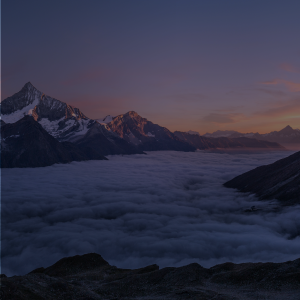
Brief description
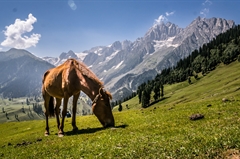
Brief Itinerary
Detailed itinerary.
Arrival at Sonamarg (2, 730 M)
Distance: 81 kms (Srinagar to Sonamarg)
Duration: 3 hours
Sonamarg, which translates to Meadow of Gold, is the starting point of the KGL trek. If you have opted for transport with Bikat Adventures, please ensure you board the vehicle from Dal Gate No. 1 in Srinagar latest by 12 PM. If you are traveling on your own, try to reach Sonamarg by 3-4 PM.
Although you have to report at the base camp only by 3 P.M, we recommend you come here early to explore the region. Home to some renowned peaks and glaciers of the Kashmir National Park, one can spot the Sirbal Peak, Kolahoi Peak, Amarnath Peak and Machoi Peak alongside the Machoi Glacier from here.
The drive from Srinagar to Sonamarg, although short, is a pleasant one to undertake. Once you are out of the city, there is barely any traffic and charming countryside vistas replace the cityscapes. About 30 kilometres into the drive, snow-capped mountains take over the horizon and sprawling, grassy meadows cover the lands on either side of the road as far as the eyes can see. The views enroute to Sonamarg are well worth a day trip from Srinagar!
The stay will be arranged in camps for the day. We will have a Team introduction after evening tea followed by an early dinner.
Sonamarg (2, 730 M) to Nichnai (3, 500 M) (Click to View GPS data)
Distance: 10 kms
Duration: 6 hours
We begin our trek at 9 am today from Shitkadi. The trail is a fair mix of ascent and descent. The gradient is moderate and plenty of water sources will be available for refilling water bottles along the way.
We begin by following a vehicle track that heads out of the main road of Sonamarg. This track descends all the way down to the Sind River from where the trail head for the Kashmir Great Lakes Trek begins.
The trekking trail from the trail head quickly ascends up. About ten minutes into the trek, the trail unanticipatedly enters a patch of rolling, green meadows overlooking the town of Sonamarg. This marks the end of civilization as we know it and the beginning of the beauty that is the Kashmir Great Lakes Trek!
Take a couple of moments to soak in the view here. The waters of the Sindh river glistening in the early morning sunlight as she makes her way through this tiny town hugged snugly on either side by gorgeous mountains is a sight to behold.
This view only gets fuller and more resplendent as you ascend further up the trail. It takes 30 minutes to the reach the top of the meadow. Maple, pine and silver birch trees dot the landscape here. From here onwards, it is an undulating climb across vibrant meadows marked by clear brooks and streams all the way up to Nichnai, your campsite for the day!
Nichnai (3,505 M) to Vishansar Lake (3,658 M) via Nichnai Pass (4,150 M) (Click to View GPS data)
Distance: 11 kms
We will be breaking camp early for the day and starting at 8 a.m. While the gradient is moderate, be prepared for long hours of walking. The scenery shifts winningly through the day ranging from a leisurely walk through expansive meadows, ambling along the banks of a river to a moderate ascent up the Nichnai pass followed by a sharp descent from the top of the pass.
We begin by walking along the river running through the Nichnai Campsite. On the way, look for feasible spots where you can cross the river. The Nichnai Pass is located at a distance on the other side of the river.
Once you reach the other side, continue walking along the river bank in the direction of the Pass (which can be spotted from the campsite itself). The trail ascends steadily for the next hour all the way to the top of the ridgeline that was visible from the meadow below. This ridgeline is not the Pass however. The actual pass begins after a couple of bends along the ridge.
The Nichnai Pass is a striking passageway set at 4, 150 M with snow clad mountains lining its left. There are no peaks on its right but the land rises there as well giving it the illusion of walking through a tunnel.
Once you reach the top of the Pass, it is a rapid and steep descent on rocky terrain to the meadows below. You will notice that colourful little flowers dot the grass here. A new river now flows from the Pass into this region. Multiple, narrow trails run into the horizon as far as the eyes can see.
Take one of these trails and continue walking ahead. Snow-clad mountains rise against the skyline on your left while your right hand side contains stretches of barren and rugged mountain faces. The sharp contrast in scenery only exaggerated further by the dewiness of the grass and flowers at your feet makes this one of loveliest meadow walk experiences on the Kashmir Great Lakes Trek.
Our campsite for the day is located two hours away beyond yet another river crossing and not far from an alpine lake with startlingly blue waters that is bound to have you hooked right from the moment you lay eyes on it. This is the all famous Vishansar Lake with its twin, Kishansar Lake, not far behind.
Buffer Day (Subjected to Weather Condition)
If the weather condition is bad, then we will use the buffer day which can be used to explore the lakes & acclimatize. The decision to use the buffer will solely be taken by the trek leader.
Vishansar Lake (3, 658 M) to Gadsar Lake (3, 810 M) via Gadsar Pass (4, 206 M) (Click to View GPS data)
Duration: 6 hours
Today’s trek is a steep two hour ascent followed by a steep two hour descent and then a gentle walk through the meadows. There will be ample water sources along the way to refill your water bottles.
Our trail begins with climbing a pencil thin ridge running along the mountain side near Kishansar lake. It takes about an hour and a half to reach the top of this ridge. About midway through your ascent, the mountains unfurl an arresting view of the Kishansar and Vishansar lakes together!
This view lasts until you reach the top of the ridge. What follows is an hour of steep descent after which the trail opens up into a bright valley with mountain ranges guarding it on either side.
The meadows of this valley are by far one of the most colorful you will be encountering on the trek, thanks to the bright red, yellow, purple and blue flowers popping out of the green grass. It makes you want to flop down and sneak in a nap after the steep climb up the pass. The Gadsar Lake lies beyond this meadow.
With piercing blue waters, the Gadsar lake is the most pristine of the seven alpine lakes primarily because it is the least visited. Quite a few make weekend trips from Sonamarg to Vishansar and Kishansar, more so make the trip on the other side of the trail; from Naranag to Gangabal. Gadsar, however remains untouched because of its location at the highest point of the trek which makes its accessibility tough.
Our campsite is one and a half hours away from the Gadsar lake, close to an Indian Army camp where all of our original ID cards will be collected, checked and recorded.
Gadsar Lake (3, 810 M) to Satsar Lake (3, 658 M) (Click to View GPS data)
Distance: 12 kms
The gradient for the day is mostly moderate barring the first one and half hours of steep ascent. Post that, it is a level walk all the way up to the next campsite.
The landscape on today’s trail stands in sharp contrast to the river valleys we have been trekking through till now. The terrain is rugged, desolate and captivating in its isolation. Meadows are scant and are marked by scattered patches of white flowers. Boulders and rocky terrain dominate the landscape with an occasional brook cutting through them.
We will be crossing an army camp today as well where our original ID cards will be collected, checked and recorded before letting us cross. Rolling grasslands once again take over the terrain beyond the army camp. Ten minutes away lay the first of the Satsar Lakes. Satsar is actually a group of seven inter-connected lakes situated in a narrow alpine valley stretching north to south. The lakes drain out into the Wangath Nallah which is a tributary of the Sindh.
Big and picturesque in its greenery and backdrop of the mountains, we will be setting up camp here for the day.
Satsar Lake (3, 658 M) to Gangabal Lake (3, 505 M) (Click to View GPS data)
Distance: 13 kms
Duration: 7 hours
We begin by taking the trail heading out of the Satsar Campsite. This section of the trail is exciting primarily because it is dominated by boulders. Most trekkers, we have noticed, are comfortable getting down on all fours when hopping from one boulder to the next. As fun as it may seem, do watch out for loose rocks that can make you lose your balance.
Beyond these boulders lie the largest and the last of the Satsar Lakes. After this, the trail descends for a good half an hour until we are confronted by ridge lines running across the mountains. It is time to gain altitude again. Be prepared for a steep ascent for the next three and a half hours. The terrain, you will notice, turns distinctly rocky and barren the farther we climb from the base.
Perhaps, it is to make up for the starkness of the landscape that KGL treats you with one of the most theatrical views of the trek right on top of this ridge- a vertigo inducing scene of the Gangabal and Nandakol lakes nestled snugly in the valley. Mist and fog playfully flit in and out of the scene hiding and revealing the twin lakes impelling you to take a break to watch the spectacle unfolding in front of you.
We will be setting up camp on the banks of the Gangabal lake. As is evident from the Pass, it is a very long descent from the top of the ridge to the campsite.
Unlike the other campsites, you will notice more trekkers and tents here. Gangabal and Nandakol are famous for trout fishing in the region. The Nandakol lake is bewitching in its setting. A jagged glacier clinging to slopes of the Harmukh Peak feeds the lake at its base. The play of light and clouds on the glacier are fascinating to watch!
Once you set up camp at Nandakol, take some time out to explore the Gangabal lake.
It is a short walk and a river crossing away from the campsite. The Gangabal lake, you will notice, is far less crowded than Nandakol and more tranquil in its setting. The water is clear near the banks revealing colourful pebbles on the waterbed. A mountain sits right on top of it. Remnants of a glacier clinging to its base feed this lake. It is a long and pleasant walk along its banks.
Once you are done exploring, ensure you return to your campsites before it gets dark.
Gangabal Lake (3, 505 M) to Naranag (2, 271 M) (Click to View GPS data)
Watch your toes and knees on the trail today because, as you have guessed it, we will be descending to the Naranag road head which is where our trek comes to an end. The distance is long and the trail gets steep at the end.
From the Gangabal campsite walk along the ridgeline that runs downstream towards the trees. It takes about an hour to reach the treeline. Continue walking along its fringe. For the first 7 kms or so, you don’t really lose altitude. There are gentle ascents followed by flat walks on lush grassy meadows.
You also begin to notice the beginning of civilization on the way. A hut or two dot the landscape and makes you wonder what it would be like to live there. Once you cross the 7km mark, the trail begins descending sharply. The track is mostly muddy and runs under a cover of pine trees. One or two kilometres into the descent, Naranag appears in sight but it is still a long way to go.
Expect to reach Naranag by afternoon. Our vehicles to Srinagar will be waiting there. We should be in Srinagar by half past 6 in the evening. If you are planning to travel out of Srinagar the same day, ensure you book your transport that leaves the city post 9 to account for any delays on the way.
What's Included
- Veg/ Egg Meals during the trek - Starting evening snacks on Day 1 till Lunch on Day 8
- Forest Permits/Camping Charges/Permits, Trek Permit Fee/IMF Permission (Upto the amount charged for Indian nationals)
- Camping tents (Twin sharing), Temp rated sleeping bags, mattress
- Safety Equipment includes static rescue rope, seat harness, carabiners, pulleys
- Mountaineering course certified Trek Leader with First Aid certification & customized rescue course from NIM
- Experienced Local guide, cook, helpers
- Porters or mules for carrying common luggage
- Exhaustive First Aid kit including portable oxygen cylinder
What's Not Included
- Meals during road journeys
- Any kind of Insurance
- Any expense of personal nature
- Any expense not specified in the inclusion list
- Portage of personal backpack
- Transportation to and from Srinagar
Are you Eligible for this Adventure?
Max Altitude

BRS Level Required
Kashmir Great Lakes Trek is a level 5 adventure on the Bikat Rating Scale.
This makes it mandatory for you to have high-altitude experience of preferably multiple treks marked at level 5 on the BRS. The altitude, the terrain and the nature of the climb demand a certain level of skill and a need for you to be aware of how your body reacts to the various features of high altitude environment.
If you do not know what level of BRS trek would suit you best, worry not! Fill out this Form:

we will send you a progression chart to help you comfortably get out of your comfort zone in order to level up and ultimately reach your highest potential in the big, bad world of outdoor adventure.
Climbing up to an altitude of 4,206 M, the trail switches between ascents and descents on most days making it relatively easy to navigate. The only challenge lies in building endurance needed to tackle the long distances (10 kms or more) one needs to cover each day. The trek is 69 kms long and is an excellent choice for beginners looking to step up their trekking game in the Himalayas. We recommend this trail for experienced trekkers as well, not for the challenges but for the sheer beauty and extravagance it houses.
Prequisite Skills
The trek demands a few mountain skills:

fitness benchmark
If you can do the following, physically you are ready to take on this trek:

Packing List
This is a list of essential items for individuals doing the trek with Bikat Adventures. This list contains only those items which the participants are required to bring with them. The list excludes those items which are provided by Bikat Adventures on the trek. We have divided the items into five categories. All the items in the list are essential except for those marked as optional.
Trekking Gear
- Ruck sack bag with rain cover. Qty -1
- Day Pack Bag - Recommended for treks with summit day
- Head Torch with spare Batteries. Qty -1
- U V protection sunglasses. Qty -1 Here is how you can choose the best sunglasses for trekking.
- Water Bottles: 2 bottles of 1 liter each
- Non-skid, deep treaded, high-ankle trekking shoes Qty -1
- Pair of light weight Slipper/Sandals Qty -1
- Quick Dry Warm lower or Track Pants. Qty - 2
- Full sleeves T-shirts/ Sweatshirts. 1 for every 2 days of trekking
- Pair of thick woolen socks. 1 pair for every two days of trekking
- Thermal Body warmer Upper & Lower. Qty-1
- Undergarments. Qty - 1 for every day of trekking
- Warm jacket closed at wrist & neck .Qty-1
- Full sleeves sweater. Qty -1
- Rain wear ( Jacket & Pants ) . Qty-1
- Pair of waterproof, warm gloves. Qty-1
- Woolen cap. Qty-1
- Sun shielding Hat. Qty -1
- Personal toiletries kit (Small Towel, Toilet paper, paper soap, Bar soap, toothbrush, toothpaste, cold cream, etc.)
- Sun screen lotion small pack. Qty -1 Here is your Sun Protection 101 to stay safe in the bright sunny outdoors.
- Lip Balm small pack. Qty-1
- Small size, Light weight & Leak proof lunch box. Qty-1
- Plate. Qty- 1
- Spoon.Qty-1
- Tea/Coffee (plastic) Mug.Qty-1
Miscellaneous
- Camera (Optional)
- Carry your medicines in plenty in case you have any specific ailment. Consult your doctor before joining the trek.
- Dry fruits, Nuts, Chocolate bars (Optional)
Frequently Asked Questions
Eligibility, is this adventure good for me, what’s a good fitness benchmark for this adventure, what skills do i need to complete this adventure, what is the minimum and maximum age limit, about the activity, where is it located, what are some of its highlights, what are some of its challenges, what is the best season for this, what is the accommodation type, what is the temperature like here, is it technically challenging, connectivity, how do i reach the starting point, is there cellular network available throughout, where is the nearest atm, if i choose to travel to the base with you, what is the pick-up point, what time is the drop-off on the last day, what are the nearby attractions that i can explore, equipment & gear, what equipment is provided to us, what can i rent from you, where will i receive the rented items, where do i have to return the rented items, what gear do i need to bring, are there local shops to rent/buy equipment, facilities & additional services, can i offload my bag, can i leave any extra luggage i carry at the base of this adventure, what are the meals like, what are the washroom/ toilet facilities like, what should i do if i get my period on this adventure, what are the medical facilities available to me on this adventure, are there any electricity charging points on this adventure, mandatory documents, what documents do i need to carry, do i need insurance for this, do i need a permit for this, certification, do you provide a certificate of completion, when and how will i get the certificate of completion, international travel, will i need a visa, when should i apply for the visa, what kinds of insurance do i need to travel here, what is the specialty of this when compared to other mountain ranges, till which month can i make a booking for this, what is the qualification of the outdoor leader provided to us, how do you choose your outdoor leaders, is it safe for women, what is the ratio of outdoor leader to participants, what do you do in case of an emergency, what are the rescue options on this adventure, how do you choose your equipment, can i attempt this adventure if i have a specific medical condition, sustainability, what kind of camping do you practice on your outdoor adventures, why are you against fixed camping in the outdoors, how do you manage overcrowding on certain trails, what are some things to remember when using a dry toilet, why should i avoid wet wipes in the outdoors, where should i dispose of my sanitary waste if i am on my period, why should i carry my own utensils on an outdoor adventure, booking process, what happens after i make the payment, do you create a whatsapp group of participants before the start date of the activity, do i need to submit a medical certificate, do i need to submit an undertaking form.
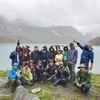
Small Group Size
Our batch sizes are capped at 15 for smaller treks with the trek leader and trekker ratio of 1:8. This ratio, in our years of experience, has proven to deliver the best trekking experience for individuals as well as groups. Capping the size of the group ensures individual attention to each trekker so that no signs of distress or need during the trek go unnoticed. It also helps to form a more cohesive cohort with better group energy which helps define the rhythm and pace of days on the trek. As you go higher up on the BRS scale, since the stakes are higher, expeditions have an even smaller group size with the ratio of expedition leader to climber set at 1:2.
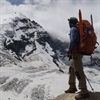
Qualified Trek Leaders
We follow a rigorous regime of hiring and training our experts in the field. Each trek leader is a certified mountaineer with years of experience in the field. In addition to their qualification, they also go through practical and situational training to tackle any and all kinds of sudden conditions that may present themselves on the ground. Being unpredictable is the core nature of the mountains but being ready for any circumstance as best as possible is a controllable asset that we try to nurture. Our field experts are also trained in basic medicine and first-aid response. Watch: Forerunners - The Making of A Trek Leader At Bikat Adventures
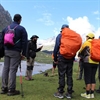
Guided Progression
Since Bikat Adventures is a learning-based organization, we help you climb up the ladder of difficulty within the sphere of outdoor adventure systematically. Our on-ground training modules are designed to handhold you through the upskilling process so that you are ready to take on bigger challenges.
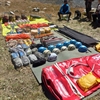
Equipment Quality and Check
All the gear used on our treks and expeditions is tried and tested, maintained for good quality, and is overall top-notch in quality and condition. We are continually looking to obtain the best of everything there is in the market so as to ensure optimum safety.
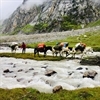
Support Systems
Along with the staff you see on-ground, we have a team of superheroes working in the background to give you the best experience possible. Our background team also comprises local staff from each area who know the region best. Having local support helps with studying the area, pre-planning, execution, and in receiving timely support in case of emergencies in these remote locations.
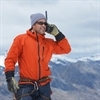
Communication
Our on-field staff is in constant contact with our teams based in primary locations so as to eliminate any avoidable delay in reaching additional help and support when required. We try to use the best tools for communication available, including satellite phones, in regions where they are not restricted.
What our customers Say

Cancellation Policy
Cash refund
Cancellations up to 30 days prior to departure date
5% deduction
Cancellations between 30 days to 15 days prior to departure date
50% deduction
Cancellations within 15 days prior to departure date
Voucher refund
Cancellations up to 5 days prior to departure date
No Deduction
Cancellations within 5 days prior to departure date
- Cash refund is applicable only in case of bookings made without using any promotional offer code or vouchers
- This is only a brief of cancellation terms. For finer details please refer Detailed Cancellation Policy.
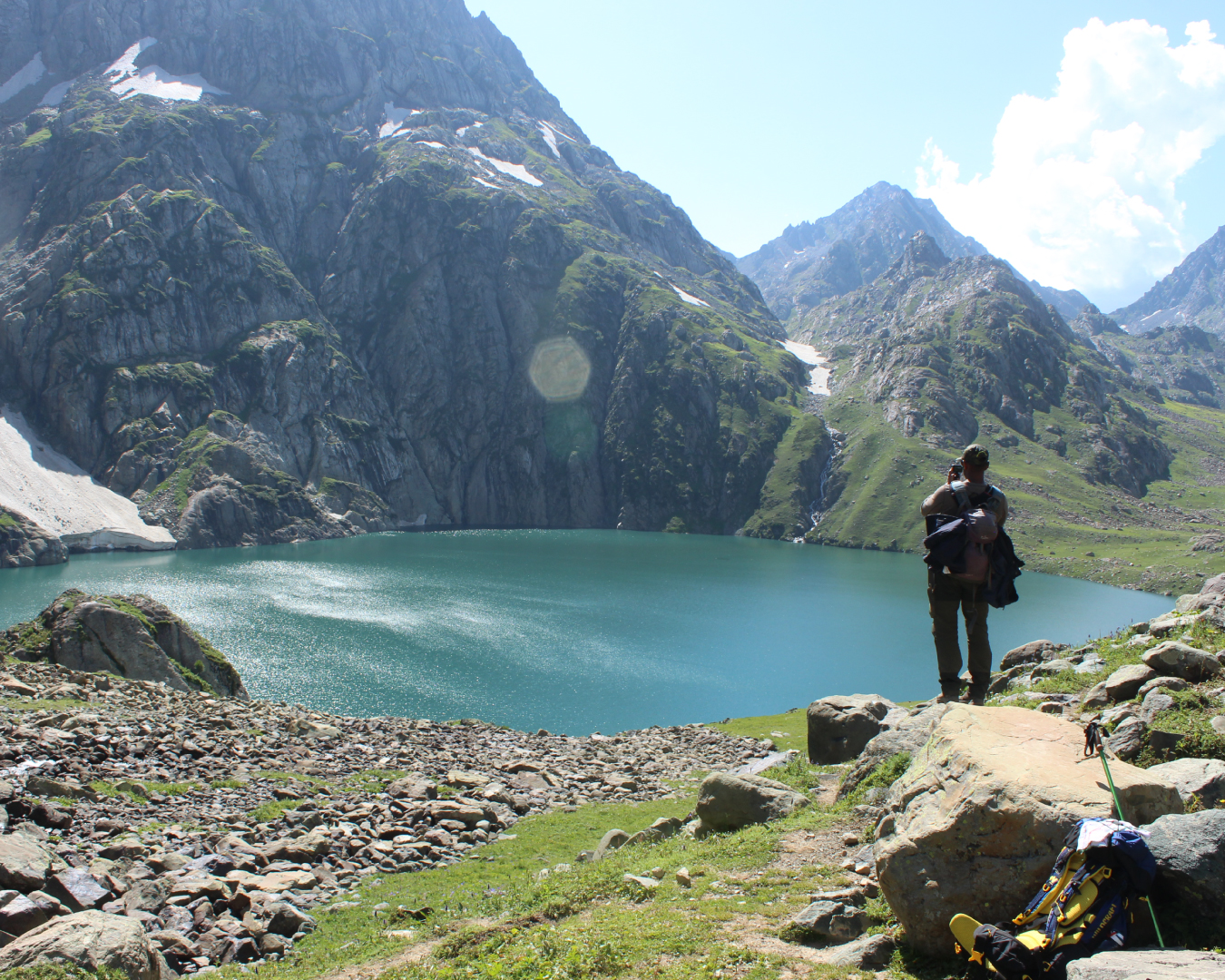
Subscribe for latest updates & offers
Similar adventures.
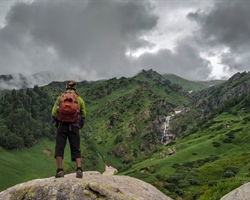
Kalihani Pass Trek
A challenging and off-beat gem of himachal.
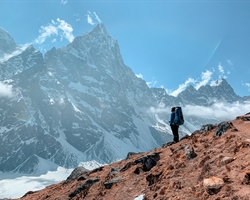
Everest Base Camp Trek
Walk where the legends walked..
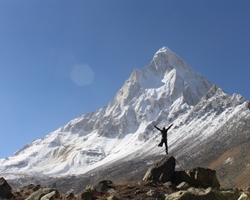
Vasuki Tal Trek
The closest one can get to mt shivling on a trek.
Uttarakhand
Enter your Email
Events by categories.

Mountaineering

Scuba Diving
Events by months.
- January July
- February August
- March September
- April October
- May November
- June December
Events By Nights
- 5 & More Night
- Environmental Policy
- Privacy Policy
- Term & Conditions
- Work With Us
- Address: 303, 3rd Floor, Tower B4, Spaze Itech Park, Sector 49. Gurgaon
- Pre Sale - 8448680062 , Post Sale - 8588878499, 9667639126
Bikat Adventures
- Cancellation & Refunds
- Content Sharing
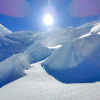
© 2024 Bikat Adventures - All Rights Reserved
Powered by: novel knett software solutions, submit enquiry.
NatureDiary » Blog » Travel Guides » Tourist Attractions
Kashmir Great Lakes (KGL) Trek – Complete Guide
When you think of Kashmir, your eyes visualize a canvas of endless meadows and alpine lakes with cobalt-blue waters nested amidst high-altitude mountains. Rightfully, Kashmir cherishes the title, ‘Paradise on Earth’. Well, it’s really a paradise with manicured carpets handcrafted by the Creator. Trekking to the Kashmir Great Lakes (KGL) is an adrenaline-rushing activity for all adventure lovers.
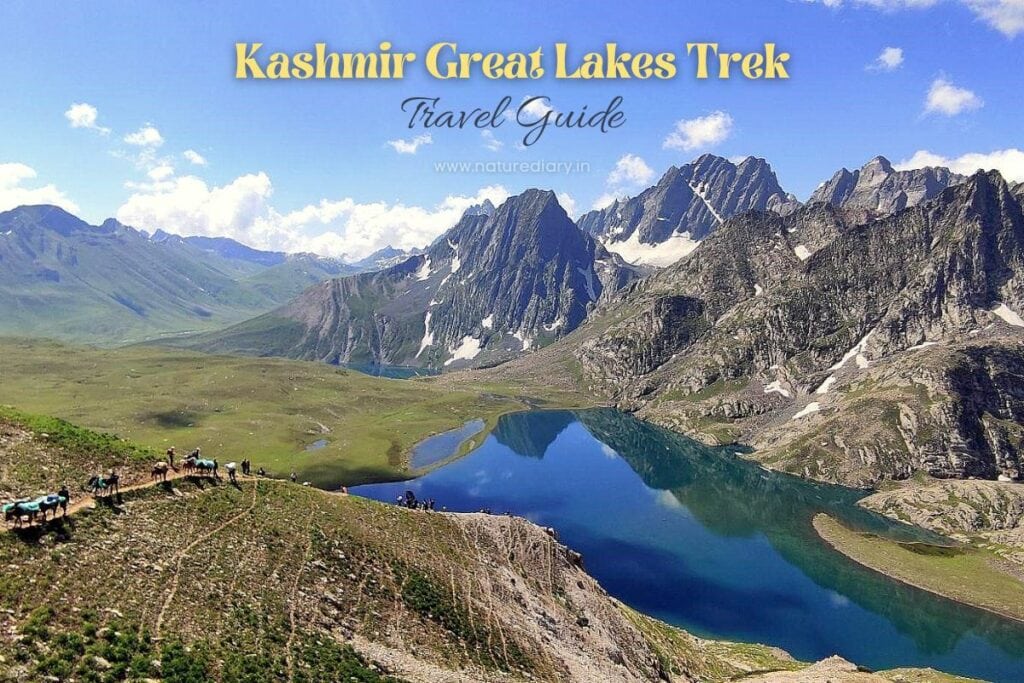
Kashmir Great Lakes Trek Overview
About kgl trek.
Kashmir Great Lakes is one of India’s most picturesque treks that remains open from July to September. The sprawling meadows and jagged mountains remain inaccessible for the rest of the year due to harsh weather conditions and snow. Located to the northeast of Srinagar, it lies 75 Km away from the capital.
What makes the KGL trek special is its versatility with landscapes. The 7-day trek covers more than 75 Km distance and takes you through rolling meadows, tricky boulder zones, steep climbs, and descents. The lakes are named after Gods, and the blissful trek route through the paradise on earth rightfully justifies its stature.
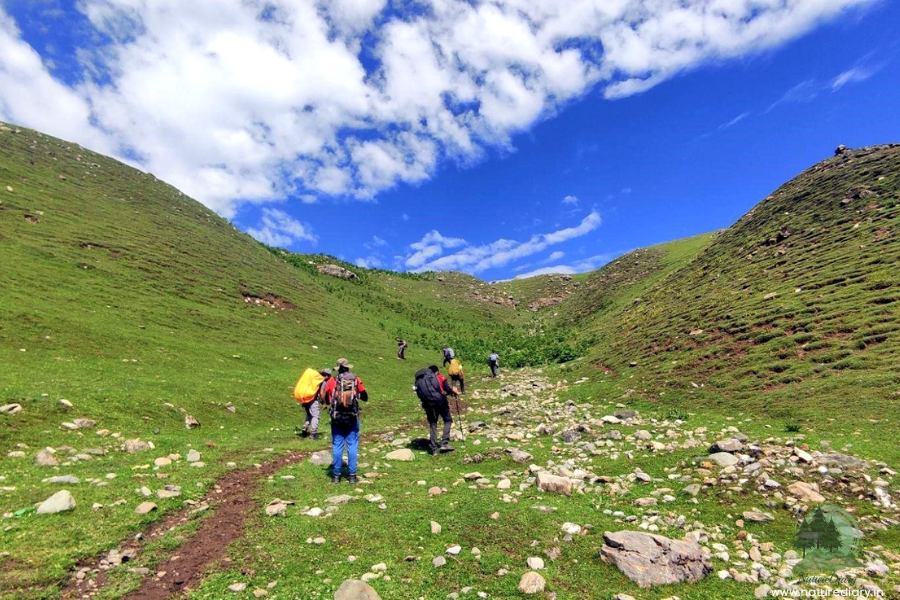
Kashmir Great Lakes brings you a very different terrain each day. You have five different valleys and at least six lakes to explore. Starting from Sonmarg and finishing at Naranag, the high-altitude trek (the highest point at Gadsar Pass: 13,800 feet) is not for beginners. The trek route is moderate to tough, but the key challenges remain the long routes and sun-breathing fire overhead. While temperatures range between 7 to 19 degrees C in July, the extremely steep climbs can take a toll if you aren’t prepared.
Scattered throughout the trek route, you would find snow patches feeding the picturesque glacial lakes. They sometimes slide along the mountains into the blue-green waters. Icebergs, meadows, and unpredictable boulder zones make the KGL trek truly diverse.
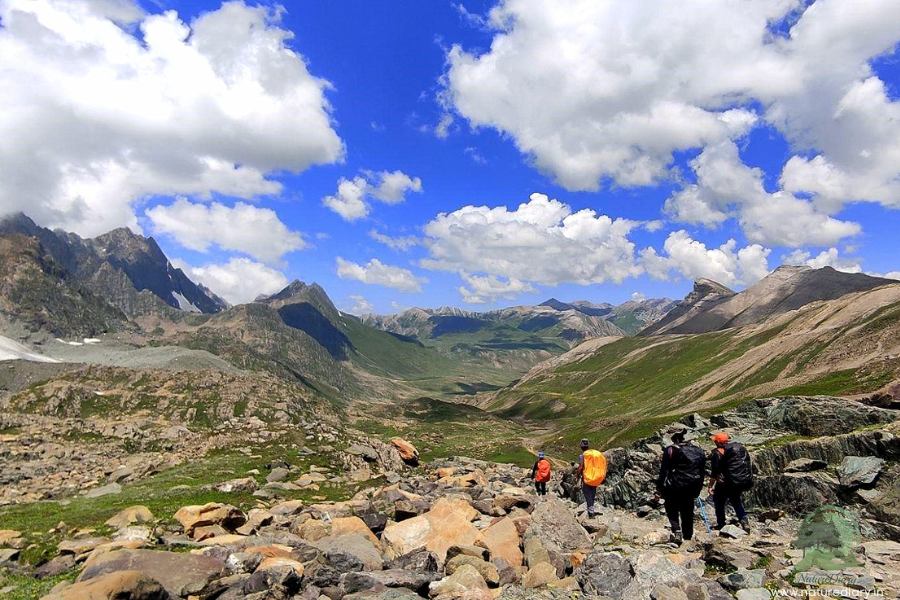
Well, you might live the wallpaper lifestyle for seven days, but I bet you cannot let go of the charismatic sensation when you are back. And then, you have the adrenaline rush when you cross the three high-altitude passes: Nichnai Pass, Gadsar Pass, and Zaj Pass. So, if you are yet to conquer this trek, it’s time to start planning!
The Mythology of Kashmir Great Lakes
Most of the lakes you would trek in the Kashmir Valley are named after Hindu Gods. Besides, on the 6th day of the KGL trek, you would descend to Gangabal Campsite. In the backdrop amidst the mountains, you can spot Mount Harmukh, which means ‘The Face of God’.
As per local mythology, Lord Shiva resides on the top of this mountain. Although the mountain has a height of 16,000 feet, Mount Harmukh has remained unconquered to date. It’s believed that the ruggedness of the terrain and challenges due to extreme climatic conditions prevent mountaineers from scaling the peak.
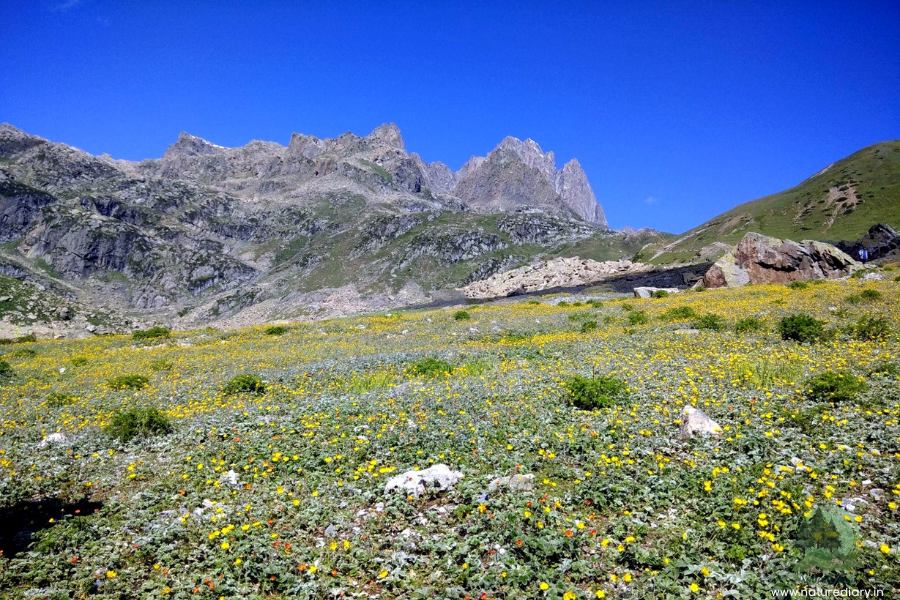
Once, an ascetic continued to resist the harsh conditions and tried to climb the mountains. His efforts continued for 12 years but failed to get to the top. Ultimately, he disappeared after attaining nirvana. However, people can climb this mountain up to 14,000 feet every year. A pilgrimage takes place where local villagers climb up to this height to offer their prayers to Lord Shiva.
It was in 1856 that the first expedition to Mount Harmukh took place under Thomas Montgomerie as a part of the Great Trigonometric Survey. Interestingly, the expeditors ended up discovering K2, the second-highest peak in the world after mount Everest, during this expedition!
Highlights of Kashmir Great Lakes Trek
- Altitude: 13,800 feet (Highest Point)
- Trekking Difficulty: Moderate to challenging
- Starting Point: Sonmarg
- End Point: Naranag
- Distance Covered by Trekking: 75-80 Km
- Duration Of Trek: 7 days
- Temperature: 7°C to 20°C during the day and 2°C to -4°C at night (July–September)
- Rainfall: Moderate chances during the period
- Best Time To Visit: The trek remains open only for 3 months (July–September)
- Nearest ATM: Srinagar
- Nearest Airport: Srinagar
- Nearest Railway Station: Jammu Tawi
- Mobile Network: Only postpaid sims work in J&K. No network is available throughout the trek once you cross Sonmarg.
- Cost of Trek: ₹12000 to ₹15000 per head (Including accommodation costs, food, and charge for the guide).
KGL Trek Elevation Map
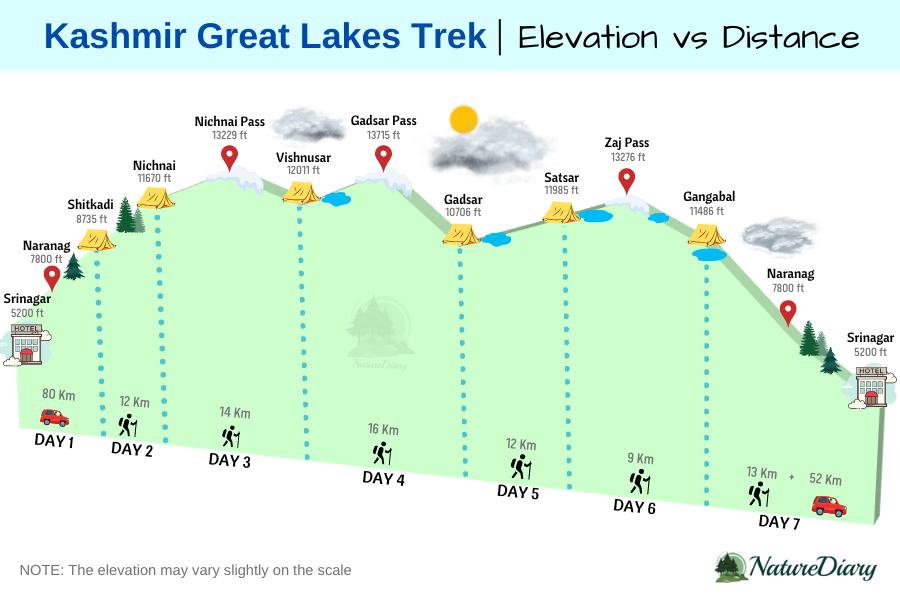
How to Reach Kashmir Great Lakes from Srinagar?
It would be wise to fly directly from your respective city to Srinagar for trekking to the Kashmir Great Lakes. Travelling via rail to Jammu can delay your plans as the highway connecting Jammu and Srinagar (300 Km) experiences frequent landslides during the monsoon months.
So, you can schedule a flight to reach Srinagar in the morning. Therefore, you can start your journey towards Sonmarg on the same day without staying at Srinagar overnight. However, you need to consider a buffer day during the trek to make room for uncertainties like incessant rainfall.
Also, trekkers might need to rest for a day in the middle, considering that the difficulty level is moderate to high. Therefore, you must book your return flight from Srinagar on the 9th day. Under ordinary conditions, it would be wise not to use the buffer day unless necessary.
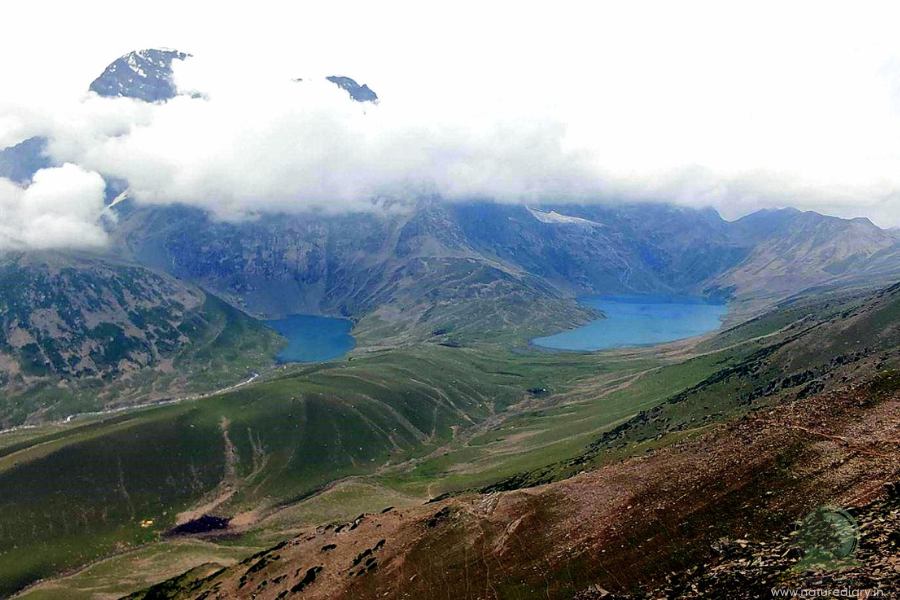
Kashmir Great Lakes Trek Routes
There is only one Trek route when you explore Kashmir Great Lakes. Most importantly, once you set your path, there’s no easy exit point. The most common route is to drive from Srinagar to Sonmarg and reach Shitkari, where you can pitch your camps on the first day. However, some trekkers drive from Srinagar to Naranag and then to Sonmarg before starting to take on the trails. After crossing the lakes and valleys for seven days, the trek ends at Naranag.
Kashmir Great Lakes Trek Itinerary
Day 1 (drive from srinagar to sonmarg and reach shitkari campsite).
- Distance: 80 Km
- Drive time: 2.5-3 hours
- Altitude: 7800 ft.
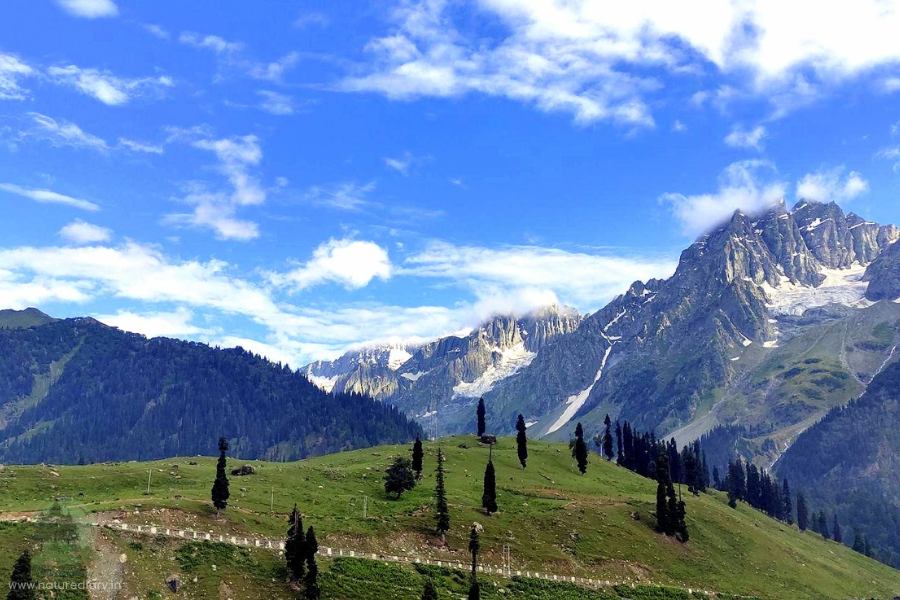
Sonmarg camping is one of the best camping places in India for its picturesque view, weather and facilities. While the actual trek to KGL starts from the Shitkari campsite at Sonmarg, there’s no need to walk on the first day. You need to drive from Srinagar to the campsite, the last fringes of civilization, where cars can access the road. The mighty Sindh river traverses sonorously through the valley just beside the picturesque camp.
Starting your journey at noon, you can reach the campsite by 3 pm. It would be wise to use the rest of the day to familiarize yourself with the trails and trek conditions. In Kashmir Valley, the sun sets around 8 pm. So, the days are pretty long, which provides plenty of time for trekkers to prepare their dinner and get their tents ready.
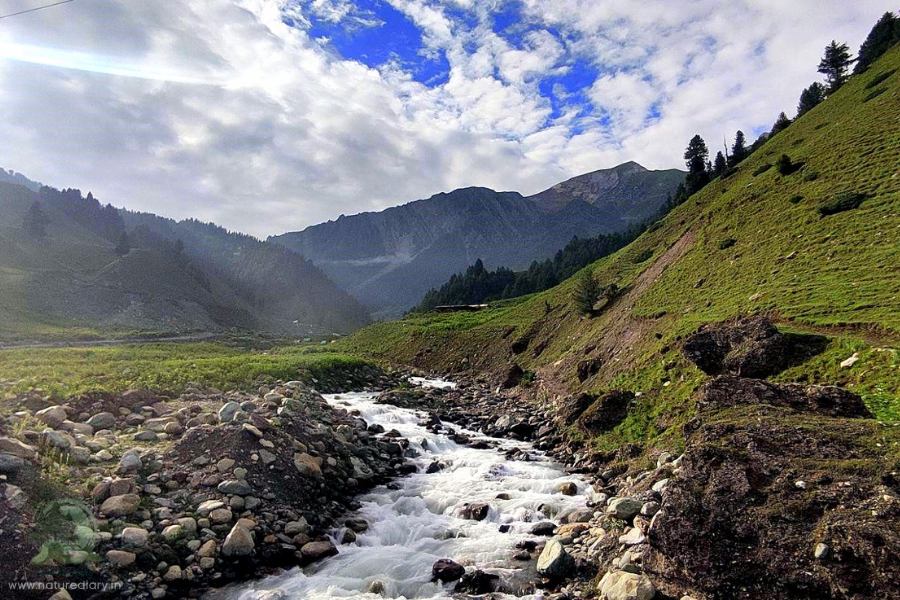
Day 2 (Trek from Shitkari Campsite to Nichnai)
- Distance: 12 Km
- Trek time: 7 hours
- Altitude gain: 7800 ft. to 11607 ft.
Leaving behind the Sindh river and the jeep track close to the campsite at Shitkari, a mud track elevates high into the mountains. This is the trail you need to take that would lead to the second day’s destination Nichnai. You would be gaining altitude quickly for the first three hours. While there’s a sharp descent along this trail for the next hour, you would enjoy a pleasant ascend to Nichnai for the last couple of hours.
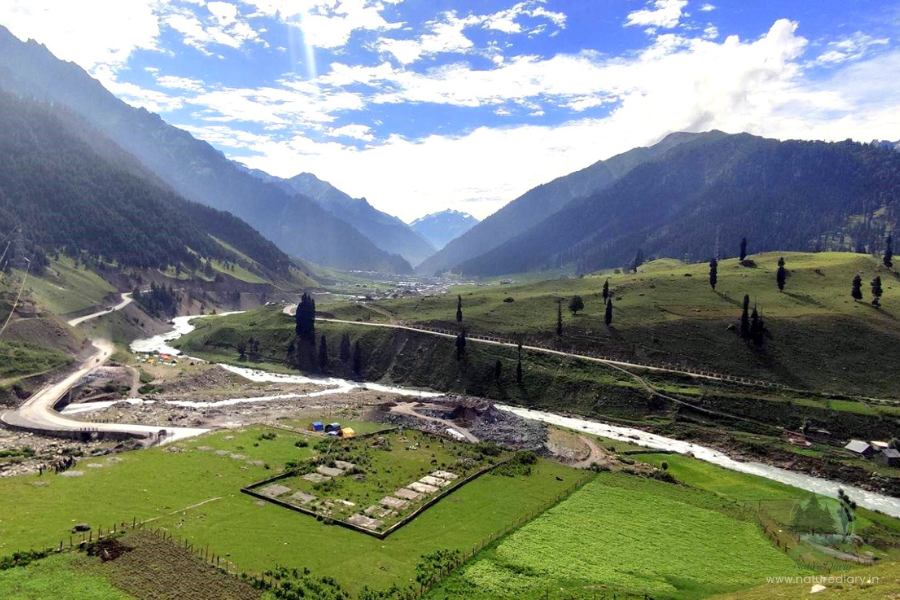
After trekking for 15 minutes of starting at 8:30 in the morning, you would find a left turn, giving way to a serene green meadow. Below, you can spot the first campsite overlooking Sonmarg town.
Then you have to trek for 1-2 Km and you would come across a flat ground where the Indian Army would check your credentials and collect photocopies of your ID card. These formalities during the Kashmir Great Lakes trek might take around half an hour, depending on the size of your team.
Next, you would find the Pine and Maple forests sprouting along the green carpet. While you cherish the rolling meadows at your feet, the splendid canopy of the Maples would define the typical beauty of Kashmir. This forest ends at the top of the ridge, and you will get a view of the narrow river snaking through the valley.
It’s time for descent after a hectic climb! Looking back, you can catch one last glance at the picturesque Sonmarg valley with all its greenery. On the front, the meadow shows the way down, along with pines and the rugged river valley.
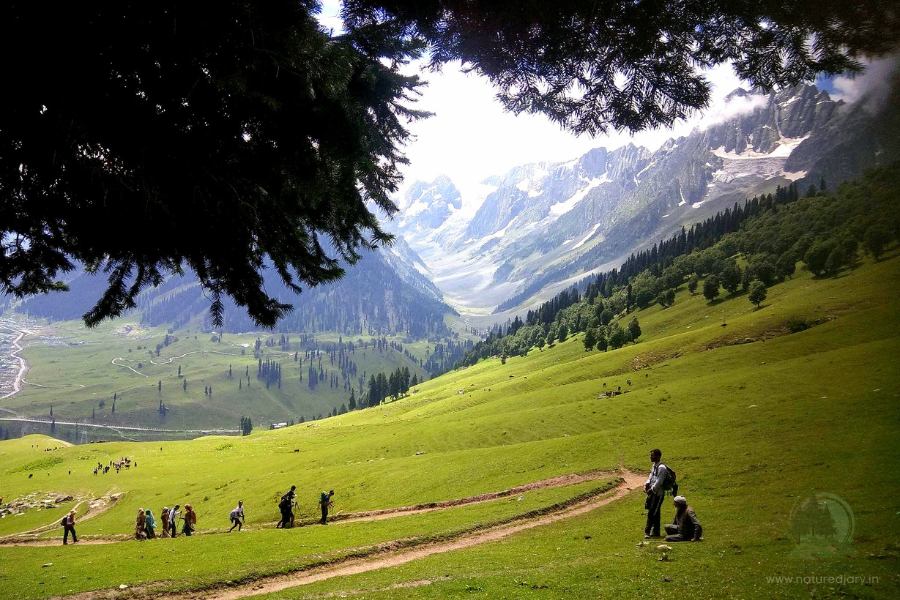
Marching amidst Silver Birches and scattered huts of the shepherds, the middle trail through the forest would lead your way down. Along the way, you can spot thick foliage with the sun rays peeking through the leaves. Trekking along the river valley boulders would test your skills; trails would frequently show up later in the trek.
The view around the river valley would be quite different from what you had witnessed so long amidst the meadows. The snow-capped peaks stand as ever-alert sentinels, with the mountains blocking the access to the green valley you just crossed. With mules showing up frequently along the path, your progress along the river valley would be a sloth.
After an hour or so, the rocky floor embraces a green meadow, gradually widening between a couple of ranges. Well, that’s Nichnai Campsite, the destination to pitch the tent on the second day of the KGL trek!
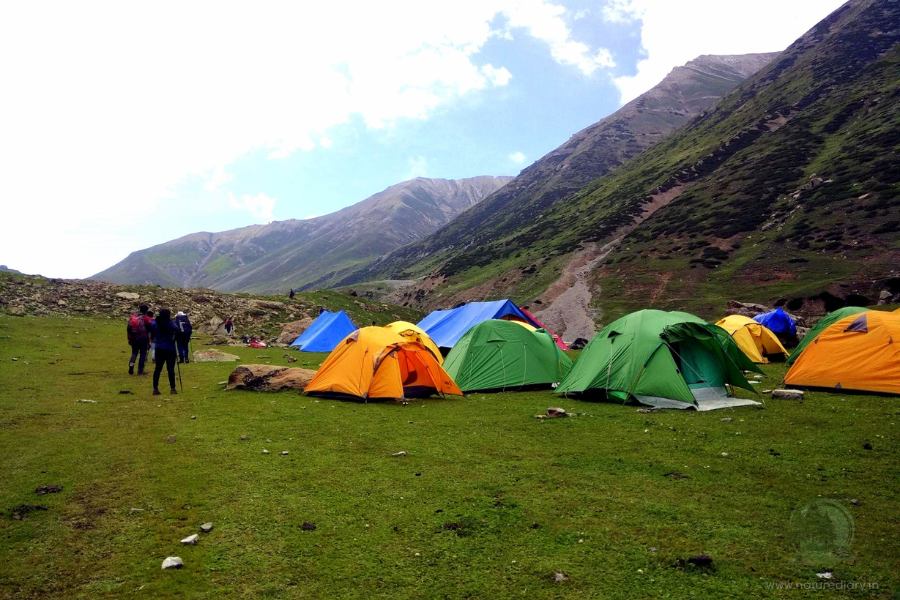
Day 3 (Trek from Nichnai Campsite to Vishnusar)
- Distance: 13.5-14 Km
- Altitude gain: 11,607 ft. to 12011 ft. (Highest Point: 13229 ft.)
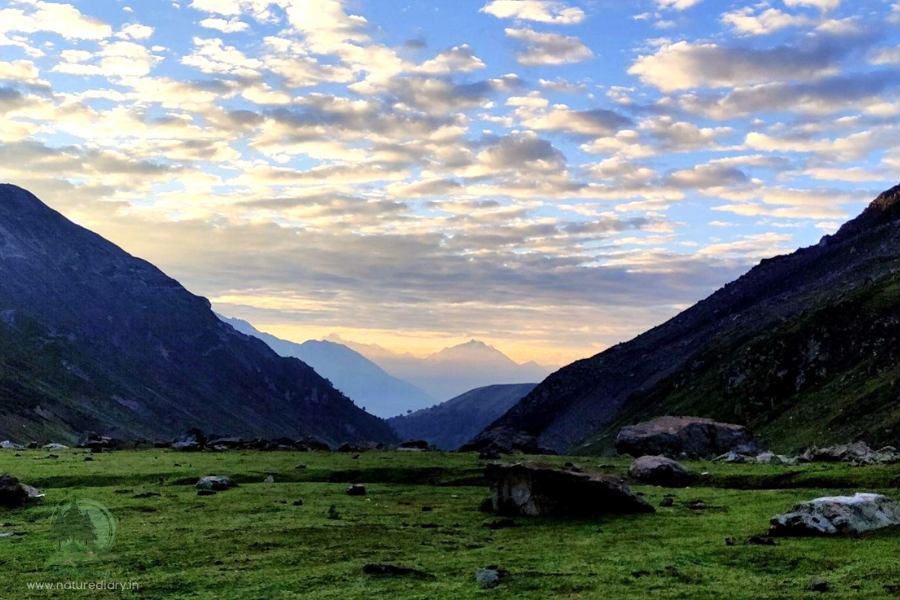
On the third day of the trek, you would see the first lake of the KGL trek. This is one of the most happening days, with various landscapes to pamper your views. You must leave the campsite at Nichnai early, around 8 in the morning. Today, you need to cross Nichnai Pass, the first high-altitude pass of the trek at 13,229 ft. With the heavenly beauty of the meadows nestled amidst rugged mountains, undulating plains stretching for miles, and gradual descent into the valley, the day’s going to create memories!
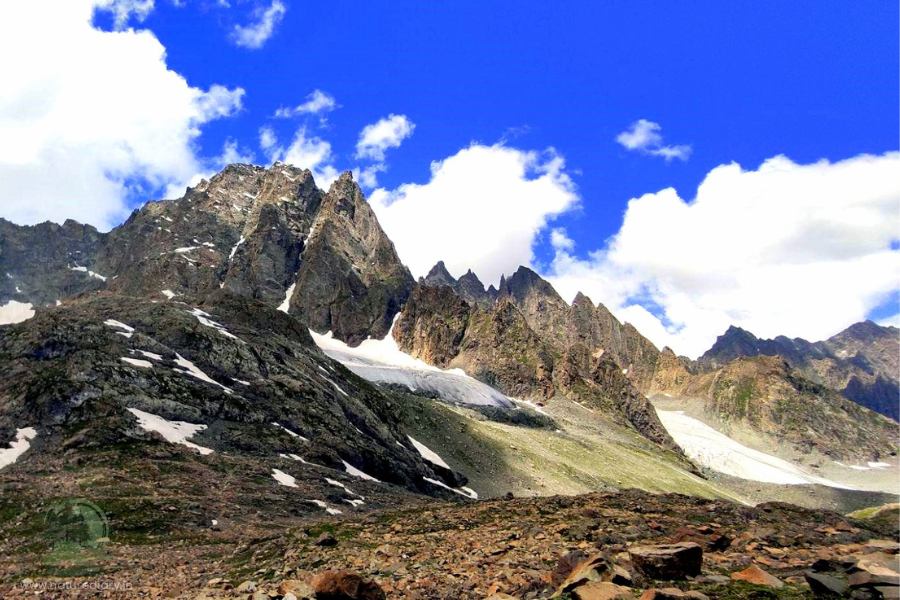
You need to be tactical while navigating through molten ice packs and boulders for the first one and a half hours. Next, the steep climb to the Nichnai pass would give you a tough time. This pass would be visible from the campsite, just adjacent to the snow-clad peaks. Starting with the right bank of the river, trekkers need to cross it and shift to the left bank after an hour. For the next hour, keep to this bank as you ascend the path.
After you cross the pass, you will see the landscape changing. The typical wallpapers on your PC would come alive on the smooth grass. Dotted with yellow wildflowers, the undulating trail of the Kashmir Great Lakes trek would keep your spirits high as you descend.
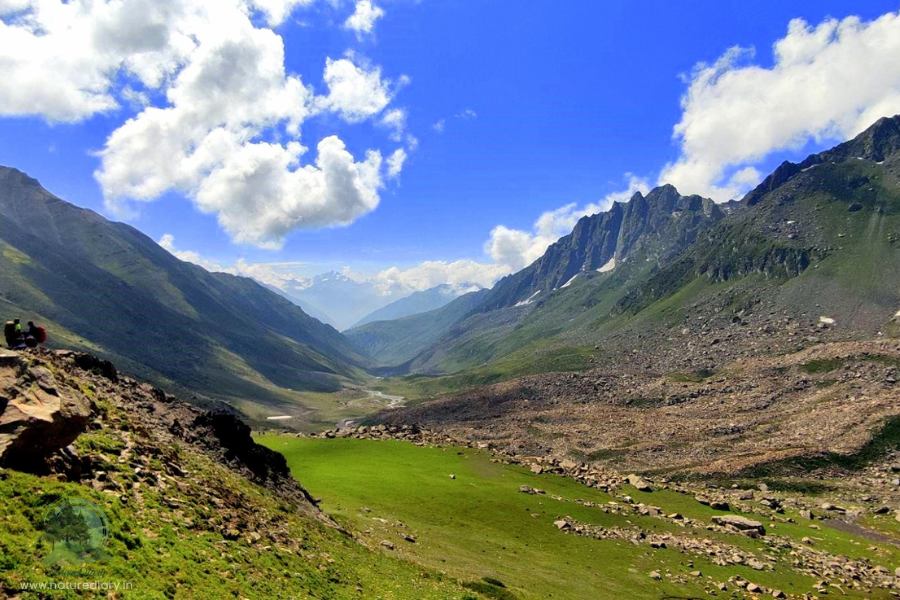
Trekkers often get an illusion of the Nichnai Pass from the campsite. A rugged ridge is visible from the meadow below. However, this is not the actual pass. Reaching the top of the pass can be hectic, as the trail bends inwards more than once.
The pass is a jagged assembly of rocks, some of which remain scattered over the trail. A long range of snow-covered peaks dominates the views on the left, with ice packs melting on their laps. Although you won’t spot any peaks on the right, the picturesque meadows would enthral your views during the KGL trek.

Once you reach the top, the trail jumps sharply from the pass. The rocks disappear from the path, and you would love to return to the pastures. Large flocks of sheep graze in the valleys, with flowers blooming at your feet. The meadows are wide, stretching for several kilometres. You have the mighty mountains on either side while charged-up rivulets cross your path in the meadow.
With the flowery meadows and peaks defining the valley’s charm, you would find yourself in the paradise of the Kashmir Great Lakes. The snow-clad Himalayan mountains remain conspicuous on your left, while the barren heights of the Ladakh ranges show up on the right. You would be trekking through a canvas of grass with lush green views on either side.
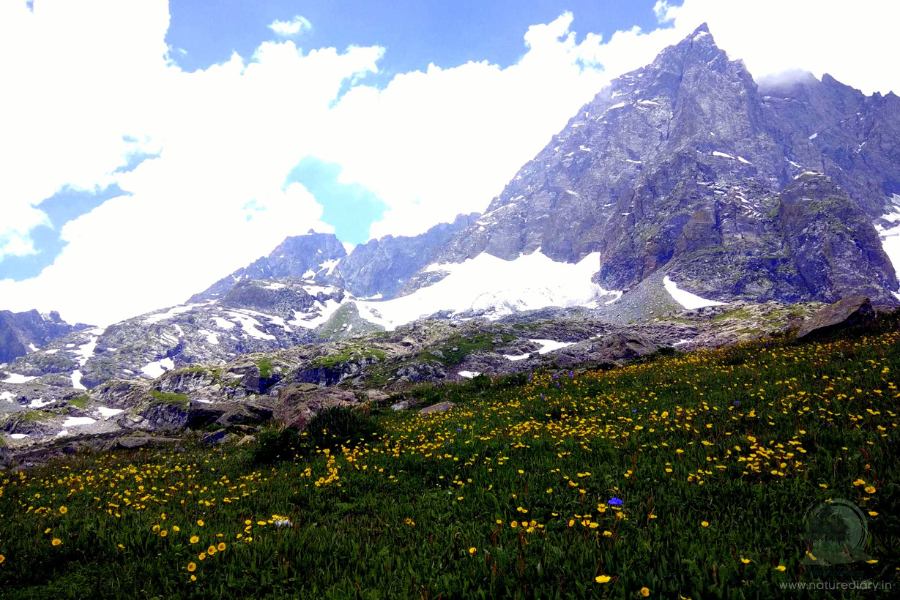
The Vishnusar Lake is not visible from the meadows, and you need to climb around a hundred feet from the campsite. There’s a stream snaking along the meadow from the lake, and you need to keep to its left. Once you pitch the tent, walk for another half a mile along the stream.
The beautiful Vishnusar Lake sits peacefully between four mountains. It reflects a clear view of the Krishnasar peak, which lies half a kilometre away. The still waters of the lake can picture a splendid view of this peak during the KGL trek. Interestingly, the Vishnusar Lake has cobalt-blue waters, like a typical alpine lake. This is due to the absence of algae, unlike the Gadar Lake, which has a greenish hue.
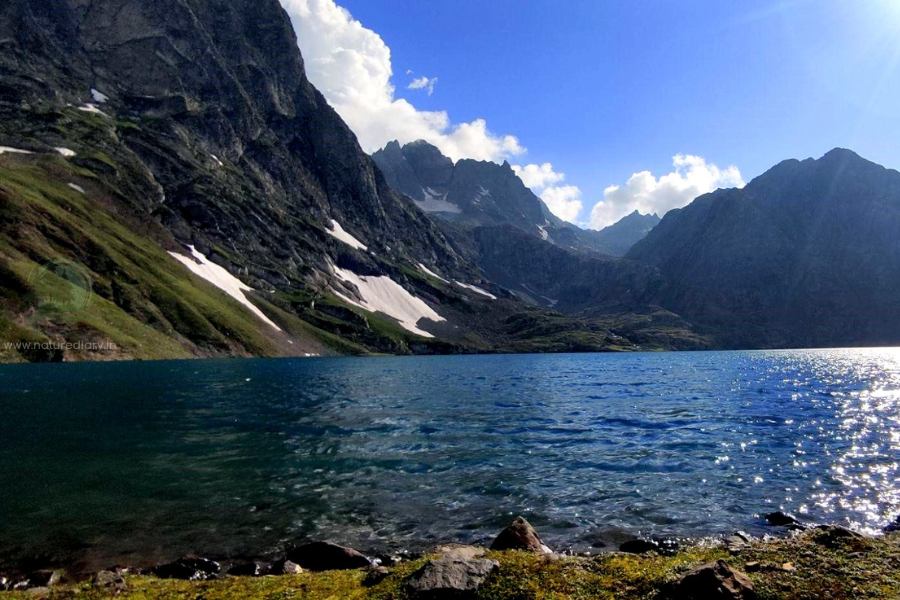
The campsite at Vishnusar Lake offers splendid views as the day gives way to dusk. With horses grazing along the stream, boulders dividing the flow of the tide, and distant colours of the campsite fading into the evening, you have hours to sit and cherish the peaceful ambience. While the high ranges of the Gadsar Pass dominate your frontal view, you can take a glimpse of the mighty ranges of the Ladakh ranges in the opposite direction.
Day 4 (Trek from Vishnusar Campsite to Gadsar via Gadsar Pass)
- Distance: 16 Km
- Trek time: 9 hours
- Altitude gain/loss: 12,011 ft. to 10,706 ft. (Highest point: 13,800 ft.)
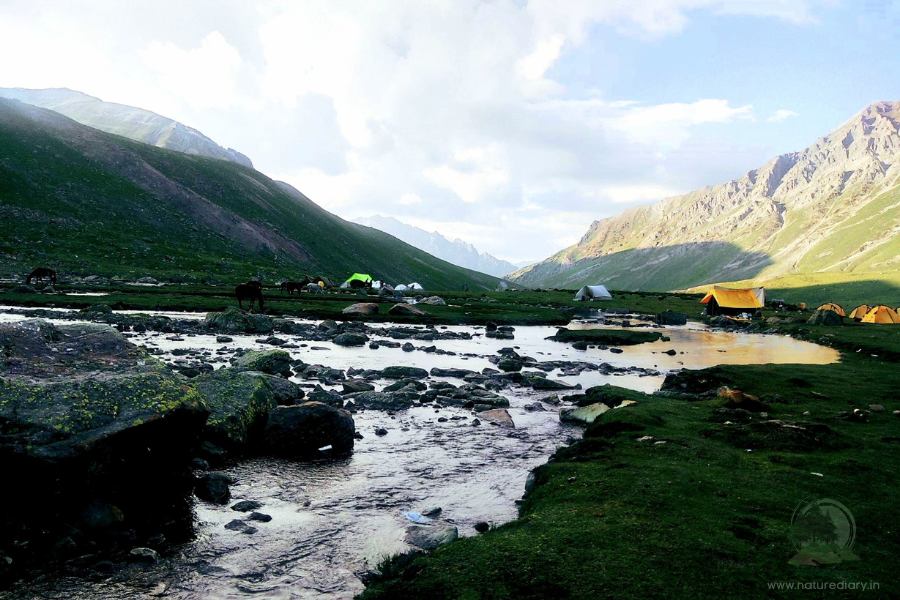
The beauty of trekking on the fourth day lies in the exotic flowers and picturesque lakes nested below the snow-clad mountains. Brace up for the longest march and probably the most hectic day of your KGL trek. On the fourth day, you need to start early from your campsite at Vishnusar, preferably by 7:30. The highest point of your trek awaits your weary presence at 13,800 ft.
The mornings are chilly, and trekkers love photo sessions along the clear reflection of the Krishnasar Peak, casting its reflection on the crystal clear blue waters of the Vishnusar Lake. Behind the campsite, there’s a moderate stretch of boulders. Around 500 ft. above the last camp, you have the Krishnasar Peak, leading to the Gadsar pass further higher.
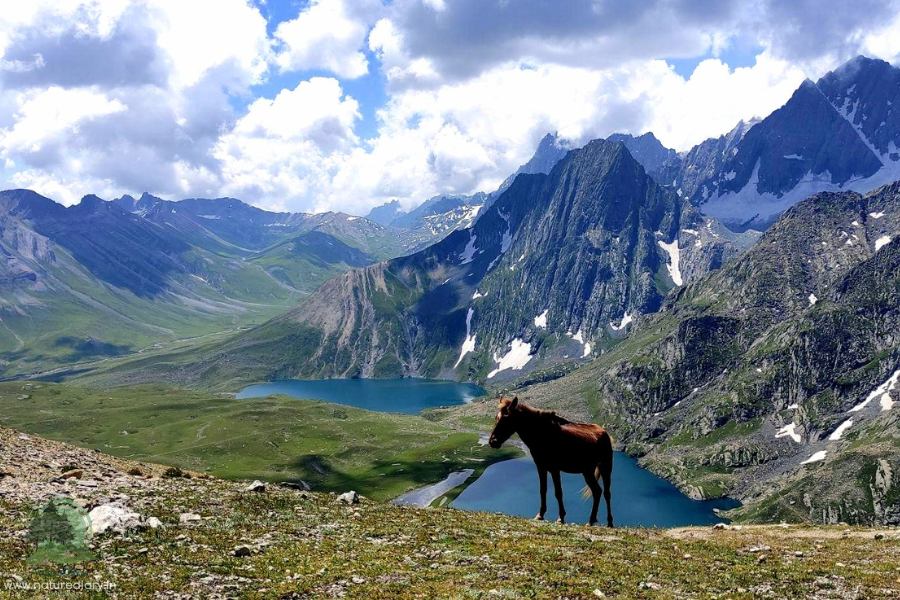
The trail leads you to the other side of the mountain. From the top, you can get a clear view of the azure blue waters of the twin lakes- Vishnusar and Krishnasar. The terrain is moderately wide, although you might feel cramped for space in some areas. Long queues of mules frequently interrupt the trekker’s progress unless the latter takes steep shortcuts.
You can catch the mesmerizing view of the twin lakes for nearly an hour until you reach the trek’s highest point at Gadsar Pass (13,800 ft). It takes nearly 2.5 hours to reach this spot from Vishnasar campsite if you walk at a moderate pace. The ascend is steep, but once you cross the pass, you will love the gentle trot downhill.
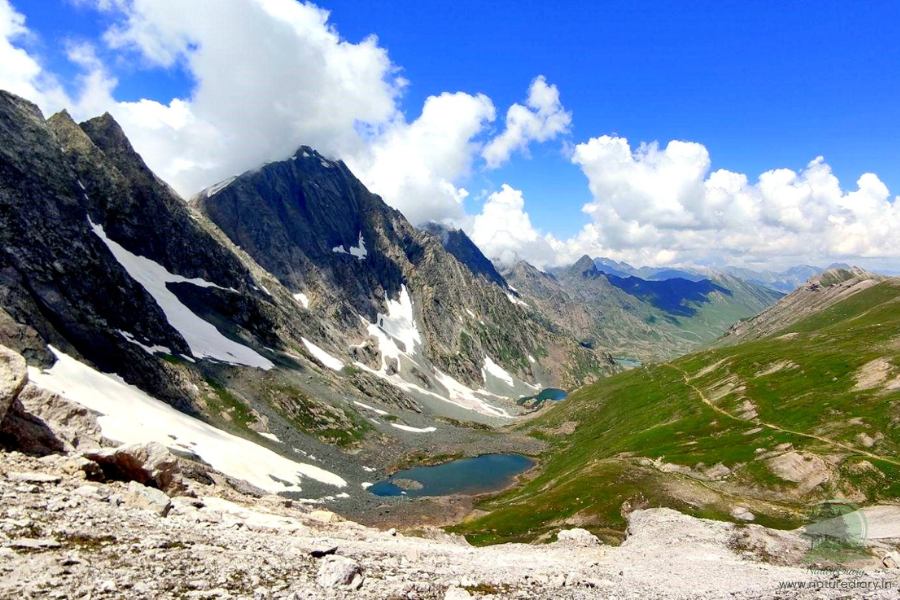
Starting early in the morning, trekkers should try to cross the Gadsar pass in the first three hours, as they still have more than an 11 Km downhill journey awaiting them. From the top of the Gadsar Pass, you can actually get a splendid view of five lakes: Krishnasar and Vishnusar at the back, and Gadsar, Yamsar, and another small lake at the front.
The downhill trek to Kashmir Great Lakes would give you lasting memories, as it is no less than the Valley of Flowers in Uttarakhand. Initially, the descent would be steep, followed by a gentle walk down the meadows. While you let your vision feast on the yellow, purple (Iris), and red flowers in the valley, the snow-clad peaks compose a perfect wallpaper in the backdrop. Even in the middle of July, you can find snow along the downhill trail on the other side of Gadsar Pass in the KGL trek.
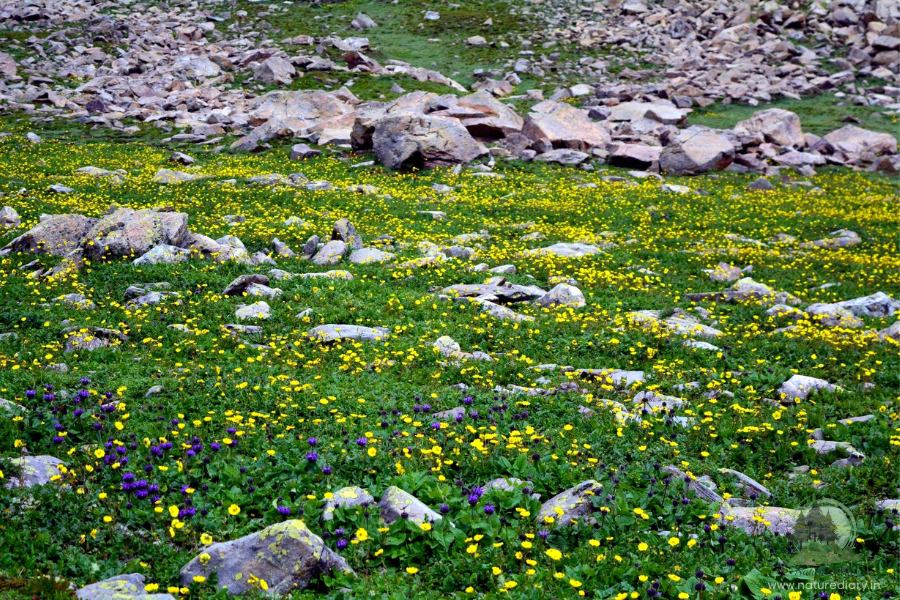
After descending for an hour, you would land in the gentle meadows with flocks of sheep once again. The valley narrows up, and you would find ranges on both sides. Further marching downhill, you will come across Gadsar Lake (12,500 ft), the last of the three lakes you had seen from the top of Gadsar Pass. The lake has a green tinge on its surface, unlike the last two lakes, due to the presence of algae. This green layer, along with the rolling meadows and snow-clad cliffs surrounding it, is a paradise for photographers.
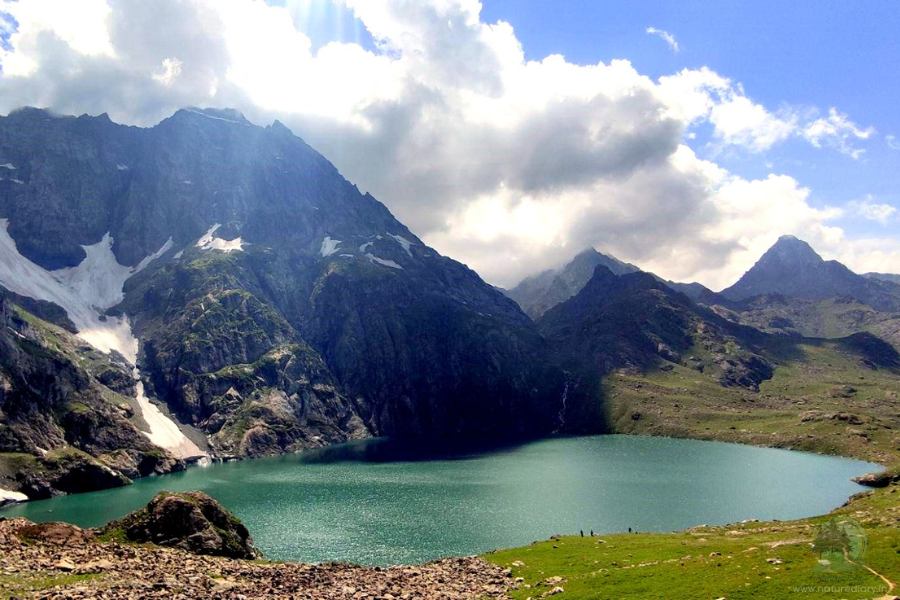
However, you need to pitch the camps further down the valley, close to the Army Camp. This abandoned army shelter lies another hour downhill, and the last stretch might take a toll on your ankles. The landscape looks pretty, just like a large green bowl of grass sitting between the green mountains. A stream trickles down the valley, connecting the three lakes.
Further down, you would come across what we call a ‘horseshoe bend’ of a stream before you reach the army camp. After verifying your identities, the Army personnel would allow you to go through the camp and pitch your tents.
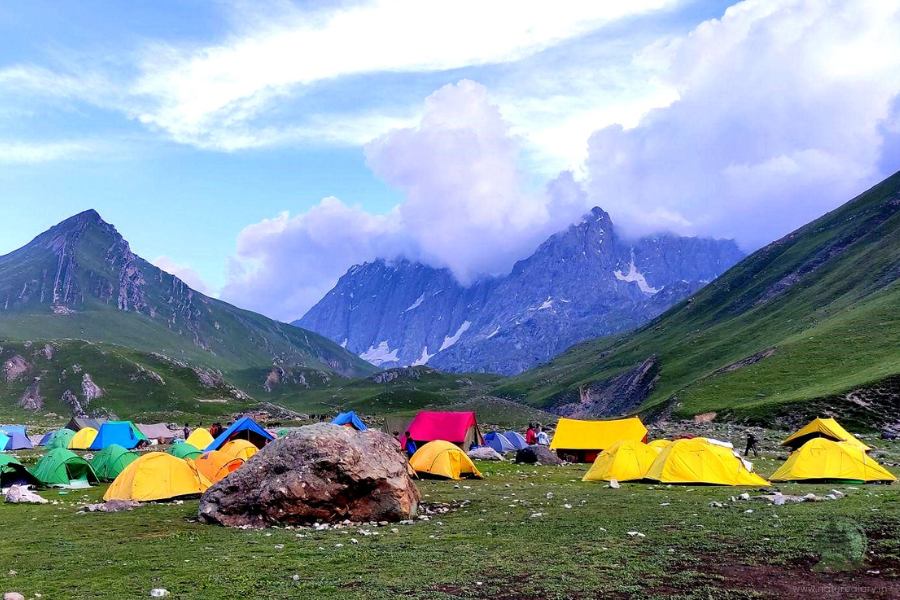
Day 5 (Trek from Gadsar to Satsar Lakes)
- Distance: 11.5-12 Km
- Trek time: 5 hours
- Altitude gain: 10,706 ft. to 11,985 ft.
The pleasant views of a stream welcome trekkers as they set their way on the fifth day for Satsar Lakes. This is a collection of as many as seven different lakes. However, you can view only four or five of these if weather permits, as the other great lakes are located on the other side of the cliffs.
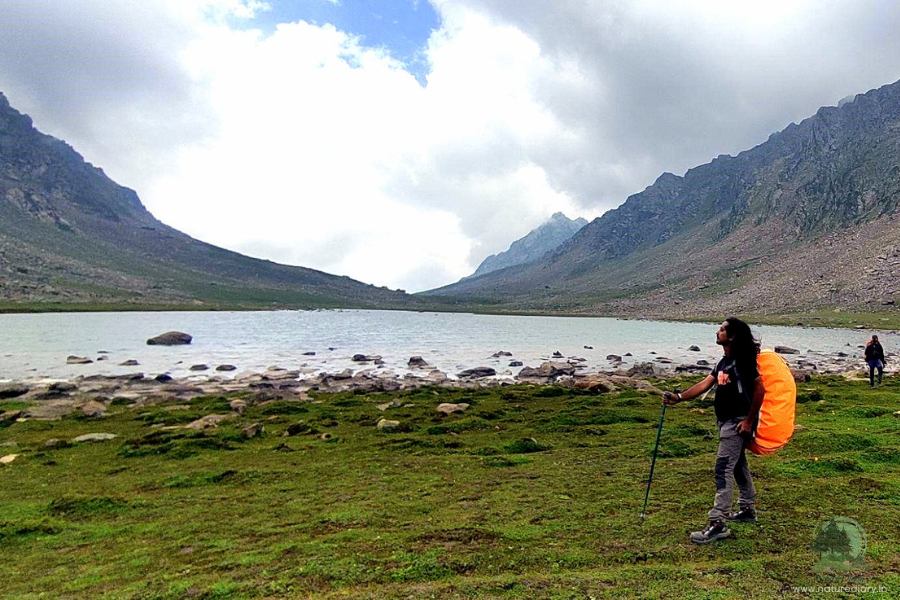
Prepare yourself for a steep ascend lasting for 1.5 hours after you cross the stream. As you gain altitude, you would find the stream narrowing down to just a glittering line far below. It’s easy to find the trail leading uphill after you cross the stream. While you can see the treeline below, the vegetation mostly consists of grass and small bushes. After reaching 11,500 feet, the trail would take you through a traverse.
Next, you can get a glimpse of POK as the trail takes you to the flat plains. Surrounded by mountains, the meadows look blissful with rolling turf on their surface. A few isolated mountains stand in front of you. A stream trickles through the flat lands, and you need to trek further down.
The tricky part of the journey lies in navigating through the boulder zone after the first of the Satsar Lakes becomes visible. The weather mostly remains cloudy here due to the geographical location of the lakes. A few showers with lightning are not uncommon in this region of the KGL trek.
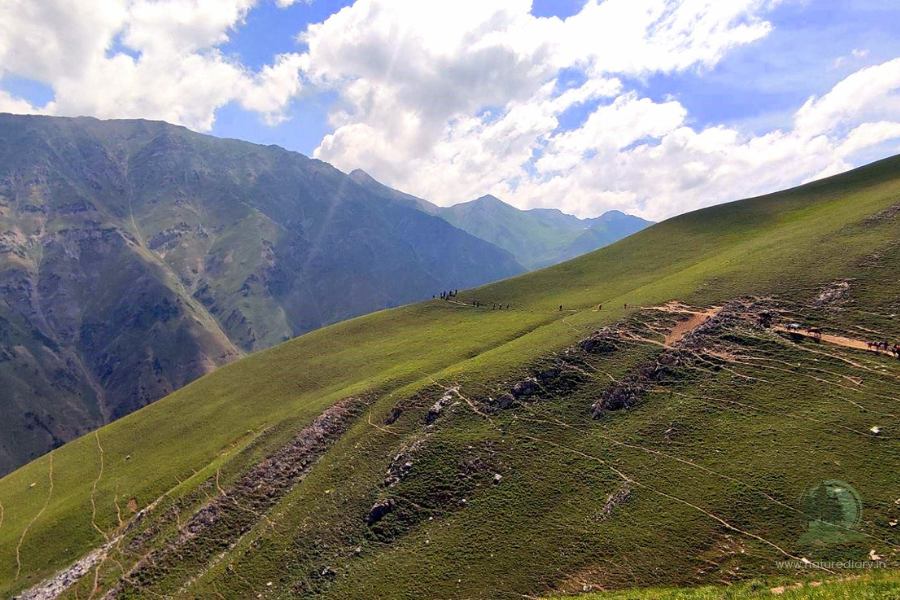
On the fifth day, the beauty of the trek lies in the distant mountains enveloping the clouds and the long stretches of flat lands with wildflowers. After you cross the bend from where you can view POK, a flat table-like landscape emerges at the backdrop, resembling the Windows 98 wallpaper.
After pitching the tent in the valley, you would have hours for the sunset to come. So, make the most of these moments and try to see as many lakes as possible during the Kashmir Great Lakes trekking.
Day 6 (Trek from Satsar Lakes to Gangabal via Zaj Pass)
- Distance: 9 Km
- Trek time: 6 hours
- Altitude gain/loss: 11,985 ft. to 11,486 ft. (Highest point: 13,276 ft.)
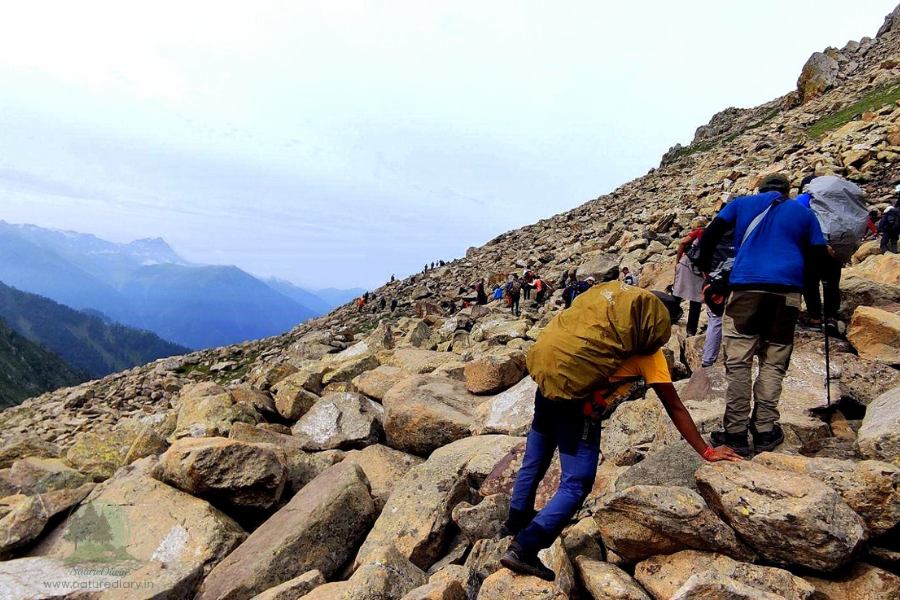
In terms of skills required, the sixth day of your Kashmir Great Lakes Trek will be the most challenging. A long boulder zone awaits you just after you leave the campsite in the morning. This would be an acid test for trekkers, particularly when you trudge through the uneven boulders. It would take around 1.5 hours to leave the Satsar Lakes behind.
Next, you would just touch the treeline before taking on a steep climb for the Zaj Pass (13,276 ft.). Altogether, this is the day to test your mental and physical stamina! This would actually be a boulder-hopping journey, and then the trail would go downhill for half an hour.
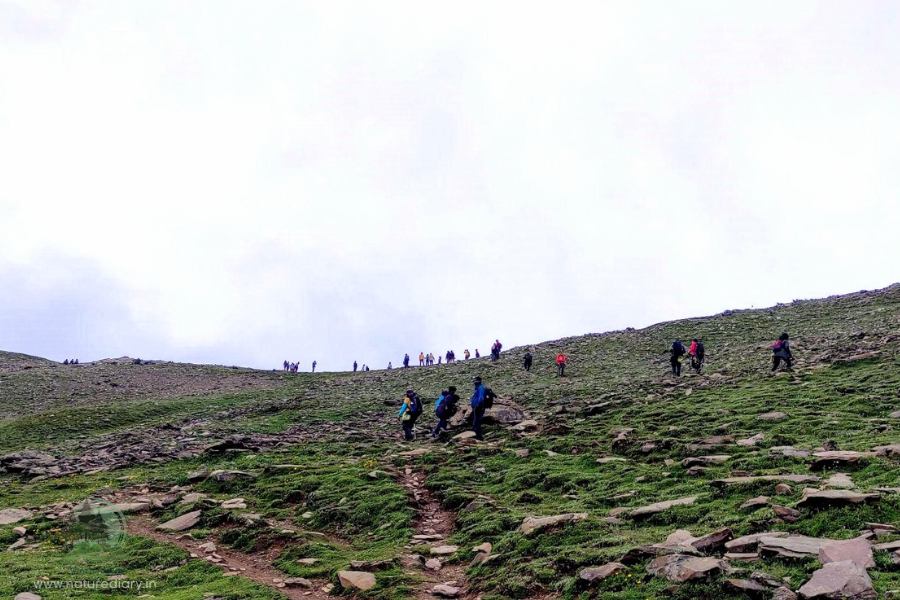
The ridge line visible from the tree line is around 1,000 feet high. On gaining this height (starting from 11,800 ft.), you need to zig-zag your path to the first ridge at the beginning. It would take around an hour to get to the top of this ridge. Once you reach here, you will find a couple of other ridges further up. The upper part is rocky and barren. As you gain altitude, you will appreciate the contrasting views of the greenery behind and the rugged barrenness ahead.
Reaching the third ridge would take more than two hours. This is the top of the Zaj Pass, and you would get a surprising view of Mount Harmukh, which is believed to be the abode of Lord Shiva. The twin lakes of Gangabal and Nundkol lie at the feet of Mount Harmukh. If you are lucky, you will get a crystal-clear view on a cloudless day!
This view of the twin lakes is one of the most striking scenes of the KGL trek. These two lakes are connected by a stream and lie adjacent to one another. On the right, the lake you see is Gangabal, while the other one is Nundkol.
Well, the destination for your camp is 1,400 feet below, so you know how sharp the descent should be. The stony path is full of loose rocks and large boulders, so take care of your footing. Most trekkers pitch their camp beside Nundkol Lake.
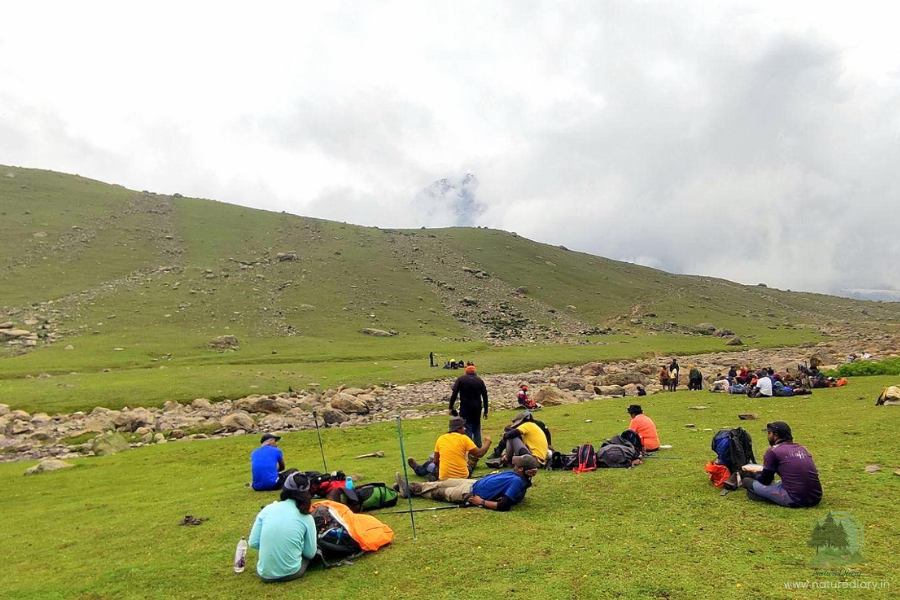
While you descend, take photos of the natural stone formations with green algae and vegetation, adding a mystic essence amidst the clouds at the backdrop. On the way, you would come across a charged-up stream sonorously making its way through the boulders. Fill your bottles if they are empty and make a steep descent to reach the green pastures again.
Well, this is a great place to have your lunch, as a short ascent awaits you before you can finally descend and reach the campsite. Lake Nundkol and Gangabal are favourite weekend destinations for local Kashmiris near Kashmir Great Lakes. So, it’s common to find them pitching their tents beside yours. These people are very friendly, and it would be a pleasure for you to experience the typical Kashmiri lifestyle.
On the rocky edges of the Harmukh, you can spot glaciers hanging. Trout fishing is a popular activity in both these lakes and the narrow stream connecting them. After pitching your tent, it would take around half an hour to trek to Gangabal Lake on the other side of the rocks. There’s a solid bridge close to the lake, so you need not risk yourself getting wet while trying to cross the stream on logs.
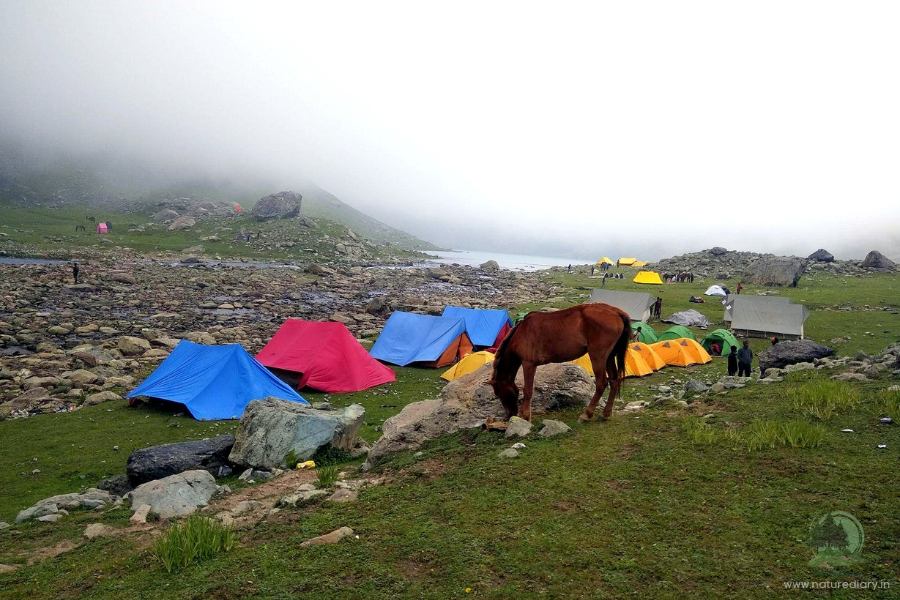
Day 7 (Trek from Gangabal Lake to Narnang and Drive to Srinagar)
- Distance: By trekking 13 Km and driving 52 Km
- Altitude loss: 11486 ft. to 7800 ft.
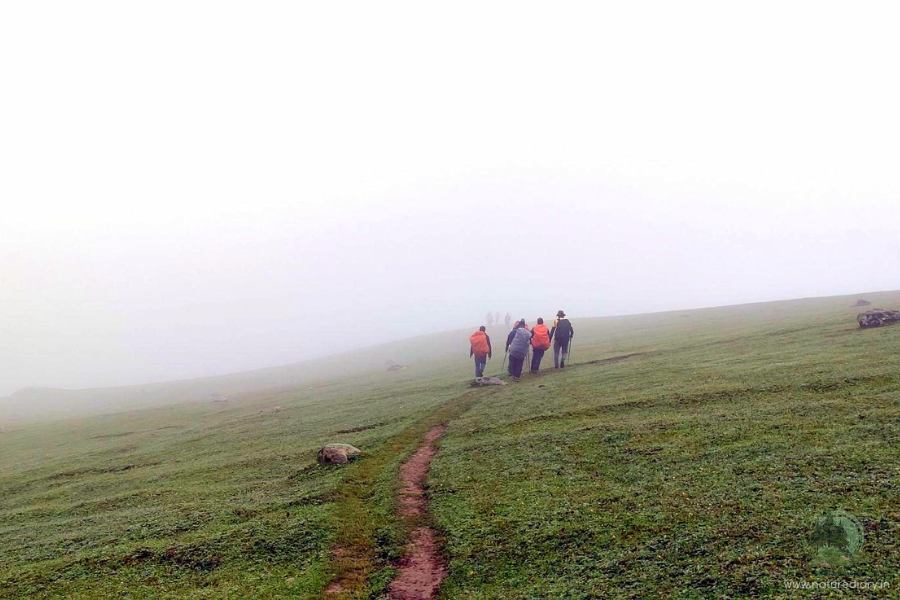
Well, they say nothing ends until it actually ends! The last day of your Kashmir Great Lakes Trek would probably strain your ankle or calf muscles or even break your toes if you aren’t habituated to steep down treks. Loose rocks and narrow trails further make the descent challenging. Moreover, mules and horses carrying luggage often get stuck or topple over the sharp bends downhill, unable to keep their balance. Therefore, navigating through this stretch is going to be a challenge.
Start early in the morning, preferably by 6 AM since a thorough luggage check session awaits you at the army camp. There’s a narrow log bridge (not more than a foot wide) over the stream connecting Nundkol lake to Gangabal Lake. After crossing this stream, take the trail through the tree line, keeping to the ridge at the right. After one hour or so, you would reach the army camp, and the verification process might take more than a couple of hours. This is why it is recommended not to schedule the flights on that day itself.
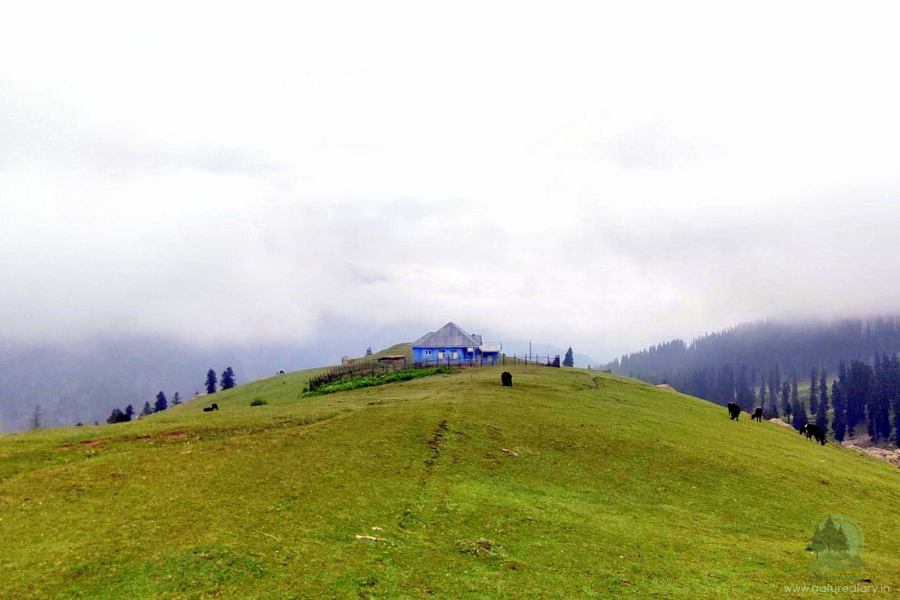
Sitting at the army camp, look at Harmukh peak if the sky is clear. However, photography by mobile phone, DSLR or drone camera is strictly prohibited at the army camp. Meanwhile, you can catch the phone tower here after 7 days of the KGL trek, so call home to inform them that you are doing great!
Well, the beginning of the pine tree lines marks a significant descent, and you would soon be getting back to civilization. Keep to the right without venturing into the forest; otherwise, you can lose your path. On the last day, the vegetation would be quite different from whatever you had seen throughout the trek. Tall pines, misty trails, and meandering boulder paths resemble typical cloudy hill stations of India.
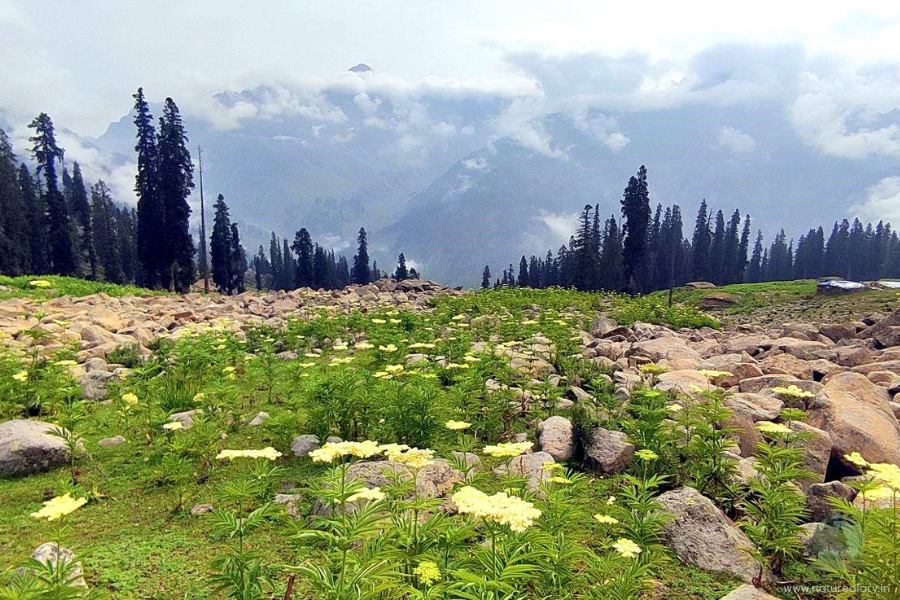
The actual descent begins after you trek 60% of the path on the last day. Brace up for a really steep descent through the muddy paths. Remember, you would be descending more than 3,000 ft. in the last 4 Km. So, you know how badly your toes might ache! The last stretch to Narnag would test your tenacity and endurance, as you can now see the civilization, yet the path seems never-ending.
Well, if you find yourself on the uneven stone track of the adjacent village, comfort your feet that Naranag is not far away. Once you get to the main road, don’t forget to take a selfie along with the hoarding welcoming you to the KGL trek.
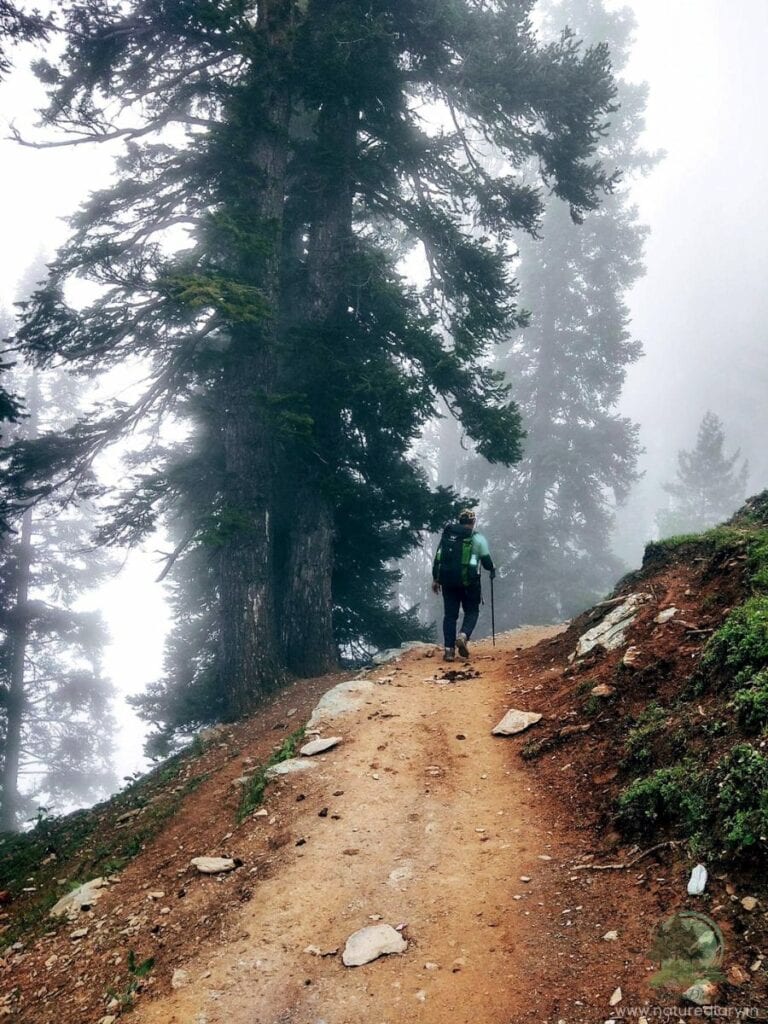
How Much Does Kashmir Great Lakes Trek Cost?
While calculating the cost of the Kashmir Great Lakes Trek, you need to factor in the cost of food, accommodation in tents, and the fees of your guide. Generally, you should be able to complete the trek within ₹12000 to ₹15000. If you want to offload your luggage, be ready to shell out ₹400-₹500 extra daily to the porter.
Although there are several reputed organizers for the KGL trek, I highly recommend Himalayan Passion for their excellent arrangements and professionalism during my trip. Not only Kashmir Great Lakes, but Himalayan Passion also arranges various treks in Uttarakhand, Himachal Pradesh, Sikkim and West Bengal.
- Plan Your Trek With Himalayan Passion
Activities During Kashmir Great Lakes Trek
Treks are loaded with adventures and activities. While we won’t recommend you wander away from the main trail, here are some activities you might try on the KGL trek.
- Take a Dip in a Glacial Lake: While you would be toiling all six days of the Kashmir Great Lakes trek, why not cherish the cool sensation at a glacial lake? The water would be chilly at Gangabal Lake when you reach it. Hold your breath and take a quick dip (unless you are prone to cold). This will be a good idea if you have a buffer day.
- Camping : During the KGL trek, you can camp by most of the lakes. It is a thrilling activity while enjoying the cool breeze and the view of the majestic Himalayas. If you love camping by a lake, visit Pawna lake camping in Maharashtra for a weekend.
- Taste Wild Berries : Trekking from Gadsar Lake to Satsar Lakes, you would come across wild berries growing on the grass. These are some of the sweetest berries you would ever find! It won’t be a sin to treat your taste buds with some of these berries as you cross the meadows.
- Explore Hidden Lakes : If you are an avid trekker, you won’t repent walking a few extra miles to find hidden lakes. While you would reach the campsite by 4 in the afternoon most days, you would have at least four hours of daylight left. Utilize this time to find the smaller and nameless lakes by taking small hikes from your campsite.
- Go Fishing : Fishing is popular among the locals at Gangabal Lake. Even Vishnusar Lake is known for its enormous reserves of trout fish. You simply need to obtain a permit so that you can spend the late afternoons fishing by the lakes.
- Stargazing : Kashmir Great Lakes are one of the magical places for stargazing in India . It is another exciting activity for adventure lovers during the KGL trek. As the sky remains mostly clear during the night, you can see stars, planets and galaxies with bare eyes. You can even capture the beautiful night sky using your camera that supports astrophotography.
- Bird Watching : As the KGL trek lies in the Himalayan mountain range, the nearby places are home to birds like finches (gold and rose), wagtails, pipits, and marmots. You can use a long-distance binocular to spot the birds or a camera to capture the moment.
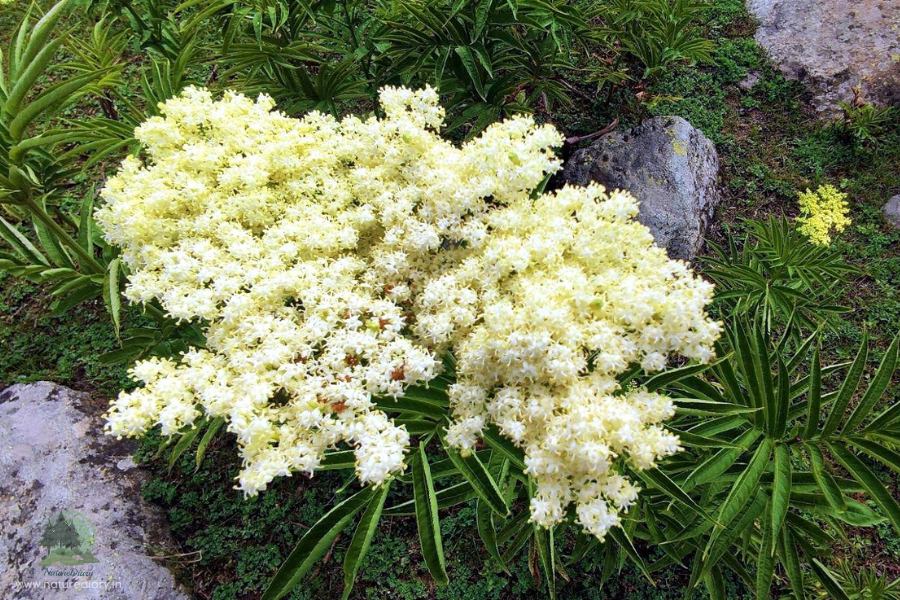
Things to Carry during KGL Trek
- Documents : Among all trekking essentials for the KGL trek, documents are the most important. Carry the original and Xerox copies of the Aadhar card or other photo ID cards issued by the government. Also, you would need a medical certificate validating your fitness issued by a practising doctor for trekking to the Kashmir Great Lakes.
- Trekking Shoes : Considering the rugged terrain on KGL Trek, you would need the comfortable and waterproof trekking shoes capable of walking on snow. Ensure proper ankle support and grip since you would cover long distances, including boulder sections and muddy terrains.
- Rucksack or Trekking Backpack : Get a backpack of 50 to 60 litres with good shoulder and hip support. The pockets should be quickly accessible. Thus, choose a water-resistant rucksack with rain cover since there is a possibility of a shower at any time.
- Clothes : While going for the KGL trek, you need at least three to four layers. So, carry 3 synthetic T-shirts, 2 light fleece jackets , 1 full-sleeve sweater, and a waterproof outer layer like a jacket. 2 trekking trousers would be adequate. Don’t miss out on your sun cap, woollen cap, synthetic gloves, socks (3 pairs), sunglasses, and sunscreen.
- LED Torch or Headlamp : Since no electricity would be available throughout the trek, it would be wise to carry your LED torch or headlamp. Make sure to carry enough batteries so that they last 7 days. We recommend a headlamp since it would keep your hands free, whether you pack your bag inside the tent or visit the toilet tent.
- Other Accessories : Carry other necessary accessories like a power bank, sanitiser, soap paper, wet wipes, and a raincoat. Also, carry trekking poles, binoculars, insect repellants, medicines, water bottles, lunch boxes, and reusable plastic bags. You don’t have to worry about tents or sleeping bags as the tour operator facilitates them.
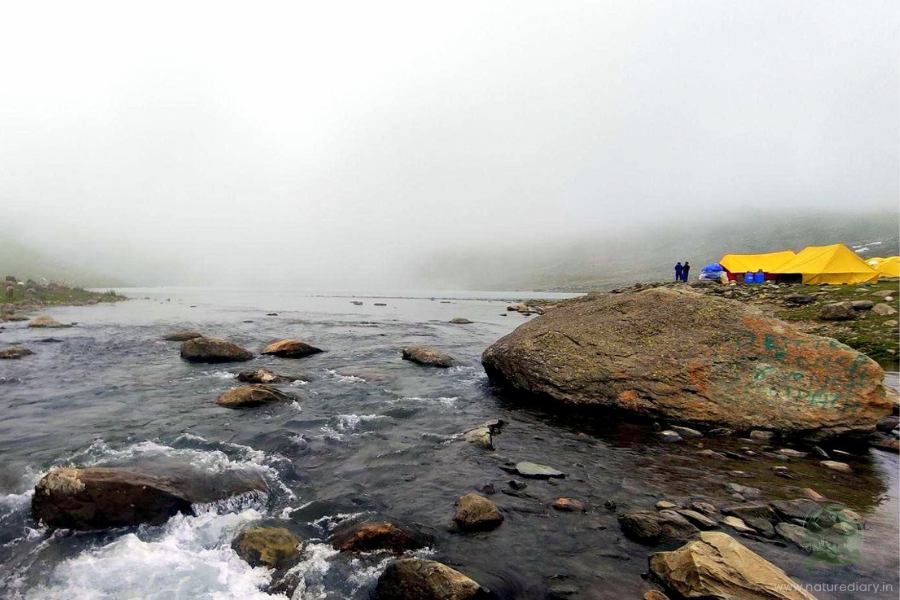
Tips For Trekking to the Kashmir Great Lakes
- Fitness matters the most when you take on a challenging trek like KGL. Prepare yourself by running or jogging for a week thrice. You should be able to comfortably cover a distance of 5 Km. in 40 minutes. Apart from developing lung capacity, get some resistance workouts like lunges and squats for your legs.
- During the Kashmir Great Lakes trek, staying hydrated is key to maintaining fitness. Drink at least 4 litres of water each day. While you can carry 2 litres of water during the trek, make sure to fill up the bottles from the streams on the way.
- Make sure to put on your suncap and sunscreen to beat the heat. Although the temperature would remain under 20 degrees C most of the time, the long exposure to the sun (6-8 hours each day) can take a toll on your skin and stamina.
- Listen to your trek leader and guide, and do not stray away on other trails. While taking photos, avoid queuing up on boulder zones to avoid accidents.
- Carry a postpaid sim card to communicate with your family members since prepaid sims do not work in Kashmir.
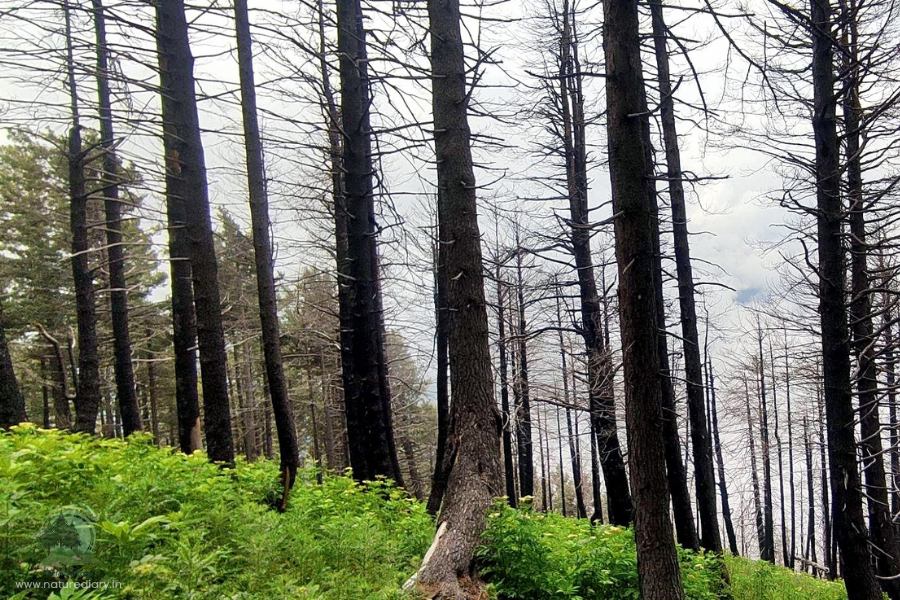
Frequently Asked Questions (FAQ)
The Kashmir Great Lakes Trek has a moderate to challenging level. Although the pictures look beautiful, you need to toil your way through the trek. The factors making it a tough trek include the long distances each day (12-16 Kilometers), a considerable gain in altitude, and three high-altitude pass crossings.
Yes, the KGL trek is absolutely safe. It is away from the border areas and disturbances. The trek lies in the Sonmarg region, which attracts lots of tourists. Besides, the trekking trail has as many as 3 army camps. You would be camping close to these camps, which makes the trek safe.
In 7 days, you need to cover around 75-80 Km. Therefore, on average, you would be trekking around 9-16 Km each day.
You can cherish as many as 6 alpine lakes in the KGL trek. Apart from these, you can try and find some of the smaller lakes along the trail.
Yes, Kashmir Great Lakes Trek is one of the most diverse and picturesque treks in India. If you can make it, you should consider yourself lucky to witness the pristine waters of the lakes, rolling meadows, high-altitude peaks, and snow-clad mountains.
Trekkers usually go for KGL from July to mid-September. Heavy snowfall keeps the trails buried during the other seasons. Although the rest of the country, and even Uttarakhand, experiences monsoon during these three months, this is the ideal time for trekking the Kashmir valley. Thanks to the Pir Panjal Range, Kashmir remains in the rain shadow side as it blocks the clouds from Uttarakhand. Nature bursts into bloom, although you can spot melting ice caps all around.
Kashmir Great Lakes Trek is a high-altitude trek. So, you need to carry your tents and other necessary tools to pitch them. Starting from Shitkari, you would pitch these tents in the respective campsites each day until you reach Gangabal. No other accommodations, such as hotels or homestays, are available amidst the wilderness.
Generally, the trek organizers provide wholesome meals during breakfast, lunch, evening snacks, and dinner. They also supply dry fruits and chocolates. Trekkers can also carry cashews, almonds, nuts, raisins, and dry foods on their own. Chapatis, rice, bread, cornflakes, vegetables, rajma, dal, sweet dishes, and milk are available with most of the trek organizers. All supplies must be carried on mules or horses, along with other cooling accessories and gas cylinders.
We hope that you have enjoyed this article. Let us know your experience! If you like us to write on any specific topic, send your request to [email protected] . Your feedback is highly appreciated. We will love to hear from you!
Is This Article Helpful? Cancel Reply
- Rating 5 4 3 2 1

Kashmir Great Lakes Trek
Introduction.
The Kashmir Great Lakes Trek is a moderate hiking trail in the western Himalayas of the Kashmir region. The base-camp Sonamarg lies on the Srinagar-Leh National Highway. The ending point Naranag village is also connected with the same Highway. The trek can be done in both ways, but to escape the direct Sun it is recommended to commence the trek at Sonamarg and end at Naranag as it treks mostly in a westerly direction.
The Great Lakes as the name suggests treks through many high altitude alpine lakes situated at the foothills of different snow-clad mountain peaks. The most famous lakes are Vishansar and Gangabal Lakes. It crosses streams, plenty of colorful alpine meadows, and ascends three mountain passes with an average altitude of 4000m above sea level. The highest mountain peak of the trek which dominates the second part of the trek is Mount Haramukh standing at 5300 meters above sea level.
The Great Lakes Trek expedition is no walk in the park. Arduous days, steep mountain passes, and altitudes approaching 4200m demand a sure-feet and a good amount of physical and mental fitness. The difficulties of the trek are rewarding and the challenges are worth it for the sense of achievement. This trek of the Kashmir is the most beautiful and most serene of all treks in the Himalayas.
While planning your trek, as a beginner keep the following points in consideration:-
- you feel fit enough to trek for hours.
- you walk two or three kilometers daily.
- you don’t have any breathing problems.
- you are not scared of heights.
FIXED DEPARTURES (June-Sept 2024)
21 June - 28 June 2024 (OPEN) 23 June - 30 June 2024 (OPEN) 28 June - 5 July 2024 (OPEN)
4 July - 11 July 2024 (OPEN)
6 July - 13 July 2024 (OPEN)
7 July - 14 July 2024 (OPEN)
12 July - 19 July 2024 (OPEN)
13 July - 20 July 2024 (OPEN)
14 July - 21 July 2024 (OPEN)
19 July - 26 July 2024 (OPEN)
20 July - 27 July 2024 (OPEN)
21 July - 28 July 2024 (OPEN)
2 August - 9 August 2024 (OPEN) 3 August - 10 August 2024 (OPEN) 4 August - 11 August 2024 (OPEN) 5 August - 12 August 2024 (OPEN) 9 August - 16 August 2024 (OPEN) 10 August - 17 August 2024 (OPEN) 11 August - 18 August 2024 (OPEN) 12 August - 19 August 2024 (OPEN) 17 August - 24 August 2024 (OPEN) 18 August - 25 August 2024 (OPEN) 24 August - 31 August 2024 (OPEN) 25 August - 1 Sept 2024 (OPEN) 30 August - 6 Sept 2024 (OPEN) 31 August - 7 Sept 2024 (OPEN)
2 Sept - 9 Sept 2024 (OPEN) 6 Sept - 13 Sept 2024 (OPEN) 7 Sept - 14 Sept 2024 (OPEN) 8 Sept - 15 Sept 2024 (OPEN) 13 Sept - 20 Sept 2024 (OPEN) 14 Sept - 21 Sept 2024 (OPEN) 15 Sept - 22 Sept 2024 (OPEN)
High Altitude Precautions PDF
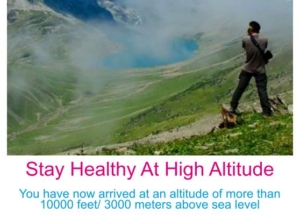
What’s included in the Price?
For Day 1, from Srinagar airport to Sonamarg base camp; Day 7, from Naranag to Srinagar Hotel and Day 8 for airport or Bus Station drop
Twin sharing; 2 persons in a 3-man-tent
Hotel Ash Vale/ Houseboat Jewel Box or similar
Tents (twin sharing), dining and kitchen tent, toilet tents, sleeping bags and mats. Trekking poles (1 per person) also included.
Languages; English, Urdu, Hindi and Kashmiri
Horses to carry your backpack (below 20kgs) throughout the trek (except day sack)
Trek- 4 meals per day (Breakfast, Lunch, Tea snacks, Dinner). Hotel or Houseboat – 2 Meals (Dinner and Breakfast)
Wildlife/ Forest Permits
Packed bottled mineral drinking water (2 ltrs per person) on first day of the trek. Later on boiled drinking water at camp sites in the morning & evening hours.
With Medical Oxygen
For trek-Insurance, we need a medical fitness form. You can download the proforma here and after filling in the details, email us a copy to [email protected]
What’s not included in the Price?
Costs associated with a medical incident, such as your evacuation from the mountain and/ or hospitalization (for which you should have travel insurance)
Brief Itinerary
Day 1 :- Srinagar to Sonamarg
- Arrive Srinagar (Alt. 1600m)
- Pickup from Srinagar airport or Bus stand or hotel
- 100 kms drive to Sonamarg, approx 3 hours.
- Our first campsite Sonamarg (alt 2610m) at Sind riverbank.
(Transport from Srinagar to base-camp. Tea, dinner at the camp)
Day 2:- Sonamarg to Nichnai.
- Altitude: 2610m to 3450m
- 11 kms trek, approx 7 hours
(breakfast, lunch, tea, dinner)
Day 3 :- Nichnai to Vishansar Lake via Nichnai Pass
- Altitude: 3450m to 3650m via 4080m
- 12 kms trek, approx 7 hours
Day 4:- Vishansar Lake to Gadsar via Gadsar Pass
- Altitude: 3650m to 3550m via (4180m)
- 14 kms trek, approx 8 hours
Day 5:- Gadsar to Satsar
- Altitude: 3550m to 3650
- 9 kms trek, approx 5 hours trek
Day 6:- Satsar to Gangabal Lakes via Zajibal Pass
- Altitude: 3650 to 3580m via 4080m
- 11 kms trek, approx 6 hours
Day 7:- Gangabal to Naranag trek, Drive to Srinagar
- Altitude: 3580m to 2250m
- 15 kms trek, approx 6 hours
(Breakfast at camp, Lunch at Naranag, Transport from Naranag to Srinagar Hotel, dinner at the hotel)
Day 8:- Srinagar Airport or Bus Stand drop.
- 5 kms drive to bus stand, approx 20 minutes
- 12 kms drive to Srinagar airport, approx 30 minutes
(Breakfast, Transport from Srinagar to the airport for departure)
Detailed Itinerary
Day 1: – Arrival. Reception at Srinagar airport/bus station. On arrival at Srinagar airport or bus station, our representative cum driver will receive you and drive to Sonamarg for an overnight stay in a tented camp. We have a tea or kahwa before the dinner at the evening. The drive through Ganderbal villages takes maximum 3 hours to cover a distance of around 100 kms. Sonamarg is the last town with a market before the start of the trek.
Day 2: – Sonamarg – Nichnai (7 hrs trek). After breakfast at the campsite, we pack our load and backpacks on horses and start our trek. Our trek is a slightly steep ascends the meadows and enters a pine/ birch forest at Shokdari. There’s a army check post where we have to produce our ID cards or passports. The process takes not more than 10 minutes to tally the ID’s with the trek-permits which we had acquired well in advance. The officials are very friendly and the short break is worth to have a distant sight of the Thajwas glacier and the vibrant Sonamarg town. We trek pine forest for 3 hours and have our lunch at Shokdari Top. After the lunch our trek enters birch forest a slight descend trek, very comforting in walking as we enter the vast and long Nichnai meadow. It takes another hour or two to reach our camping ground to have our tea or kahwa and finally the dinner and an overnight stay.
Day 3: – Nichnai – Vishnasar – Krishansar Lake (7 hrs trek). After the breakfast, we leave Nichnai meadow crossing a small icy-water stream, we start ascending one of the three passes of the trek the Nichnai Pass (4080m). The pass will test our legs and most importantly our stamina. The trek which takes an hour of some steep hiking looks never-ending. We ascend the pass through grazing pastures of sheep and goats. After crossing the pass we enter into the Vishansar Valley which is also called as “the valley of medicinal plants”, due to its sheer varieties of alpine flowery plants. We take our lunch and trek all the way down to Vishansar Lake. We take our tea or kahwa and the dinner at the campsite. Vishansar Lake is just a 10 minutes walk away from our campsite.
Day 4: – Vishansar – Gadsar (8 hrs trek). After the breakfast, we start our day’s trek looking over and over to Vishansar Lake while we ascend to Krishansar Lake. The Krishansar Lake is a sibling of the former, it lies just over a ridge. We take its eastern shore to ascend the second and the highest pass of the trek the Gadsar Pass (4180m). The pass-trek is steeper than that of the Nichnai. It takes 2 hours to ascend the pass. On the top of the pass, we have the aerial view of the whole Vishansar valley among it are situated the twin lakes of Vishansar and Krishansar “the source of Neelam River”. We trek-down the Gadsar valley and take our lunch at the Gadsar Lake. The valley is also full of the flowery alpine plants and the green carpeted mountains look fabulous with their snow-clad tops. Our alpine pasture trek is full of Kashmir sheep, while walking down the trek it looks never ending as finally we arrive our camping ground at Kostour Kot. Before few years there used to have another army check-post, but luckily they are gone. Now no more checking at Gadsar. We take our tea or Kahwa and have our dinner at the evening.
Day 5: – Gadsar – Satsar Lakes – Megandoab (5 hrs trek). After the breakfast we ascend Kostur Kout leaving Gadsar valley, it takes 2 hours of a trek to enter the meadow of Rasbal. At the Rasbal a flowing river disappears inside the boulders and flows underground. The trek follows a fertile meadow. We continue our trek through seven small lakes of Satsar and camp at Megandoab at the foothills of the third pass of Zajibal for an overnight stay. Today we take our lunch at the campsite as this is the shortest day of the trek.
Day 6: – Satsar – Gangabal lake (6 hrs trek). After the breakfast at the campsite we start our trek by criss-crossing boulders. We ascend the last pass of our trek ‘Zajibal Pass (4080m)’. It takes maximum 3 hours of alpine trekking. As we reach atop, all our tiredness falls apart by looking at the views and the mountain scenery of the Mount Haramukh (5300m) just standing in the front and at its footsteps lie the twin beautiful alpine lakes of Gangabal and Nundkol. There is also a clear view os the distant Kolesar Lake. We descend the pass and reach our campsite at Gangabal Lake for an overnight stay. We take our lunch at the lake and tea and dinner at the campsite.
Day 7: – Gangabal – Naranag. (6 hrs trek) – Srinagar (2 hours drive). We leave Gangabal and Nundkol Lakes and trek down the meadows of Trunkhol. We may need to produce our permits and show our ID cards at the Army check-post at the Trunkhol. We continue our trek down and enter the tree-line. We trek down to Naranag village through the pine forests of Bodpathri. Here ends our 6 days of walking. We take our lunch at a Restaurant and take our car drive back to Srinagar houseboat or hotel for an overnight stay. Dinner and breakfast at the houseboat or the hotel.
Day 8: – Departure day. Our representative will drop you at the airport or bus station for the departure.
What to Carry?
The trek is supported by horses. You will need to carry only a light sack, weighing about 4-6kg for your items like passport, money, and camera gear. The following is a list of the items you should carry on the trek. If you have items that can not be used on the trek, you can store them at our houseboat or our office and take them back after returning from the trek.
(Please note that only postpaid Indian mobile sim cards (Jio, Airtel and BSNL) work in Kashmir Valley. There’s no cellular connectivity from Day 2 to Day 6 of the trek.)
- Passport or a valid ID card
- Duffel Bag 60 liters
- One Pair Trekking Shoes
- One Pair Trail Approach Shoes
- Trekking Pants
- Hooded Rain Jacket
- One Pair Sunglasses
- One Pair Liner Gloves
- Small Size Day-Pack
- Two Pair Trekking Socks
- One Pair Sandals
- Extra Warm Clothes
- Warm Hooded Down Jacket
- Sunscreen Cream
- Any Personal Medication
Kashmir Treks are achievable by anyone with a healthy lifestyle and a good level of general fitness. Team members should be willing to be part of a team working together to achieve the goal of the expedition. As a team member, you should have an adventurous and robust spirit. The biggest challenge on this expedition will be the many consecutive days of challenging trekking across alpine terrain, much of which at altitudes of above 3000m.
Minimum fitness requirements
- Trek: up to 7km per day.
- Daily activity: up to 5 hours’ trekking per day.
- Carry: up to 5kg in a day-sack.
- Terrain: remote, uneven, snowy, icy, rocky, sometimes exposed terrain at up to 4200m.
- Climate: Can be sunny in valleys and cold and windy at high altitudes. June and September months are cooler than those of July and August. Averages are 3000m, 1°C to 20°C.
- Swim: not required though there will be stream crossings to make.
Address Info
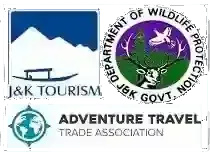
Testimonials

Kashmir Treks on TripAdvisor 5 out of 5 based on 148 reviews.
GET IN TOUCH
Useful links.

Kashmir Great Lakes Trek
Northern Indian Himalayas
Starting from
he Kashmir Great Lakes trek is a popular trekking route located in the Kashmir region of India. This scenic trek is known for the stunning seven high-altitude alpine lakes, breathtaking mountain views of Harmukh and Gangabal. The kashmir great lakes trek is typically completed in 7-8 days, covering around 65-70 km, and is graded as moderate to difficult. Moreover, the trek takes you through several alpine meadows, dense forests, and snow-covered passes, including the Nichnai Pass and the Gadsar Pass. The highest point of the trek is the Gadsar Pass, which stands at an altitude of 13,750 feet. The trek is best done during the months of July to September, when the weather is pleasant and the trekking conditions are favorable. During this time, the valleys are in full bloom, and the landscape is a riot of colors. Notably, this period offers the best views of the region's flora and fauna. One of the most remarkable features of the trek is the alpine lakes that dot the route. Furthermore, the trek takes you through some of the most stunning lakes in the region, including the Vishansar Lake, Gadsar Lake, Satsar Lake, and Gangbal Lake. These lakes are surrounded by towering mountains and offer a tranquil and serene atmosphere. This makes them an ideal spot for camping and relaxation. To undertake the Kashmir Great Lakes trek, it is advisable to hire a professional guide and trekking agency who can provide you with the necessary equipment and ensure your safety throughout the trek. The starting point of the trek is usually Srinagar, which can be easily reached by air or road. Therefore, it is best to book your travel arrangements and guide in advance. Overall, the Kashmir Great Lakes trek is an unforgettable adventure that offers stunning natural beauty, challenging terrain, and a glimpse into the unique culture of the Kashmiri people. It is a must-do trek for all adventure enthusiasts and nature lovers who wish to experience the beauty and grandeur of the Kashmir valley.

Tour Review
Arrive: Srinagar
Duration: 7N8D
Depart: Srinagar
Trek Distance: 70 km
Best Time: July and August
Highest Altitude: 13,750 feet
Required Fitness
- You should be in good enough shape to engage in at least 5 hours of daily activities.
- Up to 6 kilometres of trekking per day.
- Carry: A daypack may hold up to 3 kilograms.
- Terrain: snowy, ice, rocky, uneven, and at times up to 4400 metres above sea level.
- Weather and climate: It can occasionally be rainy for a while, sunny in the valleys, and cold and windy higher up. Compared to July and August, the months of June and September are cooler.
- No swimming is necessary. The guides will help you cross streams.
- Anyone can trek in Kashmir; it does not require professionalism or prior mountaineering experience, but there are a few things that should be considered before the journey, as indicated above.
What To Carry
- Passport or a valid ID card
- 60-liter backpack day sack to carry day pack weighing between 4 to 6 kilograms
- Container for water
- Walking Boots
- Dependable Walking Footwear
- Outdoor pants
- Hat Shade Jacket with Hood
- Sunglasses\Gloves
- Small, dependable socks for a daypack
- Warm Attire
- Warm Hooded Windcheater Jacket
- Sunscreen cream
Transportation
Meals Included
Houseboat Stay
Guided Tour
Day 1 Pickup point to Base camp
- Pickup from Srinagar airport or bus stand or other designated point
- 100kms drive to sonamarg basecamp approximately 4 hours
Day 2 Sonamarg to Nichnai
- 10 km hike takes four hours, and the altitude ranges from 2730 to 3500 m.
Day 3 Nichnai to vishansar Lake ascending Nichnai Pass (4100m)
Vishansar Lake
- The hike is about 12 kilometers (7.5 miles) long and reaches an altitude of about 3,750 meters (12,500 feet).
Day 4 From Vishansar to Gadsar via Kishansar and Gadsar Pass 4550m
- 13km hiking about 7 hours
- Altitude 3750m~3650m
Day 5 Gadsar to satsar via satsar lakes
- 9kms hiking about 4 hours
- Altitude 3650m ~ 3800m
Day 6 Satsar to Gangabal Lakes bridging Zajibal Pass
Gangabal Lakes
- 12kms hiking about 6 hours
- Altitude 3800m ~ 3600m via 4300m Zajibal Pass
Day 7 Trek from gangabal to Naranag and drive to hotel in Srinagar
- 15kms hiking about 6 hours
- Altitude 3600m ~ 2100m
Day 8 Hotel to drop off point
Srinagar Airport
- Drop off at bus station or airport
- 20 minutes drive to airport or bus stand
Standard Package
7 Nights 8 Days
Premium Package
- Road Transport by Premium AC cars (SUVs)
- 6 Nights of Tented accommodation twin sharing in a 3 person trek or single complimentary
- 1 Night of Houseboat accommodation in Srinagar (after trek)
- All Trekking Essentials included kitchen and toilet tents,lunch and dinning tents sleeping bags and mats. lights for dinner Trekking poles
- Local Guides and Cooking staff Languages; English, Urdu, Hindi and Kashmiri cooking onLPG stoves
- Offloading Horses to carry your backpack throughout the trek (offloading) (except day sack)
- Meal plan- Vegetarian meals including eggs and cheese, unless specified
- 4 Meals per day (Breakfast, Lunch, Tea snacks, Dinner). Hotel or Houseboat – 2 Meals (Dinner and Breakfast)
- Drinking Water Packed bottled mineral drinking water (2 ltrs per person) on first day of the trek. Boiled drinking water for the rest trek-days
- Emergency First Aid Kit
- Emergency oxygen supply
- Flight and Train Tickets
- Personal clothing and equipment
- Medical costs
- Additional picnics or trips
- Tips for cooks helpers and guides
Starting Point : Srinagar
Customer Review
No Reviews Yet
5 ( 1 Reviews)
0 ( 0 Reviews)
27.5 ( 2 Reviews)
- Login Sign Up
- KASHMIR GREAT LAKES 2022
Kashmir Great Lakes Trek is one of the most beautiful treks in India. This trek is located above Sonamarg (or Sonmarg), which lies on the Srinagar-Leh highway just before the Zozila Pass. The true beauty of Kashmir lies in the hidden valleys that are not accessible by road. Many of the lakes on this trek are named after gods from Hindu mythology and come with interesting stories about the origin and existence. The most spectacular lakes on this trek are Gangabal, Vishansar, Krishnasar and Gadsar.
FITNESS LEVEL: This hike is suitable for people who can hike comfortably upto 10-15km per day on an average of 5-7hours of walking in a day with some steep terrain. Highest Altitude we will be hiking is less than 4200meters with some unforgettable breathe taking views. A memory which will last you like a lifetime experience.
DIFFICULTY: 6/10 MAX AlLTITUDE: 13750 ft BASE CAMP: Sonmarg
NO DEPOSIT NEEDED TO BOOK YOUR SLOTS FOR THIS EVENT AS OF NOW.
- If you are interested and keen to join this event, just click buy ticket on the website.
- We will send you the training program and other details about the events.
- We will also conduct a regular training programs and train you before to the event at FREE OF COST.
VACCINATION AND COVID19 REGULATIONS
- All participants need to be vaccinated to join this event.
- Pre and Post covid19 test need to be paid by clients
- Get Covid19 Travel Insurance coverage to protect yourself / Travel Insurance also needed which covers mountaineering above 4000m.
PAYMENT DEPOSIT:
- Book now and save $25/Pax discount (*Offer valid only till 31Dec2021).
- Book in Groups of 4Pax get a special discount of additional $25/Pax on booking (*Total $50/Pax discount)- (*Offer valid only till 31Dec2021) .
- No Deposit is need at the moment to book. Just buy the ticket on the website and confirm your slots. Once border restrictions open by this year end we will keep updated for the payment details.
- Deposit payment of $300/Pax (*non refundable) to be made once we update you. We will confirm the booking only after that.
- Final Balance Payment by 3Months Before to the event date.
EVENT DURATION: 9N8D
Event dates:.
- 16July-24July2022
- 06Aug-14Aug2022
- 20Aug-28Aug2022
- 03Sep-11Sep2022
- 17Sep-25Sep2022
*We also can arrange private trip based on your dates. You can contact us. *group size is limited to max 15Pax each group.
Event Cost: 6-15Pax : SGD600/Pax
Staff Contact No.: +65 92700908 (WhatsApp)
TRIP HIGHLIGHTS:
Day 1: Srinagar – Getting to the base camp – Sonamarg
Day 2: Sonamarg to Nichnai via Shekdur
Day 3: Nichnai to Vishnusar lake
Day 4: Explore Vishnusar and Kishansar twin lakes
Day 5 : Vishnusar to Gadsar via Kishansar lake and Gadsar Pass
Day 6: Gadsar to Satsar
Day 7: Satsar to Gangabal twin lakes
Day 8: Gangabal to Naranag
Day 9: Back to Home Country
Overview of Itinerary:
Do contact us for the flight booking. We want everyone to arrive Srinagar by morning first flight so that we can have enough time to drive to Sonmarg and rest early for the night.
Day 1: SRINAGAR – GETTING TO THE BASE CAMP – SONAMARG
- Time taken: 4 hours
Arrive at Srinagar meetup with the local guides and drive to Sonamarg. The trek starts at Sonamarg, a 3 to 4 hours drive from Srinagar. The trek can be paced out more evenly if you make Sonamarg as your base. This gives you more trekking time on day 2.
we depart from Srinagar and drive down to Sonamarg base camp to reach before evening. Camping is in tents.
Day2: SONAMARG TO NICHNAI VIA SHEKDUR
- Altitude: 7,800 feet to 11,500 feet
- Distance: 9 km
- Time taken: 6 hours
The trek starts 3 kms out of Sonamarg, on the Srinagar road. Exactly at the 3 km mark, spot a lone Dhaba on the right. The place also sells packaged water, biscuits etc and is your last place to pick up short eats. The next trace of dwelling civilization is only at Naranag at the end of the trek. It is total 3 hour ascent followed by 1 hour descent and finally a gentle 2 hour ascent to Nichnai.
A jeep track diverts to the right off the main road at the shop. The track goes down to the level of the Sindh river flows in between the mud track and the main road. The trekking trail starts along the track but quickly diverts higher up. 10 minutes into the trek, the trail bends left and enters a green meadow. The meadow directly overlooks the Sonamarg town.
In half an hour you are at the top of the meadow where Maple and Pine trees start. At the tree line, the trail quickly descends to a tiny brook and then climbs again. What follows next is a lovely dense forest of Maple trees. Walking on the green bed of grass amidst the Maples is an experience unique to Kashmir in India.
For the next hour and a half, the trail winds up through the Maple trees. Stick to the trail heading uphill as the ones going down head to some of the nearby villages. The trees give way to clearings in between. Turn around and see the view of the Sonamarg valley which gets better and fuller as you gain height. The Maple forest ends at the top of the ridge and the other side a meadow gently slopes down. Spend a few moments at the ridge taking in the views of the Sonamarg and its neighboring valley. The streams, the meadows, the pines and the town nestled make a wonderful picture.
The climb is now over and the trail slopes down into a meadow. The meadow is lined on the left by Silver Birch trees and a few shepherd huts. The carpet of green rolls down from the trees to the end of the 40ft wide meadow. Small brooks which cross the meadow serve as water sources. On the right are small peaks with snow powdered on top of them. This is Shekdur. If you plan to have a short days trek on day one, this is where you pitch your tents for the day. It takes an average trekker about 2 1/2 hours to reach the meadow from the road head and add another half an hour if you decide to break the days trek at the end of the meadow.
Shekdur is a beautiful campsite surrounded by Bhoj trees. This is the only campsite with trees on this trek and therefore adds a good variety to your moments and photographs. If you have started from Srinagar in the morning, make Shekdur your first camp. The next campsite Nichnai is atleast 2 more hours away.
If you started from Sonamarg, Shekdur, just three hours into the trek is too early to camp. Have lunch at the meadows and move ahead to Nichnai.
The meadow of Shekdur stretches for half an hour. The gentle descent on the meadow ends in a forest of Bhoj or Silver Birch. Take the trail that goes in the middle of the forest and continue to descend gently. Watch out for the sun rays making their way in between the thick foliage making it a nice show of light and dark.
In 45 minutes, you reach the end of the Birch trees and the trail goes down and climbs back into a river valley. The river valley is the beginning of Nichanai. The trail now is along the right bank of the river going upstream. Look behind to see snow clad peaks from Sonamarg valley. You are now in wide valley but enclosed by mountains on either side. The river, which joins the Sindh eventually flows in speed through the valley. The first 30 minutes is over rocks and your mules will walk very slowly over here.
An hour into the river valley green patches devoid of rocks open up. The river valley widens and you can see the green meadow widening in between the two mountain ranges. Far ahead lie triangular twin snow clad peaks. Choose a flat ground to pitch tents and end the first days trek.
Day 3: NICHNAI TO VISHNUSAR LAKE
- Altitude: 11,500 feet to 13,500 feet
- Distance: 12 km
- Time: 6 hours
The days trek is a long walk on meadows with the scenery changing for the better all along. Start by 8 am to give you enough time en route to enjoy the meadows. Your first destination for the day is to cross the Nichnai pass or Vishnusar Berry. The pass is visible at a distance from the campsite. It lies just to the right of the twin snow clad peaks. After half an hour of walking along the river, cross the river to move to its left bank. The next one hour, walk on the left bank. Notice that the trail slowly starts ascending as you traverse through the meadow. The following one hour is a climb to the pass. It is a medium climb to Nichnai pass 13,500ft, followed by a small descent followed by a long flat meadow walk ending near Vishnusar Lake.
As you climb, notice a small lake at the foot of the mountains. The lake is deep blue in colour and you can sense your expectations raising of the main lakes to come on this trek. The pass is deceptive. The ridge seen from the meadow below is not the pass. The trail turns inwards twice and only then does the Nichnai pass come up. From the Nichanai pass, watch the Sonamarg valley and the trail you came from. BSNL phone network tends to work here most times. This is the last point on the trek where you get phone network. The next sign of network is only when you move beyond Gangabal.
The Nichnai pass feels like a wide tunnel. On the left stand a series of snow clad peaks. There are no peaks on the right but the land raises on the right too. Nichnai pass is at an altitude of 13,500 ft. You are just into your second day of the trek and this by any standard is a very fast ascent. It is not uncommon for people to feel the altitude on the climb to Nichnai pass. The good news is that the trail descends from here on. The rocky trail descends rapidly. In the next hour the rocks give way to grass. Red flowers spring out next to your feet. What you see ahead is a wide green meadow stretching for miles with mountains lining the sides. A new river flows down from the pass into the meadow ahead.
Stop here and take in the view of the peaks, the river below and the flowery meadow. Notice to your left a big waterfall splashing down the mountain cliff and joining the river.
From the waterfall, the rapid descent ends and you are now walking through the flat wide meadow. On the left are the classic snow clad Himalayan mountains but notice on your right, grey and barren mountains resembling the Ladakh ranges. Walk along in between the two ranges over the lush green carpet of grass. Two main streams flow through the valley. Stick close to the stream on the left. In half an hour, brace yourselves for another stream crossing for the day. The water is icy cold.
Continue in the meadow for an hour and a half until you reach the end of the valley. Another stream flows perpendicularly from your left to your right. This stream originates at the Vishnusar lake which is a bit higher on your left. The lake is not seen yet and cannot be seen from the campsite. Pitch your tents anywhere beside the stream coming from the lake. There is ample camping space.
Day 4: EXPLORE VISHNUSAR AND KISHANSAR TWIN LAKES
The Vishnusar lake lies half a km to the left and 100ft higher from the campsite. Head left and follow the stream without crossing it. The lake is two mounds away and takes about 7 minutes to reach. The first impression you get on seeing the Vishnusar lake is that it is big. It lies nestled below 4 mountains.
The Kishansar peak though 0.5 km away, reflects in the lake. The reflections are wonderful when the lake is still. The color of the lake depends on the time of the day and the clouds in the sky. Early in the morning, before the sun really shines, expect clear colorless water. The lake starts getting its colors when the sun shines. On a clear sunny morning, the water is absolutely blue. Clouds and the evening sun make it look greenish blue in the later half of the day. Whatever be the color the lake looks wonderful and it is worth catching a glimpse of the lake in all its hues.
These lakes are full of trouts and trout fishing is popular. Obtain a permit from Srinagar for fishing. The next lake in series is the Kishansar lake. The Kishansar lake lies just about ½ km away and 500ft higher than Vishnusar. The Kishansar lake lies at the base of the Kishansar peak. It takes about 45minutes to reach Kishansar lake from the campsite. Move right towards the stream and cross it where it is easy. The trail climbs up on the right side of the Vishnusar lake. There are multiple tracks here. For those keen on photography, the one going up is more attractive as you get the view of the meadow and the lake from a height. For those who prefer an easier trail, stick to the flatter trails. Though the two lakes are only 1.2 km away, there is no point where the two lakes are visible together.
Kishansar is also big and blue. It has a big meadow stretching on its right. The lake and the meadow is bordered on the farther side by a ridge line that raises sharply. The trail climbs up to the top of the ridge and on the top of the ridge is the Gadsar pass. Spend time at the Kishansar meadows photographing the lake from various angles.
Day 5: VISHNUSAR TO GADSAR VIA KISHANSAR LAKE AND GADSAR PASS
- Altitude: 12,000 feet to 13,750 feet
- Distance: 10km
- Time taken: 5 hours
The next part of the trek is from Kishansar lake side to the top of the ridge. You see a pencil thin line traversing through the mountain side. That is your track to follow. Always stick to the one going higher though any them will take you to the top. It is an hour and a halfs climb to the top of the ridge a moderate pace. 45 minutes into the climb, you will be treated to one of the loveliest views you can ever imagine. Both the Kishansar and Vishnusar lakes are in full view together. The view of the twin lakes lasts till you reach the ridge top or the Pass. This is called as the Gadsar pass – altitude 13,800ft – the highest point on this trek. The trek is a steep 2 hour ascent followed by a steep descent followed a gentle walk in the meadows.
On the other side of the Gadsar pass stretches a long valley with 2-3 small lakes visible. Far in the distance lie a series of snow clad peaks. The peaks lie outside our Line of Control.
It is not uncommon to find snow at the Gadsar pass and also in the initial parts of the descent to the other side. The descent is straightforward. The first small lake that is seen on the left
Beyond THIS LAKE THERE IS another nameless lake. An hours descent leads you into flat meadows again. This valley is narrower with two ranges running on your either sides. Notice the multicolored flowers growing up out of the green grass. It starts with red and moves on to blue and purple Iris flowers.
When you are in the blue Iris area, you are almost at Gadsar – one of the prettiest and most pristine of the lakes on this trek. Gadsar is at the base of snow clad cliffs. Blue flowers spring up one one side and snow slabs fall into the lake from the mountain on the other side. Look ahead to see the green blue valley gently slope down. the nameless lake and Gadsar are all connected by a stream as water flows from the higher lake to the lower. Gadsar is again at 12,500ft.
Choose to make Gadsar you campsite for its sheer beauty but only if you can vow to leave the ground as neat as you found it to be. No one camps at Gadsar. There is a small abandoned army shelter near Gadsar.
If you choose not to camp next to Gadsar, the next place to camp would be the Gadsar army camp. Continue on the downward trail from Gadsar and in half an hour the valley widens up. Spot another blue lake on the left of the valley. Notice the snow clad mountains now give way to lower barren mountains. You have lost considerable altitude again. In another half an hour down the trail, a few Shepherd huts come up. Continue downhill and at the end of the third half hour, the army camp comes up. Gadsar army camp is just a small hut housing 5-8 army men. To move beyond the army camp, one needs permission from their Head quarters. The Head quarters is 3 miles further away down into the tree line near a village. The Gadsar camp communicates with the HQ through walkie talkies. The HQ is equipped with a satellite phone of the army.
If you are near the Gadsar army camp, it is best to report to them as soon as possible. It takes 2-3 hours for their green signal to come through. All details of the trekkers and staff including original id cards are recorded, collected and checked.
Day 6: GADSAR TO SATSAR
- Altitude: 12,000 feet
After crossing the stream, take the trail that goes up the mountain. The trail now looks like a typical western ghat trail. The terrain feels very similar. You are just above the tree line. Trees and the river valley are visible below you. The hour and a half long climb takes you up by 1100ft. Once beyond the 11,500ft altitude, the climb graduates to a traverse. The trail bends round to the left and leaves the river valley. You are now walking on a flat trail surrounded by mountains on a meadow. To you right are a few deep craters. This place is called as Maengandob.
The landscape ahead is captivating. Isolated mountains stand in front. Towards the right is a small ridge. In between is a flat green bed with a stream flowing in between. Choose to camp here if Gadsar lake was your last camp. If the army camp was your start, it makes sense to cover a little more distance today and camp near the first of the Satsar lakes. Satsar is actually a collection of 7 lakes. You can actually find 4 or 5 lakes with water, depending on the season you choose to trek.
Beyond the ridge on the right is the Satsar army check post. It is the 3rd line of defence from the LOC. The same process of ID checking, collection and questioning repeats here too. Finish this today so that tomorrow is a clean day of trekking.
Ten minutes out of the army camp is the first of the Satsar lakes. The lake is pretty big and looks picturesque in its green setting with mountains in front. Choose a place to camp here for the day.
Day 7: SATSAR TO GANGABAL TWIN LAKES
- Altitude: 12,000 feet to 11, 500 feet
Mild ascent followed by gradual descent followed by long steep ascent and long steep descent followed by gradual up and down walk.
The days trek goes up and down replicating the trek as a whole which mostly goes up and down. Trek up half an hour out of camp, to reach the biggest Satsar lake. The terrain is bouldery and it is more of a boulder hopping exercise than anything else. The biggest of the Satsar lakes is also the last in the sequence. After the last lake the trail starts to descend. Continue for half an hour on the main trail until you see the forest line ahead to your left. The right side is a ridgeline about 1000ft higher. It is time to gain height again. The altitude at the base of the climb is 11,800ft. Take the zig zag pony track to climb up to the top of the first ridge. A 45 minute trek with limited breaks will see you on top of the first ridge. Once on top, you see two more ridges to climb. The trail from the base to top is barren and rocky. Looking behind at the opposite mountains, spot the Gujjar huts amidst the tall pines. You will not fail to notice the bareness of the mountains here and the greenery on the other side.
A total two hour ascent brings you to the top of the 3rd ridge. The altimeter reads about 13,400ft. The best part however is the surprise view you get from the ridge top. Two lakes lie next to one another. A stream takes water from the higher lake to the lower. The biggest amongst the set is the Gangabal. Its companion by the side is the Nundkol. You now know your destination. It is 1400ft below you. The route descends a bit more and ascends again to the lake. Take pictures of both sides and brace yourself for a steep stony descent. Your destination is either the Gangabal or the Nundkol. The ascent is dry but on the descent you cross a stream mid way. Fill your empty bottles with the cold water and move on.
An hour and a half’s steep descent brings you to green meadows again. The meadow is not too wide but stretches from your right to left. A kilo meter down left, you see the tree line again. Once at the base, the lake shore is still a good distance. The destination is seen but seems far away.
A quick climb, a shorter descent and a stream crossing over a wooden log bridge brings you to the shores of Nundkol lake. Notice that this lake is not as pristine as the other lakes you saw on the trek. Remnants of camping are there all around. Lot of people trek up from Naranag to Gangabal and go back as a weekend outing. You will wish they spared time and thought to clean up the mess they created by these beautiful lakes.
The Nundkhol lake lies at the base of the Harmukh peak. The Harmukh glacier hangs on the the sides of the rocky edges of the mountain. Both the Gangabal and Nundkhol are famous for trout fishing.
The Gangabal lake is about 20 minutes away from Nundkhol. A fiery stream flows on the right of the two lakes connecting them. The stream has to be crossed to go to Gangabal from Nandkol. Do not try to cross the stream at the lower levels but go all the way to the bank of Gangabal and on the right you find a good man made bridge laid out. Gangabal is huge.
Day 8: GANGABAL TO NARANAG
- Altitude: 11,500 feet to 7,450 feet
- Distance: 11 km
The days trek is a killer on your toes and knees, it is a gradual descent followed by steep descent. From the Gangabal campsite head down along the stream towards the tree line. Don’t walk beside the stream but walk along the ridge on the right. 30 minutes into the trail, your aircel phone could get glimpses of network just enough to tell home that you are alive. The ridge ends and you descend to a green flat meadow on the right. The Harmukh peak looks impressive when you look back. The green meadow has little yellow flowers growing all over and you start walking gingerly to avoid stepping over them.
An hour out of the campsite, you hit the fringes of the tree line. Pine trees line the meadows and you also see traces of civilization with the presence of a log hut . Do not walk into the forest directly but stick to its fringes and walk towards the right. As a trademark of this trek, you don’t lose altitude now but start to climb up a bit. You drop to 10,800ft at the tree line but climb again to 11,000ft. For about 6 kms you never really lose altitude and you are forever around the 10,800ft mark making your way in and out of the Pine forest and finally entering it fully. Only after walking for 2/3 of the distance does the true descent begin. The descent is now really steep. The trail is a well trodden muddy one through the thick of the pines. The last 4 kms sees you dropping more than 3000ft. It is not rare to spot lot of people trekking up here from Naranag headed only to Gangabal.
Naranag slowly comes in sight at around 8500ft but there is quite a bit more to go. The last stretch of the last day does become an endurance test but soon the stone paved village track comes up and in no time you enter the main road of Narnag.
Drive to Srinagar and reach SRINAGAR. Stay overnight at Srinagar. Tonight will be enjoying the traditional boat house stay for the night.
Day 9: back to home country.
After wake up we will depart to Srinagar airport and catch our flights back home country. End of a memorable trip.
*Itinerary may change accordingly based on the day/weather conditions.
*Medical Certificate from certified Doctor will be needed to apply the permits. Do check with us on the Medical Form.
PACKAGE INCLUDES:
- All Transportation & Pick up service from Srinagar Airport
- All Food on Trekking (Breakfast, Lunch, Dinner) as stated in itinerary
- All Permits and Permission for hikes
- Camping Tents (2person sharing)
- Sleeping bags
- 1 Night Stay in Boat house
- Local Guides/Staffs
PACKAGE EXCLUDES:
- Personal expenses
- Visa to India
- Travel Insurance – which cover adventure sports
- Any meals specified other than in itinerary
- Mules/ porters to carry personal luggage of clients additional cost
- Tips – Gratitude’s to guides and porters
- International / Domestic Flights
- Covid19 Pre/Post Test
- Covid19 Travel Insurance
FLIGHT ITINERARY: Approx. overall flight cost SGD750+
Do check with us for flight booking., singapore – delhi – singapore, delhi – srinagar – delhi, please note the following items to bring on our own :.
HIKING GEAR
- Trekking poles
CLOTHING/FOOTWEAR
- Quick-drying pants/shorts
- Long-sleeve shirts (for sun and bugs)
- Lightweight fleece or jacket
- Boots or shoes suited to terrain
- Socks (synthetic or wool)
- Extra clothes * (beyond the minimum expectation)
Additional items for rainy and/ or cold weather:
- Rainwear (jacket and pants)
- Long underwear
- Warm, insulated jacket or vest
- Fleece pants
- Gloves or mittens
- Bandana or Buff
- Gaiters (for rainy, snowy, or muddy conditions)
FOOD & WATER
- Water bottles and/or reservoir *
- Trail snacks
EMERGENCY ITEMS
- First-aid kit or supplies *
- Lighter/matches & fire starter *
- Emergency shelter *
- Headlamp or flashlight * (with extra batteries)
HEALTH & HYGIENE
- Hand sanitizer
- Menstrual products (if needed)
- Prescription medications (if needed)
- First-aid kit or supplies
- Sun protection:
- Sunscreen *
- Sunglasses * (+ retainer leash)
- SPF-rated lip balm *
- Insect repellent *
- Toilet paper
- Urinary products
- Sanitation trowel (if no toilets)
- Alcohol or antiseptic wipes
- Blister treatments
By Joining this trip YOU :
- Acknowledge all the TERMS & CONDITIONS : https://sgtrek.com/terms-conditions/
- Acknowledge that YOU have read and agreed to RELEASE OF LIABILITY, WAIVER OF CLAIMS, EXPRESS ASSUMPTION OF RISK AND INDEMNITY AGREEMENT FORM of (SGTREK) : https://sgtrek.com/sgtrek-indemnity-form/
- YOU have read all the above paragraphs and YOU know, understand, and appreciate these and other risks that are inherent in The Activity. YOU hereby assert that your participation is voluntary and that YOU knowingly assume all such risks. YOU acknowledge the agreement freely and voluntarily, and intend by completing this form and unconditional release of all liability to SGTREK PTE. LTD.
TERMS & CONDITIONS: https://sgtrek.com/terms-conditions/
For any queries related to the event do contact below person: Phone: +65 92700908 (WhatsApp) Email : [email protected]
This trip is organized by: SGTREK PTE. LTD . Reg. No. 201816267K STB License No. 03160
Address: 28A, Kandahar Street Singapore 198889 Email: [email protected] WhatsApp: +6592700908 Website: https://sgtrek.com
- Ticket & Prices
- Related Events
- Start Date July 16, 2022 08:00
- End Date July 24, 2022 23:00
- Remaining Ticket: 15
- Start Date August 6, 2022 08:00
- End Date August 14, 2022 23:00
- Start Date August 20, 2022 08:00
- End Date August 28, 2022 23:00
- Start Date September 3, 2022 08:00
- End Date September 11, 2022 23:00
- Start Date September 17, 2022 08:00
- End Date September 25, 2022 23:00
- Status Expired
- Location Kashmir
- Venue India
- Address Kashmir Great Lake
- Event Expired
- Kashmir Great Lakes
View Cart Checkout
- Weekend +91 87 6262 3333
- Himalayan +91 9886 444 809
- International +91 84968 85968
- [email protected]
- One Day Treks
- Two Day Treks
- Himalayan Treks
- International Treks
- Private Treks
- Group Adventures
![Kashmir Great Lakes Trek [Premium] - Tour Kashmir Great Lakes Trek [Premium] - Tour](https://vl-prod-static.b-cdn.net/system/images/000/414/735/bed5a46f080cd0e89659ed19c0c6d7aa/x600gt/TrekNomads_Website_Banner__13_.png?1684931452)
- Kashmir Great Lakes Trek [Premium]
- Secure & Easy Booking
- Best Price Guaranteed
- 1000+ Happy Customers
Secure your registration with just a 20% deposit today and pay the remainder 30 days before the departure date. Your journey awaits! ✈️
Kashmir trekking is undoubtedly one of the most heavenly places on Earth. Kashmir hiking is on the wish list of most trekkers. Trekking in Kashmir involves beautiful breathtaking valleys and mountains that exude serenity, Kashmir is easily a trekker's paradise. Kashmir's altitude is an average of 1,850 metres (6,070 ft) above sea-level . is With pristine high-altitude lakes such as - Gadasar, Satsar, Nundkol, Gangbal, Vishansar and Krishnasar, the trail that explores these lakes is one the most sought after treks in the region.
The trek exudes beauty like no other and validates the statement - "Kashmir is heaven on Earth". The Kashmir Great Lakes trail is meandering and takes you to superbly diverse terrains that will be etched in your memories forever. The trail was closed to civilians until a couple of years and was later opened up as a boon to the trekking community who could see the real beauty of Kashmir through its valleys and mountains.
The High-Altitude Alpine Lakes in Kashmir Great Lakes Trek
On the Kashmir Great Lakes trek, you get to explore and camp 5 high-altitude lakes in various mesmerizing valleys. with emerald green waters, these untouched water bodies look straight out of HD wallpaper. These lakes are surrounded and guarded by tall mountains and are extremely scenic. One of the less explored lakes in this category is Gadsar Lake. Not only does it require a hard trek, but it is also less visited by tourists. Gadsar is fed by a gigantic glacier near it and the trail will remind you of the Valley of Flowers trek . The meadowed grasslands and the wildflowers that grow here will make you feel like you're in the middle of a movie set!
You get a glimpse of all 5 lakes from Gadsar pass on the Kashmir Great Lakes trek
While the Gadsar lake is immensely beautiful, the Gadsar pass is incredibly magnificent in itself. The higher you climb, the better the view gets. Right from the twin lakes - Vishansar & Kishansar, you can also get a glimpse of the three Gadsar lakes which would be located towards the right. If you have a good camera, a panoramic picture of this view will be worth millions! With lush green meadows sprawling out near the crystal blue waters and snow-clad mountains in the backdrop, this sight will make you fall in love with nature all over again. Another surprising element here is that the Gadsar pass will also show you a glimpse of many smaller lakes on the way. Don't forget to count the lakes you've come across here!
Breathtaking drive from Srinagar to Sonmarg/Sitkari
The base camp for the Kashmir Great Lakes Trek is an enthralling hill station called Sitkari near Sonmarg. According to Kashmir Great Lakes trek map, post arrival in Srinagar, you will be driving down to Sonmarg and then to Sitkari. The drive to Sitkari will give you views of scattered forests, meandering streams, extremely treacherous roads, and incredibly majestic snow-clad mountains.
Visit Zoji La Pass & Zero Point
On your day of arrival at Sitkari, to help you acclimatize to higher altitudes, you will be driven to Zero points near Kargil and will get to travel through the super famous high mountain pass - Zoji La Pass for sightseeing.
Trekking to the treeline from Gangbal
Another promising aspect of this trek is the descent from Gangbal to the tree line. This picture-perfect hike will take your breath away and leave you awed. While you would leave behind the view of Harmukh Peak which is engulfed by the humongous glacier near the Nundkol Lake. you will begin to realize that the beauty you see in Kashmir is something you would never find elsewhere.
Gangbal - The Ganges of Kashmir Great Lakes trek
Here's an interesting fact: The name Gangbal was derived from the river Ganges. The lake is extremely sacred to Kashmiri Pandits and is also considered to be a holy pilgrimage site. They take part in what is called a Gangbal-Harmukh yatra, the annual pilgrimage to the 14,500 feet-high Harmukh-Gangbal lake shrine. It is also believed that Lord Shiva resided near the Gangbal lake which makes it religiously significant.
Cancellation Policy:
With the changing travel advisories and newer regulations coming into the picture, we understand that deciding and booking a trek can get tricky. We have relaxed our cancellation policy, read our new terms and conditions for cancellation here
- Boat-house stay at Nigeen/Dal Lake
- Drive from Srinagar to Sonmarg
- Visit Zoji La pass and Zero Point
- Camping on the beautiful meadows in Kashmir
- Witness the great lakes of Kashmir.
- 3-star hotel accommodation in Srinagar
- Porter for your extra luggage during the trek
You need more information?
Day 1: arrive in srinagar for the kashmir great lakes trek.
Altitude: 5,200 ft (1,585 m) Accommodation: Houseboat Meals included: Dinner at the boathouse
Srinagar elevation is 5,200 ft (1,585 m). On the day of arrival, we start the routine of briefing the group and introducing you to fellow group members and take you through the itinerary and plan for the next 10 days. Post this, you will check in to the houseboat and relax for the day. You can check out Kashmir great lakes trek photos in this blog.
Day 2: Drive from Srinagar to Sitkari/Sonamarg
Travel Distance: 87 km Time Taken: 2-3 hr Altitude: 9,186 ft (2,800 m) Accommodation: Camp stay Meals Included: Breakfast at the boathouse & lunch, tea, and dinner at the campsite
According to Kashmir great lakes trek map, on day 2, we start our journey towards Sitkari. This will primarily help you acclimatize to the higher altitude we will be attaining in the next couple of days. The drive from Srinagar to Sonmarg and then to Sitkari is extremely scenic and will present you with a lot of photo opportunities. You will come across grasslands, scattered forests and snow-covered mountains. As an added, we will also take you to Zero Point and Zoji La Pass for sightseeing. Post the sightseeing, you will return back to our campsite at Sitkari and rest for the rest of the day by the lakeside.
Day 3: Trek from Sitkari village to Nichnai
Trek Distance: 13 km Time Taken: 4-5 hr Altitude: 11,500 ft (3,505 m) Accommodation: Camp stay Meals Included: Breakfast, lunch, tea & snacks and dinner
You start your day early today and start trekking towards the Shokdhari campsite. This trail is lined with maple & pine trees and is mesmerizingly beautiful during fall & autumn. Although, Kashmir great lakes trek best time is between July to September. You will get glimpses of Sonmarg and various glaciers en route from the campsite. You will descend into the Nichani grazing ground. The trail we take to descend will be lined with Silver Birch making. You will stay the night at Nichani campsite.
To check out Kashmir great lakes trek cost and other Kashmir trekking packages, visit our website or reach out to us today!
Day 4: Trek from Nichnai to the Vishansar Lake
Trek Distance: 15 km Time Taken: 6-7 hr Altitude: 12,172 ft (3,710 m) Accommodation: Camp stay Meals Included: Breakfast, Lunch, Tea & Snacks, Dinner
The trek to Vishnasar Lake is a steep ascent where you will have to cross the Nichani pass which stands at a gruelling altitude of 4,080 m. You descend towards Vishansar and Kishansar lakes and into the Vishansar campsite.
You can visit the Vishansar lake which is situated about 1 Km from the campsite. Nothing that we say or write can prepare you for the beauty of the alpine lakes in Kashmir. Surrounded by mountains and being hard to access, the waters of the lake are crystal clear and change colour as the day proceeds. You are guaranteed to start feeling rejuvenated just sitting by the lake and listening to the lapping sounds of the water and soaking in the scenic beauty.
Day 5: Trek from Vishansar Lake to Gadsar Lake
Trek Distance: 13 km Time Taken: 5-6 hr Altitude: 13,800 ft (4,200 m) Accommodation: Camp stay Meals Included: Breakfast, lunch, tea and snacks, dinner
Today you trek to attain another height of 250 m from the Vishansar Lake to see the Kishansar Lake. This lake is situated about 1-2 km from the Vishansar Lake. While these alpine lakes in Kashmir are situated quite close to each other, they can only be seen as twin lakes from Gadsar Pass.
Gadsar Pass is located at an altitude of 4,191 m and the trek up to Gadsar Lake trek is quite challenging and will put a lot of pressure on your back and legs. Having said that, the breathtaking views from the pass will compensate for the effort you've put in. Upon reaching the pass, you will start descending into flat meadows, that are entirely covered by wildflowers to finally reach Gadsar Lake. Considering the high altitude, Kashmir great lakes trek temperature at this height will be pretty low.
Day 6: Trek from Gadsar lake to Mengandob/Satsar lake
Trek Distance: 12km Time Taken: 5-7 hr Altitude: 11,810 ft (3,600 m) Accommodation: Camp stay Meals Included: Breakfast, lunch, tea & snacks and dinner
You start your day early today and start the trek with a steep ascent to enter into the flatlands of Mengandob. You continue trekking ahead crossing an army camp to Satsar lakes. Interestingly, the Satsar Lakes are a collection of 7 lakes that are in a cascade formation. These lakes are primarily fed by the melting snow of the mountains and end up dry in summer and autumn.
Day 7: Trek from Satsar Lakes to Gangbal twin lakes
Trek Distance: 10km Trek Time: 6 hr Altitude: 11,730 ft (3,575 m) Accommodation: Camp stay Meals Included: Breakfast, lunch, tea & snacks and dinner
Today's trek to the alpine lakes in Kashmir - the Gangbal Lake will test you both physically and mentally. To reach Gangbal Lake, you start the trek from Satsar Lake campsite and cross rocky boulder terrain, cross multiple ridges, climb mountains and break at a ridge at 3,570 m. You break here for a while and continue trekking up to reach the final ridge located at 3,000 m. You can get a great view of Gangbal and Nundkol lakes from here and they will look a lot like twin lakes. Post reaching the ridge, you will start your descent which will be rather steep into green meadows that will eventually lead you to Nundkol and Gangbal lakes.
Day 8: Trek from Gangbal twin lakes to Naranag
Trek Distance: 11 km Trek Time: 6-7 hr Altitude: 6,982 ft (2,128 m) Accommodation: 3/4 Star hotel in Srinagar Meals Included: Breakfast, lunch, tea, snacks, and dinner
On the final day of the trek, we trek through a tree line, meadows and enter a pine forest cover. The forest line extends for up to 6-7 Kms post which we descend into Narang Village. You relax for a while at Narang Village and then travel back to Srinagar. You check into a hotel, freshen up and rest for the day.
Day 9: End of Kashmir Trek. Departure from Srinagar
Altitude: 5,200 ft (1,585 m) Accommodation: Hotel Meals included: Breakfast at the campsite
Today, we wrap up this wonderful experience of trekking in Kashmir and head back to Srinagar. You wake up leisurely, have breakfast, check out and start heading to the airport or choose to stay back in Srinagar (at an added cost).
Important things to note for the Kashmir great lakes trek:
- Bring 4 copies of your ID proof and 4 photographs on the KGL trek
- Cellular network is available only on the post-paid number
- Consumption of alcohol and smoking is strictly prohibited
- If you don't want to carry your backpack so you can hire a porter, but you have to keep us informed about this in advance and you have to pay INR 300 to 350 (subject to change) extra per day per bag.
- We strongly suggest that you should carry your own backpack and the weight of the backpack should not be more than 10 Kg maximum.
- If the Minimum group strength is not met, we have the right to cancel the departure. Should you wish to customize the trip as per your preferred date, separate charges will apply.
- Itineraries are based on information available at the time of planning and are subject to change.
- TrekNomads reserves the right to change expedition dates or itineraries as conditions warrant.
Risk and Liability Kashmir great lakes trek:
We will endeavour to make your program smooth and as pleasant as possible. However, the entire course of trekking depends on the ranges of the mighty mountains, physical health, and environmental conditions. Therefore, TrekNomads shall not be responsible for any changes in the itineraries due to unavoidable circumstances and natural disasters such as landslides, road blockage, flood, snowing, cancellation of flight and delay, or any type of sickness including altitude sickness.
Fitness Criteria for Kashmir great lakes trek:
This trek requires a good level of fitness.
To register for this trek you are required to complete a 5K run in under 35 minutes. Once you do register, please share the run details with our Trek Captain.
If you're not already following a fitness regime, you would need to follow the regime that will be shared with you. The training routine is spread over four months and you would be expected to work out at least 4 times a week. The regime is designed to help you climb smarter even in higher altitudes. The regime consists of a good combination of exercises that works on all parts of your body including - Upper Body, Core, Endurance, Lower Body, Shoulder strength and streamlining your breathing pattern. When followed religiously, you can rest assured that you will be ready for the trek. Not only does this regime help you with the trek, but it will also help you inculcate a sense of fitness in your day-to-day life.
Do’s and Don’ts for the Kashmir great lakes trek:
- We believe in leaving the mountains in a better condition, which is why we follow a no-litter policy on our treks. Each trekker will have to bring back the waste that is created during the trek.
- Trekking is best enjoyed when you’ve worn comfortable clothes. Try and avoid wearing Jeans, bright colors and heavy apparel as much as possible.
- A lighter backpack always helps you have a better trek, try and carry just as much as needed.
- Always be in sight of your trek lead, if you feel the need to stop for any reason at all, please keep the trek lead informed.
- If you do come across any reptiles, animals or even insects during the trek, please keep your calm and let it patiently pass by. Any kind of noise and panic will scare them as well.
- Do not venture out into the forest/waterfalls on your own as it may be dangerous.
- Trekking is a good adventure, having said that, it is our primary responsibility to take good care of ourselves and be compassionate towards fellow trekkers
- If, at any point, during the trek, you feel uneasy or unwell, please inform the trek lead immediately
- Tune in to the sounds of nature while on a trek and avoid carrying speakers or playing music during the course of the trek
- To help you enjoy the trek to the fullest, we avoid smoking and consumption of alcohol, and other intoxicants during the course of the trek.
What is included in the tour
- Airport Pick up and Drop Off by NAC vehicle
- 1 Night stay on a deluxe house-boat at Nigeen/Dal Lake on the day of arrival (Double/Triple sharing basis)
- 1 Night stay at a three/four-star hotel at Srinagar post return from the trek (Double/Triple sharing basis)
- 6 Nights Camp stay along the trail during the trek (Double/triple sharing basis)
- Meals included: Breakfast + Dinner at Srinagar & Breakfast+ Lunch+ Evening Snacks + Dinner on all camping days
- Standard vegetarian food for breakfast, lunch, evening snacks and dinner during trekking days
- Hot water for drinking during trekking days
- Transportation as per the itinerary by NAC Vehicle, Srinagar to Sitkari/Sonamarg & Naranag to Srinagar
- Transportation to Zero Point crossing Zojila Pass from Sonamarg for acclimatisation/sightseeing
- Porter for 1 - 60 ltr Bag (Max 10 kgs)
- Personal Accident, Travel & Medical Insurance
- Trek equipment: Sleeping bags, Mattresses, Utensils, Ropes
- Tents: Trekkers tent (twin/triple sharing), Kitchen & Dining tent, Toilet tent
- 1 Mountaineering qualified & professional trek Leader
- Local Guide (Number of guides depending on the group size)
- 1 High Altitude chef & support staff
- Porters for carrying common equipment (like rations/tents/utensils/groceries)
- Basic First Aid Kit with a portable oxygen cylinder.
- TrekNomads Fee, Trek Captain support and expertise
- ~15% discount on Fast&Up products
- 15% discount on BMore products
- Personalized Dri-Fit T-shirt and Cap
- TrekNomads goodies
What is NOT included in the tour
- Travel to Srinagar and back
- Meals, tea, coffee, mineral water, soft drinks, etc that are not mentioned in the inclusions
- Medical, Emergency Rescue and Evacuation cost
- Personal trekking gear
- Tips for guide, chef, porter, etc
- Local sightseeing, entrance fee, camera fee, etc
- Any other expenses incurred apart from inclusions
- All personal, medical, evacuation and emergency expenses like extra day stay out of itinerary, helicopter services and vehicle charges due to delays, landslides, evacuation
- Expenses incurred for guide or porter during extra days stay, transport, flight, helicopter service, etc (divided amongst the group which utilises the services of guides/porters on extra days)
Altitude Map:
- Srinagar: 5,200 ft (1,585 m)
- Sitkari/Sonamarg: 9,186 ft (2,800 m)
- Nichnai: 11,500 ft (3,505 m)
- Vishansar: 12,172 ft (3,710 m)
- Gadsar Pass: 13,800 ft (4,200 m)
- Satsar: 11,810 ft (3,600 m)
- Gangbal: 11,730 ft (3,575 m)
- Naranag: 6,982 ft (2,128 m)
Other Details:
- Trek Gradient: Moderate
- Trek Distance: 60+ Km
- Assembling Point: Srinagar
- Trek Duration: 40+ hours
- Average Temperature: 25°C to 5°C
- Best Months to trek: July, August & Mid-September
Loading the map...
- CONNECT WITH US
- TREKNICAL DETAILS

Recognitions

OTHER POPULAR TOURS
![Valley of Flowers Trek and Hemkund Sahib [Premium] - Tour Valley of Flowers Trek and Hemkund Sahib [Premium] - Tour](https://vl-prod-static.b-cdn.net/system/images/000/326/464/f004eeac1383bb5aea2b18eb9400c343/x400gt/VOF_Banner.png?1684915067)
Valley of Flowers Trek and Hemkund Sahib [Premium]
![Everest Base Camp Trek [Premium] - Tour Everest Base Camp Trek [Premium] - Tour](https://vl-prod-static.b-cdn.net/system/images/000/352/493/2f06596a5543585d0f67bc5c9eabe2dd/x400gt/Everest_Base_Camp.png?1684317973)
Everest Base Camp Trek [Premium]
![Chadar Frozen River Trek [Premium] - Tour Chadar Frozen River Trek [Premium] - Tour](https://vl-prod-static.b-cdn.net/system/images/000/368/624/b01f657970710dd69fd60e5a8a5fe331/x400gt/30897158504_d919736d36_o.jpg?1688435753)
Chadar Frozen River Trek [Premium]
OTHER ACTIVITIES

- Testimonials
- Customized Private Treks
- Corporate Outings
- Cancellation Policy
Online booking system by Vacation Labs | © 2024 TrekNomads

Kashmir Great Lakes Trek 2022
This trek could be called one of India’s prettiest treks. A distance of 75 kms covered over 6 days, you’ll be camping in meadows and crossing lakes… This is a moderate trek and the trail rises gradually in altitude at the start. Throughout there are regular ascents & descents and long distance walks.
Upcoming dates of the Trek –
Best time – Summer & Autumn
Intensity – Difficult

TRAVEL PLAN
Day 01 – Drive from Srinagar to Sonmarg (81 kms – 3-4 hours)
Day 02 – Shitkadi camp to Nichinai Camp, 11 KM trek in 5 to 6 hours
Day 03 – Nichinai to Vishnusar (Vishansar) & Kishansar Lakes via Nichinai Pass, 13 KM trek in 6 hours
Day 04 – Rest Day at Vishansar Lake, explore nearby with day Hike
Day 05 – Vishansar Lake (Vishnusar) to Gadsar via Gadsar Pass, 16 KM trek in 5 Hours
Day 06 – Gadsar to Satsar, 11 KM trek in 5 hours
Day 07 – Satsar to Gangabal Lake and Nund Kol Lake, 9 KM trek in 5 hours
Day 08 – Gangabal lake to Naranag & drive to Srinagar, 13 KM trek in 6 hours & 2 hour drive
Our Services End
Other Details
Maximum Altitude – 13,800 feet – Gadsar Pass
CALL ON +919371234074

– Transport support from and to Srinagar: starting from pickup on day 1 to drop on day 8
– Certified Trek Leader and camping staff
– Rent for camping equipment
– Forest entry charges of Rs. 2800/- per person (for Indian National)
– Porter and mule support to carry camping equipment
– Personal luggage charge for bag weighing 10 kilos only (soft bag or backpack only)
– All veg meals starting from day 1 dinner to day 8 breakfast
– Tented accommodation on twin sharing basis throughout the trek
– Taxes @5%
– Airfare/train tickets/road transport cost to reach Srinagar
– Personal expenses like tips, personal medicines, phone calls etc.
– Any transport support during the trek apart from what is included above
– Accommodation in Srinagar
PLEASE NOTE
1. On this trek, you will be part of a group (max group size is 12-15). If you want a customised trek, please write to us
SPECIAL CATEGORIES!
We believe that travelling is for everyone, regardless of age, culture, gender and other social constructs. Therefore, at Ease India Travel, we have designed special packages for senior citizens , the LGBTQ community, the supersized and more!
Here are some related travel categories for you.
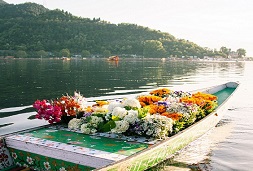
SENIOR CITZENS

SUPERSIZED TRAVELLER

FAMILY HOLIDAYS
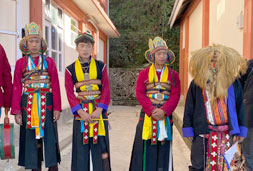
INDIAN TRIBAL CIRCUIT
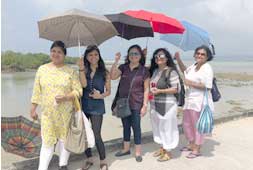
WOMEN ONLY HOLIDAYS
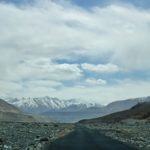
unwto tourism highlights 2022
Un tourism | bringing the world closer.
Unwto 2021: a year in review, 2021: tourism united, resilient and determined.
2021 has been a year of learning and adapting for tourism. It has proven that only by working together can the sector overcome challenges and embrace opportunities.
Gathering the global tourism community and developing concrete actions, UNWTO has led tourism’s response with the vision of not only restarting, but doing so in a more inclusive, innovative and sustainable way.

January - March
As global tourism faced up to a second year of unprecedented crisis , UNWTO began 2021 by counting the cost so far . At the same time, however, the emergence of vaccines brought hope . The Global Tourism Crisis Committee met to explore what this meant for safe travel and the restart of tourism, while the announcement of the winners of the UNWTO Global Start-up Competition recognized the role culture and creativity will play in tourism’s restart and recovery .

April - June
Collaboration and innovation were the focusat the start of the second quarter. UNWTO partnered with IATA on a new Destination Tracker to give both tourists and destinations clear, impartial and trusted advice. And a new Start-up Competition was launched to find the best ideas for accelerating rural development through tourism. In May, the launch of the Best Tourism Villages by UNWTO generated significant interest from Members in every global region.

July - September
As destinations in Europe welcomed tourists back for the peak summer season, UNWTO highlighted the role of digital solutions for the safe restart of the sector. But UNWTO also looked ahead, to a more sustainable future , working with key partners to reduce plastic waste and consumption across every part of the sector. Together, we celebrated World Tourism Day around the theme of Tourism for Inclusive Growth, a message of solidarity and determination that was echoed on a global scale.

October - December
The final quarter of 2021 began with cautious optimism as UNWTO’s Barometer showed signs of improvement in tourist arrival numbers during the summer season in the northern hemisphere. A new partnership with Netflix will bring the message of tourism as a driver of opportunity to a massive global audience, while in November, UNWTO was tourism’s voice at COP26 and signatories to the landmark Glasgow Declaration keep growing. Finally, against the backdrop of the UNWTO General Assembly , the programme of work for the coming biennium was approved and 77% of Members voted to secure a second mandate for the Secretary-General from 2022-2025.
Growing and Moving Forward
UNWTO brings together political leaders from across the globe to deliver a strong, coordinated response. Governments, destinations, fellow UN agencies and international organizations met at key international events joining efforts to rethink tourism. Institutional coordination has proven crucial to find the solutions that build a smarter, greener and safer tourism.
Leaving Nobody Behind
The pledge to ‘ leave nobody behind ’ means nobody should miss out : Not now as we support the sector in the face of crisis, and not in the future as tourism starts again. Tourism is a proven driver of equality and opportunity. And that’s why we turn words into actions, delivering guidelines and action plans , to ensure everyone can enjoy the opportunities tourism brings.
A Shared Vision
Advancing the transformation of the tourism sector , partnerships are the only way forward. In 2021, UNWTO signed agreements with international organizations and the private sector to step our vision for the future of tourism: innovation , education , sustainability , green investment , rural development.
From business as usual to Covid-19
Looking to the future
- Regional Support Office for Asia and the Pacific (RSOAP)
- Member States in Asia and the Pacific
- SUSTAINABLE TOURISM OBSERVATORIES (INSTO)

World Tourism Barometer: September 2022
UNWTO updates World Tourism Barometer and reports international tourism back to 60% of pre-pandemic levels from January to July 2022

Below are excerpts from the September 2022 release of the UNWTO Tourism Barometer :
- The steady recovery reflects strong pent-up demand for international travel, especially in the months of June and July which are part of the Northern Hemisphere summer season. The easing or lifting of travel restrictions in an increasing number of countries also contributed to boost results.
- International tourist arrivals almost tripled (+172%) in January-July 2022 compared to the same period of 2021. Numbers climbed from -64% in January 2022 (versus 2019) to -28% in July, the strongest month since the start of the pandemic.
- Asia and the Pacific (+165%) saw arrivals more than double in the first seven months of 2022, though they remained 86% below 2019 levels.
- The ongoing recovery can also be seen in outbound tourism spending from major source markets. Expenditure from France was at -12% in January-July 2022 compared to 2019 while spending from Germany stood at -14%. International tourism spending remained at -10% in Belgium, -23% in Italy and -26% in the United States.
- The uncertain economic environment seems to have reversed prospects for a return to pre-pandemic levels in the near term. 61% of UNWTO Panel of Experts now see a potential return of international arrivals to 2019 levels in 2024 or later while those indicating a return to pre-pandemic levels in 2023 has diminished (27%) compared to the May survey (48%).

Know more about the global tourism sector performance from January to July 2022 by checking the UNWTO World Tourism Barometer Volume 20, Issue 5 .
LEAVE A REPLY Cancel reply
Save my name, email, and website in this browser for the next time I comment.
Regional Support Office in Asia and the Pacific (RSOAP)
Rsoap a to z.
- Sustainable Tourism Observatories(INSTO)
UNWTO A to Z
- About UNWTO
- Affiliate Members
- Member States
- Tourism in the 2030 Agenda
- World Tourism Day
- Technical Cooperation
- ASIA AND THE PACIFIC
- MIDDLE EAST
- RESOURCES/SERVICES
- Sustainable Development of Tourism
- Ethics, Culture and Social Responsibility
- Market Intelligence
- Tourism Data Dashboard
- Publications
- UNWTO Academy
Partners links

© UNWTO Regional Support Office for Asia and the Pacific (RSOAP)
- Course Catalog

TOURISM TRENDS 2022
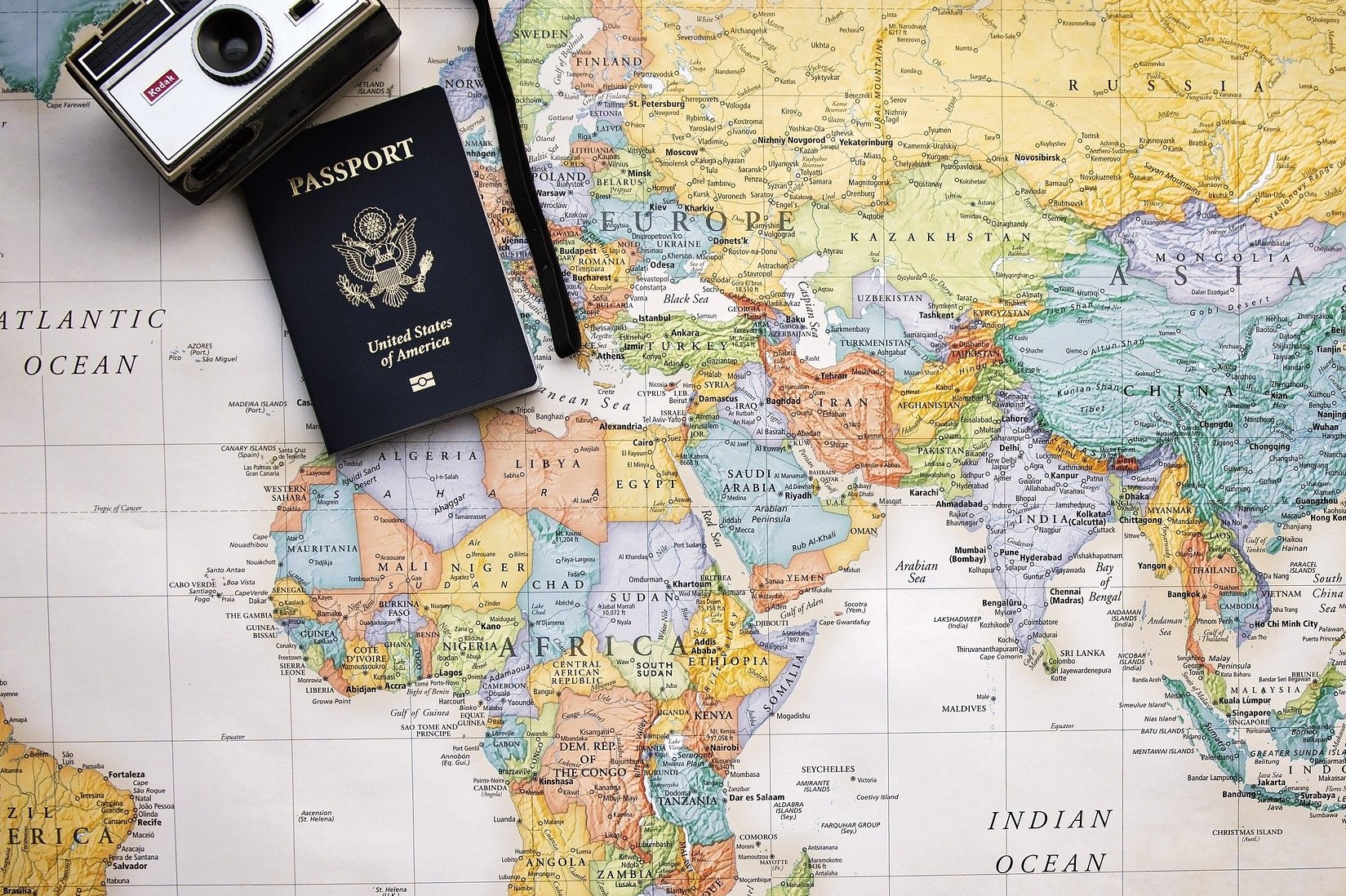
11 Aug TOURISM TRENDS 2022
The situation for tourism remains rather unusual as a result of the ongoing COVID-19 pandemic.
The crisis has marked a significant change for everyone, and above all for tourism, one of sectors hit hardest by the virus. 2020 was the year in which international tourism came to a near-complete standstill, and the only alternatives were domestic and local tourism.
2021 has seen some improvements, but only in a very subtle way as restrictions are still in place and many countries keep their borders fully or partially closed.
It is difficult to make an estimate for 2022 as it is not known how the pandemic will evolve. However, it is possible to talk about the new tourism trends that are likely to emerge over the coming year: – International travel with restrictions still maintained by both destinations and airlines in order to offer 100% security to the consumer.
– Reinforcement of COVID-19 testing; two years after the pandemic, COVID testing will still be in place as a preventive measure. – Conscious travel will be advocated. Travel to more distant destinations, but with prolonged durations of stay, as consumers look to enjoy as much of each place they visit as possible. – Green travel. Climate change is a problem that is present and growing. Consumers now are much more responsible and aware of the reality they live in on daily basis.
– A new trend is the “ed-ventures”. It is about combining education and holidays for the youngest members of the family. While adults may need to telework or attend meetings, their children can be doing workshops and learning in a playful way.
- Client log in
Metallurgicheskii Zavod Electrostal AO (Russia)
In 1993 "Elektrostal" was transformed into an open joint stock company. The factory occupies a leading position among the manufacturers of high quality steel. The plant is a producer of high-temperature nickel alloys in a wide variety. It has a unique set of metallurgical equipment: open induction and arc furnaces, furnace steel processing unit, vacuum induction, vacuum- arc furnaces and others. The factory has implemented and certified quality management system ISO 9000, received international certificates for all products. Elektrostal today is a major supplier in Russia starting blanks for the production of blades, discs and rolls for gas turbine engines. Among them are companies in the aerospace industry, defense plants, and energy complex, automotive, mechanical engineering and instrument-making plants.
Headquarters Ulitsa Zheleznodorozhnaya, 1 Elektrostal; Moscow Oblast; Postal Code: 144002
Contact Details: Purchase the Metallurgicheskii Zavod Electrostal AO report to view the information.
Website: http://elsteel.ru
EMIS company profiles are part of a larger information service which combines company, industry and country data and analysis for over 145 emerging markets.
To view more information, Request a demonstration of the EMIS service

Turn Your Curiosity Into Discovery
Latest facts.
11 Facts About National Numeracy Day May 22nd
9 Facts About Workers Memorial Day April 28th
40 facts about elektrostal.
Written by Lanette Mayes
Modified & Updated: 02 Mar 2024
Reviewed by Jessica Corbett

Elektrostal is a vibrant city located in the Moscow Oblast region of Russia. With a rich history, stunning architecture, and a thriving community, Elektrostal is a city that has much to offer. Whether you are a history buff, nature enthusiast, or simply curious about different cultures, Elektrostal is sure to captivate you.
This article will provide you with 40 fascinating facts about Elektrostal, giving you a better understanding of why this city is worth exploring. From its origins as an industrial hub to its modern-day charm, we will delve into the various aspects that make Elektrostal a unique and must-visit destination.
So, join us as we uncover the hidden treasures of Elektrostal and discover what makes this city a true gem in the heart of Russia.
Key Takeaways:
- Elektrostal, known as the “Motor City of Russia,” is a vibrant and growing city with a rich industrial history, offering diverse cultural experiences and a strong commitment to environmental sustainability.
- With its convenient location near Moscow, Elektrostal provides a picturesque landscape, vibrant nightlife, and a range of recreational activities, making it an ideal destination for residents and visitors alike.
Known as the “Motor City of Russia.”
Elektrostal, a city located in the Moscow Oblast region of Russia, earned the nickname “Motor City” due to its significant involvement in the automotive industry.
Home to the Elektrostal Metallurgical Plant.
Elektrostal is renowned for its metallurgical plant, which has been producing high-quality steel and alloys since its establishment in 1916.
Boasts a rich industrial heritage.
Elektrostal has a long history of industrial development, contributing to the growth and progress of the region.
Founded in 1916.
The city of Elektrostal was founded in 1916 as a result of the construction of the Elektrostal Metallurgical Plant.
Located approximately 50 kilometers east of Moscow.
Elektrostal is situated in close proximity to the Russian capital, making it easily accessible for both residents and visitors.
Known for its vibrant cultural scene.
Elektrostal is home to several cultural institutions, including museums, theaters, and art galleries that showcase the city’s rich artistic heritage.
A popular destination for nature lovers.
Surrounded by picturesque landscapes and forests, Elektrostal offers ample opportunities for outdoor activities such as hiking, camping, and birdwatching.
Hosts the annual Elektrostal City Day celebrations.
Every year, Elektrostal organizes festive events and activities to celebrate its founding, bringing together residents and visitors in a spirit of unity and joy.
Has a population of approximately 160,000 people.
Elektrostal is home to a diverse and vibrant community of around 160,000 residents, contributing to its dynamic atmosphere.
Boasts excellent education facilities.
The city is known for its well-established educational institutions, providing quality education to students of all ages.
A center for scientific research and innovation.
Elektrostal serves as an important hub for scientific research, particularly in the fields of metallurgy, materials science, and engineering.
Surrounded by picturesque lakes.
The city is blessed with numerous beautiful lakes, offering scenic views and recreational opportunities for locals and visitors alike.
Well-connected transportation system.
Elektrostal benefits from an efficient transportation network, including highways, railways, and public transportation options, ensuring convenient travel within and beyond the city.
Famous for its traditional Russian cuisine.
Food enthusiasts can indulge in authentic Russian dishes at numerous restaurants and cafes scattered throughout Elektrostal.
Home to notable architectural landmarks.
Elektrostal boasts impressive architecture, including the Church of the Transfiguration of the Lord and the Elektrostal Palace of Culture.
Offers a wide range of recreational facilities.
Residents and visitors can enjoy various recreational activities, such as sports complexes, swimming pools, and fitness centers, enhancing the overall quality of life.
Provides a high standard of healthcare.
Elektrostal is equipped with modern medical facilities, ensuring residents have access to quality healthcare services.
Home to the Elektrostal History Museum.
The Elektrostal History Museum showcases the city’s fascinating past through exhibitions and displays.
A hub for sports enthusiasts.
Elektrostal is passionate about sports, with numerous stadiums, arenas, and sports clubs offering opportunities for athletes and spectators.
Celebrates diverse cultural festivals.
Throughout the year, Elektrostal hosts a variety of cultural festivals, celebrating different ethnicities, traditions, and art forms.
Electric power played a significant role in its early development.
Elektrostal owes its name and initial growth to the establishment of electric power stations and the utilization of electricity in the industrial sector.
Boasts a thriving economy.
The city’s strong industrial base, coupled with its strategic location near Moscow, has contributed to Elektrostal’s prosperous economic status.
Houses the Elektrostal Drama Theater.
The Elektrostal Drama Theater is a cultural centerpiece, attracting theater enthusiasts from far and wide.
Popular destination for winter sports.
Elektrostal’s proximity to ski resorts and winter sport facilities makes it a favorite destination for skiing, snowboarding, and other winter activities.
Promotes environmental sustainability.
Elektrostal prioritizes environmental protection and sustainability, implementing initiatives to reduce pollution and preserve natural resources.
Home to renowned educational institutions.
Elektrostal is known for its prestigious schools and universities, offering a wide range of academic programs to students.
Committed to cultural preservation.
The city values its cultural heritage and takes active steps to preserve and promote traditional customs, crafts, and arts.
Hosts an annual International Film Festival.
The Elektrostal International Film Festival attracts filmmakers and cinema enthusiasts from around the world, showcasing a diverse range of films.
Encourages entrepreneurship and innovation.
Elektrostal supports aspiring entrepreneurs and fosters a culture of innovation, providing opportunities for startups and business development.
Offers a range of housing options.
Elektrostal provides diverse housing options, including apartments, houses, and residential complexes, catering to different lifestyles and budgets.
Home to notable sports teams.
Elektrostal is proud of its sports legacy, with several successful sports teams competing at regional and national levels.
Boasts a vibrant nightlife scene.
Residents and visitors can enjoy a lively nightlife in Elektrostal, with numerous bars, clubs, and entertainment venues.
Promotes cultural exchange and international relations.
Elektrostal actively engages in international partnerships, cultural exchanges, and diplomatic collaborations to foster global connections.
Surrounded by beautiful nature reserves.
Nearby nature reserves, such as the Barybino Forest and Luchinskoye Lake, offer opportunities for nature enthusiasts to explore and appreciate the region’s biodiversity.
Commemorates historical events.
The city pays tribute to significant historical events through memorials, monuments, and exhibitions, ensuring the preservation of collective memory.
Promotes sports and youth development.
Elektrostal invests in sports infrastructure and programs to encourage youth participation, health, and physical fitness.
Hosts annual cultural and artistic festivals.
Throughout the year, Elektrostal celebrates its cultural diversity through festivals dedicated to music, dance, art, and theater.
Provides a picturesque landscape for photography enthusiasts.
The city’s scenic beauty, architectural landmarks, and natural surroundings make it a paradise for photographers.
Connects to Moscow via a direct train line.
The convenient train connection between Elektrostal and Moscow makes commuting between the two cities effortless.
A city with a bright future.
Elektrostal continues to grow and develop, aiming to become a model city in terms of infrastructure, sustainability, and quality of life for its residents.
In conclusion, Elektrostal is a fascinating city with a rich history and a vibrant present. From its origins as a center of steel production to its modern-day status as a hub for education and industry, Elektrostal has plenty to offer both residents and visitors. With its beautiful parks, cultural attractions, and proximity to Moscow, there is no shortage of things to see and do in this dynamic city. Whether you’re interested in exploring its historical landmarks, enjoying outdoor activities, or immersing yourself in the local culture, Elektrostal has something for everyone. So, next time you find yourself in the Moscow region, don’t miss the opportunity to discover the hidden gems of Elektrostal.
Q: What is the population of Elektrostal?
A: As of the latest data, the population of Elektrostal is approximately XXXX.
Q: How far is Elektrostal from Moscow?
A: Elektrostal is located approximately XX kilometers away from Moscow.
Q: Are there any famous landmarks in Elektrostal?
A: Yes, Elektrostal is home to several notable landmarks, including XXXX and XXXX.
Q: What industries are prominent in Elektrostal?
A: Elektrostal is known for its steel production industry and is also a center for engineering and manufacturing.
Q: Are there any universities or educational institutions in Elektrostal?
A: Yes, Elektrostal is home to XXXX University and several other educational institutions.
Q: What are some popular outdoor activities in Elektrostal?
A: Elektrostal offers several outdoor activities, such as hiking, cycling, and picnicking in its beautiful parks.
Q: Is Elektrostal well-connected in terms of transportation?
A: Yes, Elektrostal has good transportation links, including trains and buses, making it easily accessible from nearby cities.
Q: Are there any annual events or festivals in Elektrostal?
A: Yes, Elektrostal hosts various events and festivals throughout the year, including XXXX and XXXX.
Was this page helpful?
Our commitment to delivering trustworthy and engaging content is at the heart of what we do. Each fact on our site is contributed by real users like you, bringing a wealth of diverse insights and information. To ensure the highest standards of accuracy and reliability, our dedicated editors meticulously review each submission. This process guarantees that the facts we share are not only fascinating but also credible. Trust in our commitment to quality and authenticity as you explore and learn with us.
Share this Fact:

- Victor Mukhin

Victor M. Mukhin was born in 1946 in the town of Orsk, Russia. In 1970 he graduated the Technological Institute in Leningrad. Victor M. Mukhin was directed to work to the scientific-industrial organization "Neorganika" (Elektrostal, Moscow region) where he is working during 47 years, at present as the head of the laboratory of carbon sorbents. Victor M. Mukhin defended a Ph. D. thesis and a doctoral thesis at the Mendeleev University of Chemical Technology of Russia (in 1979 and 1997 accordingly). Professor of Mendeleev University of Chemical Technology of Russia. Scientific interests: production, investigation and application of active carbons, technological and ecological carbon-adsorptive processes, environmental protection, production of ecologically clean food.
Title : Active carbons as nanoporous materials for solving of environmental problems
Quick links.
- Conference Brochure
- Tentative Program

2022 has been the year to rethink tourism. Countries around the world turned UNWTO's vision for a greener, smarter and more inclusive sector into real action. 2020 showed the relevance of tourism for sustainable development. 2021 laid the foundations for the transformation of the sector. In 2022, we made it happen. 2022 began on a positive note.
According to the latest UNWTO World Tourism Barometer, international tourism saw a strong rebound in the first five months of 2022, with almost 250 million international arrivals recorded. This compares to 77 million arrivals from January to May 2021 and means that the sector has recovered almost half (46%) of pre-pandemic 2019 levels. UN ...
International Tourism Highlights, 2023 Edition - The Impact of COVID-19 on Tourism (2020-2022) ISBN (printed version): 978-92-844-2497-9 ISBN (electronic version): 978-92-844-2498-6 DOI: 10.18111/9789284424986 Published by the World Tourism Organization (UNWTO), Madrid, Spain First published: September 2023 Revised and updated: October 2023
Find out the latest updates from the UNWTO on tourism trends, challenges and opportunities in 2022 and beyond. Learn about the UNWTO's activities, projects and partnerships in various regions and topics, such as sustainable tourism, gastronomy, investment and education.
International Tourism and COVID-19. Export revenues from international tourism dropped 62% in 2020 and 59% in 2021, versus 2019 (real terms) and then rebounded in 2022, remaining 34% below pre-pandemic levels. The total loss in export revenues from tourism amounts to USD 2.6 trillion for that three-year period. Go to Dashboard.
According to the latest UNWTO World Tourism Barometer, international tourist arrivals almost tripled in January to July 2022 (+172%) compared to the same period of 2021. This means t he sector recovered almost 60% of pre-pandemic levels. The steady recovery reflects strong pent-up demand for international travel as well as the easing or lifting ...
The time is now to seize this opportunity to rethink how we do tourism. The official World Tourism Day celebration will be held in Bali, Indonesia, on 27 September, highlighting the shift towards tourism being recognized as a crucial pillar of development. Wonderful Indonesia - Witness the 42nd World Tourism Day 2022 in Bali, Indonesia!
In terms of tourist numbers, the year 2022 is expected to close with over 900 million international arrivals, despite growing challenges pointing to a softening of the recovery pace. International tourist arrivals: 2020, 2021 and Scenarios for 2022 (monthly change over 2019,%) Source UNWTO World Tourism Barometer: November 2022 Press Release.
January - March. As global tourism faced up to a second year of unprecedented crisis, UNWTO began 2021 by counting the cost so far.At the same time, however, the emergence of vaccines brought hope.The Global Tourism Crisis Committee met to explore what this meant for safe travel and the restart of tourism, while the announcement of the winners of the UNWTO Global Start-up Competition ...
Below are excerpts from the latest World Tourism Barometer May 2022 issue: According to the latest UNWTO World Tourism Barometer, international tourism saw a 182% year-on-year increase in January-March 2022, with destinations worldwide welcoming an estimated 117 million international arrivals compared to 41 million in Q1 2021.
The UNWTO Elibrary is an online service from the World Tourism Organization (UNWTO) with a broad coverage of tourism and related subject areas. ... International Tourism Highlights, 2023 Edition - The Impact of COVID-19 on Tourism (2020-2022) Revised and updated, October 2023. Released: December 2023.
The 7th UNWTO World Forum on Gastronomy Tourism will be held from Monday, December 12 to Thursday, December 15, 2022 (4 days).
The economic contribution of tourism (tourism direct gross domestic product) is estimated at US$1.9 trillion in 2021, above the US$1.6 trillion in 2020, but still well below the pre-pandemic value of US$ 3.5 trillion. The latest UNWTO Panel of Experts survey indicates that 61% of tourism professionals expect better performance in 2022 than in 2021.
Below are relevant points to the July 2022 World Tourism Barometer: Nearly 250 million international trips were recorded worldwide in the first five months of the year, more than three times the number of arrivals recorded in the same period of 2021 (77 million). Robust performance is also reflected in hotel occupancy rates.
2022-10-28. Below are excerpts from the September 2022 release of the UNWTO Tourism Barometer: The steady recovery reflects strong pent-up demand for international travel, especially in the months of June and July which are part of the Northern Hemisphere summer season. The easing or lifting of travel restrictions in an increasing number of ...
International tourism continues to outpace the global economy. 2. Driven by a relatively strong global economy, a growing middle class in emerging economies, technological advances, new business models, affordable travel costs and visa facilitation, international tourist arrivals grew 5% in 2018 to reach the 1.4 billion mark.
UNWTO Tourism Academy | TOURISM TRENDS 2022. The situation for tourism remains rather unusual as a result of the ongoing COVID-19 pandemic. The crisis has marked a significant change for everyone, and above all for tourism, one of sectors hit hardest by the virus. 2020 was the year in which international tourism came to a near-complete ...
International Tourism Highlights, 2023 Edition - The Impact of COVID-19 on Tourism (2020-2022) Revised and updated, October 2023 Published: December 2023 Pages: 32
International Tourism Highlights, 2020 Edition. Published: January 2021 Pages: 23. eISBN: 978-92-844-2245-6 | ISBN: 978-92-844-2244-9. Abstract: 2019 was another year of strong growth, though international arrivals grew below the exceptional rates seen in 2017 (+7%) and 2018 (+6%). Demand was somewhat weaker for travel to advanced economy ...
Main Activities: Iron and Steel Mills and Ferroalloy Manufacturing | Nonferrous Metal (except Copper and Aluminum) Rolling, Drawing, and Extruding. Full name: Metallurgicheskii Zavod Electrostal AO Profile Updated: February 22, 2024. Buy our report for this company USD 29.95 Most recent financial data: 2022 Available in: English & Russian ...
40 Facts About Elektrostal. Elektrostal is a vibrant city located in the Moscow Oblast region of Russia. With a rich history, stunning architecture, and a thriving community, Elektrostal is a city that has much to offer. Whether you are a history buff, nature enthusiast, or simply curious about different cultures, Elektrostal is sure to ...
Catalysis Conference is a networking event covering all topics in catalysis, chemistry, chemical engineering and technology during October 19-21, 2017 in Las Vegas, USA. Well noted as well attended meeting among all other annual catalysis conferences 2018, chemical engineering conferences 2018 and chemistry webinars.
In the city of Elektrostal in Russia, a drone attack occurred. It's reported that no one was injured as a result of the incident. Additional details, including the particulars of the attack, potential motives or responsible parties, have not been provided. However, the fact that a drone was used as a means of attack underscores
Russia Travel Blog | All about Russia in English
- About our blog
- RussiaTrek.org
Sidebar →
- Architecture
- Entertainment
- RussiaTrek.org News

- Send us a tip with a message
- Support RussiaTrek.org
- Travel Guide to Ukraine
- Comments RSS
← Sidebar
The trains and stations of the Moscow Metro
2 Comments · Posted by Alex Smirnov in Cities , Travel , Video
The Moscow Metro is the third most intensive subway system in the world after Tokyo and Seoul subways. The first line was opened on May 15, 1935. Since 1955, the metro has the name of V.I. Lenin.
The system consists of 12 lines with a total length of 305.7 km. Forty four stations are recognized cultural heritage. The largest passenger traffic is in rush hours from 8:00 to 9:00 and from 18:00 to 19:00.
Cellular communication is available on most of the stations of the Moscow Metro. In March 2012, a free Wi-Fi appeared in the Circle Line train. The Moscow Metro is open to passengers from 5:20 to 01:00. The average interval between trains is 2.5 minutes.
The fare is paid by using contactless tickets and contactless smart cards, the passes to the stations are controlled by automatic turnstiles. Ticket offices and ticket vending machines can be found in station vestibules.
Tags: Moscow city
You might also like:

The bridge over Zolotoy Rog Bay in Vladivostok
The views of St. Petersburg from the TV tower >>
Tomás · August 27, 2012 at 11:34 pm
The Moscow metro stations are the best That I know, cars do not.
Alberto Calvo · September 25, 2016 at 8:57 pm
Great videos! Moscow Metro is just spectacular. I actually visited Moscow myself quite recently and wrote a post about my top 7 stations, please check it out and let me know what you think! :)
http://www.arwtravels.com/blog/moscow-metro-top-7-stations-you-cant-miss
Leave a Reply
XHTML: You can use these tags: <a href="" title=""> <abbr title=""> <acronym title=""> <b> <blockquote cite=""> <cite> <code> <del datetime=""> <em> <i> <q cite=""> <s> <strike> <strong>
- February 2024
- January 2024
- December 2023
- November 2023
- October 2023
- September 2023
- August 2023
km travel chesterfield 2024 brochure prices
This is our KM Travel Tour Operators page, we have listed the full address of KM Travel as well as phone numbers and websites. KM Travel is in Chesterfield, KM Travel may offer holiday tours, sightseeing tours, and general city tours in Chesterfield.
If you have used KM Travel before be sure to leave your own comment or rating on the city tour or holiday tour that you went on so other poeple wishing to use this company can read fair and honest reviews before the book there holiday with KM Travel. Please remember that KM Travel may offer much more that just UK holiday tours, UK Coach Tours and city tours so remember to contact the travel agents company using the details below to find out more information.
Latest KM Travel Reviews

- Transportation (Chesterfield)
- KM Travel Chesterfield
Chesterfield, United Kingdom
Related places.
- Get directions
- Photos page
QR code, vCard

Activate map
Business hours
Reviews of km travel chesterfield.
- Things to Do
- Restaurants
- Holiday Rentals
- Travel Stories
- Add a Place
- Travel Forum
- Travellers' Choice
- Help Centre
Lovely holiday - KM British & European Coach Holiday
- Europe
- United Kingdom (UK)
- England
- Yorkshire
- South Yorkshire
- Barnsley
- Barnsley - Things to Do
- KM British & European Coach Holiday
Brilliant holiday to Torquay, tinsel & turkey 20 th November to Belgrave Sands hotel. The hotel was... read more
Thanks to all at KM TRAVEL especially our driver courier Matt who made the trip more enjoyable and... read more
Trains Moscow to Elektrostal: Times, Prices and Tickets
- Train Times
- Seasonality
- Accommodations
Moscow to Elektrostal by train
The journey from Moscow to Elektrostal by train is 32.44 mi and takes 2 hr 7 min. There are 71 connections per day, with the first departure at 12:15 AM and the last at 11:46 PM. It is possible to travel from Moscow to Elektrostal by train for as little as or as much as . The best price for this journey is .
Get from Moscow to Elektrostal with Virail
Virail's search tool will provide you with the options you need when you want to go from Moscow to Elektrostal. All you need to do is enter the dates of your planned journey, and let us take care of everything else. Our engine does the hard work, searching through thousands of routes offered by our trusted travel partners to show you options for traveling by train, bus, plane, or carpool. You can filter the results to suit your needs. There are a number of filtering options, including price, one-way or round trip, departure or arrival time, duration of journey, or number of connections. Soon you'll find the best choice for your journey. When you're ready, Virail will transfer you to the provider's website to complete the booking. No matter where you're going, get there with Virail.
How can I find the cheapest train tickets to get from Moscow to Elektrostal?
Prices will vary when you travel from Moscow to Elektrostal. On average, though, you'll pay about for a train ticket. You can find train tickets for prices as low as , but it may require some flexibility with your travel plans. If you're looking for a low price, you may need to prepare to spend more time in transit. You can also often find cheaper train tickets at particular times of day, or on certain days of the week. Of course, ticket prices often change during the year, too; expect to pay more in peak season. For the lowest prices, it's usually best to make your reservation in advance. Be careful, though, as many providers do not offer refunds or exchanges on their cheapest train tickets. Unfortunately, no price was found for your trip from Moscow to Elektrostal. Selecting a new departure or arrival city, without dramatically changing your itinerary could help you find price results. Prices will vary when you travel from Moscow to Elektrostal. On average, though, you'll pay about for a train ticket. If you're looking for a low price, you may need to prepare to spend more time in transit. You can also often find cheaper train tickets at particular times of day, or on certain days of the week. Of course, ticket prices often change during the year, too; expect to pay more in peak season. For the lowest prices, it's usually best to make your reservation in advance. Be careful, though, as many providers do not offer refunds or exchanges on their cheapest train tickets.
How long does it take to get from Moscow to Elektrostal by train?
The journey between Moscow and Elektrostal by train is approximately 32.44 mi. It will take you more or less 2 hr 7 min to complete this journey. This average figure does not take into account any delays that might arise on your route in exceptional circumstances. If you are planning to make a connection or operating on a tight schedule, give yourself plenty of time. The distance between Moscow and Elektrostal is around 32.44 mi. Depending on the exact route and provider you travel with, your journey time can vary. On average, this journey will take approximately 2 hr 7 min. However, the fastest routes between Moscow and Elektrostal take 1 hr 3 min. If a fast journey is a priority for you when traveling, look out for express services that may get you there faster. Some flexibility may be necessary when booking. Often, these services only leave at particular times of day - or even on certain days of the week. You may also find a faster journey by taking an indirect route and connecting in another station along the way.
How many journeys from Moscow to Elektrostal are there every day?
On average, there are 71 daily departures from Moscow to Elektrostal. However, there may be more or less on different days. Providers' timetables can change on certain days of the week or public holidays, and many also vary at particular times of year. Some providers change their schedules during the summer season, for example. At very busy times, there may be up to departures each day. The providers that travel along this route include , and each operates according to their own specific schedules. As a traveler, you may prefer a direct journey, or you may not mind making changes and connections. If you have heavy suitcases, a direct journey could be best; otherwise, you might be able to save money and enjoy more flexibility by making a change along the way. Every day, there are an average of 18 departures from Moscow which travel directly to Elektrostal. There are 53 journeys with one change or more. Unfortunately, no connection was found for your trip from Moscow to Elektrostal. Selecting a new departure or arrival city, without dramatically changing your itinerary could help you find connections.
Book in advance and save
If you're looking for the best deal for your trip from Moscow to Elektrostal, booking train tickets in advance is a great way to save money, but keep in mind that advance tickets are usually not available until 3 months before your travel date.
Stay flexible with your travel time and explore off-peak journeys
Planning your trips around off-peak travel times not only means that you'll be able to avoid the crowds, but can also end up saving you money. Being flexible with your schedule and considering alternative routes or times will significantly impact the amount of money you spend on getting from Moscow to Elektrostal.
Always check special offers
Checking on the latest deals can help save a lot of money, making it worth taking the time to browse and compare prices. So make sure you get the best deal on your ticket and take advantage of special fares for children, youth and seniors as well as discounts for groups.
Unlock the potential of slower trains or connecting trains
If you're planning a trip with some flexible time, why not opt for the scenic route? Taking slower trains or connecting trains that make more stops may save you money on your ticket – definitely worth considering if it fits in your schedule.
Best time to book cheap train tickets from Moscow to Elektrostal
The cheapest Moscow - Elektrostal train tickets can be found for as low as $35.01 if you’re lucky, or $54.00 on average. The most expensive ticket can cost as much as $77.49.
Find the best day to travel to Elektrostal by train
When travelling to Elektrostal by train, if you want to avoid crowds you can check how frequently our customers are travelling in the next 30-days using the graph below. On average, the peak hours to travel are between 6:30am and 9am in the morning, or between 4pm and 7pm in the evening. Please keep this in mind when travelling to your point of departure as you may need some extra time to arrive, particularly in big cities!
Moscow to Elektrostal CO2 Emissions by Train

Anything we can improve?
Frequently Asked Questions
Go local from moscow, trending routes, weekend getaways from moscow, international routes from moscow and nearby areas, other destinations from moscow, other popular routes.
Na Ulitse Yalagina 13B Apartments
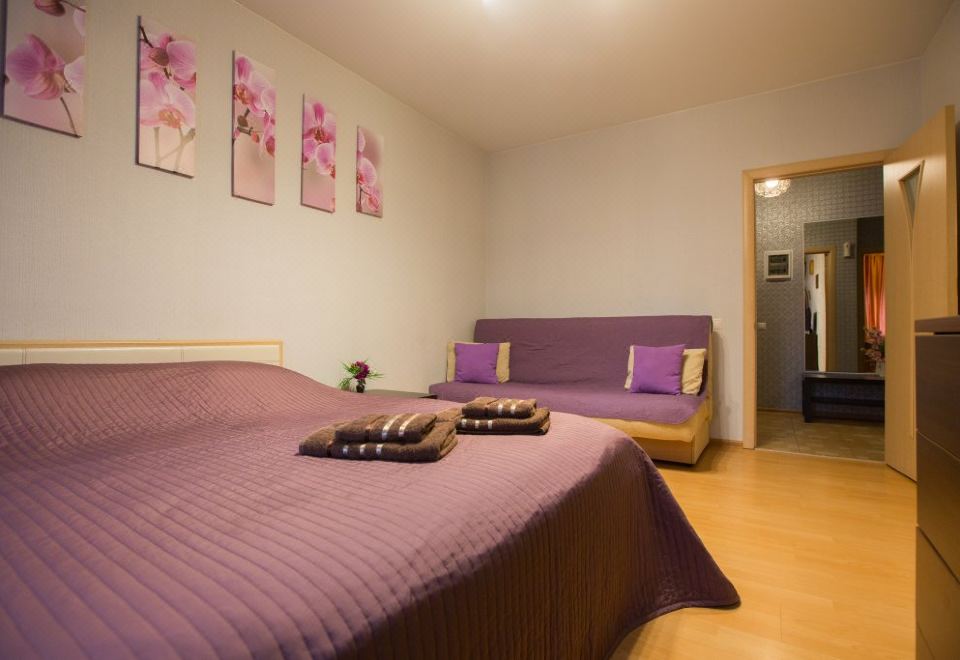
Trending Questions
Property policies, frequently asked questions, how much does it cost to stay at na ulitse yalagina 13b apartments, what are the check-in and check-out times at na ulitse yalagina 13b apartments, does na ulitse yalagina 13b apartments provide airport transfer services, what amenities and services does na ulitse yalagina 13b apartments have, does na ulitse yalagina 13b apartments have a swimming pool, does na ulitse yalagina 13b apartments have fitness amenities, does na ulitse yalagina 13b apartments provide wi-fi, does na ulitse yalagina 13b apartments have non-smoking rooms, does na ulitse yalagina 13b apartments have a restaurant, is parking available at na ulitse yalagina 13b apartments, popular hotels, popular attractions, explore more.
Expedia Rewards is now One Key™
Elektrostal, visit elektrostal, check elektrostal hotel availability, popular places to visit.
- Electrostal History and Art Museum
You can spend time exploring the galleries in Electrostal History and Art Museum in Elektrostal. Take in the museums while you're in the area.
- Cities near Elektrostal

- Places of interest
- Yuri Gagarin Cosmonaut Training Center
- Peter the Great Military Academy
- Central Museum of the Air Forces at Monino
- History of Russian Scarfs and Shawls Museum
- Balashikha Arena
- Balashikha Museum of History and Local Lore
- Bykovo Manor
- Pekhorka Park
- Ramenskii History and Art Museum
- Malenky Puppet Theater
- Drama Theatre BOOM
- Likino Dulevo Museum of Local Lore
- Noginsk Museum and Exhibition Center
- Pavlovsky Posad Museum of Art and History
- Saturn Stadium
- Fairy Tale Children's Model Puppet Theater
- Fifth House Gallery
- Church of Vladimir
- Malakhovka Museum of History and Culture
- Orekhovo Zuevsky City Exhibition Hall
Destinations in May
Destinations in 2024.
Please note prices are based on two persons sharing a twin/double room. Single room supplements may apply, please call check single availability/price.
Comments are closed.
- Destinations
- Hotel Information
- Private hire
- Special offers / Late availability
- Travel Insurance
- Employment Opportunities

NEW CHRISTMAS TOUR 2024 - Bournemouth - Norfolk Royale Hotel - BROCHURE ADDITION . 2024 EUROPEAN HOLIDAYS - Early release - ITALY - Lake Garda / Alassio Click here to download our 2024 Brochure All Our Holidays Include In The Price: Free Door to Door Taxi ( Subject to Area ) ~ Luxury Coach Travel ~ Reserved Coach Seats . Personally Selected ...
www.kmchesterfield.co.uk
KM Travel of Barnsley, South Yorkshire. Request a brochure by: Calling: 01226 245564 email: [email protected] . download: click here to download the 2024 Tour Brochure.
KM Travel is in Chesterfield, KM Travel may offer holiday tours, sightseeing tours, and general city tours in Chesterfield. If you have used KM Travel before be sure to leave your own comment or rating on the city tour or holiday tour that you went on so other poeple wishing to use this company can read fair and honest reviews before the book ...
What people are saying. " HOLIDAY TO BLACKPOOL ". Oct 2023. Thanks to all at KM TRAVEL especially our driver courier Matt who made the trip more enjoyable and a credit to the co... " Lovely place enjoyed it clean need a bit of investment there ". Aug 2022. Stayed at ilfracombe Devon 14 to 20 Aug the coach was lovely our driver Tony was ...
Reviews, contact details and business hours of KM Travel Chesterfield at 27 Stephenson Place, Chesterfield, Derbyshire. Check out nearby places on a map. Write a review. Log in. ... 21:03 Tuesday, 23 April 2024: Business hours. Monday: 9:00 am - 4:30 pm: Tuesday: 9:00 am - 4:30 pm: Wednesday: 9:00 am - 4:30 pm: Thursday: 9:00 am - 4:30 ...
KM Travel of Barnsley, South Yorkshire. Tel: (01226) 245564 [email protected] . Home. Booking Guide Request Brochure Customer Information Contact Us. ... Our 2024 British Coach Holiday Brochure is now available to download and available shortly from our Market Street office in paper form.
5. £339. Nil. Please note prices are based on two persons sharing a twin/double room. Single room supplements may apply, please call check single availability/price. Price Includes: * Luxury Coach Travel * Local Departure Points. * En-suite bedrooms * Excursions. * Half Board Accommodation.
Page List. (Click on the page required to be linked with that page in the brochure) Page 1 - Front cover. Page 2 - Introduction. Page 3 - Contact information. Customer information. Page 4 - How to make a booking. Holiday index January to June. Page 5 - Holiday index June to December.
Our 2024 UK Brochure is OUT NOW! Order yours today. 01246 474747 Opening Times Brochures . Menu (current) Home Holidays Day Trips ... A-Line Travel 15 Soresby Street Chesterfield S40 1JW 01246 474747 [email protected] . A-Line Travel, Company number 13060548
Lovely holiday. Review of KM British & European Coach Holiday. Reviewed 9 December 2023. Just back from a T&T break at Exmouth. The hotel and food were brilliant, and the driver James was the best. However we had a bad start after waiting nearly one and a half hours in cold and rain at Ilkeston for the coach. I know there was traffic problems ...
Geeveetravelchesterfield, Chesterfield. 1,657 likes · 24 talking about this · 29 were here. DOOR TO DOOR COACH HOLIDAYS DAY TRIPS AND PRIVATE HIRE
Thankyou received our brochure in the post , I see you have new for 2024 Kynren weekend , we went last year and its the most amazing show I've seen well worth going recommended to everybody. 22w. Robert Lindley. Can I have a brochure please 9 monsal crescent Barnsley S71 3PY. 15w.
KM Travel of Barnsley, South Yorkshire. Tel: (01226) 245564 [email protected] . Home. Booking Guide Request Brochure Customer Information Contact Us. Skip to content. Request a brochure by: Calling: 01226 245564 . email: [email protected] download: ... Please note prices are based on two persons sharing a twin/double room ...
Central Air Force Museum The Central Air Force Museum, housed at Monino Airfield, 40 km east of Moscow, Russia, is one of the world's largest aviation museums, and the largest for Russian aircraft. 173 aircraft and 127 aircraft engines are on display, and the museum also features collections of weapons, instruments, uniforms (including captured U2 pilot Gary Powers' uniform), other Cold War ...
The journey from Moscow to Elektrostal by train is 32.44 mi and takes 2 hr 7 min. There are 71 connections per day, with the first departure at 12:15 AM and the last at 11:46 PM. It is possible to travel from Moscow to Elektrostal by train for as little as or as much as . The best price for this journey is . Journey Duration.
KM Travel of Barnsley, South Yorkshire. Tel: (01226) 245564 [email protected] . ... we guarantee excellent customer service and affordable prices. ... Winter/Spring 2024. Blackpool 2024 Potters Resorts 2024. Our booking office is located at: 52, ...
2022 Brochure . Page List ... All Our Holidays Include In The Price: Free Door to Door Taxi ( Subject to Area ) ~ Luxury Coach Travel ~ Reserved Coach Seats . Personally Selected Hotels ~ En-suite Bedrooms ~ Free Varied Excursions . Telephone: 01246 -556617 ...
Prices at Na Ulitse Yalagina 13B Apartments are subject to change according to dates, hotel policy, and other factors. To view prices, please search for the dates you wish to stay at the hotel. What are the check-in and check-out times at Na Ulitse Yalagina 13B Apartments? The check-in time is after 14:00 and the check-out time is before 12:00.
Cities near Elektrostal. Places of interest. Pavlovskiy Posad Noginsk. Travel guide resource for your visit to Elektrostal. Discover the best of Elektrostal so you can plan your trip right.

40 Facts About Elektrostal
Written by Lanette Mayes
Modified & Updated: 02 Mar 2024
Reviewed by Jessica Corbett

Elektrostal is a vibrant city located in the Moscow Oblast region of Russia. With a rich history, stunning architecture, and a thriving community, Elektrostal is a city that has much to offer. Whether you are a history buff, nature enthusiast, or simply curious about different cultures, Elektrostal is sure to captivate you.
This article will provide you with 40 fascinating facts about Elektrostal, giving you a better understanding of why this city is worth exploring. From its origins as an industrial hub to its modern-day charm, we will delve into the various aspects that make Elektrostal a unique and must-visit destination.
So, join us as we uncover the hidden treasures of Elektrostal and discover what makes this city a true gem in the heart of Russia.
Key Takeaways:
- Elektrostal, known as the “Motor City of Russia,” is a vibrant and growing city with a rich industrial history, offering diverse cultural experiences and a strong commitment to environmental sustainability.
- With its convenient location near Moscow, Elektrostal provides a picturesque landscape, vibrant nightlife, and a range of recreational activities, making it an ideal destination for residents and visitors alike.
Known as the “Motor City of Russia.”
Elektrostal, a city located in the Moscow Oblast region of Russia, earned the nickname “Motor City” due to its significant involvement in the automotive industry.
Home to the Elektrostal Metallurgical Plant.
Elektrostal is renowned for its metallurgical plant, which has been producing high-quality steel and alloys since its establishment in 1916.
Boasts a rich industrial heritage.
Elektrostal has a long history of industrial development, contributing to the growth and progress of the region.
Founded in 1916.
The city of Elektrostal was founded in 1916 as a result of the construction of the Elektrostal Metallurgical Plant.
Located approximately 50 kilometers east of Moscow.
Elektrostal is situated in close proximity to the Russian capital, making it easily accessible for both residents and visitors.
Known for its vibrant cultural scene.
Elektrostal is home to several cultural institutions, including museums, theaters, and art galleries that showcase the city’s rich artistic heritage.
A popular destination for nature lovers.
Surrounded by picturesque landscapes and forests, Elektrostal offers ample opportunities for outdoor activities such as hiking, camping, and birdwatching.
Hosts the annual Elektrostal City Day celebrations.
Every year, Elektrostal organizes festive events and activities to celebrate its founding, bringing together residents and visitors in a spirit of unity and joy.
Has a population of approximately 160,000 people.
Elektrostal is home to a diverse and vibrant community of around 160,000 residents, contributing to its dynamic atmosphere.
Boasts excellent education facilities.
The city is known for its well-established educational institutions, providing quality education to students of all ages.
A center for scientific research and innovation.
Elektrostal serves as an important hub for scientific research, particularly in the fields of metallurgy, materials science, and engineering.
Surrounded by picturesque lakes.
The city is blessed with numerous beautiful lakes, offering scenic views and recreational opportunities for locals and visitors alike.
Well-connected transportation system.
Elektrostal benefits from an efficient transportation network, including highways, railways, and public transportation options, ensuring convenient travel within and beyond the city.
Famous for its traditional Russian cuisine.
Food enthusiasts can indulge in authentic Russian dishes at numerous restaurants and cafes scattered throughout Elektrostal.
Home to notable architectural landmarks.
Elektrostal boasts impressive architecture, including the Church of the Transfiguration of the Lord and the Elektrostal Palace of Culture.
Offers a wide range of recreational facilities.
Residents and visitors can enjoy various recreational activities, such as sports complexes, swimming pools, and fitness centers, enhancing the overall quality of life.
Provides a high standard of healthcare.
Elektrostal is equipped with modern medical facilities, ensuring residents have access to quality healthcare services.
Home to the Elektrostal History Museum.
The Elektrostal History Museum showcases the city’s fascinating past through exhibitions and displays.
A hub for sports enthusiasts.
Elektrostal is passionate about sports, with numerous stadiums, arenas, and sports clubs offering opportunities for athletes and spectators.
Celebrates diverse cultural festivals.
Throughout the year, Elektrostal hosts a variety of cultural festivals, celebrating different ethnicities, traditions, and art forms.
Electric power played a significant role in its early development.
Elektrostal owes its name and initial growth to the establishment of electric power stations and the utilization of electricity in the industrial sector.
Boasts a thriving economy.
The city’s strong industrial base, coupled with its strategic location near Moscow, has contributed to Elektrostal’s prosperous economic status.
Houses the Elektrostal Drama Theater.
The Elektrostal Drama Theater is a cultural centerpiece, attracting theater enthusiasts from far and wide.
Popular destination for winter sports.
Elektrostal’s proximity to ski resorts and winter sport facilities makes it a favorite destination for skiing, snowboarding, and other winter activities.
Promotes environmental sustainability.
Elektrostal prioritizes environmental protection and sustainability, implementing initiatives to reduce pollution and preserve natural resources.
Home to renowned educational institutions.
Elektrostal is known for its prestigious schools and universities, offering a wide range of academic programs to students.
Committed to cultural preservation.
The city values its cultural heritage and takes active steps to preserve and promote traditional customs, crafts, and arts.
Hosts an annual International Film Festival.
The Elektrostal International Film Festival attracts filmmakers and cinema enthusiasts from around the world, showcasing a diverse range of films.
Encourages entrepreneurship and innovation.
Elektrostal supports aspiring entrepreneurs and fosters a culture of innovation, providing opportunities for startups and business development.
Offers a range of housing options.
Elektrostal provides diverse housing options, including apartments, houses, and residential complexes, catering to different lifestyles and budgets.
Home to notable sports teams.
Elektrostal is proud of its sports legacy, with several successful sports teams competing at regional and national levels.
Boasts a vibrant nightlife scene.
Residents and visitors can enjoy a lively nightlife in Elektrostal, with numerous bars, clubs, and entertainment venues.
Promotes cultural exchange and international relations.
Elektrostal actively engages in international partnerships, cultural exchanges, and diplomatic collaborations to foster global connections.
Surrounded by beautiful nature reserves.
Nearby nature reserves, such as the Barybino Forest and Luchinskoye Lake, offer opportunities for nature enthusiasts to explore and appreciate the region’s biodiversity.
Commemorates historical events.
The city pays tribute to significant historical events through memorials, monuments, and exhibitions, ensuring the preservation of collective memory.
Promotes sports and youth development.
Elektrostal invests in sports infrastructure and programs to encourage youth participation, health, and physical fitness.
Hosts annual cultural and artistic festivals.
Throughout the year, Elektrostal celebrates its cultural diversity through festivals dedicated to music, dance, art, and theater.
Provides a picturesque landscape for photography enthusiasts.
The city’s scenic beauty, architectural landmarks, and natural surroundings make it a paradise for photographers.
Connects to Moscow via a direct train line.
The convenient train connection between Elektrostal and Moscow makes commuting between the two cities effortless.
A city with a bright future.
Elektrostal continues to grow and develop, aiming to become a model city in terms of infrastructure, sustainability, and quality of life for its residents.
In conclusion, Elektrostal is a fascinating city with a rich history and a vibrant present. From its origins as a center of steel production to its modern-day status as a hub for education and industry, Elektrostal has plenty to offer both residents and visitors. With its beautiful parks, cultural attractions, and proximity to Moscow, there is no shortage of things to see and do in this dynamic city. Whether you’re interested in exploring its historical landmarks, enjoying outdoor activities, or immersing yourself in the local culture, Elektrostal has something for everyone. So, next time you find yourself in the Moscow region, don’t miss the opportunity to discover the hidden gems of Elektrostal.
Q: What is the population of Elektrostal?
A: As of the latest data, the population of Elektrostal is approximately XXXX.
Q: How far is Elektrostal from Moscow?
A: Elektrostal is located approximately XX kilometers away from Moscow.
Q: Are there any famous landmarks in Elektrostal?
A: Yes, Elektrostal is home to several notable landmarks, including XXXX and XXXX.
Q: What industries are prominent in Elektrostal?
A: Elektrostal is known for its steel production industry and is also a center for engineering and manufacturing.
Q: Are there any universities or educational institutions in Elektrostal?
A: Yes, Elektrostal is home to XXXX University and several other educational institutions.
Q: What are some popular outdoor activities in Elektrostal?
A: Elektrostal offers several outdoor activities, such as hiking, cycling, and picnicking in its beautiful parks.
Q: Is Elektrostal well-connected in terms of transportation?
A: Yes, Elektrostal has good transportation links, including trains and buses, making it easily accessible from nearby cities.
Q: Are there any annual events or festivals in Elektrostal?
A: Yes, Elektrostal hosts various events and festivals throughout the year, including XXXX and XXXX.
Was this page helpful?
Our commitment to delivering trustworthy and engaging content is at the heart of what we do. Each fact on our site is contributed by real users like you, bringing a wealth of diverse insights and information. To ensure the highest standards of accuracy and reliability, our dedicated editors meticulously review each submission. This process guarantees that the facts we share are not only fascinating but also credible. Trust in our commitment to quality and authenticity as you explore and learn with us.
Share this Fact:

IMAGES
VIDEO
COMMENTS
Kashmir — you feel it everywhere. The larger-than-life scale of the mountains, meadows, and lakes on the trek of KGL. Picture by Rajshree Sarada. 2. The variety of the valleys and meadows. The Kashmir Great Lakes trek has 7 trekking days. And coincidentally you are also trekking in 7 different valleys.
The Kashmir Great Lakes, however, is an IMAX 3D experience - such is the grandeur of the trek. If you have not done this trek, put it on your bucket list! Kashmir Great Lakes Trek Quick Facts: Duration: 7D/6N. Trekking distance: 72km. Maximum Altitude: 13,800ft. Difficulty Level: Moderate. Kashmir Great Lakes TrekTemperature: 17°C-20°C (Max ...
Distance: 72 Km. Trail Type: Cross over trail | Start in one valley, traverse the pass, and ends in another valley. AirPort: Srinagar (sheikh ul-alam international) Highlights: +5% GST (goods and services tax) Services Sonamarg to Naranag. The Kashmir Great Lakes Trek is in no need of an introductory treatise.
The trek is 69 kms long and is an excellent choice for beginners looking to step up their trekking game in the Himalayas. We recommend this trail for experienced trekkers as well, not for the challenges but for the sheer beauty and extravagance it houses. The best time to do the Kashmir Great Lakes trek is from July to September. Find elevation ...
23/01/2023 02/09/2022 by Rishi. ... Kashmir Great Lakes Trek Itinerary Day 1 (Drive from Srinagar to Sonmarg and reach Shitkari campsite) Distance: 80 Km; Drive time: 2.5-3 hours; Altitude: 7800 ft. Sonmarg camping is one of the best camping places in India for its picturesque view, weather and facilities. While the actual trek to KGL starts ...
Level 3. PRICE. INR 21900/Per Person. Check Inclusions. The Kashmir Great Lakes Trek is a moderate hiking trail in the western Himalayas of the Kashmir region. The base-camp Sonamarg lies on the Srinagar-Leh National Highway. The ending point Naranag village is also connected with the same Highway. The trek can be done in both ways, but to ...
The kashmir great lakes trek is typically completed in 7-8 days, covering around 65-70 km, and is graded as moderate to difficult. Moreover, the trek takes you through several alpine meadows, dense forests, and snow-covered passes, including the Nichnai Pass and the Gadsar Pass. The highest point of the trek is the Gadsar Pass, which stands at ...
The base camp of Kashmir Great Lakes is Shitkadi. Shitkadi is your first OWLS campsite near Sonmarg, a renowned destination in Kashmir. To reach Shitkadi you have to fly to Srinagar on Day 0. Srinagar is well connected by air to all the metro cities. We recommend participants reach Srinagar on DAY 0 and halt here for a night before heading ...
One of the most gorgeous treks in India that everyone should do once is the Kashmir Great Lakes Trek. The entire trek is 7-8 days long and you gain an elevat...
Kashmir Great Lakes Trek is one of the most beautiful treks in India. This trek is located above Sonamarg (or Sonmarg), which lies on the Srinagar-Leh highway just before the Zozila Pass. The true beauty of Kashmir lies in the hidden valleys that are not accessible by road. Many of the lakes on this trek are named after gods from Hindu ...
Here's the cancellation policy for Kashmir Great Lakes Trek. If you cancel before 30 days - 90% of the amount will be refunded. If you cancel between 20 -30 days - 75% % of the amount will be refunded. If you cancel between 15-19 days - 50% will be refunded. If you cancel between 7-14 days - 25 % amount will be refunded.
Day 1: Arrive in Srinagar for the Kashmir Great Lakes trek. Altitude: 5,200 ft (1,585 m) Accommodation: Houseboat Meals included: Dinner at the boathouse Srinagar elevation is 5,200 ft (1,585 m). On the day of arrival, we start the routine of briefing the group and introducing you to fellow group members and take you through the itinerary and plan for the next 10 days.
This video is about my first trek in Kashmir, the most beautiful yet the most difficult one until now. Trekked 72km in 5 days with the highest elevation of 4...
Kashmir Great Lakes Trek 2022. This trek could be called one of India's prettiest treks. A distance of 75 kms covered over 6 days, you'll be camping in meadows and crossing lakes…. This is a moderate trek and the trail rises gradually in altitude at the start. Throughout there are regular ascents & descents and long distance walks.
Kashmir Great Lakes is one of the most beautiful treks in India. No question. It validates Kashmir's mythical status as heaven on earth.
2022 has been the year to rethink tourism. Countries around the world turned UNWTO's vision for a greener, smarter and more inclusive sector into real action. 2020 showed the relevance of tourism for sustainable development. 2021 laid the foundations for the transformation of the sector. In 2022, we made it happen. 2022 began on a positive note....
The uplands contain lakes of glacial origin, such as Lakes Nerskoye and Krugloye. ... Vital statistics for 2022: Births: 73,299 (9.5 per 1,000) Deaths: 100,920 (13.0 per 1,000) ... Another is "Great Domodedovo, 30 kilometers (19 mi) south of the Moscow Ring Road, which is designed for 450,000 residents. The new ...
This was the trek to the Kashmir great lakes which were high altitude alpine lakes in the meadows of Kashmir, one of the most scenic treks of India.Which goe...
The Moscow Metro is the third most intensive subway system in the world after Tokyo and Seoul subways. The first line was opened on May 15, 1935.
The best price for this journey is . Journey Duration.... KM Travel of Barnsley, South Yorkshire. Tel: (01226) 245564 [email protected]. ... we guarantee excellent customer service and affordable prices. ... Winter/Spring 2024. Blackpool 2024 Potters Resorts 2024. Our booking office is located at: 52, ..... 2022 Brochure . Page List ...
Kashmir Great Lakes Trek has to be India's one of the most beautiful treks. Spanning around 80km, this trek has the best of the landscapes, meadows, some spe...
40 Facts About Elektrostal. Elektrostal is a vibrant city located in the Moscow Oblast region of Russia. With a rich history, stunning architecture, and a thriving community, Elektrostal is a city that has much to offer. Whether you are a history buff, nature enthusiast, or simply curious about different cultures, Elektrostal is sure to ...